- Czech Republic
- Falkland Islands
- Latin America
- New Zealand
- North America
- South Georgia
- Kilimanjaro
- Adventure Travel
- Archaeology
- City Guides
- Itineraries
- Portrait Photography
- Tips and Advice
- Travel Photography
- Travel Stories
- Unhelpful Guides
- Wildlife Photography
- Work With Me

Top 50 African Birds: A Safari Photo Guide
With more than 2500 species of birds, Africa is a bird-watcher’s paradise. From tiny, brightly coloured sunbirds and feisty little bee-eaters, to sinister marabou storks, prehistoric shoebills and even penguins, African birds come in an almost infinite number of sizes, shapes and colours.
Contents (click to view)
While wildlife-lovers tend to focus first and foremost on Africa’s safari animals , its wonderful birds should definitely not be overlooked. If you’re heading off on an African safari, or you just want to find out what birds live in Africa, this list is a great place to get to know them.
Below I’ve listed my top 50-or-so African birds. These are a combination of the most iconic birds in Africa, and the common ones that you’re most likely to see on your trip.
Every single one of these photos was taken by me on just five visits to Africa – to Kenya, Botswana , Tanzania , Uganda , and South Africa – so there’s a good chance you should also be able to spot many of these amazing birds too.
Iconic large birds
1/ grey crowned crane.
Grey Crowned Cranes ( Balearica regulorum ), or Crested Cranes, reach about 1 metre tall, with a wingspan of 2 metres. They’re one of the easiest African birds to recognise thanks to their bright red throat pouch, white face, blue eyes, and eye-catching crown of bright gold feathers. They are one of only two types of crane that can roost in trees.
Like many birds, Grey Crowned Cranes have an elaborate mating dance involving bowing, jumping, spreading their wings, and hopping. But they don’t just do this during mating season – you may see this display at any time of year, so have your camera ready!
Grey Crowned Cranes are endangered, thanks to habitat destruction and persecution by some farmers, who see them as pests.
Where to see grey crowned cranes in Africa
Grey Crowned Cranes can be found across Eastern and Southern Africa, including Tanzania , Kenya and South Africa. It’s also the national bird of Uganda and appears in the centre of the country’s flag.
2/ Shoebill
This scarily prehistoric-looking African bird captures the imagination because it really does look like the dinosaurs from which birds are descended.
The shoebill ( Balaeniceps rex ) is huge – measuring up to 1.5 metres tall and with a wingspan of up to 2.5 metres. It’s named after its enormous bill which some say looks like a shoe and which can grow up to 24cm long and 20cm wide. Although they are mostly silent, they use this huge bill to make loud, scary clattering sounds to communicate with other birds.
The shoebill (also known as the shoebill stork) is a solitary bird, living alone in marshy swap areas where it can sit still, waiting for fish, frogs and water snakes, for long periods without moving.
Where to see shoebills in Africa
There are only about 5,000 to 8,000 of these amazing birds left in Africa, living in freshwater swamps in central and east Africa, including Uganda , Rwanda, South Sudan, western Tanzania and northern Zambia.
3/ Common ostrich
The ostrich ( Struthio camelus ) is the largest living bird. It’s far too heavy to fly, but it is the fastest bird or animal on two legs and can sprint at over 70 km/hr, covering up to 5 metres in a single stride.
Their long legs can also be powerful weapons, able to kill a human, or a would-be predator like a lion, with a single kick. They lay enormous eggs which are the largest of any living bird and are roughly the equivalent of two dozen hens’ eggs.
Ostriches spend the winter months in pairs or alone, but during breeding season these African birds congregate in ‘herds’, with one male presiding over a harem of up to seven females.
Where to see ostriches in Africa
Ostriches are common across the whole of Africa, all the way from North Africa (including Tunisia , Egypt and Morocco) to East and Southern Africa. They prefer grasslands and savanna areas like the Serengeti and Maasai Mara, where they are fairly easy to spot thanks to their size. In South Africa you can also visit ostrich farms if you want to get up close.
4/ Flamingo
There are six species of flamingo, of which two live in Africa: the greater and lesser flamingos. The ones in the photo are lesser flamingos ( Phoeniconaias minor ), the smallest species, which I photographed at Lake Natron in Tanzania.
Adult flamingos can be four to five feet tall, but weigh only four to eight pounds. That’s amazing when you consider that a healthy five-foot-tall human weighs around 100 lb – which probably explains why these African birds can fly but we can’t.
Flamingos feed by scooping up mud from the lakebed and using their specially-adapted bills to filter out small crustaceans and plankton. They’re pink thanks to the colour of the tiny shellfish that they eat.
Where to see flamingos in Africa
Flamingos mainly congregate at specific breeding grounds around salty lakes, so you’ll need to make a special trip if you want to see these amazing African birds. However, if you can get to one of these places, you’ll be rewarded with the spectacular sight of thousands of flamingos all together. Breeding grounds include Lake Natron in Tanzania, Lake Nakuru, Lake Bogoria, and Lake Elmenteita in Kenya, and Kamfers Dam in South Africa.
Vultures are nature’s rubbish collectors – they scavenge on the flesh and bones of dead and dying animals. While they prefer fresh meat, they can eat flesh that is so decayed it’s poisonous to other animals, and a flock of vultures can pick a carcass clean in just a few hours.
These birds have few feathers on their heads and necks so that when they bury their faces inside rotting carcasses, bacteria and other parasites cannot infect them so easily.
A vulture’s senses of sight and smell are among the best of any bird and they are able to find a dead animal from a mile or more away. Because of this, vultures have huge territories and spend a lot of time flying around looking for their next meal.
Where to see vultures in Africa
There are 23 vulture species, of which 11 live in Africa. However, sadly they are now threatened due to loss of habitat and conflict with humans, who see them as pests. However you can still see vultures in the savanna areas of many sub-Saharan countries including Tanzania, Kenya, Uganda , Namibia, Botswana and South Africa. Look out for them perched in trees or, if you’re lucky, feeding on an animal carcass.
6/ Secretary bird
The secretary bird (Sagittarius serpentarius) is one of the most impressive-looking birds of Africa. Standing more than 4 feet tall, this mostly ground-based bird of prey is instantly recognisable from its long pink legs, bare red face and sharp, curved yellow beak. It’s thought the name comes from the idea that with its knee-length black ‘pantaloons’, black ‘coat’ and quill-like head feathers, this bird looks a bit like a 19th century clerk or secretary.
Secretary birds are one of only two birds of prey that hunt on the ground instead of from the air (the other is the South American caracara). They eat small rodents, amphibians, and reptiles, and famously use their sharp claws and powerful feet to stomp their prey to death.
Where to see secretary birds in Africa
The secretary bird is usually found in the open grasslands and savanna of the sub-Saharan region, from Senegal to Somalia and down to South Africa. I saw them in Tanzania and Kenya.
7/ Marabou stork
The marabou stork (Leptoptilos crumeniferus) is sometimes referred to as the ‘undertaker bird’ because of its cloak-like wings, hunched posture, and sinister-looking expression. They are scavengers, and can frequently be seen feeding around Africa’s landfill sites and rubbish dumps.
They’re absolutely massive and were once thought to be the largest living bird, with a wingspan well over three metres (but are now known to be beaten by the wandering albatross which has a wingspan of up to 3.7 metres).
The marabou is very easy to spot due to its enormous size, powerful bill, and naked head. Like vultures, the lack of feathers on its face helps this bird keep clean when scavenging amongst rotting waste. They’re often included in ‘Ugly Five’ lists because they’re so unattractive.
A gross fact about marabou storks: in hot weather they pee down their own legs to keep themselves cool!
Where to see marabou storks in Africa
Marabou storks are not afraid of humans, and can even be quite intimidating. These birds nest in colonies in treetops, and as well as seeing them on safari in East African countries like Tanzania , Uganda, Kenya and Ethiopia, you’re very likely to spot them in and around the cities.
Read more: 46 Amazing African Safari Animals – A Photo Guide
8/ Kori bustard
Although it is one of the largest and heaviest flying birds in Africa, the Kori bustard (Ardeotis kori) spends most of its time on the ground, taking to the air only to escape from predators and landing again as soon as possible. They can reach three feet tall and males can weigh up to 40 pounds, which is quite a difference from the agile flamingo! Male kori bustards are thought to be the heaviest flying birds on the planet.
Sometimes you may see them taking a ‘dust bath’ – this is because unlike other African birds they don’t have a preening gland that produces oil to keep their feathers clean from parasites.
In some parts of Africa kori bustards are hunted for their meat.
Where to see kori bustards in Africa
These birds can be found across eastern and southern Africa, especially in Botswana, Namibia and Tanzania. They mainly live in open grassy areas and savannas, and often follow herds of zebras or antelopes looking for creatures that have been disturbed by their hooves.
Wetland and water birds
9/ yellow-billed stork.
Yellow-billed storks (Mycteria ibis) are medium-sized wading storks that live around rivers and wetlands, preying mainly on small freshwater fish, as well as crustaceans, frogs, insects and worms.
These birds are intelligent and quick to adapt. When hunting, they use one foot to stir the riverbed, disturbing any potential prey from its hiding place. Once the animal is moving, the stork, with its fast reflexes, is able to quickly grab it from the water.
Where to see yellow-billed storks in Africa
Yellow-billed storks are mainly found around freshwater wetlands and lakes in Eastern and Southern Africa, from Senegal down to South Africa, as well as in some parts of Madagascar.
10/ Saddle-billed stork
Another interesting-looking stork that you may well see on your African safari is the saddle-billed stork (Ephippiorhynchus senegalensis) . At almost five feet tall, this is the tallest stork in the world, taller than the enormous marabou, but not as heavy.
It gets its name from its eye-catching colourful beak, with the vivid red bands and bright yellow frontal shield – the ‘saddle’. You’ll also notice it has an unusual yellow and red patch on its chest: this is the ‘brood patch’, an area of bare skin richly supplied with blood capillaries that is used during breeding season to make sure body heat can easily be transferred between the parent and the egg.
Where to see saddle-billed storks in Africa
Unlike marabou storks which form colonies, these birds live alone or in pairs. They are widespread throughout sub-Saharan Africa including in Kenya, Tanzania and Uganda in East Africa, and Gambia, Senegal and Chad in West Africa. You may also see in them in South Africa, where they are considered endangered.
11/ African openbill
The African openbill ( Anastomus lamelligerus ) is an elegant wading stork found in sub-Saharan Africa. This stork is easily recognised by its distinctive bill, which has a gap between the top and bottom halves – the gap helps the bird easily pick up its favourite prey of aquatic snails and mollusks. With a mainly black plumage, it stands at approximately 90 cm tall.
Openbills like to walk around slowly in shallow water with their bills submerged and partially open. When the find a snail, they snap their bill shut and carry the snail back to shore and eat it. They can extract the snail meat without breaking the shell.
Where to see African open-billed storks in Africa
African openbills live in a range of wetland habitats, including marshes, lakes, and rivers, across Central and Southern Africa. Look out for them in Botswana, Kenya, South Africa, and Zambia.
12/ African spoonbill
The African spoonbill ( Platalea alba ) is a captivating wader inhabiting wetlands throughout Africa. Distinguished by its long, spatula-shaped bill, the bird stands around 80 cm tall, adorned in striking white plumage with a vibrant red face.
Swinging its specialised spoon-shaped bill from side to side in the water, the bird easily catches its prey of crustaceans and aquatic invertebrates. Its long legs and slender, pointed toes allow it to wade easily through the water.
Where to see African spoonbills in Africa
African spoonbills area easily seen in wetland and marshy areas across Africa and Madagascar, including Botswana, Kenya, Mozambique, Namibia, South Africa, and Zimbabwe. I saw masses of them on my recent visit to Botswana’s Okavango Delta.
13/ Pelican
There are eight species of pelican, of which two, the great white (Pelecanus onocrotalus) and pink-backed (Pelecanus rufescens) live in Africa.
Pelicans are easily recognised by their long bill and large throat pouch, which they use to scoop up fish and drain away the water before swallowing. It’s said that a pelican can fit three times as much fish into its throat pouch as it can in its stomach.
They’re closely-related to shoebills, and fossil records show that the pelican family dates back as much as 30 million years!
Where to see pelicans in Africa
Pelicans are water birds, so you can see them around lakes, coasts and rivers. You can see both pink-backed and great white pelicans right across sub-Saharan and southern Africa, where their conservation status is assessed as being of least concern.
Read more: A Boat Cruise on the Kazinga Channel, Uganda
14/ Cormorant
Cormorants are another type of African waterbird commonly found around rivers, lakes and estuaries. In Africa the one you will most easily see is the great cormorant (Phalacrocorax carbo) , which comes in two varieties: black and white-breasted, like those in the photo above.
To catch fish, cormorants dive underwater and use their wings like fins to swim. But surprisingly for a waterbird, their feathers are not waterproof. That’s why you often see these birds standing with their wings outspread, drying them in the sun.
In the photo you’ll also notice all the birds are facing the same way with their beaks open. It’s believed they face the sun after feeding as the warmth aids their digestion of the cold fish.
Where to see cormorants in Africa
Africa is home to several species of cormorants, including great cormorants, crowned, long-tailed and Cape cormorants. In sub-Saharan Africa the most common is the white-breasted, which is a freshwater-only bird and can be easily spotted around lakes and rivers across the entire region from west to east and down to South Africa. I photographed these guys on a boat ride on the Kazinga Channel , Uganda.
15/ Cattle egret
The cattle egret (Bubulcus ibis) is a medium-sized white bird related to the heron. They gather in flocks around wetlands, farmlands and grasslands, and with their dazzling white plumage they are very conspicuous.
Unlike many African bird species that have suffered due to human activity and loss of habitat, cattle egrets have adapted to living alongside humans and are often found near herds of cattle, where they forage for small creatures disturbed by the mammals.
Where to see cattle egrets in Africa
Cattle egrets are very common birds across the whole of Africa, and you are almost guaranteed to see several on your safari or trip. Look out for them around lakes and marshy areas, and alongside herds of buffalo or zebras.
16/ Hamerkop
Hamerkops may look like ducks, but they are most closely related to pelicans and shoebills. They’re wading African birds with partially webbed feet, about the same size as a duck. Their name, which means ‘hammerhead’ in Afrikaans, is said to come from the brown crest on the back of the head, which together with the broad bill, makes them look like a hammer.
Hamerkops (Scopus umbretta) are famous for the huge, bulky nests they build in trees. Nests can reach as much as 5 feet across and are strong enough to support the weight of a person. Each breeding pair may make three to five nests per year, though many of them go unused.
Where to see hamerkops in Africa
Hamerkops can be found across the whole of sub-Saharan Africa close to shallow water, such as rivers, reservoirs, marshes and estuaries. Their huge nests are easy to spot, and if you see one there’s a good chance the owner may not be too far away. I photographed the one above in Entebbe Botanical Gardens , Uganda.
Read more: 40 Safari Photography Tips For Stunning Wildlife Photos
17/ Knob-billed duck
The knob-billed duck ( Sarkidiornis melanotos ), also known as the African comb duck, is a very distinctive African duck. It’s unmistakeable thanks to the unusual large knob on the top of its bill, and its elegant black and white plumage which glows iridescent green in the sunlight.
Knob-billed ducks are one of the largest species of ducks and only the males have the knob on their bill, which is thought to be a feature designed to attract females. You can insert your own joke about what sort of knobs the ladies prefer here.
Knob billed ducks don’t quack – in fact they’re almost completely silent. Perhaps with that impressive bill, they don’t need to speak.
Where to see knob-billed ducks in Africa
Knob-billed Ducks inhabit various tropical and sub-tropical wetlands and waterways habitats across southern and central Africa. Find them in countries like Kenya, Uganda, and Nigeria; I saw this one in Botswana.
18/ White-faced whistling duck
The white-faced whistling duck ( Dendrocygna viduata ) is a gregarious waterfowl native to sub-Saharan Africa. Distinguished by its striking black-and-white facial markings and long neck, this duck is known for its melodious whistling calls.
Forming large flocks sometimes over 1000 birds strong, they exhibit strong social bonds. Their diet comprises aquatic vegetation and invertebrates, and they often forage by dabbling in shallow waters. The sight of a huge flock of whistling ducks all taking to the air is an impressive African bird spectacle.
Where to see white-faced whistling ducks in Africa
These ducks are not threatened; I saw masses of them in Botswana, but you can also see them widely across central, east and southern Africa (and also in South America).
19/ African skimmer
The charismatic African skimmer ( Rynchops flavirostris ) is a captivating bird known for its unique feeding strategy. Uniquely among birds, the skimmer’s lower mandible is much longer than the upper, and is flattened sideways like a pair of scissors. With this specially-adapted tool, the skimmer does what its name suggests: it flies down and skims the water’s surface, catching small fish.
Nesting in colonies on the ground on sandbanks, skimmers are vulnerable to ground predators and changes in water levels. Only about 15-25,000 skimmers are left, making them Near Threatened according to the IUCN.
Where to see African skimmers in Africa
African Skimmers inhabit riverbanks and large lakes in tropical and southern Africa, including the Zambezi, Chobe and Okavango rivers. You may spot them in place like Botswana, Zambia, and Zimbabwe, where they prefer open landscapes with sandy shores, where they can find suitable nesting sites.
20/ Spur-winged goose
The spur-winged goose ( Plectropterus gambensis ) is the largest waterfowl found in Africa and the largest species of goose in the world. It’s recognisable by its brown back and brown wings, bright red beak and legs, and large size, with a wingspan of over six feet. It gets its name from the ‘spur’ – or sticky-out pointy bit – that you can see about halfway down the edge of the wing. These spurs are used in territorial disputes and can produce audible sounds during fighting with other geese.
Interestingly, some groups of spur-winged geese eat blister beetles, which contain a poison called cantharidin. The poison is stored in the bird’s tissues, making them toxic as well. Eating a spur-winged goose can be fatal to humans.
Where to see spur-winged geese in Africa
Spur-winged Geese can be found in grassland, river and wetland landscapes across sub-Saharan Africa. They’re pretty common; you should easily see them in countries like Kenya, Botswana, Ghana, and South Africa.
21/ Goliath heron
Named after the legendary giant from the Bible story, the goliath heron ( Ardea goliath ) is the world’s largest heron. With a wingspan exceeding 2 meters, it boasts a distinct hunched posture, long neck, and dagger-like bill. These majestic birds are solitary and excel in patient fishing, wading through shallow waters with stealth before striking rapidly to catch larger fish like bream or carp, which they swallow whole.
Where to see goliath herons in Africa
Like all herons, goliaths thrive in diverse wetland landscapes and are never far from water. You’ll spot them in central and southern African countries like South Africa, Kenya, and Botswana – they’re pretty easy to see in the Okavango Delta and around the Chobe River .
Eagles and raptors
22/ african fish eagle.
There are 60 species of eagle, most of which live in Europe and Africa. They are large, powerful birds of prey with extraordinary eyesight – eight times stronger than that of a human – which allows them to spot even a tiny meal like a rabbit from more than a mile away.
The African fish eagle (Haliaeetus vocifer) is one of the most iconic of all African birds of prey and one of the largest African eagles, with a wingspan reaching up to a massive 2.4 metres. Its distinctive screeching call is said to be one of the ‘sounds of Africa’. As its name suggests, it mostly eats fish and has sharp barbs on its toes to help it grip onto its slippery prey.
Where to see African fish eagles in Africa
The African fish eagle is the national bird of both Namibia and Zambia but with its huge range it can be found right across sub-Saharan Africa. Since its main food is fish, it can usually be spotted perched prominently near lakes and rivers. A good place to see them is near Lake Victoria in Uganda, Kenya and Tanzania.
23/ Tawny eagle
The tawny eagle (Aquila rapax) is a medium-sized eagle recognisable by its lighter brown head, dark brown body, and feather-covered legs (not all eagles have this; those that do are called ‘booted eagles’). This bird prefers semi-dry habitats like desert areas and open savanna plains and mainly hunts small mammals, though they will also scavenge for carrion and even steal food from other birds.
Where to see tawny eagles in Africa
The tawny eagle is one of the most common types of eagle in Africa. There is a declining population in North Africa in countries like Morocco , Mali and Chad; but your best chance of seeing one is either in east Africa (including Kenya, Tanzania and DR Congo), where they are the most regularly-sighted brown eagle, or in southern Africa, where they are frequently spotted in Zimbabwe, Botswana, and some parts of Namibia and South Africa.
24/ Brown snake eagle
The brown snake eagle ( Circaetus cinereus ) is a striking raptor indigenous to west, east and southern Africa. Distinguished by its dark brown plumage, white underparts, and distinctive yellow eyes, it has a huge wingspan of about 1.5 meters.
As the name suggests, this eagle is a specialist in eating snakes. To catch them, it soars high, scanning the ground for reptilian prey, before adeptly capturing and killing venomous snakes with remarkable precision using its powerful talons and a sharp beak. Brown snake eagles are solitary birds, and are often seen perched on prominent vantage points.
Where to see brown snake eagles in Africa
Brown snake eagles inhabit diverse landscapes across Africa, preferring savannas and open woodlands. Thriving in countries such as Kenya, Ethiopia, Uganda, Botswana, South Africa, and Tanzania, these raptors can be found across a range of habitats, from arid regions to more densely vegetated areas.
Read more: Chobe Safari Lodge In Botswana: A Complete Review With Photos
25/ Bateleur
The Bateleur ( Terathopius ecaudatus) is related to the snake eagle and is a very distinctive looking bird, with a large black head and that bright red face and feet. Juveniles look quite different as you can see – with a specked light brown colouring. It takes up to eight years for a young Bateleur to reach full maturity. The name ‘Bateleur’ means ‘clown’ or ‘juggler’ in French, and was given to the bird by French naturalist François Levaillant.
Where to see bateleurs in Africa
Bateleurs are endangered but you can still see them in protected areas like National Parks, where they prefer open grasslands and woodland areas. Look for them in Southern Africa including Botswana, Namibia and Zambia. Botswana’s Okavango Delta is a good place to see them (and where I saw several).
26/ Augur buzzard
The augur buzzard ( Buteo augur ) is another large African bird of prey. Like eagles, buzzards are powerful predators with impressive eyesight, but they tend to be smaller than eagles and their tails are more fan-shaped. The augur buzzard is particularly distinctive thanks to its bright white belly and speckled wing tips.
Augur buzzards feed on small vertebrates, reptiles and small mammals and birds, as well as insects and carrion. They usually hunt from a perch, looking for prey by sitting on a tree or rock, but you may also see them soaring and hovering overhead.
Where to see augur buzzards in Africa
The augur buzzard is only found in eastern and southwestern Africa, where it is quite common. Look out for it in elevated savanna grasslands and the lower slopes of mountainous areas in countries including Sudan, Ethiopia, DR Congo, Uganda , Kenya, Tanzania, Malawi, Mozambique and Zimbabwe.
27/ Yellow-billed kite
The yellow-billed kite (Milvus aegyptius) is a medium-sized bird of prey that you can recognise from its bright yellow beak and feet, and V-shaped tail. These birds measure about 55 cm tall and have a wingspan of up to 1.5 metres.
Kites are fast and quick fliers, capable of sudden bursts of speed, and can catch and eat insects in flight. They are also scavengers and are bold around humans, even sometimes stealing food from picnic tables or other birds.
Where to see yellow-billed kites in Africa
Yellow-billed kites are not considered threatened and can be seen all across sub-Saharan Africa in almost all types of habitats and even urban areas. I photographed this one on the quieter western side of Botswana’s Chobe National Park.
Smaller African birds
28/ weaver bird.
Weaver birds (Ploceidae) are famous for their extraordinary nest-building skills. To attract a mate, the male weaver bird builds an elaborate nest from grass, leaves and twigs, in hope that a female will approve it. Only the best nest-builders win the ladies.
There are around 60 species of weaver birds, most of which live in sub-Saharan Africa, with a few species in tropical Asia and Australia . They vary in colour from speckled brown and black to bright yellow and red, but they all have short, conical beaks perfect for weaving nests and eating their favourite food: seeds.
Where to see weaver birds in Africa
Weaver birds tend to build their nests near to water where they will be harder for predators to reach, so look out for them along riverbanks and on the shores of lakes.
29/ Oxpecker
The oxpecker is another characterful African bird that you are almost guaranteed to see if you do a game drive or safari in Africa . There are two types of oxpecker: red-billed (Buphagus erythrorhynchus) and yellow-billed (Buphagus africanus) , and both live happily alongside large mammals like buffalo, giraffes and zebras, eating the flies and ticks that feast on the blood of these animals.
However, while this might seem like a perfect relationship – the oxpecker gets a good meal while the animal gets relief from parasites – the story has a darker side. Oxpeckers’ favourite food is actually blood, and while they do eat ticks, they also open up wounds and eat the flesh and blood of their hosts.
Where to see oxpeckers in Africa
Oxpeckers are common to the savannas of sub-Saharan Africa, and you will easily spot them in Ethiopia, Somalia, Kenya, Tanzania, Uganda, Zambia, Zimbabwe, Botswana, Namibia and more. Look out for them anywhere you see large mammals; there’s bound to be an oxpecker perched on someone’s head or back.
Read more: Nature Vacations: 25 Amazing Places For An Outdoors Adventure
30/ Pied kingfisher
There are over 100 species of kingfisher living on every continent except Antarctica, but in Africa the most common is the pied kingfisher (Ceryle rudis) .
These striking black and white birds live near lakes and rivers, where they can be seen hanging out in pairs on the riverbank, or hovering over the water before diving down to catch small fish or large aquatic insects. Pied kingfishers can swallow their food in flight, meaning they can fly further out over a body of water than other kingfishers.
Where to see pied kingfishers in Africa
The best way to see pied kingfishers is to take a boat ride along a river and look out for them at the water’s edge. They make their nests in holes in the riverbank, so if you see a section of mud wall full of holes, this may well be a kingfisher colony. The one above was photographed in Murchison Falls National Park , Uganda.
31/ Woodland kingfisher
The woodland kingfisher ( Halcyon senegalensis ) is a stunningly pretty bird. With an electric-blue and black plumage and an orange beak, it’s a striking sight. Known for its melodious calls, these kingfishers are expert hunters, diving from perches to catch insects, small reptiles, and even other birds. They’re also aggressively territorial and have even been known to attack humans who enter their space.
During the breeding season, they engage in dazzling displays to attract a mate. Interestingly, they are known for their “hawk mimicry,” imitating the calls of predatory birds to scare off rivals and protect their territories.
Where to spot woodland kingfishers in Africa
You can spot woodland kingfishers across tropical and equatorial Africa, usually in wooded habitats. Surprisingly for its ‘kingfisher’ name, it prefers drier places and travels far from water.
32/ Malachite kingfisher
The small malachite kingfisher ( Corythornis cristatus ) is a jewel-toned gem of the African bird world. With its radiant sapphire blue and amber plumage, you’ll easily recognise it around Africa’s waterways, where it exhibits remarkable hunting prowess, perching near water to plunge into streams for fish and aquatic insects.
Known for their agile flight and distinctive calls, they nest in burrows along riverbanks and can frequently be seen perching on reeds near the water’s edge. Despite their diminutive size, malachite kingfishers fiercely defend their territories.
Where to spot malachite kingfishers in Africa
Unlike the woodland kingfisher just above, malachite kingfishers live a more traditional kingfisher lifestyle, living along coastal and freshwater habitats in countries like South Africa, Kenya, Botswana and Uganda.
33/ Lilac-breasted roller
The lilac-breasted roller is arguably one of the prettiest and most colourful of all birds native to Africa. It’s part of the roller family, which get their name from the amazing aerial acrobatics they perform. It’s the national bird of Kenya.
Lilac-breasted rollers ( Coracias caudatus ) are highly territorial and will violently defend their nests, even taking on much bigger birds. During breeding season the males fly high before diving and swooping down while making loud calls to attract females.
Where to see lilac-breasted rollers in Africa
These birds are found throughout eastern and southern Africa. They live in open woodland and bushy savannah where they can often be seen perched alone or in pairs on a tree, looking out for insects and beetles, their unmistakeable bright plumage glowing in the sunlight.
34/ Sunbird
Sunbirds are Africa’s answer to hummingbirds: small, vibrantly-coloured birds that feed mostly on nectar. However unlike hummingbirds, most sunbirds cannot hover, so they have to perch on the flower in order to drink. Only the males are so beautifully colourful; female sunbirds are usually much more drab.
Hummingbirds live only in the Americas, while sunbirds are exclusively Asian and African birds. This is a fascinating example of something called ‘convergent evolution’ – where two separate species have independently evolved to be similar due to their similar habitats and lifestyles.
Sunbirds (Nectariniidae) have a long, curved bill that they use to probe the nectar from the flower. However if they can’t reach, they’ll use its sharp tip to cut the flower open at the base to reach the sugary treat.
Where to see sunbirds in Africa
There are over 80 species of sunbird in Africa: two of the most commonly-spotted are the Southern double-collared sunbird and the collared sunbird (which has a green head and yellow stomach). Sunbirds are found mostly in tropical regions of sub-Saharan Africa and Madagascar, where they are most easily spotted in gardens and plantations where flowers can be found.
35/ Bee-eater
There are 27 different types of bee-eater, and the red-throated bee-eater (Merops bulocki) pictured above is one of the most common in Africa. Like the sunbirds, they are easily spotted thanks to their vibrant plumage and long, pointed beak.
As their name suggests, they mostly eat bees and wasps, which they catch on the wing. To avoid being stung, the bee-eater repeatedly bashes or rubs the insect on a hard surface, which forces it to release most of the venom contained in its stinger.
Where to see bee-eaters in Africa
Bee-eaters are listed by IUCN as being of ‘least concern’ and have a large population, so shouldn’t be too hard to spot. You can find bee-eaters right across the tropical and southern regions of Africa, including in Burkina Faso, Botswana, Cameroon, Ethiopia, Gambia, Ghana, Guinea, Nigeria, Senegal, Togo, and Uganda.
36/ African wattled lapwing
The African wattled lapwing (Vanellus senegallus) , also known as the wattled plover, is a medium-sized brown wading bird with long, bright yellow legs, a white forehead and bright red and yellow wattles on its face. It’s quite a noisy bird and makes a loud peep-peep-peep call, which you may well hear before you see it. Wattled lapwings mostly feed on insects including locusts, beetles and termites.
Where to see wattled lapwings in Africa
These African birds are non-threatened and are common across sub-Saharan Africa, and can usually be spotted in wet lowland areas, like damp grasslands and marshlands. I photographed this one in Queen Elizabeth National Park , Uganda.
37/ African wood owl
Like most owls, the African wood owl (Strix woodfordii) is nocturnal. It’s a medium-sized owl (about 30 cm tall) that lives in forest or woodland areas. It eats mostly insects such as grasshoppers, moths and beetles, as well as occasional small reptiles, mammals or birds.
Africa is home to more than 30 species of owl. In some African cultures, owls are seen as bringers of bad luck or ill health, which poses a challenge to their conservation.
Where to see African wood owls in Africa
Countries you may see an African wood owl include DR Congo, Tanzania, South Africa, Zambia, Gambia, Uganda, Ethiopia and Kenya. I spotted this one perched in the rafters of our safari lodge in Kibale , Uganda.
Read more: 28 Top Things To Do and See in Uganda
38/ African barred owlet
The African barred owlet ( Glaucidium capense ) is a small owl found in sub-Saharan Africa. Recognisable by its barred plumage and striking yellow eyes, it is often active during both day and night. These owlets are skilled hunters, preying on insects, small mammals, and birds. They nest in holes in trees, and during the day can be seen on open perches, scanning the area for prey.
Despite their small size, African barred owlets assertively defend their territories and communicate with trills and whistles.
Where to see African barred owlets in Africa
African barred owlets are listed as Least Concern by the IUCN and can be commonly found in woodlands, forest and savannas across central and south Africa. Look for them in places like South Africa, Kenya, Botswana and Tanzania.
39/ Superb starling
Starlings can be found right across Europe, Asia and Africa, but the African ones are particularly attractive thanks to their spectacular iridescent plumage, which is why they are also sometimes known as ‘glossy starlings’. One species you are very likely to see on your African safari is the superb starling, which has a metallic blue and green back and a copper-coloured stomach with a narrow white stripe.
Superb starlings (Lamprotornis superbus) generally live in savanna, open woodland, gardens and fields. You will regularly see flocks of them hopping along the ground, looking for beetles, termites and worms. They are generally quite tame and unafraid of humans.
Where to see superb starlings in Africa
Superb starlings are common in East Africa, especially Ethiopia, Uganda, Kenya, Sudan and Tanzania, but they can also be found throughout sub-Saharan Africa. I met this pretty chap in Tanzania , but I also have other photos from South Africa, Kenya and Botswana.
40/ Burchell’s starling
Burchell’s starling ( Lamprotornis australis ) is another beautifully glossy and iridescent species of starling, with an eye-catching plumage of metallic blues, greens, and purples, that makes it stand out a mile away. These starlings are highly social, forming large flocks and displaying synchronised aerial acrobatics. Known for their mimicry, they imitate a range of sounds, from other bird species to mechanical noises.
Burchell’s starlings are named after the English naturalist William John Burchell, who travelled to Africa in the early 19th century and identified numerous species that were named after him, including this starling, and the Burchell’s zebra and Burchell’s sandgrouse.
Burchell’s starlings look very similar to – and are often confused with (at least by me!) – blue-eared starlings and cape starlings, both of which are also a vibrant iridescent blue colour.
Where to see Burchell’s starlings in Africa
Burchell’s starlings are not threatened and can commonly be seen in national parks in Angola, Botswana, Eswatini, Mozambique, Namibia, South Africa, Zambia, and Zimbabwe.
41/ White-browed robin-chat
The white-browed robin-chat ( Cossypha heuglini ) is a charming bird and one of my favourites, thanks to its colourful orange plumage with that cute white eyebrow. Agile and vocal, these robins are enthusiastic singers – you can see the one in the photo above quite happily perched and carried on singing loudly as I took its photo. Robin chats are monogamous and build their nests in a variety of places including tree holes, riverbanks, or even in the walls of buildings.
Where to see white-browed robin-chats in Africa
White-browed robin-chats are pretty comfortable around humans so are easy to spot in the garden of your hotel or safari lodge in east and southern Africa, including in Botswana, Chad, Ethiopia, South Africa, Namibia, Uganda, Tanzania , Zimbabwe and in Kenya .
42/ African paradise flycatcher
The African paradise flycatcher is yet another very pretty small African bird, about 6 inches (15 cm) long, with long tail feathers and vibrant plumage in contrasting whites, oranges, and blues. These agile birds are skilled in aerial acrobatics, catching insects mid-flight.
During courtship, males display an intricate dance, showcasing their ornate plumage and long tail streamers, which they then moult at the end of the breeding season.
Where to see paradise flycatchers in Africa
African paradise flycatchers live in savanna woodland in most parts of Africa south of the Sahara Desert, in countries like Kenya, South Africa, Botswana and Tanzania.
43/ Swamp flycatcher
The swamp flycatcher is a small sparrow-like bird that, as its name suggests, eats mainly flies and other flying insects, which it catches in mid-air. It prefers to live in moist shrubland and swampy areas, and is harder to spot than some of the larger or more colourful birds on this list.
Where to see swamp flycatchers in Africa
Swamp flycatchers (Muscicapa aquatica) can be found throughout tropical sub-Saharan Africa, including in Benin, Ghana, Chad, Ivory Coast, Kenya, Nigeria, Rwanda, Tanzania, Uganda and Zambia.
44/ Lovebirds
Lovebirds (Agapornis) are small, brightly coloured parrots, most no more than 15 cm long. There are nine species, of which eight are native to the African continent and one to Madagascar. Fossils of ancestors to today’s modern lovebird species have been found in South Africa, dating back 1.9 million years.
Lovebirds get their name from the fact that they are social and affectionate. Pairs of these cute African birds mate for life, spend long periods sitting together, and even feed each other. If one partner dies, the other will often pine and show erratic behaviour that has been likened to depression. Because of their small size, attractive colouring, and generally sociable disposition, lovebirds are often kept as pets.
Where to see lovebirds in Africa
Most lovebirds are found in equatorial and southern Africa. Look out for them especially in Tanzania, Malawi, Zambia, Angola, Botswana, Namibia, South Africa and Ethiopia.
45/ African barbet
There are 43 species of African barbet, which are small, chunky and brightly-coloured African birds. They’re related to toucans but they are much smaller, only about 20-25 cm long, with large heads and a short, thick bill. Barbets are mainly solitary birds and feed on insects and fruit, which they swallow whole and then later regurgitate the indigestible parts like the seeds.
The bird in the photo is a crested barbet (Trachyphonus vaillantii) , sometimes nicknamed ‘fruit salad’ because of its mixed red and yellow plumage. They’re one of the more easily spotted barbets, thanks to their distinctive colours and the fact that they are common.
Many barbets have bristles around their bills, which is how they get their name: from the French word ‘barbe’, meaning ‘beard’.
Where to see barbets in Africa
Barbets prefer open woodland areas or scrub savanna with scattered trees and bushes. They’re mostly found in southern Africa, in countries like Zambia, Angola, Botswana, Mozambique and South Africa.
Other unique and memorable African birds
46/ hornbill.
Hornbills (Bucerotidae) are native to Africa and Asia and are easily recognised by their long, curved bill. To support its weight, hornbills are the only birds that have their first and second neck vertebrae fused together. They also have very strong neck muscles.
There are 55 species of hornbill, of which 24 are found in Africa. These birds come in a wide range of sizes, from the tiny black dwarf hornbill which is about the size of a pigeon and lives in the African tropical rainforest, to the southern ground hornbill which lives in the savannas of southern Africa and has a nearly 2-metre wingspan.
Hornbills are famous for their breeding behaviour: the female lays her eggs in a hole in a tree or crevice, and then completely seals herself inside with mud and droppings, leaving only a tiny opening. The male then brings her food while she incubates the eggs.
Where to see hornbills in Africa
Of the 24 types of hornbill living in Africa, 13 can be found in open woodlands and savanna, and the rest are found in dense forests. Red and yellow-billed hornbills are fairly common across the whole of eastern and southern Africa, so you should have no problem spotting one on your African safari.
Read more: 19 Easy Wildlife Photography Tips for Beginners
47/ Guinea fowl
There are six types of guinea fowl in Africa: helmeted, black, white-breasted, vulturine, plumed and crested.
Guinea fowls are ground-dwelling African birds about the size of a chicken, with a tiny head and a round body covered with spotty black and white feathers. They’re sociable birds and hang out in large flocks, often following herds of larger mammals like zebras, antelopes and monkeys looking for food like insects and seeds. They also play a vital role in keeping ticks, locusts and flies under control.
As far back as ancient Roman times guinea fowl were prized for their meat, eggs and feathers. Today they are hunted for consumption and also kept as domestic animals.
Where to see guinea fowl in Africa
All of the six species of guinea can be found across sub-Saharan Africa in mainly open habitats like grasslands and savanna where they are easily spotted. In groups they can be very noisy and quite funny to watch as they madly scurry about.
48/ Go-away bird
The go-away bird ( Crinifer ) is an iconic African bird. Officially a type of turaco and sometimes referred to as loeries, they’re nicknamed ‘go-away’ birds for their alarm call, ‘Kuh-we!’ which sounds like they’re shouting ‘Go away!’. The one above is a grey go-away bird, but there are two others: the bare-faced go-away bird and the white-bellied go-away bird.
Often perched conspicuously on tall or dead trees, they serve as sentinels, warning of approaching threats. With a diet consisting of fruits and insects, they contribute to seed dispersal. Intriguingly, their complex vocalisations involve duets and mimicry, adding to their communicative prowess within flocks.
Where to spot go-away birds in Africa
Go-away birds are pretty easy to see in southern and eastern Africa. I saw grey ones in Botswana and white-bellied ones pretty frequently in Kenya.
49/ African sacred ibis
With its bright white body, black head and tail, and long, elegantly curved bill, the sacred ibis (Threskiornis aethiopicus) is one of the most distinctive African birds. It’s native to Africa and the Middle East, and features heavily in Egyptian mythology, associated with Thoth , the god of wisdom and writing, who is depicted with the head of an ibis.
Sacred ibis are medium-sized wading birds. They stand about 60 cm tall and have a wingspan of about 120 cm. They hang out in flocks and mainly eat insects, worms, fish, frogs and crustaceans.
Where to see African sacred ibis in Africa
In Roman times these birds were common throughout North Africa, where they were even bred in farms to provide stock for religious sacrifices. Today they have spread south and can now be found across sub-Saharan Africa. I spotted these five in Tanzania, where they are particularly common.
50/ African penguin
While not a bird you’re likely to see on a typical safari, no article about African birds would be complete without mentioning African penguins. Because yes, although penguins are more typically associated with Antarctica , you can see penguins in Africa if you know where to look.
African penguins are quite small – about 60-70 cm tall, and like all penguins they cannot fly. They’re very charismatic birds and have a loud, donkey-like bray, which has given them the nickname ‘jackass penguins’. African penguins mate for life and spend about 10 months of the year hunting for fish out at sea, returning to the same colonies every year to breed. Unfortunately their numbers have dramatically declined in recent years, and they are now listed as endangered by IUCN .
Where to see penguins in Africa
African penguins can only be found in the very south of the continent, mainly in South Africa and Namibia. There’s a particularly popular penguin colony at Boulders Beach and Foxy Beach near Cape Town. The best time to see them here is during nesting season, from March to May.
My favourite travel tools and brands
To help you organise your trip, here’s a short list of some of the brands and tools I use over and over again when I’m planning my travels. You can see more on my Travel Resources page.
- Booking.com : A huge range of hotels to choose from, often with free cancellation. If you book hotels regularly you can earn discounts. I’m on Genius Level 3 which gets me 20% off!
- Expedia : Another great place to find hotels and Expedia also sell flights , car hire, and loads more all in one place.
- Skyscanner : The only place I ever go to search for flights and compare prices.
- Flight Centre : Booking a more complicated route? Let Flight Centre organise it for you (and deal with the drama when something goes wrong).
- Airalo: Say goodbye to ridiculous mobile roaming charges. Did you know you can now buy an e-SIM , install it in your phone before you leave home, and then use data abroad at local prices? Game changer.
- TourRadar: If you prefer group travel and organised tours, TourRadar has a huge range of fantastic tours from respected operators. They’re very helpful and have 4.5 stars on TrustPilot.
- Viator: Part of the TripAdvisor brand, Viator is another great place to search for group adventures and day trips.
- GetYourGuide: A great place to find local tours and day trips in your destination.
- Wex Photo Video: The UK’s best camera gear store. Quote my name – Bella Falk – to get £20 off your first purchase.
- Ellis Brigham: Looking for good quality backpacks, travel clothes and other gear? Ellis Brigham is where I buy almost all of mine.
- Rentalcars.com: Part of the Booking.com family and the world’s largest online car rental service, with 24/7 customer service.
- World Nomads Travel Insurance: I never ever travel without travel insurance and nor should you!
Read more similar to this African bird post
Why not try some of my other African wildlife posts?
- 19 Easy Wildlife Photography Tips for Beginners
- Top 32 Animals To See On Safari – A Photo Guide
- Gorilla Safaris In Uganda – The Real Inside Story
- What Happens On A Chimpanzee Trekking Safari In Uganda
- How to See and Photograph Puffins in the UK: 20 FAQs
Liked this birds of Africa post?
If you did, I’d really appreciate a social share or you can Pin this handy graphic on Pinterest. Social shares help support my hard work and cost you nothing. Thank you!
Bella is a multi-award-winning travel writer, wildlife photographer and science and history documentary director from London. Among many awards and nominations she won Blogger of the Year at the British Guild of Travel Writers’ Awards 2023 and Best Photography at the Travel Media Awards 2020. Her work has been published by National Geographic, Wanderlust, and BBC Travel among others. Her films have been shown around the world including on the BBC, Discovery and PBS.
Further Reading...
Uganda Animals: The Amazing Wildlife of Uganda
Scotland’s Isle of May: Puffins, Beautiful Landscapes and More
Gorilla Trekking In Uganda – The Real Inside Story
Leroo la tau in botswana: see the incredible zebra migration, chobe safari lodge in botswana: a complete review with photos.
Some of the links on this site are affiliate links. This means that if you click through and make a purchase, I will earn a small commission at no additional cost to you. Passport & Pixels is a participant in the Amazon Services LLC Associates Program. As an Amazon Associate I earn from qualifying purchases.

Birdwatcher’s Guide: African Safari’s Must-See Birds
Disclosure: Some links may be affiliate links. If you buy an item via links on our site, we may earn a commission. Learn more .
When most people go on safari, they look forward to seeing animals like lions, rhinos, giraffes, elephants, and many others. Of course, these are incredible creatures to spot in the wild, but did you know that there are also almost 2,500 species of birds in Africa?
The sheer diversity among African bird species is astonishing, from birds or prey to brightly colored, showy birds, aquatic birds, and everything in between. They live in a range of different habitats, including woodlands, the savanna, mountains, wetlands, and so many others so, no matter where you go in Africa, you’re sure to spot an abundance of birds.
If you love birds then this giant continent is one of the best places on the planet to spot a plethora of exciting species. In this article, I’ll provide a brief introduction to some of the most fascinating and where you can spot them.
Birds of Prey
Birds of prey, sometimes called raptors, are found in most places around the world. Their excellent hunting abilities are among the best in the animal kingdom, and Africa is home to some very interesting species.
1. Secretary Bird ( Sagittarius serpentarius )

The secretary bird is one of the most interesting bird species in Africa and has a very unique appearance. It’s a large bird, measuring up to 4.9 feet (1.5 meters) in height and has long legs with an eagle-like body. These birds are usually white with black markings including black plumage around the head and an orange mask around the eyes.
One of the most interesting things about the secretary bird is its feeding habits. These birds of prey primarily feed on snakes, but they don’t catch them in a traditional manner. Secretary birds will use their strong legs to stamp on a snake and kill it. They’ll often be seen hanging around wildfires , waiting for potential prey to flee.
Secretary birds are extremely territorial and will defend an area of up to 193 mi 2 (500 km 2 ) in breeding pairs.
Where to See Them
The secretary bird prefers open habitats where it can easily spot prey, such as savannas and grasslands. During the day, they’ll spend most of their time on the ground but will retire to roost in an acacia tree for the night.
They’re found across sub-Saharan Africa in countries like Kenya, Botswana, South Africa, and Namibia and can be seen in various national parks such as Kruger, Serengeti, Maasai Mara, and Chobe.
When to See Them
If you’re looking to spot the secretary bird then the good news is that they remain active year-round and don’t tend to migrate, save for going in search of water. However, they may be easier to spot between May and October, during the dry season, since there’s not as much vegetation for them to hide out in.
2. African Fish Eagle ( Haliaeetus vocifer )

The African fish eagle has a beautiful white head in contrast to its brown body, giving it that iconic eagle appearance. These large birds can grow up to 30 inches (76 cm) with a wingspan of up to 79 inches (201 cm). They’re often found in coastal areas where they will hunt for fish after waiting patiently in a nearby tree before swooping down on its prey.
African fish eagles have special structures on the toes called spiracles, which allow them to get a firm grip on their prey, which may otherwise slip from their grasp. However, they don’t just rely on fish for food, as their diet also consists of other birds and reptiles. Being a top predator, these birds help to control prey populations.
The African fish eagle lays two to three eggs during breeding season, and pairs form a bond, caring for two nests which they use from one season to the next.
The African fish eagle prefers a waterside habitat, so you’ll often see them around lakes and rivers, but they’re also common along the coast. They are found in sub-Saharan Africa in countries such as Botswana, Namibia, Kenya, Zimbabwe, and Tanzania.
Most people head to one of the national parks on safari, so if you’re keen to spot the African fish eagle, then try the Chobe National Park in Botswana, the Queen Elizabeth National Park in Uganda, the Maasai Mara National Reserve in Kenya, or the Serengeti National Park in Tanzania.
Being a diurnal species, your best chance of spotting the African fish eagle is by taking a daytime safari.
During the mid-morning through to the afternoon, you’ll often see African fish eagles looking for food around bodies of water. While they are active throughout the year, you’re more likely to see one in the dry season, between May and October since the water level drops, and they’re more easily able to hunt.
There’s a good chance you’ll hear this bird before you see it. It’s known for its loud call, which it makes while tossing its head backwards.
3. Martial Eagle ( Polemaetus bellicosus )

A large, majestic-looking eagle species, the martial eagle may grow up to 38 inches (97 cm) in length with a wingspan of 94 inches (240 cm)! They have mainly gray plumage with a short tail and short, hooked beak. This beak is used to rip apart the flesh of its prey.
And that’s one of the most fascinating things about this bird, which is sometimes called the leopard of the air due to its amazing hunting abilities. Not only is it equipped with a powerful beak and sharp talons , but this bird also has incredible vision, allowing it to spot prey from as far as 1.9 to 3 miles (3 to 5 km) away!
The martial eagle feeds on both mammalian and reptilian prey, with some reports of these birds going for small ungulates. But then, that’s not as much of a surprise when you consider that this is the largest eagle species in Africa.
Found across sub-Saharan Africa, the martial eagle can be spotted in some of the most well known national parks, including Etosha in Namibia, the Kruger National Park in South Africa, Chobe in Botswana, and the Serengeti National Park in Tanzania. However, these birds are also common in countries like Kenya, Zimbabwe, and Zambia.
Martial eagles tend to hunt first thing in the morning and again during the late afternoon, so this is definitely the best time to spot them.
It doesn’t matter what time of year you take your safari as these birds remain active within their habitats all the time. However, between May and October, during the dry season, the vegetation isn’t as dense, giving wildlife lovers a greater chance of spotting these amazing birds. What’s more, if you head to a water source, there’s a good chance you’ll find one there.
4. Tawny Eagle ( Aquila rapax )

Tawny eagles are one of smaller species within their genus but still grow to around 30 inches (76 cm) in length. This species is known for its complex diet consisting of both live prey and carrion, making them both opportunistic and scavengers. This behavior means that they are often spotted in urban areas around refuse dumps and slaughterhouses.
The tawny eagle is, compared to other eagle species, lacking a beautiful appearance but that’s not to say it isn’t a fascinating animal. What’s more, being a primary predator, they help to keep prey populations in check. However, they are known to take kills from smaller animals, which can be problematic.
A big problem for the tawny eagle is nest predation since they make very open nests that almost serve as an invite for predators. When they choose their nest site, monogamous pairs can become very territorial.
The tawny eagle is one of the most widely distributed birds in Africa and can be found pretty much everywhere on the continent.
They’re common in many of the national parks, including Serengeti in Tanzania, Maasai Mara National Reserve in Kenya, Etosha in Namibia, and many more. While looking for these birds, you’ll more than likely find them in grasslands, open woodlands, and on the savanna. They prefer a semi-arid habitat.
Like many birds in Africa, the tawny eagle tends to hunt in the early morning or late afternoon when the temperature is cooler and their prey, like birds, small mammals, and reptiles, are more active; this is a great time of day to spot them.
As with other birds I have discussed, the tawny eagle is likely to be found around a water source during the dry season.
5. Steppe Eagle ( Aquila nipalensis )

The steppe eagle has a very typical appearance of a raptor with rich brown plumage and a hooked yellow bill. It has a robust build and can grow to around 35 inches (89 cm), although it’s not uncommon for the females to be larger than the males, making it easy to tell them apart.
Steppe eagles breed between March and April and will often put on territorial aerial displays during this period. However, after breeding, it has been reported that this species has adapted to migrating in search of food. One of their main prey animals is the ground squirrel, which seems to become less abundant in their breeding grounds at certain times of the year.
The steppe eagle is a popular visitor to many of the African national parks, including, Maasai Mara, Serengeti, Hwange, and the Kafue National Park. However, this is a migratory species that flies over to Europe or Central Asia during breeding season. Breeding season typically begins in March or April and ends in August, so they won’t be found in Africa between these dates.
Steppe eagles typically finish their migration back to Africa around November, during the dry season, when they return to find suitable food. They can often be seen in open woodlands and on the savanna, where they’ll hunt during the early morning and late afternoon.
Birds of Wetlands & Waterways
Most people imagine Africa as a very dry continent. While much of it is arid, that’s not all there is. In fact, Africa is home to many waterways and wetlands where avian life thrives.
1. African Jacana ( Actophilornis africanus )

African jacanas are small wading birds that don’t typically get much larger than 12 inches (31 cm) in length although females are usually larger than males. They have a very distinct appearance with a chestnut colored body, white markings up the neck and towards the eyes and a bright blue strip running down the top of the bill.
The African jacana relies on a diet of floating vegetation and insects and largely remains in the same area, only moving around within short distances to look for food.
This species is known for its breeding habits, with females mating with several males. After she lays her eggs, she will leave the male to care for them alone. Because of this, male jacanas are often seen carrying the young under their wings; an adaptation not seen in all male bird species.
The African jacana is native to sub-Saharan Africa and can be found in countries that include Uganda, Zambia, Tanzania, and South Africa. They’re a common sight in many of the national parks, including South Luangwa National Park in Zambia, the Queen Elizabeth National Park in Uganda, the Maasai Mara National Reserve in Kenya, and the Serengeti National Park in Tanzania.
If you’re on the lookout for the African jacana, be sure to start your safari early in the morning, as this is when they’ll be out looking for insects. They also become active again in the late afternoon and can be spotted all year round.
That said, as is the case with many African birds, you’re more likely to see the jacana during the dry season. These birds have specially adapted feet with claws on the ends of their long toes that allow them to walk on floating water lilies, and the lower water level makes this easier for them.
2. African Spoonbill ( Platalea alba )

The African spoonbill has a very uniquely shaped bill which it uses for feeding, but I’ll go into this in more detail shortly.
This species has a very distinct appearance with white feathers and brightly colored reddish legs and patches around the eyes. Its long legs, coupled with pointed toes allow it to move easily through its aquatic habitat when searching for food, regardless of the water depth.
When it comes to breeding, the male African spoonbill develops denser and more brightly colored feathers, which it uses to attract a mate. When a pairing is successful, the birds will create a nest in the trees close to the water and wait for the 29 days it takes for the eggs to incubate. Both parents are involved in this process.
While African spoonbills are listed as being of Least Concern on the IUCN Red List , they are protected by conservation measures.
If you’re going in search of the African spoonbill then you’ll need to look around wetlands as well as coastal areas like lagoons and estuaries. However, it’s worth keeping in mind that the number of individuals in any given area may be affected by the season and availability of resources.
Spoonbills are common in several African nations, including Kenya, Zambia, Tanzania, and South Africa. Many of the national parks play host to these birds, so check out the Serengeti National Park, the Etosha National Park, and the Chobe National Park as well as the Okavango Delta in Botswana.
Spoonbills enjoy foraging in shallow waters and they can be seen doing this throughout the day. However, they’re most active first thing in the morning and again in the late afternoon. They’re equipped with a specially adapted bill, shaped like a spoon (that’s where they get their name) that allows them to sift through the sediment and the water while searching for small fish and other aquatic prey. They open their bill slightly and dip it into the water while swinging it from side to side in order to find prey.
3. Marabou Stork ( Leptoptilos crumenifer )

The marabou stork is an obscure-looking bird with a bald head and long, pointed bill. These are massive creatures that can grow up to 60 inches (152 cm) in height. Those long bills are used for feeding, mainly on carrion, but marabou storks will also clatter their beaks together as part of a mating ritual.
Marabou storks are often found around water sources but are also frequent visitors to landfill sites where they’ll look for food and don’t seem to be intimidated by humans. They’re sometimes called the undertaker bird owing to their posterior appearance that makes them look as though they’re wearing a black cloak.
These birds often gather in large groups and are not a migratory species. Although they will sometimes wander from their territory in search of better food and water opportunities. Since they feed on carrion, they’re essential to keeping the landscape clean and speeding up decomposition.
Marabou storks are a species of wading bird, so are usually found where water is present. They’re common all over sub-Saharan Africa and can be found in countries like Zambia, South Africa, Kenya, and Uganda, among others.
If you’re heading to one of the African national parks and want to spot a marabou stork, then some of the best options include Maasai Mara, Kruger, and Chobe.
The marabou stork primarily forages for a meal first thing in the morning and again during the late afternoon. This makes these times of day ideal for spotting them and, if you’re lucky, you may even be able to observe them feeding.
4. Hadada Ibis ( Bostrychia hagedash )

The hadada ibis is a bird that gets its name from its distinct four note call. In African legend, it is said that these birds make this loud call because they are scared of flying. This is further backed by their presence in human areas, particularly in private lawns.
Hadada ibis are large birds that grow to around 30 inches (76 cm) and are gray to brown in color. On the wing feathers , there are optical microstructures that give the plumage a purplish shimmer. These birds can also be identified by the white mustache-like markings on the face.
Breeding for the hadada ibis occurs during the wet season, owing to the abundance of resources. This species typically feeds on insects, worms, snails, and even some species of prawns and lizards. Perhaps owing to their breeding behavior in the wet season, the Xhosa people of Lesotho see the hadada ibis as a sign that the rains are coming.
The hadada ibis is found throughout sub-Saharan Africa in many different countries. If you’re going on safari and want to catch a glimpse of this bird, then I would recommend the following locations:
- Kruger National Park in South Africa
- Amboseli National Park in Kenya
- Chobe National Park in Botswana
- Serengeti National Park in Tanzania
The hadada ibis is mostly active during the day when it will spend its time foraging for food around grasslands and marshes. However, interestingly, this bird is also a common sight in urban areas.
As I have discussed, these birds are named after the calls that they make, which are most commonly heard in the morning and late afternoon. Although during the evening, they will return to the trees where they roost.
5. Goliath Heron ( Ardea goliath )

It’ll likely not come as much of a surprise to learn that the goliath heron is a pretty big bird; in fact, it’s the largest heron species on earth and can grow up to 4.9 feet (1.5 meters) in height! Plus, it has a wingspan of up to 7.5 feet (2.3 meters)!
These birds are mainly solitary, although they will form monogamous breeding pairs . In any case, goliath herons are very territorial of their aquatic habitat, from which they never stray too far. In fact, they’re quite often seen standing in the shallows, waiting for fish, amphibians, and other prey to swim by, before spearing it with a long, pointed bill. Since these birds have no natural predators, their presence in the ecosystem is important as they help to control fish populations.
Goliath herons have a bushy crest on the head and are largely gray with chestnut and white markings around the neck and head. While there’s no real difference in terms of coloration between males and females, they can be differentiated by their size, with females being slightly smaller.
The goliath heron prefers an aquatic habitat and can often be seen around mangroves, wetlands, and marshes. While it is found in many African nations, it’s most common in places like Tanzania, Kenya, South Africa, and Botswana.
If you’re on safari and keen to spot the goliath heron then I would suggest heading out either first thing in the morning or in the late afternoon. It’s during these times that the goliath heron will be foraging for food around the wetlands.
Colorful & Striking Birds
If you’re looking to discover some of the most beautiful birds on the planet then look no further than Africa. Here you’ll find ornate, eye-catching birds, so let’s get to know a few of them better.
1. Lilac-Breasted Roller ( Coracias caudatus )

One of the most impressive things about the lilac-breasted roller is its stunning plumage that features a variety of different hues. With greens, browns, and blues, the species is unmistakable but it’s the beautiful lilac patch on the chest that earned the bird its name.
This is a small yet robust species that grows to around 15 inches (38 cm), including the tail, and they can often be seen sitting in the trees. They’re usually alone, but it is worth noting that, once a breeding pair forms, they will remain monogamous.
Lilac-breasted rollers feed mainly on insects and small invertebrates and can often be heard flying overhead making a shrill ‘rak-rak’ call.
The lilac-breasted roller can be found in a range of habitats, from open woodlands to grasslands and is common in several countries like Botswana, South Africa, Tanzania, Zimbabwe, and Namibia.
Some of the best national parks to spot the lilac-breasted roller include the Maasai Mara National Reserve in Kenya, the Serengeti National Park in Tanzania, Chobe National Park in Botswana, and Kruger National Park in South Africa.
As I have described, the lilac-breasted roller has beautifully colored plumage which is best spotted during the breeding season. This takes place between April and September, and the males can be seen putting on some impressive aerial displays that show off their stunning coloration.
Active year round, although they may migrate to other areas in search of food, there’s always a good chance of spotting the lilac-breasted roller. However, they’re most active in the morning and late afternoon when they’re looking for food.
2. Superb Starling ( Lamprotornis superbus )

The superb starling couldn’t be any more aptly named with its beautifully colored plumage in blues and chestnut browns that shimmer in the light and its iconic black face. These small birds only grow to around 7.5 inches (19 cm) but have a very robust and strong body.
They are often seen on the ground, where they will look for fruit, grains, and worms and are typically found close to acacia trees. The great thing about the superb starling is that it is a very friendly species that’s not afraid to interact with humans.
If you’re heading out on safari in the middle of the day, you may hear the loud screeching calls of the superb starling coming from the acacia trees.
The superb starling is most common in the eastern parts of Africa in countries like Rwanda, Kenya, and Uganda. You can spot them on the savanna as well as in open woodlands, and they’re common in national parks such as:
- Queen Elizabeth National Park in Uganda
- Maasai Mara National Reserve in Kenya
A diurnal species, the superb starling is easiest to spot during the day when it is out looking for food. This typically occurs first thing in the morning and again during the late afternoon.
3. Malachite Kingfisher ( Corythornis cristatus )

Malachite kingfishers are a small species of riparian bird that only grow to around 4.7 to 5.5 inches (12 to 14 cm). However, they’re still incredibly impressive with their unique coloration; chestnut on the underside with a brilliant flash of green/blue plumage on the back. They have long red bills, although juveniles have a black bill that changes color as adulthood approaches.
The malachite kingfisher can often be seen perched on a low hanging branch over the water as it keeps a keen eye out for passing prey. When it spots something suitable, the bird will drop into the water, grab its catch, and then emerge to feed.
During breeding seasons, pairs of malachite kingfishers will work together to excavate a nest by burrowing a tunnel into the sand. They’ll line the base of the burrow with fish bones before the female lays a clutch of three to six eggs.
The malachite kingfisher is a freshwater aquatic bird that can often be found around streams, rivers, and lakes across sub-Saharan Africa. They’re common in Botswana’s Chobe National Park as well as the Maasai Mara National Reserve in Kenya and around the Okavango Delta in Botswana.
Malachite kingfishers hunt for fish in the early morning and late afternoon, but they do remain active throughout the whole day, so there’s always a chance of spotting one.
Breeding season begins in May, and it’s at this time that these primarily solitary birds will be seen together. The females make their nests in termite mounds or along the riverbank, and the male joins her in taking care of the eggs.
4. Collared Sunbird ( Hedydipna collaris )

The collared sunbird is a passerine species often recognized for its speedy flight. These small birds feed mainly on nectar but they are occasionally known to eat insects.
Growing to only 3.5-3.9 inches (9-10 cm), this is a very small species of bird that’s often mistaken for the hummingbird at first glance as it hovers over flowers to collect nectar. They also have a similar metallic green/blue coloration on their backs to some hummingbird species and a tube-like tongue for feeding on nectar, although they are in no way related.
Collared sunbirds can usually be found nesting in the trees and around areas where there is a water source.
The collared sunbird can be found in Tanzania, Malawi, Kenya, Zimbabwe, and other countries across south and east Africa. They’re often easy to spot in some of the most well known national parks, including Ngorongoro Conservation Area in Tanzania as well as the Serengeti National Park and South Africa’s Kruger National Park.
Collared sunbirds are mostly active in the early morning and late afternoon. It’s at this time that they head out in search of nectar, although they do remain relatively active throughout the day, giving you a reasonable chance of spotting one outside of these times.
5. Red-Throated Bee-Eater ( Merops bulocki )

The red-throated bee-eater is a small, brightly colored bird that grows to around 8.7 inches (22 cm). It prefers a tropical habitat and can be found on the savanna, but it is also a common sight in gardens and farmlands.
These birds nest near river banks, so will usually be found near a water source and are known for their distinct coloration of bright greens, oranges, and blues. While most individuals have an orange throat, it’s thought that around 1% have a yellow patch here.
As you can probably guess from their name, these birds feed primarily on a diet of bees; honey bees and stingless bees are their favorites. They nest in colonies and excavate burrows along the river, which can contain space for up to 50 breeding pairs.
The red-throated bee-eater is mainly found in the eastern parts of Africa and can be spotted in the Maasai Mara National Park in Kenya, the Serengeti National Park in Tanzania, and the Queen Elizabeth National Park in Uganda.
Like many African bird species, the red-throated bee-eater is a diurnal species that can often be spotted looking for food first thing in the morning. They are also very active during the late afternoon, which provides another great opportunity to spot one.
Birds of the Savanna
The savanna is one of the most well-known habitats in Africa, and many people associate it with animals like giraffes, rhinos, and elephants. However, this habitat is also home to some wonderful avian species.
1. Southern Yellow-Billed Hornbill ( Tockus leucomelas )

The southern yellow-billed hornbill is certainly an impressive, if not unusual looking bird. It boasts a large, curved yellow bill which, in males, can grow up to 3.5 inches (90 mm). This equates to around ⅙ of the bird’s body length! These birds also have long eyelashes and a long tail, red patches around the eyes, and beautiful black and white markings to the wings.
Southern yellow-billed hornbills are one of the smaller hornbill species but beautiful nonetheless. They can be heard making a wide variety of sounds, but the most common is a loud piercing sound, often used to defend their territory.
These birds are able to fly, in fact, they’re pretty powerful gliders, but they’re most commonly found on the ground, looking for food.
The southern yellow-billed hornbill is not only found on the savanna, but also inhabits some woodlands. It’s most commonly found in countries like Botswana, Namibia, South Africa, and Zimbabwe where safari goers to the following national parks have a chance of spotting it:
- Etosha National Park in Namibia
The southern yellow-billed hornbill is active throughout the day. However, for the best chance of spotting it, head out in the early morning or late afternoon when this species will be looking for food such as insects, spiders, and seeds.
2. African Grey Hornbill ( Lophoceros nasutus )

Another species of hornbill common to the savanna is the African gray hornbill. Again, it is one of the smaller hornbill species but still gets to a length of up to 20 inches (51 cm). Mainly gray in color, these birds have black and white markings to the wings and crown.
African gray hornbills have a prominent casque on the bill, which comes in handy when breeding since the females nest in a hollow within a tree, which she seals using a mixture of mud and fruit. A small opening is left so that the male can deliver food, and once the chicks have outgrown the nest, the female will peck her way out.
Found across sub-Saharan Africa, the African gray hornbill is a common sight in the Kruger National Park in South Africa. It can also be spotted in some of the other most well-known national parks, like Chobe in Botswana, Hwange National Park in Zimbabwe, the South Luangwa National Park in Zambia, and the Serengeti National Park in Tanzania.
The African gray hornbill feeds on an omnivorous diet of small reptiles, insects, and fruit and will be found looking for these foods in the early morning or late afternoon. So, if you’re hoping to spot one, these are the best times to head out on safari.
The species is considered to be of least concern by the IUCN Red List , so numbers are healthy in the wild, making spotting them much more likely.
3. Common Ostrich ( Struthio camelus )

The common ostrich is perhaps one of the most well-known birds on the savanna, if only because it is the tallest bird in the world, measuring up to 6.6 feet (2 meters) in height. These are flightless birds that are also famed for their powerful kick of up to 2,000 lbs psi, which they use as a form of self-defense.
Ostriches live in large flocks that can number up to 50 individuals, and they’re often found among grazing herbivores such as zebras. They’re also herbivores and largely feed on vegetation but will sometimes pick at the remains of a predatory kill. Through their droppings, ostriches are important seed dispersers.
Common ostriches may not be able to fly, but they can certainly run; in fact, they’ll move at speeds of up to 43.5 mph (70 km/h) to escape threats. And this seems to be a viable method since individuals are known to live for between 30 and 40 years in the wild.
The courtship displays of the ostrich are truly an impressive sight, with males performing an elaborate dance accompanied by various noises such as hissing.
Ostriches are found at many of the national parks across Africa, including Kruger National Park in South Africa, Etosha National Park in Namibia, Serengeti National Park in Tanzania, and Kenya’s Tsavo National Park. However, they’re also found in countries such as Ethiopia and Botswana.
The common ostrich is a diurnal species, so it’s best to look for it during a daytime safari. As I have mentioned, they’re often scattered among other herbivores like antelope and zebra, so you’ll likely be able to spot various wildlife together.
Like many African animals, ostriches are most active early in the morning and in the late afternoon when temperatures are cooler.
4. Kori Bustard ( Ardeotis kori )

Out of all the flying birds in Africa, the kori bustard is the largest and can grow up to 53 inches (135 cm), although the females are often markedly smaller than the males. They are mostly gray to brown in color but have black and white markings as well as a pure black crest.
Kori bustards are essential to the African economy as they attract a lot of tourists coming to see their impressive courtship displays. These birds form leks where the males gather in large numbers and perform a dance to impress nearby females. Males may puff out their necks, take large strides, and make calls.
Interestingly, outside of their courtship displays, these birds are generally very quiet. The only time they will make a noise is when they feel threatened, which is communicated with a growling sound that can go on for as long as 10 minutes.
The kori bustard is a widely distributed bird that can be found across several areas in south, east, and west Africa. Safari goers to the Serengeti National Park in Tanzania, the Maasai Mara National Reserve in Kenya, and the Kruger National Park in South Africa have a good chance of spotting one.
The kori bustard can often be seen during the early morning and late afternoon. It is most active during these times as they provide the best foraging opportunities for these birds that have a very varied diet.
They can primarily be seen looking for insects, but they’re not fussy and may also hunt for small mammals, seeds, fruits, and even small reptiles.
5. Helmeted Guineafowl ( Numida meleagris )

The helmeted guineafowl is not only found in the wild in Africa but has also been domesticated in the West Indies. This species is the only one in its genus, Numida and was discovered in the 1700s by the famous zoologist, Carl Linnaus.
Helmeted guinea fowls are ground dwelling birds that are similar in shape to a chicken. It’s their bony casque that gives them their name, but they’re also identifiable by their heavily spotted plumage, with each feather having up to a dozen individual specks.
In Africa, this species has been hunted for many thousands of years, but they’re also favored by farmers for their love of ticks, so are used as pest controllers on agricultural land.
The helmeted guineafowl is found throughout sub-Saharan Africa and can be found in most open habitats like open woodlands, grasslands, and savannas. They are known to have populations in the Serengeti, Kruger, and Chobe National Parks as well as the Maasai Mara National Reserve in Kenya.
If you’re trying to spot the helmeted guineafowl, then it’s best to look first thing in the morning or in the late afternoon. That being said, they are active throughout the day and can often be spotted in groups, called a confusion, foraging for food on the ground.
Endearing & Unusual Birds
Africa is home to a wondrous range of weird and unusual creatures, and that includes several species of birds.
1. African Pygmy Kingfisher ( Ispidina picta )

As its name suggests, the African pygmy kingfisher is a small species of kingfisher that grows to around 4.7 inches (12 cm) in length. This small size, coupled with the pretty coloration of the pygmy kingfisher, makes it a real delight for wildlife lovers to spot.
However, while its name would suggest that the species relies on a diet of fish, this isn’t necessarily the case, and these birds will also feed on amphibians, reptiles, and insects. When hunting for food, the pygmy kingfisher is often seen sitting still for long periods, waiting for prey to come closer enough before it quickly darts in to snatch it.
In some southern parts of Africa, the populations of pygmy kingfishers will migrate from their breeding grounds between April and October. However, they don’t travel far, only heading to the more northerly parts of the continent.
It may be more challenging to spot the pygmy kingfisher as these birds are not specific to any particular national park, although there have been reported sightings both in Kruger and Serengeti national parks. These birds are distributed across countries like South Africa, Kenya, Rwanda, and Tanzania and are usually found in dense woodlands and forests which is unusual among kingfisher species.
When looking for the African pygmy kingfisher, your best bet is to head out during the day. The good news is that this species is active for most of the daylight hours when it will be looking for food. Owing to its bright plumage, it’s often easy to see among the vegetation.
2. African Crowned Crane ( Balearica regulorum )

The African crowned crane, sometimes called the gray crowned crane, is one of the most impressive looking birds on the continent. It has an elegant appearance, featuring a golden crown of head feathers which is why it’s also sometimes referred to as the golden crowned crane.
The feathers are a blend between white, gray, and black, and the bird has an inflatable red throat pouch which inflates when the bird makes its honking call.
This is a large species that measures up to 3.3 feet (1 meter) in height. Because of their diet of plants and seeds, the African crowned crane is an important seed disperser within its ecosystem. However, its diet isn’t limited to this, and the bird will also eat insects, snakes, and amphibians.
The African crowned crane is found in a number of different habitats, including grasslands and savannas, wetlands, and around marshes. This gives wildlife lovers a greater chance of spotting them throughout their sub-Saharan range. For the best chance of seeing one, the following national parks are known to be home to healthy populations:
However, these birds are also common in countries like Zambia, South Africa, and Uganda.
African crowned cranes do not migrate, so can be seen in the aforementioned habitats throughout the year. They’re a diurnal species so your best chance of spotting one is during the day when they can be seen looking for food, such as insects, amphibians, and small reptiles.
3. African Hoopoe ( Upupa africana )

The African hoopoe is so named because of its call, which sounds like it’s saying hoop hoop , making it one of the most easily identifiable avian calls on the African continent. Not only is it distinct by its call, but also its appearance with a beautiful blend of colors and markings in black, white, and chestnut.
However, perhaps the most striking feature of the hoopoe is its crest, which the bird raises when startled. These birds also have a very long, slender bill used for eating berries, insects, and snails as well as feeding these to the young.
Hoopoes are also adored for their intricate flight patterns and can often be seen performing acrobatic displays in the sky, flapping their wings four to five times and then gliding.
The African hoopoe mainly inhabits savannas and open grasslands but can also be found in some wooded areas. Interestingly, this species is a common sight in domestic gardens in countries like South Africa, Tanzania, Kenya, and Botswana.
To see them in their natural habitat, head to places like the Kruger National Park in South Africa or the Serengeti National Park in Tanzania.
African hoopoes do not migrate, so you’ll be able to see them no matter what time of year you visit. Although, there are reports of some individuals making a northern migration after breeding season. However, reports are few and far between, and it’s thought that only around 100 individuals can be seen as far north as the UK.
4. Shoebill ( Balaeniceps rex )

The shoebill is definitely one of the most unique birds on the African continent, with its prehistoric appearance and large size. The bird takes its name from the shape of its bill which is one of the largest in the animal kingdom.
While the shoebill might have a menacing appearance, these are actually very docile birds. It’s been reported that humans can get within 6 feet (1.8 meters) of their nests, and the shoebill will show no aggressive tendencies. Although they are known to sit and stare at you, which can be pretty intimidating considering these birds can grow up to 55 inches (140 cm) in height.
The shoebill is just as laid back when it comes to feeding. Being a wading bird, it primarily feeds on a diet of fish but will sit patiently waiting for hours until a suitable target appears. The bird will then strike its prey with its perfectly adapted bill and be rewarded for its efforts.
The shoebill is an aquatic bird that usually inhabits swamps, marshes, and wetlands. However, they have an elusive nature and can sometimes be difficult to spot, especially when nesting.
They are found in several African countries, including Tanzania, Democratic Republic of the Congo, Rwanda, South Sudan, and Zambia. If you’re at the Murchison Falls National Park in Uganda or the Bangweulu Wetlands in Zambia, then there’s a chance of you spotting a shoebill.
To spot a shoebill, you’ll need to head out into the wild during the day since this is a diurnal species. This is great news for those on safari but, as I mentioned, they can be quite elusive and may hide out in dense vegetation. In fact, professionals and researchers often have to place cameras in order to catch a sighting of these birds.
5. Greater Honeyguide ( Indicator indicator )

The greater honeyguide is truly one of the most intelligent and impressive bird species in Africa. It gets its name from the fact that it locates honey and guides humans to it, but I’ll go into more detail on that later on.
These are small birds that grow to around 7.9 inches (20 cm) in length and have a beautiful plumage coloration consisting of olives, browns, and yellows with a brilliant white breast.
While the greater honeyguide might be a pretty-looking little bird, it does have a darker side; it’s a brood parasite. This means that these birds will trick other species into caring for their eggs and young. It’s a common survival tactic among avian species. When greater honeyguides intercept a nest and lay their eggs, they time it just right so that the host thinks they are her own. What’s more, the chicks are born with a hooked bill, which they use to kill off any of their ‘siblings’ to further ensure their survival.
The greater honeyguide is native to sub-Saharan Africa and has a wide distribution in this part of the world. It can be found in countries South Africa in the Kruger National Park as well as Tanzania in the Serengeti National Park. Greater honeyguides are common in other countries like Kenya and Botswana, where they prefer several habitat types, including woodland and open forests as well as the savanna.
Greater honeyguides are found in Africa throughout the year since they are a non-migratory species, so you’ll always have a chance of spotting one. However, they’re mostly active during the day when they’ll be out foraging for, you guessed it; honey.
How Honeyguides Work With Humans
Amazingly, these intelligent birds don’t always rely on their own foraging abilities to access honey within a beehive. In fact, they’re known for their ability to guide humans to beehives where both species get to reap the rewards. This mutualistic relationship is so successful, and it’s been reported to have been going on for at least 1500 years! They use a unique vocalization to call humans and tell them they’ve found some honey, as such, many indigenous tribes in Africa have come to love and respect these fascinating birds.
This role as a honey-hunter has placed the greater honeyguide as one of the most important players in their ecosystems. Through their collection of honey, they contribute to pollination and are also important seed dispersers, ensuring that native plant species are able to thrive.
Birds of the Forest & Woodlands
Many African birds enjoy the protection and shelter of the various woodlands and forests on this diverse continent. So, if you’re venturing into the trees, you may be lucky enough to spot some of the following species.
1. Black-Headed Oriole ( Oriolus larvatus )

The black-headed oriole, as its name suggests, has a black head atop a brightly-colored yellow body. They also have black markings on the wings and can grow to around 9.8 inches (25 cm) in length.
These birds are known for their beautiful warbling call, which can be heard as they flit between the trees. But what I find super interesting about this species is its lightening metabolism that allows it to digest food in as little as five minutes !
Black headed orioles live in many different types of forests but will favor acacia forests over all others. Since they spend a lot of time in the canopy, you’re more likely to hear them than you are to see them.
The black-headed oriole has a relatively wide distribution across sub-Saharan Africa, including in countries like Botswana, Kenya, Tanzania, South Africa, and Zimbabwe.
Many of the popular national parks for safaris have healthy populations, including the Kruger and Serengeti National Parks.
You’ll find it easier to spot these birds than some other species owing to their diverse habitat. They’re found in woodlands and forests as well as in more open areas like the savanna.
The black-headed oriole is diurnal, meaning it is mostly active during the day time. It can be seen among the trees looking for fruits, berries, and insects.
2. African Green Broadbill ( Pseudocalyptomena graueri )

The African green broadbill, sometimes called the Grauer’s broadbill after the man that discovered it, is a small species that is limited to a small region in the tropical forests of east Africa.
These birds are considered to be rare because of their limited distribution but can be spotted if you look in the right locations, which I’ll discuss in more detail later on. Unfortunately, however, they are threatened by forest clearing and mining, leading them to be classed as vulnerable .
African green broadbills survive on an omnivorous diet of insects, fruits, and larvae and can often be seen flying high above the canopy, emitting a high-pitched call. They are sometimes solitary birds but are also known to live in small flocks of up to 10 individuals.
The African green broadbill is native to eastern parts of Africa where it can be found in the montane forests of Rwanda, Uganda, and the Democratic Republic of the Congo. If you’re keen to spot one of these birds on your safari then one of the best locations is the Bwindi Impenetrable National Park in Uganda. Not only will you see the African green broadbill but many other species, as this area is renowned for its biodiversity, including 202 species of butterflies.
Being a diurnal species, your best chance of spotting the African green broadbill is on a daytime safari. They are active throughout the day but are mostly seen in the early morning and again in the late afternoon.
The dry season between June and August provides an excellent opportunity to spot African green broadbills. The forest becomes less dense at this time, making sightings much more likely.
3. Cape Glossy Starling ( Lamprotornis nitens )

The cape glossy starling is named because of its glossy, blue to green plumage that has a pretty shimmer. These are relatively small birds that grow to around 9.8 inches (25 cm) in length and are often seen around human settlements due to their gregarious nature.
These birds are also forthcoming when it comes to breeding. They nest in cavities in the trees and aren’t afraid to fight for the right to move into a nesting spot with other birds. However, there is a downside; these birds play host to the parasitic greater honeyguide that I discussed earlier in this article.
You’ll find the cape glossy starling in Botswana, Zimbabwe, South Africa, and Mozambique as well as other countries in the southern part of Africa. It inhabits both savannas and woodlands but is also a common sight in domestic gardens.
If you’re heading to the Kruger National Park in South Africa, then there’s good news. This is one of the best places to spot the cape glossy starling as well as a whole host of other bird life.
A diurnal species, the cape glossy starling is mostly spotted during the day. It loves to roost in trees, so keep an eye out among the foliage for that distinct iridescent plumage.
However, these birds will often forage on the ground for fruit and insects and, outside of the breeding season which occurs between September and March, they can be seen in relatively large flocks.
4. African Wood Owl ( Strix woodfordii )

The African wood owl, sometimes called the woodford’s owl, is a medium sized species of owl that grows to around 13.8 inches (35 cm). With a brown, mottled coloration, these owls are masters of camouflage. They can also be characterized by their dark eyes, outlined by white eyebrows.
African wood owls can often be heard singing in pairs and are often found in forested areas where they feed on insects and small mammals under the cover of darkness. The species has incredibly powerful vision thanks to rod shaped cones in the retina that allow it to spot prey in low light.
These owls breed between July and October, with females laying between one and three eggs. They do this inside the hollow of a tree, where they’ll incubate the eggs for up to 31 days.
The African wood owl can be found in various habitat types, including forests, woodlands, and open areas like the savanna. There are healthy populations in some of the top safari spots in Africa, including the Serengeti National Park in Tanzania and the Kruger National Park in South Africa.
Unlike a lot of species I have discussed on this list, the African wood owl is not active during the day. This is a nocturnal bird, so your best chance of spotting one is on a nighttime safari.
When the sun comes up, the African wood owl returns to its roost among the trees and, owing to its coloration, it’s well camouflaged and nigh on impossible to see.
5. Grey Go-Away-Bird ( Corythaixoides concolor )

The gray go-away bird is certainly one of the most interesting African avian species, if not only because of its call. These birds are named after their loud vocalizations, which make a ‘gwaay’ sound. The calls have a nasal tone, and are often used when the bird is disturbed.
However, these aren’t timid birds and are often seen in gardens. What’s more, they’re very sociable and will form flocks of around 20 to 30 individuals. Within these flocks, the gray go-away birds will look for food such as fruits and termites.
Gray go-away birds, as their name suggests, have mainly gray plumage with a distinct crest on the head. They grow to around 20 inches (51 cm), and there’s not much difference between males and females in terms of appearance.
Nests are made from thorny twigs, and both parents will remain present to care for the three eggs that are laid during breeding season.
The gray go-away bird is found in the southern and eastern parts of Africa in various habitats including savannas and woodlands.
While it can be seen in countries like Zimbabwe, Namibia and Botswana, there is a good population in the Kruger National Park in South Africa.
Gray go-away birds are diurnal creatures, so your best opportunity to spot them is during the day. You’re more likely to hear them before you see them as their loud calls that I discussed earlier, can be heard even through the vegetation.
These birds spend a lot of time on the ground, where they will dust bathe, which provides a great opportunity to watch them.
Birds of Flight
Over the African plains, forests, and wetlands, there are many species of birds that can be seen soaring in search of food. So, when you’re on safari, don’t forget to look skywards!
1. Hooded Vulture ( Necrosyrtes monachus )

The hooded vulture is a species of raptor belonging to the order Accipitriformes, which also contains species like buzzards and eagles. These are large birds that can grow up to 28 inches (72 cm) with a massive wingspan of up to 71 inches (180 cm).
Hooded vultures are not an overly vocal species and will typically only make sounds when mating and at the discovery of a food source. They feed primarily on carcasses but are sadly listed as being critically endangered on the IUCN Red List owing to habitat loss and hunting. Fortunately, there are several protective measures in place, including monitoring and providing this species with protected habitats.
These birds can be seen flying over the savanna in search of food but are also common in human inhabited areas where they are known as ‘waste collectors.’
The hooded vulture can be found in a number of different habitats, including open woodlands, savannas and grasslands, so it’s one of the easier species to spot. They’re common in many parts of Africa, including countries like South Africa, Ethiopia, the Gambia, and Senegal. If you’re on safari in the Kruger, Serengeti or Maasai Mara parks then you have a good chance of spotting one.
Look skyward during the day, and you’ll have plenty of opportunities to see the hooded vulture. However, since these birds, like most vultures, feed on carcasses, they’re a common sight on the ground as well.
This behavior is essential to the maintenance of the ecosystems the hooded vulture inhabits as it ensures things are kept clean.
You may also spot the hooded vulture during its breeding season which typically falls between November and April in the dry season. Although this can vary depending on the region.
2. White-Backed Vulture ( Gyps africanus )

White-backed vultures are in the same order as the hooded vulture and this is a large species that can grow up to 39 inches (99 cm) in height. As its name suggests, the plumage on the back of the bird is white, mixed with flecks of brown and other colors, and it has black tipped wings and a black face.
The white-backed vulture plays an essential role in maintaining the ecosystem by feeding on carcasses, often those killed by other animals.
This is a non-migratory species that breeds between November and April, with females laying a single egg. They prefer to nest in trees in riparian environments and create large nests that can be up to 39 inches (99 cm) in diameter.
Sadly, the white-backed vulture is facing threats from habitat degradation and poaching and is now listed as endangered on the IUCN Red List.
Like the hooded vulture, the white-backed vulture frequents a range of habitats like open woodlands and savannas. You’re most likely to see it soaring across the landscape in search of food in many parts of Africa, including Somalia, Ethiopia, Gambia, and Senegal.
However, the species is also a common visitor to many of the sub-Saharan national parks, including Maasai Mara, Serengeti, and the Kruger National Park in South Africa.
The great thing about spotting the white-backed vulture is that this species often moves in groups, so you’ll get to see many of them at once as they gather around the carcasses they have scavenged. This typically happens during the day when the birds are most active.
3. African Palm Swift ( Cypsiurus parvus )

The African palm swift was once considered to be the same species as the Asian palm swift, but they have since been separated. This is a small species that typically only grows to around 6.3 inches (16 cm) and can be characterized by its forked tail, as is similar to other species of swift.
African palm swifts also have a very distinct and shrill call which is often heard during flight. These birds spend most of their time in the air and, like other swift species, will typically catch their insect prey on the wing.
Their flight is also very rapid although when catching prey, they’ll often do so close to the ground.
The African palm swift is widely distributed across the continent and can be found in countries like Senegal, Gambia, Somalia, and Ethiopia. It’s also seen in many of the great national parks, including Chobe, Serengeti, and the Okavango Delta in Botswana.
These birds are found in various habitat types, including open woodlands and grasslands, but as their name suggests, they’re most commonly found where there are palm trees.
The African palm swift is a diurnal species that can often be seen flying quickly around the skies in search of food during the day. They’re incredibly agile, so watching them in flight is a very rewarding experience.
4. Ruppell’s Vulture ( Gyps rueppellii )

Ruppell’s vulture is a fascinating species because of its ability to soar at incredible altitudes . There was even a report of one individual flying so high that it sadly got caught in the engine of a jet at a whopping 37,000 feet (11,278 meters).
This ability to fly so high is thanks to a special protein that allows the bird to absorb oxygen at great altitudes. They can often be seen soaring while riding on thermal currents, which allows them to conserve energy as they look for food.
These birds are mainly found in the eastern parts of Africa, and unfortunately, their numbers are declining meaning they are now listed as critically endangered . It’s thought that there are as few as 22,000 left in the wild.
Sometimes called Ruppell’s griffon, these birds have a majestic appearance with a flecked white pattern on dark plumage. They can grow to around 41 inches (104 cm) in height and have a wingspan of up to 7.5 feet (2.3 meters)!
Ruppell’s vultures are common in open areas such as savannas and grasslands and there are healthy populations in some of the best-known national parks such as:
However, they are also common in countries like Tanzania, Zimbabwe, and Zambia, where they’re often seen at higher altitudes of up to 37,073 feet (11,300 meters)!
The Ruppell’s vulture will usually be seen first thing in the morning or in the late afternoon, soaring across the sky in search of food. If you’re lucky, you may even spot them on the ground, feeding on carcasses. This behavior, like other vultures, makes them super important to the ecosystem, keeping things clean and preventing the spread of disease.
5. African Pied Wagtail ( Motacilla aguimp )

The African pied wagtail is a small, agile bird that is well-known for its darting flight. It flits about the sky in search of insects to feed on.
While they are small (around 7.9 inches (20 cm)), these birds have a striking black and white appearance, although this doesn’t typically develop until adulthood. As youngsters, these birds tend to be grayer in color.
During the breeding season, which occurs between March and October, the male and female will cooperate in building the nest. The female then lays around 3-4 eggs which she takes care of alone.
The African pied wagtail has a healthy distribution all over sub-Saharan Africa and is a common sight in places like the Maasai Mara National Reserve in Kenya, the Chobe National Park in Namibia, and the Okavango Delta in Botswana.
This species frequents a variety of habitats like grasslands, riverbanks, wetlands, and many more, making them one of the easier species to spot. What’s more, pied wagtails are not uncommon in urban areas.
The best chance to spot the African pied wagtail comes during the day when they are most active. You’ll usually see more of them early in the morning or during the late afternoon. They have, as their name suggests, a gait that sees their tails wagging as well as a bobbing movement, so you can’t miss them.
Birds with Unique Behaviors
One of the most fascinating things about birds is that every species has its own unique behaviors. However, some of these behaviors are far from ordinary, and Africa is home to some truly incredible examples of this.
1. White-Fronted Bee-Eater ( Merops bullockoides )

The white-fronted bee-eater is an incredibly distinct looking bird with brightly colored plumage and a white forehead with black markings around the eyes. They boast a long, pointed bill, which they use to catch their prey. As their name suggests, their diet is mainly made up from bees from the honey bee family, but they’ll also eat other insects, including beetles. They also use their beaks to dig tunnels in the sand, which are used for nesting; so effective is the beak that tunnels can measure several feet in length.
Unlike a lot of bird species, white-fronted bee-eaters are extremely communal, especially when it comes to breeding and raising the young. Monogamous pairs are formed and males will perform elaborate courtship rituals. Then nest building and rearing the young is a cooperative activity undertaken by family groups. Within the colony, which can contain up to 200 birds, individuals will form bonds with other members through grooming and other social activities.
The white-fronted bee-eater is found in various habitats, such as woodlands and grasslands. A single colony may occupy several square miles of territory in countries like Botswana, South Africa, Zimbabwe, and Tanzania.
Some of the best national parks to spot this species include:
White-fronted bee-eaters are mostly active during the day, and the best time to spot them is during the cooler parts of the day, such as the late afternoon and early morning.
However, it’s worth keeping in mind that this is a migratory species, which may move around depending on what resources are available. As the seasons change, they may undertake short migrations in search of food, moving to areas where more insects are available.
2. Speckled Mousebird ( Colius striatus )

Speckled mousebirds can grow up to 13.8 inches (35 cm), making them the largest species of mousebird. This name comes from their feathers that have a hair-like appearance, but also their hopping, mouse-like movements through the vegetation.
This species is typically found in the trees, being primarily arboreal where their long tails help with balance. Up here, they form social groups that number around 20 and individuals will bond through grooming.
Within the tightly knit group, communication is essential and the speckled mousebird has a range of loud, chattering calls. Interestingly, when the weather gets cold, these groups will enter a state of torpor and use their large numbers to stay safe from predators whilst in this inactive state.
Groups will also forage together for seeds, fruits, and flowers as well as nectar produced by those flowers.
The speckled mousebird is found in various habitats across sub-Saharan Africa particularly in the Serengeti National Park in Tanzania, the Kruger National Park in South Africa, and the Maasai Mara National Reserve in Kenya. They inhabit woodlands, scrublands, and savannas but are also a common sight in gardens.
Speckled mousebirds typically breed during the wet season between November and April, making this a great time to spot them. They are known to migrate with the seasons in search of food, so spotting them can be unpredictable.
However, they’re most active during the day, especially in the early morning or late afternoon when the temperatures are cooler.
3. Brown Snake Eagle ( Circaetus cinereus )

It’ll come as no surprise when I tell you that the brown snake eagle gets its name from the fact that it feeds primarily on snakes. It is equipped with sharp talons and a strong beak that allows it to easily capture its prey. This is also a very territorial and solitary bird that has a loud call to warn others to stay away.
The brown snake eagle is a patient bird in terms of both feeding and breeding. When hunting, it will sit patiently on a high vantage point, waiting for prey to move by on the ground. When it does, this large, brown bird will swoop down and make its kill. It’s known to eat puff adders and cobras despite these species being venomous.
When it comes to breeding, the brown snake eagle is just as patient, with eggs taking around 50 days to hatch. The mother will then raise a single chick for up to 113 days.
The brown snake eagle has a wide distribution throughout sub-Saharan Africa and is found in countries like Senegal, Ethiopia, and South Africa. If you’re taking a safari in one of the following national parks, there’s a good chance of spotting one:
When looking for the brown snake eagle, you’ll find them in various habitats, including woodlands, grasslands, and savannas. They typically become more active during the dry season, which is also breeding season, as food sources are more readily available, and they can be seen hunting early in the morning or in the late afternoon.
What’s more, during the dry season, between June and October, the vegetation becomes sparser, allowing for easier sightings.
4. Red-Billed Oxpecker ( Buphagus erythrorhynchus )

You might think that the name red-billed oxpecker sounds a little strange, but it’s perfectly fitting when you consider the behavior of this species. These small, passerine birds with gray to olive plumage, yellow rings around the eyes, and a bright red beak, have a mutualistic relationship with various herbivorous mammals.
Most commonly, they are seen riding on the backs of rhinos, giraffes, and of course, buffalo, which is where their name comes from. They do this in order to feed off the ticks and parasites that would otherwise plague these mammals, making the situation beneficial for both parties.
The red-billed oxpecker is found in grasslands and savannas as well as some open woodlands across sub-Saharan Africa. For safari goers, the Serengeti National Park in Tanzania is a great place to spot them as well as the Chobe National Park in Botswana and the Kruger National Park in South Africa.
Red-billed oxpeckers are diurnal, so your best chance of spotting them is during the day. If their host animals are out grazing, then there’s a good chance that red-billed oxpeckers will also be nearby.
They’re around all year, being resident birds, but are more likely to be seen in the dry season since there is greater food availability.
5. Sociable Weaver ( Philetairus socius )

The sociable weaver didn’t get its name by chance; this is an incredibly highly social species that lives in a larger communal nest in groups that easily get into the hundreds. What’s more, each nest can contain several generations of birds, with the responsibility of caring for and maintaining the nest being passed down.
Nests are constructed from plant materials, grass, and sticks and consist of a central chamber where the colony can gather to keep warm in cold weather and remain protected from predators like pygmy falcons. Inside the nest, there are many additional chambers used by one of the 100 breeding pairs. Each member of the colony helps to build the nest, and this cooperative behavior continues to ensure the maintenance of the nest.
These birds will not only share the workload, but also any resources, including food and water.
When looking at a nest, it may resemble a large haystack in a tree. These nests contain entrances on the underside, giving them a honeycomb-like appearance. In the Etosha National Park in Botswana, it was reported that a single nest has remained intact for an impressive 199 years!
The sociable weaver is common in semi-arid regions, most notably in the Kalahari Desert. However, they may be spotted in some of the national parks, like Etosha National Park in Namibia, Hwange National Park in Zimbabwe, and the Kgalagadi Transfrontier Park in South Africa, although their populations are not limited to these parks.
If you’re looking to spot the sociable weaver during its breeding season, which is undoubtedly a treat, then you’ll need to head out on safari during the rainy season. This is when there will be much more nest activity, but these birds are active around the year, regardless.
Sociable weavers are diurnal birds so they’re more active during the day. Your best chance of spotting one is in the early morning or the late afternoon.

Karen writes professionally, and she is also a published author. She has a passion for the outdoors and tries to spend as much of her free time out in nature.
Similar Posts

Exploring Fynbos Flora (Species, Adaptations, & Conservation)
In the south-western corner of South Africa, the Cape Floristic Region boasts a unique ecosystem that is renowned for its remarkable biodiversity. At the heart…

Africa’s Lesser-Known on Safari: Little, Shy, Ugly Five
Africa is a huge continent that is home to a diverse range of wildlife. It’s no surprise that people head here to go on safari…

African Safari Tree Species: A Deep Dive
The African Savanna covers a whopping 5 million square miles (12.95 million square kilometers) and here, you’ll find an abundance of animals. But often the…

Beyond the Big Five: Lesser-Known African Safari Animals
While the allure of the Big Five draws many to Africa, the continent’s wild beauty extends far beyond these renowned creatures. Join us as we…

Africa’s Safari Stars: A Guide to the Big Five
Tourism is big business around the world, but when it comes to wildlife, Africa is perhaps the most visited place on the planet. Keen to…

lists of everything you ever wanted to know about birds
We love to focus on all things wildlife-related, so have created this page to showcase our many animal lists. If you’re looking for the biggest , smallest , fastest , slowest , most dangerous , ugliest , most endangered, and way more, we’ve got you covered!
Take a browse below at all of our animal lists. If you don’t see what you’re looking for then drop us a line in the comments at the bottom of the page, and we’ll see what we can do for you.

The Fastest Birds In The World – Air, Land & Sea

Recently Extinct Animals

The World’s Largest Flying Birds

17 Iconic Flightless Birds
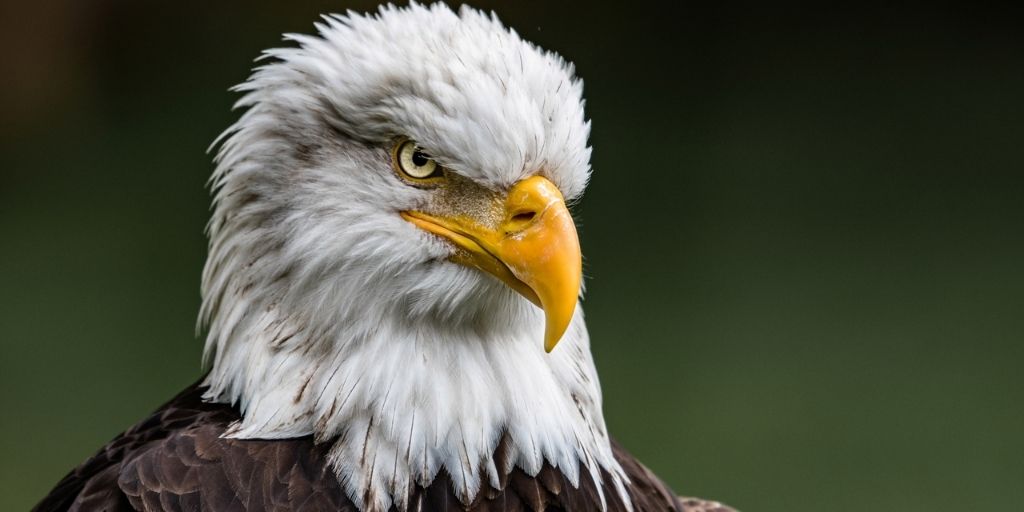
The Largest Eagles In The World

The Biggest Birds In The World

The Smallest Birds In The World

Birds That Mate For Life

The Largest Birds Of Prey In The World
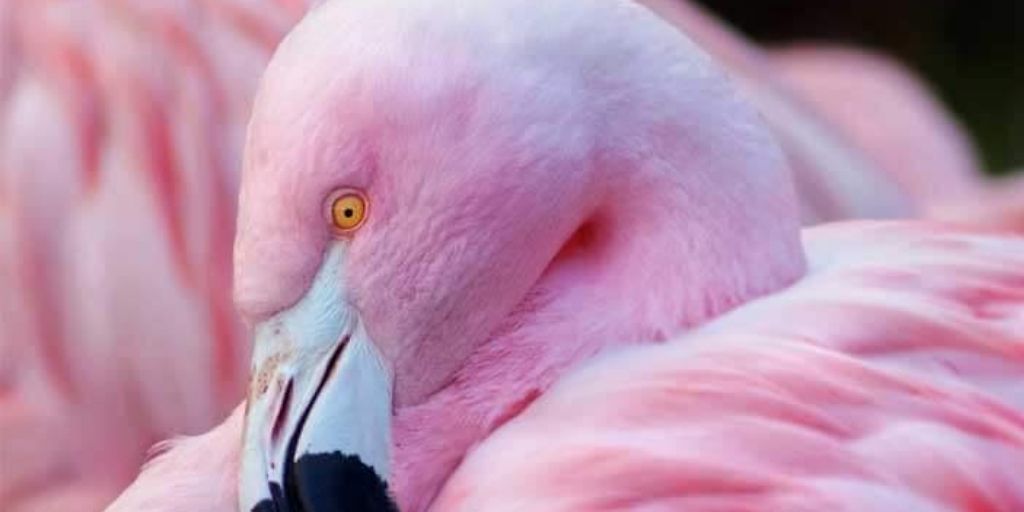
Why Are Flamingos Pink?

Why Do Flamingos Stand On One Leg?

Parrots of Africa

Birds of Africa

The Six Greatest Animal Migrations in Africa
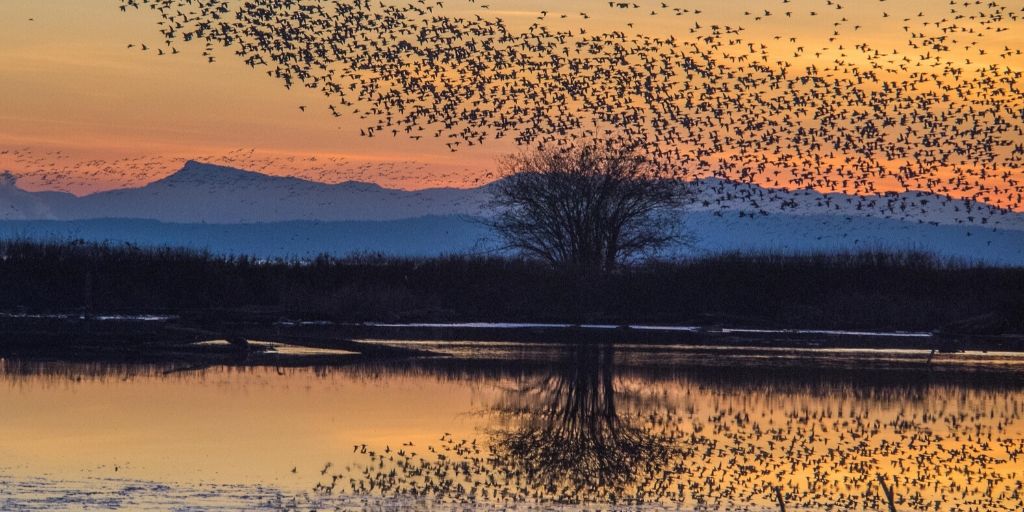
Collective Nouns For Birds

Individual bird species
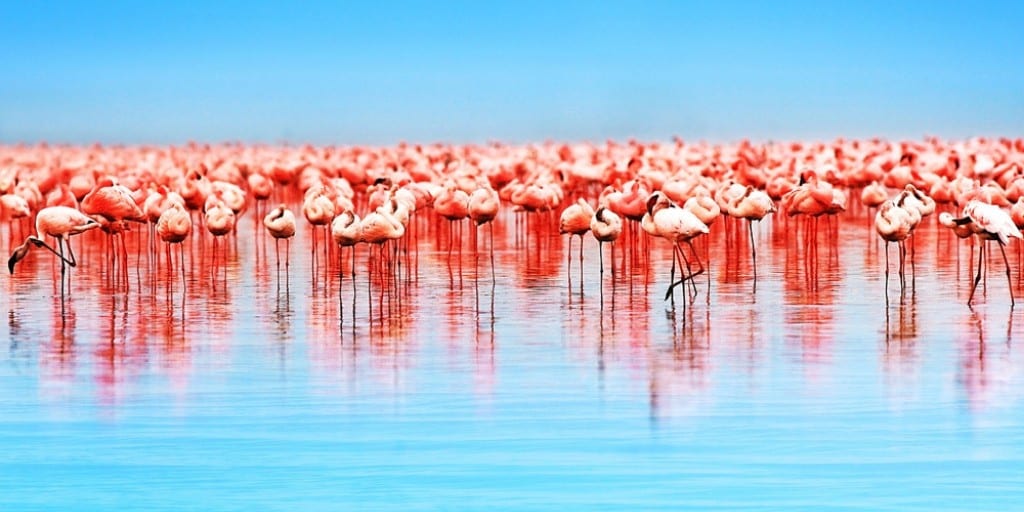
The ostrich is a flightless bird and mostly found in Africa. They can run at a speed of over 70 kilometers/hour making it the fastest running bird on the planet.

The kingfisher is a family of small to medium-sized birds that consist of 114 species. All kingfishers have long, sharp, and pointed bills that help them to catch prey.
Secretary bird

Shoebill bird

The shoebill bird is also known as a whale-headed stork or whale head. It’s a very large stork-like bird and its name is coming from the massive shoe-shaped bill.
And that’s the lot for our selection of bird lists. What did you think? Any lists we’re missing that you’d love to see? Let us know in the comments section below!
Top countries for safaris
- Botswana safaris
- Kenya safaris
- Namibia safaris
- South Africa safaris
- Tanzania safaris
- Uganda safaris
Safari basics
- Safari animals
- How to find the right safari company
- When to go on safari
- What to take on safari
- Safari clothing – what to wear
- Safari rules & etiquette
- Wildlife spotting tips
Most read articles
- All about the ‘big five’ animals
- Collective nouns for animals
- Safari movies to watch before you go
- The world’s fastest land animals
- Apex predators
- 10 Fascinating African tribes
- The biggest animals in the world
- 17 Epic hybrid animals
- The world’s ugliest animals
- Why are flamingos pink?
Africa’s best game reserves
- Chobe National Park, Botswana
- Etosha National Park, Namibia
- Kruger National Park, South Africa
- Masai Mara National Reserve, Kenya
- Moremi Game Reserve, Botswana
- Okavango Delta, Botswana
- Serengeti National Park, Tanzania
Session expired
Please log in again. The login page will open in a new tab. After logging in you can close it and return to this page.
- Skip to primary navigation
- Skip to main content
- Skip to primary sidebar
- Skip to footer
TravelAwaits
Our mission is to serve the 50+ traveler who's ready to cross a few items off their bucket list.
12 Stunning Birds To Spot While On Safari

Tobie Oosthuizen / Shutterstock
- Activities and Interests
- Bird Watching
- Destinations
- Outdoor Activities
I don’t know if you have watched the classic film Out Of Africa , but if you haven’t, then you should! There’s a scene in the film where Robert Redford’s yellow biplane swoops low over Kenya’s Lake Nakuru, sending a seemingly endless flock of flamingos soaring into the sky. This spectacular scene is just a glimpse of how sensational bird watching in this part of the world can be. Africa’s birdlife is some of the most varied, numerous, and colorful. The continent is home to over 2,300 bird species, of which 67 percent are endemic.
Don’t be put off by those stereotypes that paint “twitchers” as fanatics, flocking (sorry, I couldn’t resist!) to Africa single-mindedly in pursuit of feathered conquests; bird-watching safaris in Africa are about much more than just the birds. Remember, too, that while there are dedicated bird-watching safaris you can sign up for, you don’t need to join one to enjoy the birdlife. If you’re traveling to Africa for a safari, along with the big beasts, you’ll likely find yourself being dazzled by the color and diversity of the birds you spot along the way; they might just be the unexpected highlight of your trip.
Here, I showcase some of the fabulous birds you can expect to see on your safari.
1. Weaver Birds
Common, masked, village, sociable, buffalo: There are too many different weaver birds in Africa for us to focus on each member of the family individually . As their name implies, weaver birds “weave” their nests, with the males tending to be the nest builders, building intricate nests woven from reeds, grass, palm, or other suitable material. Once built, the female bird usually lines the nest with soft grass and feathers. I have a pair of spectacled weaver birds who nest annually in my garden. The male makes a start on the nest and then partway through will bring his mate in for a “site inspection,” if his handiwork is not up to scratch, the female signifies her displeasure and he abandons the construction and starts again. Some years I have seen several false starts hanging in the palm tree by the pool, alongside the final product that she’d apparently deemed suitable for habitation.
As an aside, weaver birds are the only birds with the recorded ability to tie knots!

Tatiana Popova / Shutterstock
2. Flamingos
Since I mentioned the flamboyance of flamingos above, let’s start with them on our rundown of spectacular birds you can spot on safari. Often spotted in the hundreds, tightly packed together and standing on one leg, in some of Africa’s great lakes, flamingos are an iconic bird to see on safari. With their bright pink feathers, long, graceful necks, legs which are the longest of any bird in proportion to their body size, and unique upside-down eating style, funky flamingos are a wonderful sight on any safari. One of my favorite places to see them was i n Ethiopia where we walked across the mudflats at Lake Abiata , never getting quite as close as we wanted to the huge flocks of flamingos, who always seemed tantalizingly one step ahead of us.
Editor’s Note: Captivated by flamingos in particular? Here are our picks for six places to see flamingos in the wild .

Royal Zambezi Lodge
3. African Fish Eagles
African fish eagles are large, distinctive birds found throughout sub-Saharan Africa, from Kenya to South Africa. The fish eagle is the national bird of Zambia, my adopted home, and from my verandah, I see or hear a fish eagle at least once a day as it soars over the nearby river or perches in a tall tree on the bank. With a graceful plunge into the water, a fish eagle will grasp its prey with its formidable set of talons. They do not restrict their diet solely to fish, but will also eat other birds and reptiles. I once watched, in morbid fascination, as a fish eagle swooped down and grabbed hold of a duck that had, moments before, been paddling contentedly in the river. A struggle ensued as the fish eagle tried, in vain, to fly up out of the water. The duck put up a strong fight, the fish eagle tugging one way and the duck the other. Finally the fish eagle managed to drag the duck through the water, to the bank, where it soon became lunch.

Martin Pelanek / Shutterstock
4. Helmeted Guineafowl
Guinea fowls can seem to be everywhere on safari, striding across the landscape like battalions of soldiers in their black and white spotted plumage, with distinctive bright blue necks and yellow helmets. They are also some of the noisiest birds you will find on safari and are renowned for interrupting your sleep with their loud cackles. You will usually spot them scratching around in loose soil, like chickens, looking for food such as seeds, fruits, greens, snails, spiders, worms, and insects.

5. Vultures
Vultures are the supreme scavenger of the bush. There are 11 different species of vulture in Africa and they are responsible for cleaning up 70 percent of the continent’s carrion. On safari, you will most often see vultures flocking to a carcass of a dead animal, and your safari guide will often be on the lookout for vultures circling in the sky as a sign of where to head to show you some of the larger predator action. Two of my favorites in the vulture department are the hooded and the lappet-faced vultures.
The hooded vulture is the classic safari bird. It’s a scruffy-looking vulture, widespread in sub-Saharan Africa. Like other vultures, it is a scavenger, feeding on carcasses of dead animals. These are monogamous birds, with males and females remaining together during the mating season, and rearing their young together, as a team.
The lappet-faced vulture is one of the largest birds of prey in Africa and easily recognizable by both its size and its bald pink head, as well as the lappets (hanging folds of flesh) on either side of its neck. Built for scavenging, this vultures’ powerful beak can tear the hides, tendons, and other tissue from its prey, some of which can be too tough for other scavengers. As the largest vulture in Africa, the lappet-faced dominates other vultures during feeding and is even strong enough to drive off a jackal.
One other vulture really worth looking for is the lammergeier or bearded vulture. A scavenger that lives on a steady diet of bones and bone marrow, after finding a picked-over carcass, the bird will drop it from a tremendous height, shattering it into swallowable pieces.

Machite Kingfisher Musekese Conservation
6. Kingfishers
Of Africa’s myriad of kingfishers, my favorite is the tiny malachite kingfisher. At about five inches tall, these diminutive birds are a bright electric blue color, with a crest of black and blue feathers on the head, and white patches on the throat. These kingfishers have regular perches, above and close to water, from where they catch fish, crustaceans, and aquatic insects.

Kaingu Lodge
7. Lilac-Breasted Roller
The colorful lilac-breasted roller is a photographer’s favorite on safari. It’s easily spotted, liking to perch conspicuously on top of high vantage points like trees and poles whilst looking for prey such as insects, scorpions, snails, and rodents. During mating seasons the males soar high in the sky and engage in huge dives and swoops whilst making loud calls, all in an effort to impress the ladies.

Chloe Mc Cormack
8. Bee-Eaters
These charismatic and colorful birds are a favorite amongst birders. Of the world’s 27 species of bee-eater, 20 are found in Africa, some resident and others migratory, and you can find them from the southern tip of the continent right through to the far north, occupying an incredible range of habitats in between.
My personal favorites are the carmine bee-eaters. These bee-eaters nest in colonies, usually in holes in steep river banks, like those on the Luangwa River in Zambia. The colonies can consist of thousands of individuals, sometimes over 10,000 birds, and they create an incredible spectacle as they swoop out over the water with their scarlet feathers and turquoise crowns. There is something special about seeing hundreds of these brilliant crimson birds filling a tree like Christmas ornaments or taking off like a massive flock of red arrows.

Michael Potter11 / Shutterstock
9. Grey Crowned Cranes
The grey crowned crane’s range stretches from the Democratic Republic of Congo through Uganda and Kenya to southeastern South Africa, and it is every bit as majestic as its name suggests. With its long white, black, gold, and brown feathers, and a head topped with a crown of stiff golden feathers, this is the national bird of Uganda. They have a bright red pouch on the front of their necks, which they use to produce a deep, booming call. I remember sitting one evening in the back of a safari vehicle on Zambia’s Busanga Plains and listening to crowned cranes producing this eerie sound as they roosted for the night. Like all cranes, the crowned crane performs a spectacular dance as part of their mating ritual. It’s an impressive sight to see these stunning birds, heads bobbing, bodies bowing, wings flapping, as they run and jump, tossing sticks and grass into the air.
It’s worth mentioning two other cranes you should keep your eye out for when next on safari: the rare blue crane, which is the national bird of South Africa, and Africa’s most endangered crane, the wattled crane (the Kafue Flats, in southern Zambia, supports the largest known population of wattled cranes).

Jeff Kingma / Shutterstock
10. Turacos
There are 18 species of turaco, all found in Africa. They range from the grey loerie or Go-Away Birds (named for their unusually loud, nasal call, which sounds like a peevish old woman telling you to “kweh” or “go-way”), to the purplish-blue and uncommon Lady Ross’s turaco, or the rare white-cheeked turaco, which we were once lucky enough to spot in Ethiopia.

NDAB Creativity / Shutterstock
11. Hornbills
Hornbills are another special safari bird. Africa is home to 23 of the world’s 54 hornbill species, including the largest members of the family, the ground hornbills who stride around the bush, looking so somber and serious that they are often referred to as undertaker birds. You are bound to spot a variety of hornbills on your safari, all of which will be a lot smaller than the ground hornbill. You might even spot the African red-billed hornbill (think of Zazu from The Lion King film); some safari guides refer to the red-billed hornbill as a flying chili given the color and shape of its bill.

Konkamoya Lodge
12. Oxpeckers
Out on safari, some of the most common birds to spot are the small birds, seen hitching a ride on rhinos, zebras, buffalos, elephants, or giraffes. It’s also not uncommon to see them balancing on hippo’s backs as they bob in the water. These little birds are oxpeckers, small parasite-eating birds, endemic to Sub-Saharan Africa. There are two species of oxpecker: the yellow-billed and the red-billed. Similar in appearance, they can be mistaken for one another. As their names suggest though, the red-billed oxpecker has a red beak, and the yellow-billed oxpecker a yellow beak with a red tip. The red-billed oxpecker sticks to eastern Africa, but yellow-billed oxpeckers can be found all over sub-Saharan Africa, both east and west.
The oxpecker gets its name from its habit of perching on its “host” and eating ticks, flies, maggots, and various kinds of larvae. A full-grown oxpecker can eat hundreds of bugs and many thousands of larvae in a day! In a slightly macabre twist, it’s not uncommon to see them pecking at, and cleaning, their host’s open wounds, nibbling on the blood and flesh.
Africa is rich in birding opportunities, for beginners and professionals alike. Plenty of national parks, conservancies, and lodges offer specific birding programs, but it is possible to bird watch anywhere on the continent.
No bird-watching safari is complete without a good set of binoculars, so if spotting a wide range of birds plus a variety of other African wildlife is top of your holiday wish list, you won’t regret investing in a decent pair. Good binoculars get you up close to the wildlife action, disturbing the animals you’re watching as little as possible. See the TravelAwaits team’s picks for best binoculars for any budget here.

Born and raised in Sydney, Australia, before moving to Africa at the age of 21, Sarah Kingdom is a mountain climber and guide, traveler, yoga teacher, trail runner, and mother of two. When she is not climbing or traveling she lives on a cattle ranch in central Zambia. She guides and runs trips regularly in India, Nepal, Tibet, Russia, and Ethiopia, taking climbers up Tanzania’s Mount Kilimanjaro numerous times a year.
15 Heavyweight Birds to Look Out For on an African Safari
By Philip Briggs | Updated April 22, 2021
Africa is best known for being home to the Big Five and other large mammals, but it also hosts some of the world’s most impressively bulky birds, including the outsized ostrich, some imperious birds of prey, and many striking aquatic species. Here some of the iconic avian heavyweights you might encounter on a safari in Africa.
The world’s largest bird, standing up to 9ft tall and weighing up to 320lb, the ostrich is an unmistakable resident of open savanna and grassland. The male has a bold black and white plumage, but the female is somewhat dowdier. Although it cannot fly, the ostrich is one of the world’s fastest runners, capable of hitting 45 miles per hour. Ostrich eggs have a capacity of more than 2 pints and were traditionally used by San hunter-gatherers as canteens to carry water.
Where to see it: The open plains of Serengeti-Mara are great ostrich habitat. Ostriches are abundant in the Oudtshoorn region of South Africa, where they are farmed for their cholesterol-free red meat.
African Fish Eagle
Africa’s most recognizable large raptor, the fish eagle has a bold black and white feather pattern offset by a rich chestnut belly and yellow bill. The far-carrying duetting of a monogamous pair is one of the most evocative sounds of the African bush.
Where to see it: In the vicinity of any perennial river or lake. Dense populations are associated with Kenya’s Lake Naivasha and parts of Lake Malawi.
Southern Ground Hornbill
Most people do a double-take when they first see a family of ground hornbills marching comically through the bush. These black turkey-sized birds have conspicuous red-eye and throat wattles, long fluttering eyebrows, and white wing patches visible only in flight. Although they’re mainly terrestrial, ground hornbills are powerful fliers, and they nest in tree cavities.
Where to see it: Widespread but mainly restricted to national parks and other reserves. South Africa’s Kruger National Park is a good place to look for it.
Flamingoes
Both African flamingo species are tall pink-tinged birds that habitually stand on one leg. They often aggregate in flocks of several thousand in shallow water, favoring saline lakes that support a high density of the blue-green algae on which they feed.
Where to see it: Rift Valley lakes such as Manyara and Natron in Tanzania, and Nakuru and Bogoria in Kenya, often support high concentrations.
Hadeda Ibis
Although it isn’t particularly striking to look at, the hadeda is one of Africa’s most noticeable birds, regularly asserting its presence with the cacophonous cackle for which it is named.
Where to see it: Often associated with suburban gardens, it plays an important pest-control role picking at snails with its long decurved bill.
Goliath Heron
Standing more than 6ft high, the world’s largest heron has a cryptic purple-grey, chestnut, black and white plumage. It is a strictly aquatic species that feeds mainly on fish but will gulp up any suitably sized prey.
Where to see it: Close to water throughout sub-Saharan Africa. Boat trips in Nyerere (Tanzania), Murchison Falls (Uganda), and Liwonde (Malawi) national parks offer a good chance of spotting it.
One of the world’s oddest birds, this rusty brown aquatic species is named for the hammer-headed appearance created by its long flattened bill and angular crest. Its unique nest is the largest made by any individual African bird – a scruffy construction of branches, mud, and pretty much anything else it can get its beak around.
Where to see it: In the vicinity of the tall waterside trees in which it nests.
Grey Crowned Crane
The most spectacular of sub-equatorial Africa’s three crane species, Uganda’s national bird is unmistakable with its stiff golden crown, red throat pouch, and bold white cheeks. It’s a real treat to see a pair of crowned cranes perform their courtship ritual, which involves dancing, jumping, and the touching of bills in a kiss-like gesture.
Where to see it: Associated with moist grassland, it’s common in western Uganda, Tanzania’s Ngorongoro Crater, Zambia’s Kafue National Park, and the uKhahlamba-Drakensberg foothills of South Africa.
Marabou Stork
Although it’s unlikely ever to win a beauty contest, the marabou is one of Africa’s largest and most impressive birds, and unmistakable with its bald scabrous head, fleshy neck-pouch, and a funereal stance befitting a creature that feeds mainly on carrion.
Where to see it: Alongside vultures in the vicinity of kills in most safari destinations. It adapts well to urban habitats and is common in the Ugandan capital Kampala.
Kori Bustard
Often seen walking ponderously through the tall grass like a smaller, sturdier variation on an ostrich, the Kori bustard is the world’s heaviest flying bird, weighing up to 40lb, albeit with a smaller wingspan than the Andean condor. Its elaborate courtship ritual is marvelous to witness.
Where to see it: This grassland bird is particularly common in the Serengeti-Mara ecosystem of Tanzania and Kenya.
Saddle-Billed Stork
It might not be quite so hefty as its marabou cousin, but the saddle-billed stork is altogether more graceful and handsome. You get bonus points for being able to distinguish males (black eyes, small yellow throat wattle) from females (yellow eyes, no throat wattle).
Where to see it: Nowhere common, but likely to be seen singly or in monogamous pairs in the vicinity of any aquatic habitat.
Secretary bird
The world’s most bizarre raptor, the heron-sized secretary bird is distinguished by a prominent black crest and bare orange face. A terrestrial hunter, it feeds on snakes and other small vertebrates, stamping them to death in what appears to be the original funky chicken dance. A strong but reluctant flyer, it requires a long take-off reminiscent of an airplane on a runway.
Where to see it: Widespread in grassland, and particularly common in the Serengeti-Mara, but increasingly rare outside of protected areas.
Among the most eagerly sought of African birds, the shoebill is a hefty slate-grey swamp-dweller whose unique clog-shaped bill makes it look like a refugee from the pages of Dr. Seuss.
Where to see it: Uganda, where top sites include Mabamba Swamp, Toro-Semuliki, and Murchison Falls. Other possibilities include Zambia’s Bangweulu Swamp and Rwanda’s Akagera National Park.
Lappet-Faced Vulture
Africa’s largest raptor, the lappet-face is rather handsome as vultures go, with a bald redhead, a blue and ivorybill, and heavy black wings that give it a vampirish appearance when spread wide like a cloak. As with other vultures, it plays a vital sanitation role, clearing the bush of what would otherwise be rotting carcasses.
Where to see it: Now virtually confined to protected areas, it is most often seen in the vicinity of a recent kill.
Great White Pelican
Africa’s largest waterbird weighs up to 30lb and has a large pouched bill typical of pelicans. It often swims in flotilla formations comprising around 10 individuals.
Where to see it: Good sites for this widespread aquatic bird include the Rift Valley lakes of Kenya and Tanzania and the iSimangaliso Wetlands in South Africa.
Guineafowl
Closely related to chickens and similarly bird-brained, guineafowls are handsome spotted wild fowl whose hysterical clucking makes a significant contribution to the safari dusk chorus.
Where to see it: The helmeted guineafowl is ubiquitous. In northern Kenya, look out for the vulturine guineafowl, with its iridescent cobalt breast
Share this:
- Click to share on Twitter (Opens in new window)
- Click to share on Facebook (Opens in new window)
Sign In Here!
Log into your account in just a few simple steps.
You don't have permission to register

- South Africa
- Philippines
- Faroe Islands
- United States
- French Polynesia
- New Zealand
12 Of The Most Iconic Bird Species in Africa
Africa is home to some of the largest, most colorful and varied bird populations in the world. The continent is home to over 2,500 recorded bird species, of which 67 percent are native to Africa.
Birds have been around since the dino-age and fulfill countless different functions in African ecosystems. From feisty little bee-eaters and brightly colored sunbirds to prehistoric shoebills and penguins, African birds come in an almost infinite number of shapes, sizes, and colors. We’ve created a shortlist of our favourites based on their unique appearance and high likeliness of being seen while on safari.
Here are 12 of the most iconic birds in Africa:
Vultures are nature’s cleanup crew – they are large, strong birds who scavenge on the flesh and bones of carcasses left by large predators . While they will never say no to picking at a fresh kill, they often times consume flesh that is so decayed that it has become toxic to mammals.
Vultures have no feathers on their head and neck which helps to protect against the infectious parasites and bacteria that are rife on a decaying carcass.
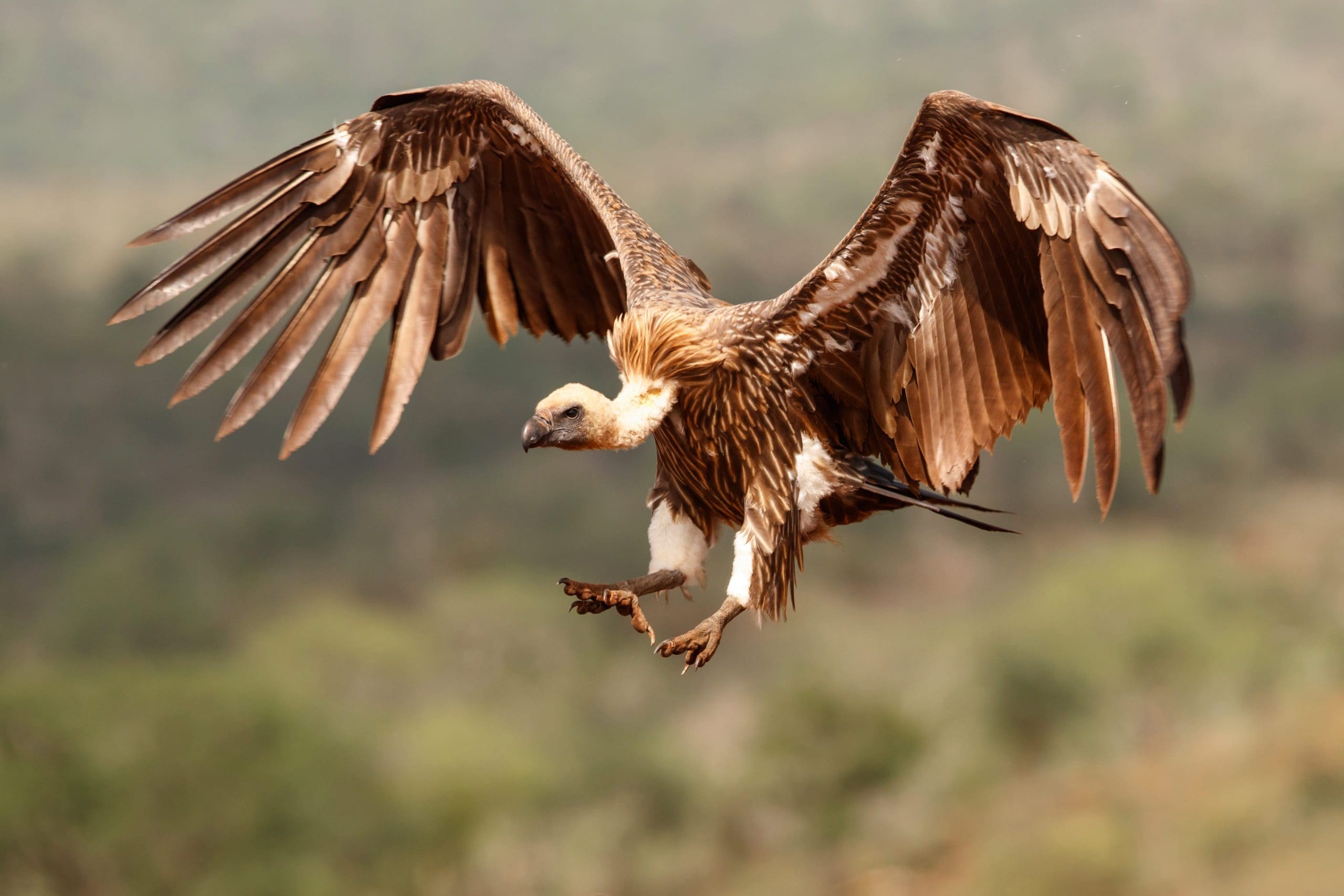
Having evolved an incredible sense of sight and smell, vultures are often able to seek out carcasses from over a mile away and are readily seen circling the skies in numbers, waiting for the most opportune time to approach. Once on the ground, a large group of vultures can strip a buffalo carcass in a matter of hours.
There are 11 vulture species found in Africa , with the most common being the: White-backed vulture, Cape vulture and Lappet-faced vulture.
Today all species are endangered due to habitat destruction and human conflict, however they can readily be seen in national parks through Southern and East Africa.
2. Grey Crowned Crane
Crested Cranes, or Grey Crowned Cranes , reach a height of almost 1 metre, with a wingspan of around double that. They are among the easiest African birds to identify thanks to their attractive crown of bright gold feathers, blue eyes, white face, and bright red throat pouch.
Like several other bird species, these cranes have an elegant mating dance characterized by various hopping, twisting, jumping and wing movements. However, they don’t only display this during mating season – you might notice this performance all year round, so keep your camera available!
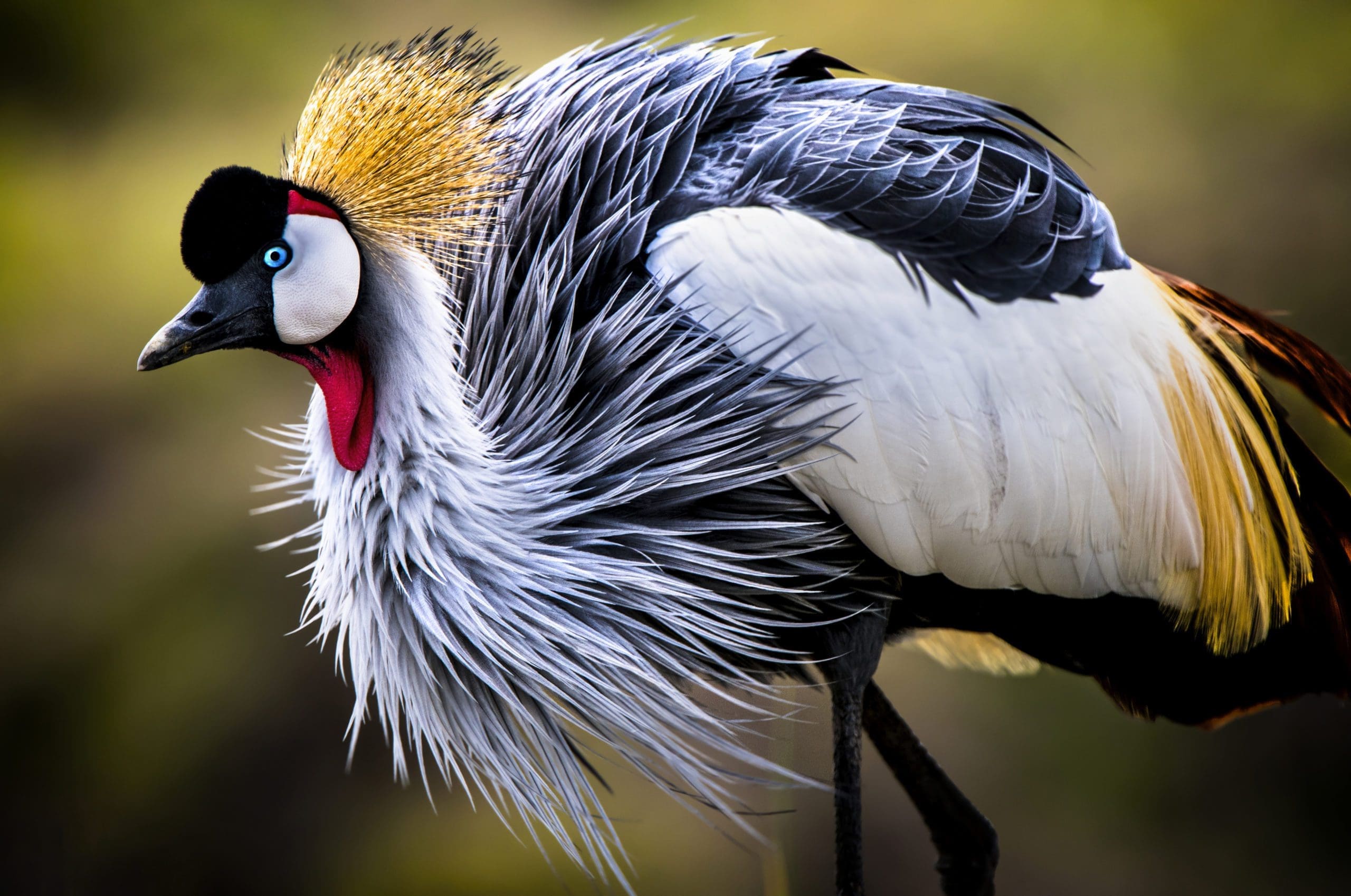
Widespread throughout southern and east Africa , the Grey Crowned Crane is often seen in South Africa , Tanzania and Kenya, and is the national bird of Uganda – characterized as the centre piece of the national flag.
Unfortunately this iconic species also finds itself on the endangered list due to habitat loss and human conflict.
3. Marabou Stork
Often referred to as ‘The Undertaker’ thanks to its ominous appearance, the Marabou Stork was once believed to be the largest bird species in the world with a wingspan of over 3 metres.
Characterized by a lanky, curved posture, evil-looking features and cloak-like wings, the Marabou Stork is a scavenging species often seen picking on the carcasses of dead animals.
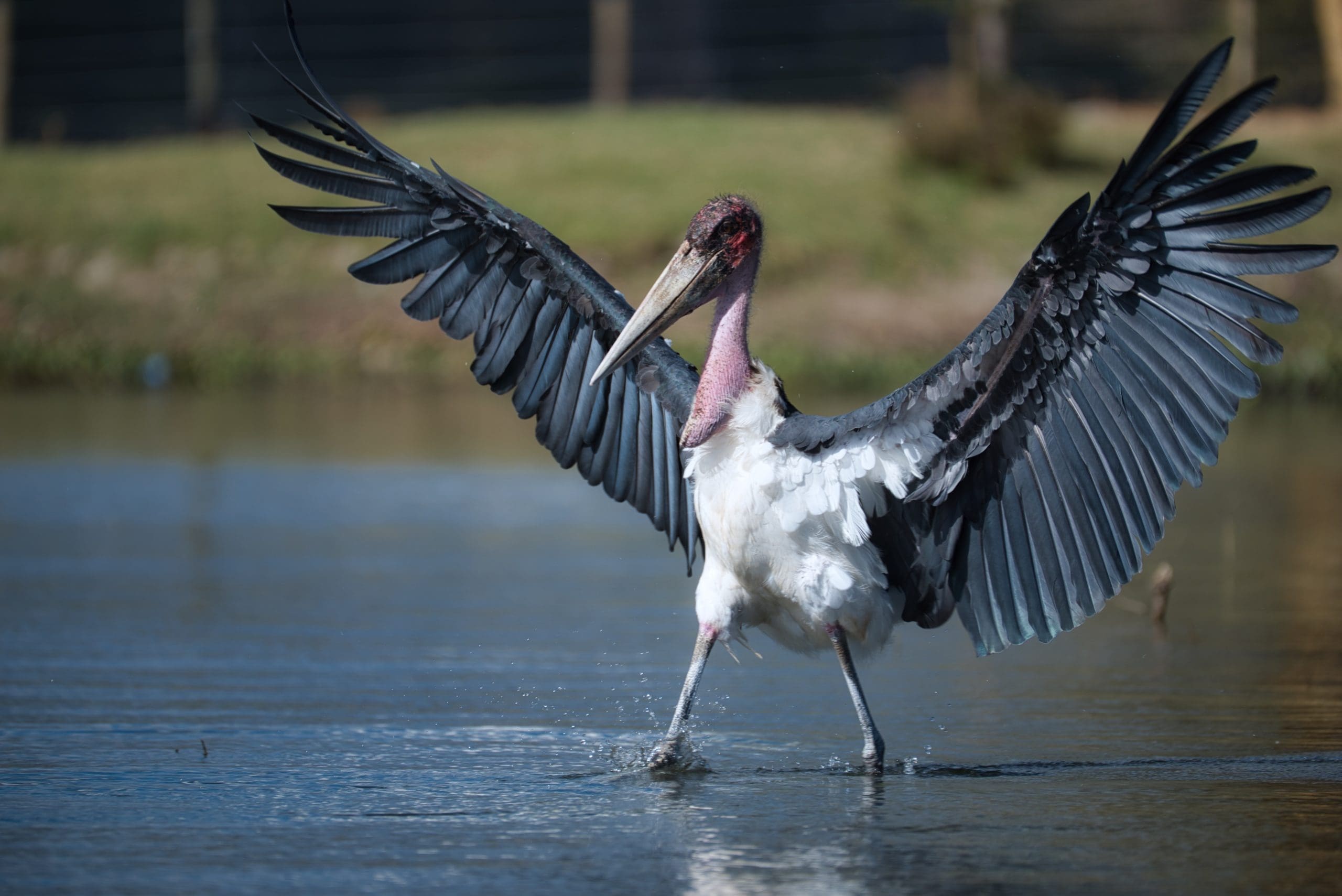
Relatively easy to spot due to its size, the Marabou Stork features a feather-less head and neck which protects against the build up of bacteria.
Keep an eye out for this unique looking birds while on safari in Kenya, Ethiopia, Tanzania or Uganda , and don’t be surprised if you spot them digging in and dustbins!
READ NEXT: THE UGLY FIVE ANIMALS OF AFRICA
4. Red-Throated Bee-Eater
With 26 different types of bee-eater on the continent, the red-throated bee-eater is among the most popular birds in Africa . Like the Sunbird, they’re easily noticed for their colorful plumage and long, sharp beak.
As their name suggests, they primarily prey on wasps and bees. To avoid a painful sting, the bee-eater grabs its prey by the wing and rubs or strikes the insect against a hard surface. This causes it to secrete all its venom.
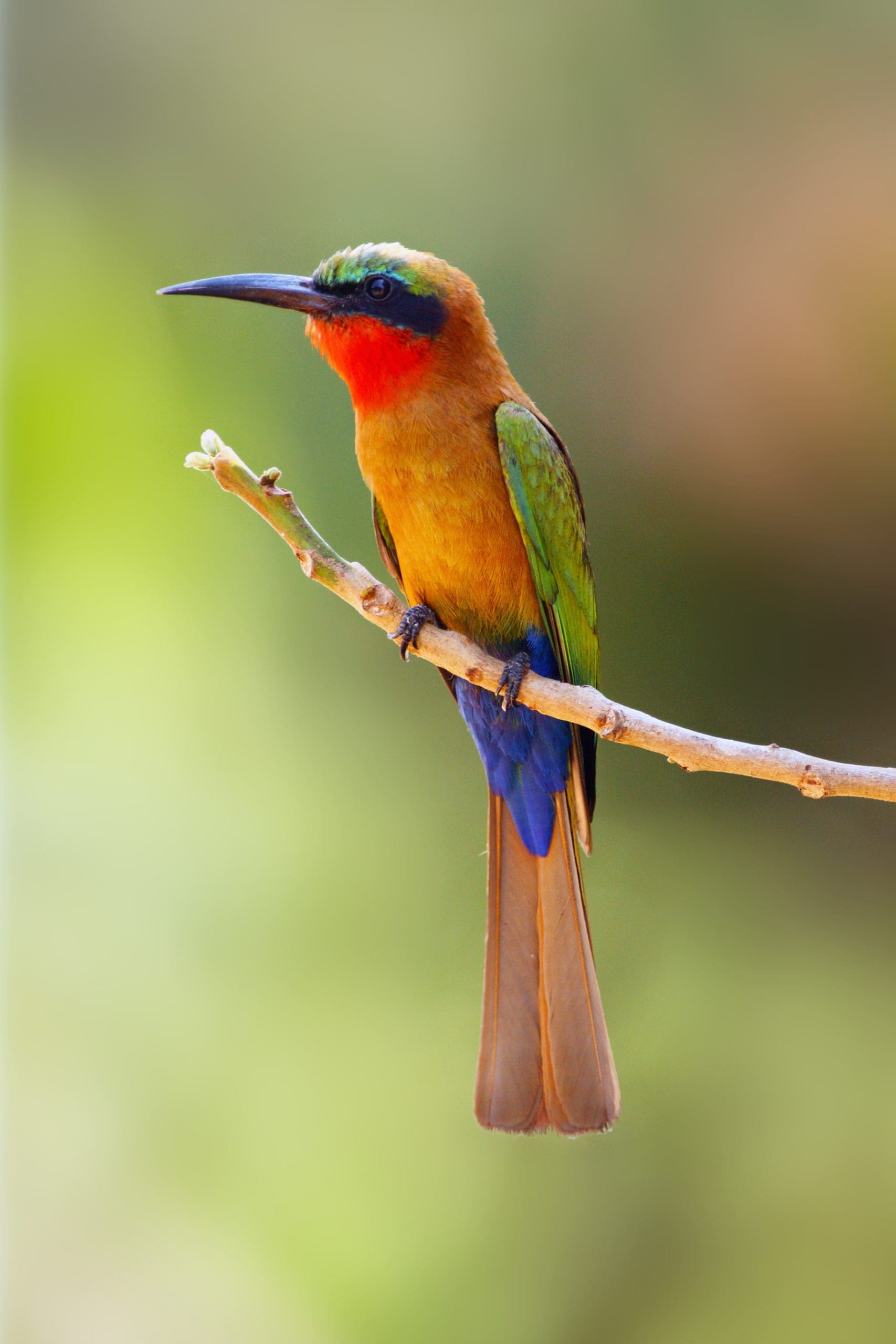
Recorded by IUCN as being of ‘least concern’, there is currently a thriving population of bee-eaters in Africa and they’re not at all difficult to spot when visiting tropical regions of Cameroon, Ethiopia , Togo, Ghana, Nigeria, Guinea, Burkina Faso, Gambia, Senegal, and Uganda.
5. Rosy-Faced Lovebird
Extremely popular in the pet trade, you might be surprised to hear that one of Africa’s most beautiful birds, is actually a desert dwelling species.
Living up to its name, the Rosy-faced Lovebird is a social species that lives in large flocks. Within the larger flock dynamic, Lovebirds build extremely strong bonds with a single mate and often stick together for the duration of their lives.
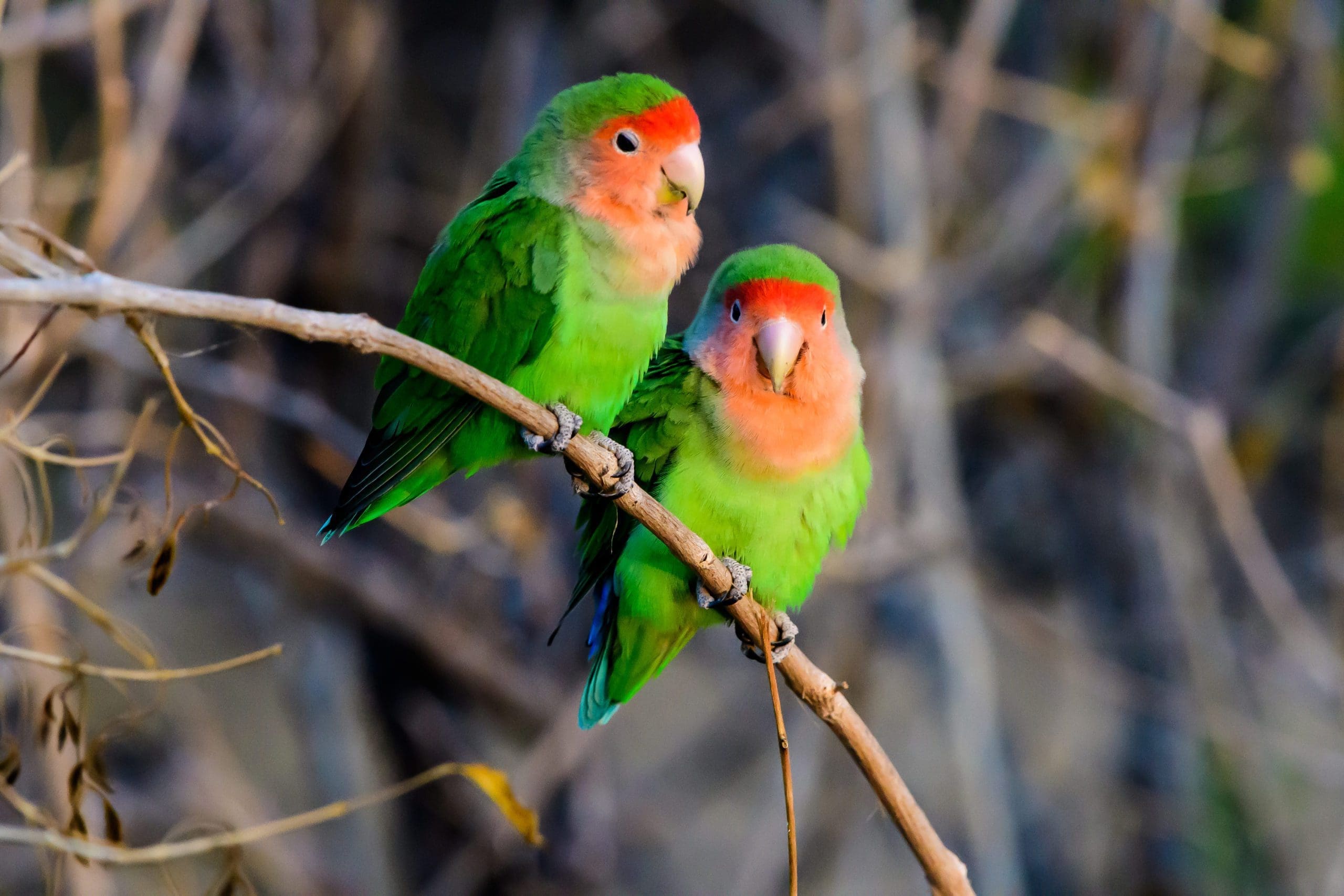
Despite being primarily known as a pet species, Lovebirds still thrive in the wild and there are about nine different species in Africa. Lovebirds occupy a variety of habitats like the dry southwest and the Namib desert.
The Rosy-Faced Lovebird is easily identified by a bright green body, blue rump and pink feathers near its face.
6. Common Ostrich
The Ostrich is an enormous, flightless bird and one of the most iconic species on earth. Too heavy to take off, the ostrich makes up for its lack of flight by being the quickest animal on two legs, reaching speeds of more than 70 km/hour, covering around 5 metres in a single stride.
Armed with dinosaur like talons, their lanky legs can also be mighty weapons, able to kill a would-be predator with a single kick.
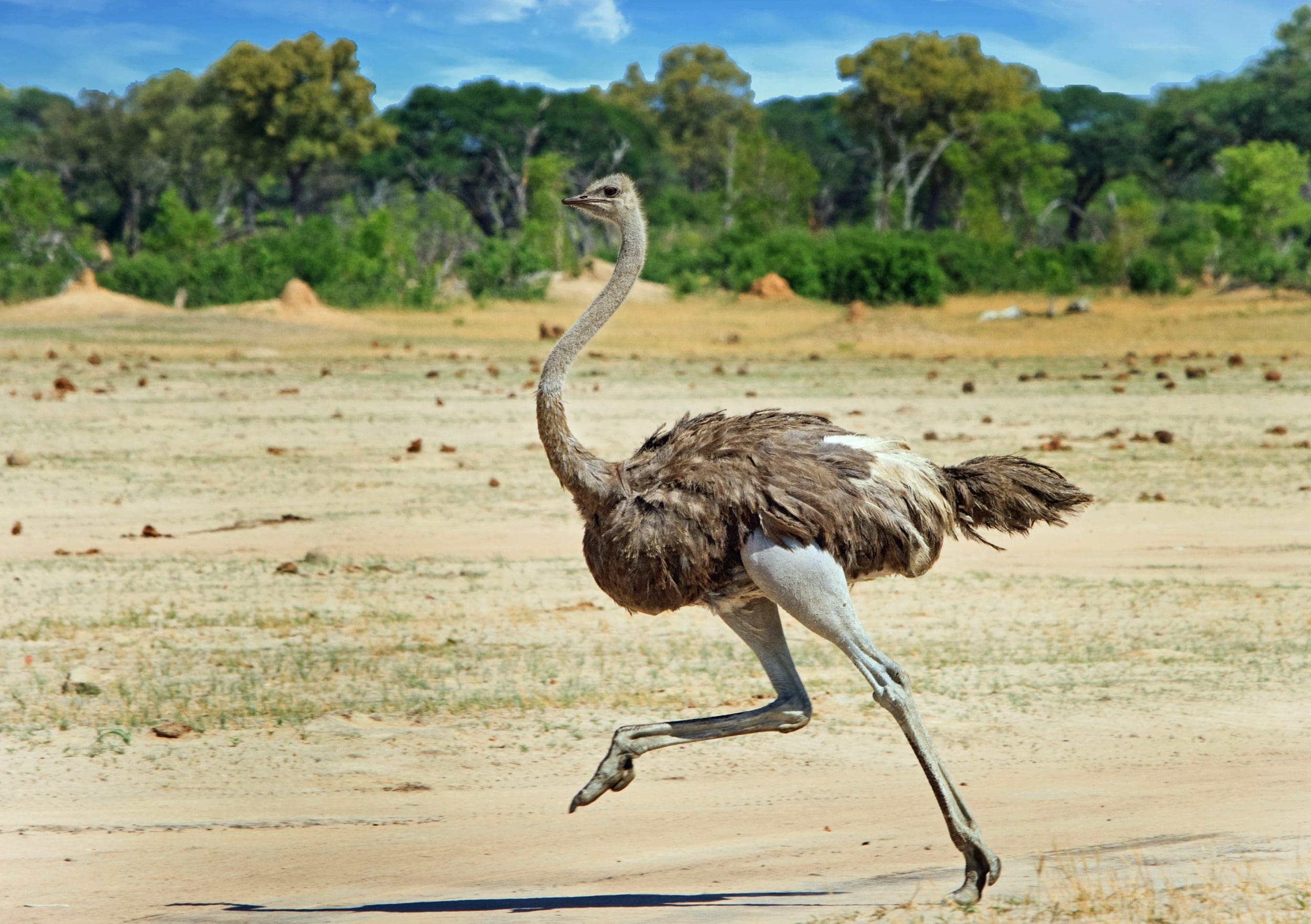
Widespread throughout Africa, Ostriches can be found from South Africa all the way up to Morocco, Egypt and Tunisia in the north. They generally spend winter periods living solitary or in pairs and come together to form large flocks during the mating season, where a single male can live with a harem of 7 or more females.. Ostriches lay the largest eggs of any bird species, with a single egg being the equivalent to a dozen chicken eggs.
Readily farmed for their meat in Southern Africa, you can get up close and personal with an Ostrich at one of South Africa’s famous farms . But if seeing them in the wild is more your thing then there’s no better place than the Maasai Mara or Serengeti National Park .
7. Lilac-Breasted Roller
One of the most commonly spotted birds while on safari in Southern Africa, the Lilac-Breasted Roller is easily spotted thanks to its vibrant colours and propensity for perching on tree branches.
With its bright lilac breast, the roller is named so due its habit of rolling mid-flight while defending territory or courting a mate, and despite its stunning appearance, this species does not possess an equally impressive voice. Instead its call is more of a harsh squawk.
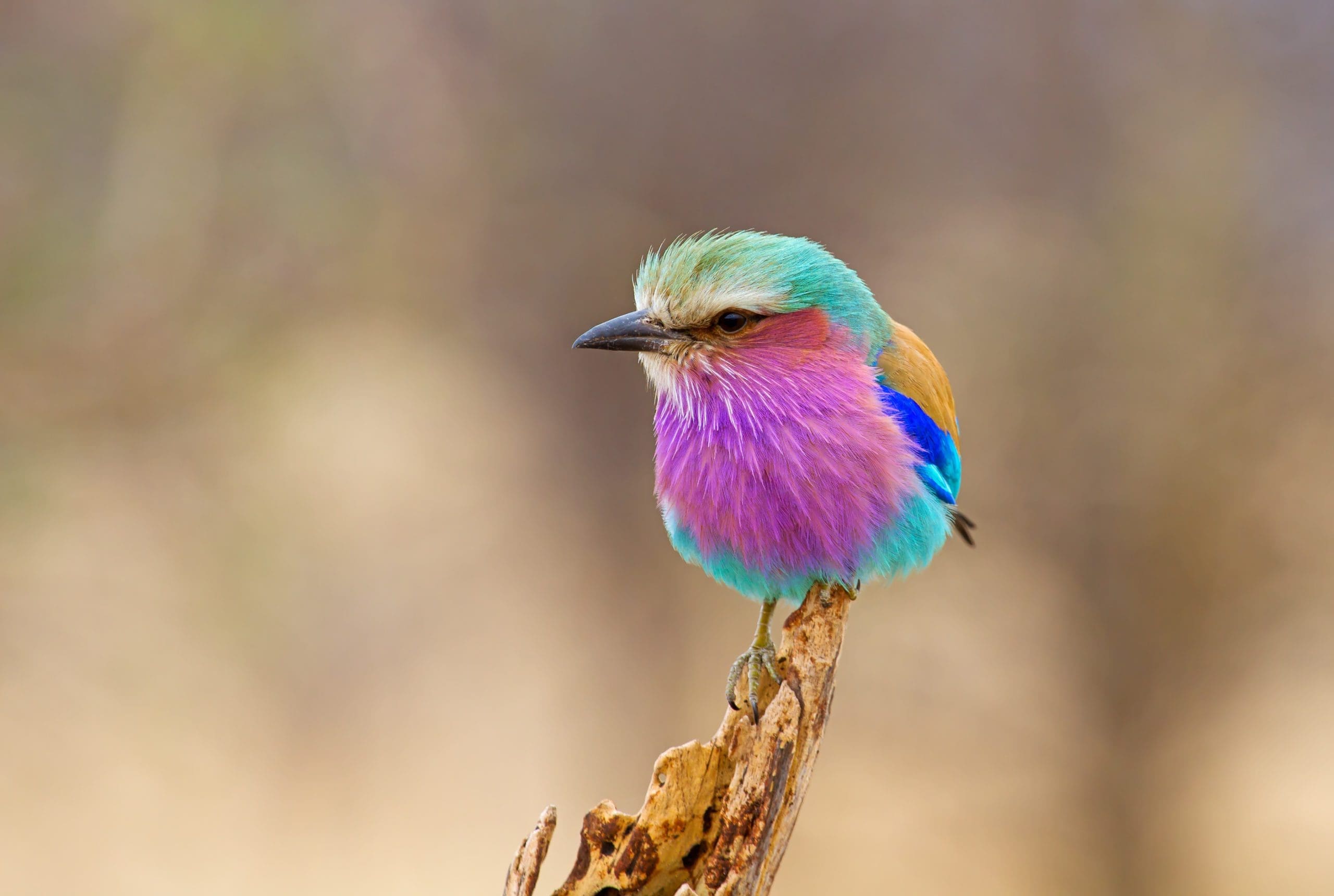
Plentiful across southern and eastern Africa, the Lilac-Breasted Roller inhabits bushy savannah and open woodland where they can easily be photographed perched on a branch, seeking out a juicy insect or beetle.
A prime example of ‘convergent evolution’ the Sunbird is Africa’s equivalent to the Hummingbird. This natural wonder occurs when two completely separate species have evolved to become extremely similar due to commonalities in their habitat and behavior.
Contrary to us humans, the male is the fairer of the 2 sexes when it comes to Sunbirds. They boast an incredible coloration, while females are much drabber. This is because it is the male’s responsibility to attract a mate during the breeding season, and the stunning coloration makes it all that much easier.
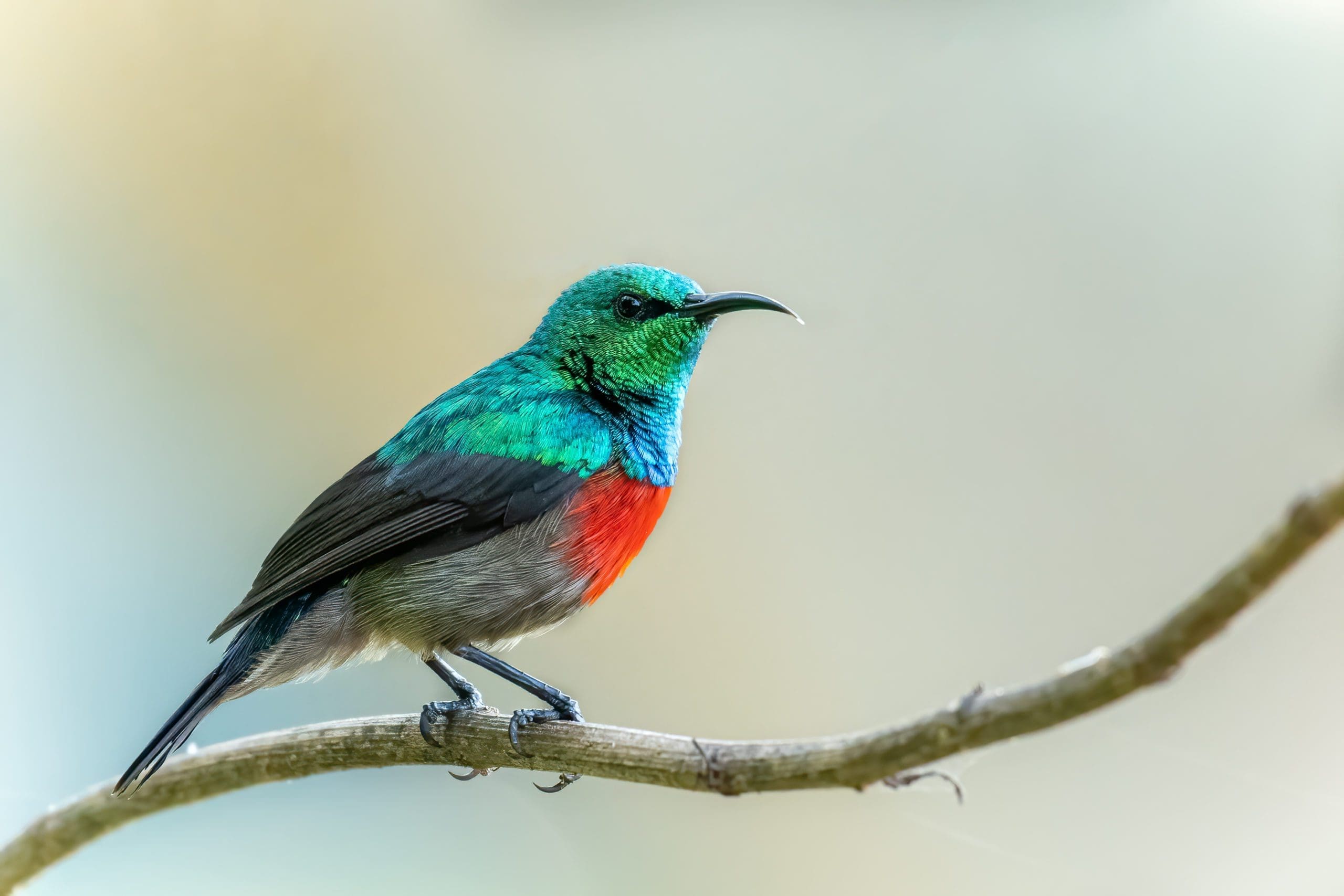
Sunbirds have a lengthy, curved beak that helps them reach deep into a flower to extract nectar. When the flower is just that much too deep, Sunbirds can be seen using their beak’s pointed tip to cut it open in order to reach their sweet prize.
There are approximately 80 sub-species of Sunbird in Africa, with the most commonly seen being the Collared Sunbird and Southern Double-collared Sunbird. Your best chance of seeing a Sunbird is in around tropical regions of sub-Saharan Africa and Madagascar, where they frequent flowered areas.
9. African Penguins
They might not be the first species that comes to mind, but not list of Africa’s most iconic birds would be complete without the African Penguin.
The second and last flightless bird on our list, African Penguins are relatively small – around 60 to 70cm in height. As with all penguin species, they are extremely charming and make up for their awkwardness on land, with a remarkable finesse in the water.
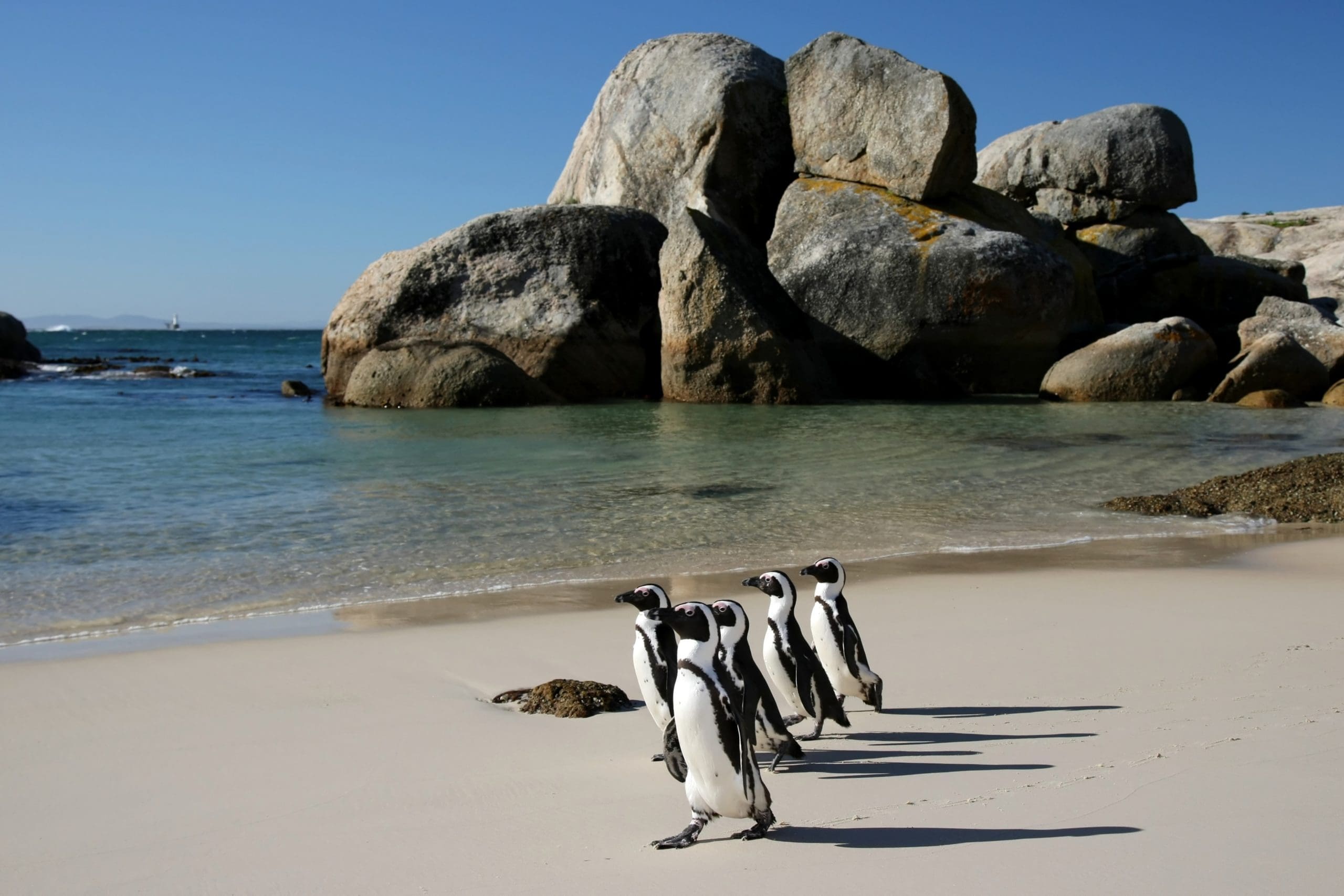
Affectionately known as ‘jackass penguins’ due to their high, donkey-like call, African penguins are only found in the south of the continent, in South Africa and Namibia specifically.
The best place to see these endangered birds is in Cape Town at either Foxy or Boulders Beach , not far from the city centre.
10. Shoebill
The Shoebill is one of the most prehistoric looking birds in the world. Its striking appearance leaves no questions as to how birds are the dinosaur’s closest descendants.
Also known as the Shoebill Stork , and aptly named after is colossal bill, the enormous species stands at around 1.5 metres in height and boasts a wing span of around 2.5 metres.
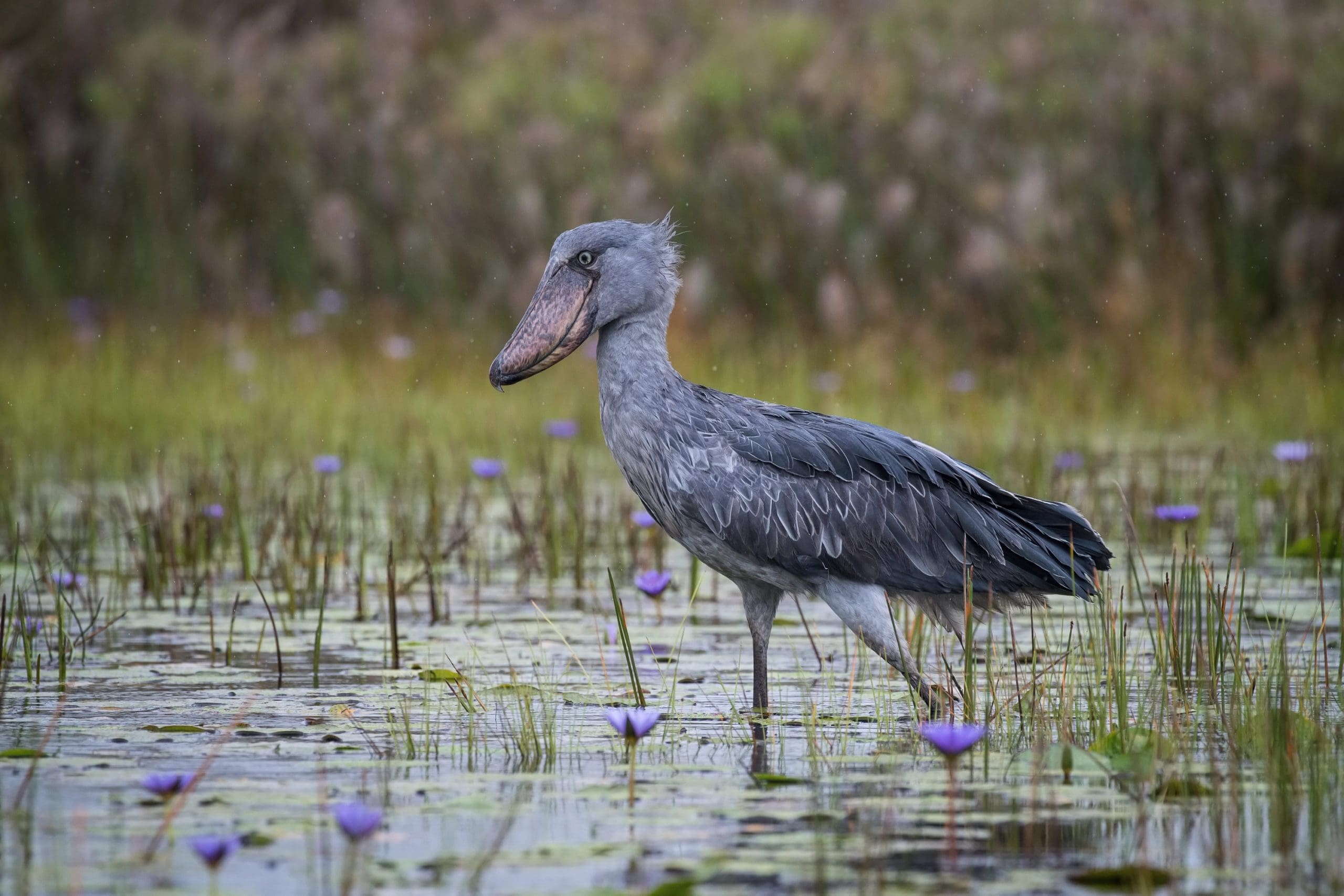
Largely silent, the shoebill can at times be heard clattering its bill together as a means of communication with other birds. They are a solitary species, which moves alone through muddy swamps and wetlands, preying on snakes , fish and frogs. They are known to remain still for hours on end, waiting patiently for a prey item to cross its path.
Today there are only between 5,000 and 8,000 of these incredible birds left in Africa , most commonly found throughout east and central Africa.
11. Flamingo
One of the most recognizable birds in the world, Flamingos are a prominent species in Africa.
Renowned for their brilliant pink coloration and tendency to stand on a single leg, they are a lanky species with the longest neck and legs of any bird, proportionate to their size. Adults can stand between around 1.3 metres tall and weigh no more than 5 kilograms.
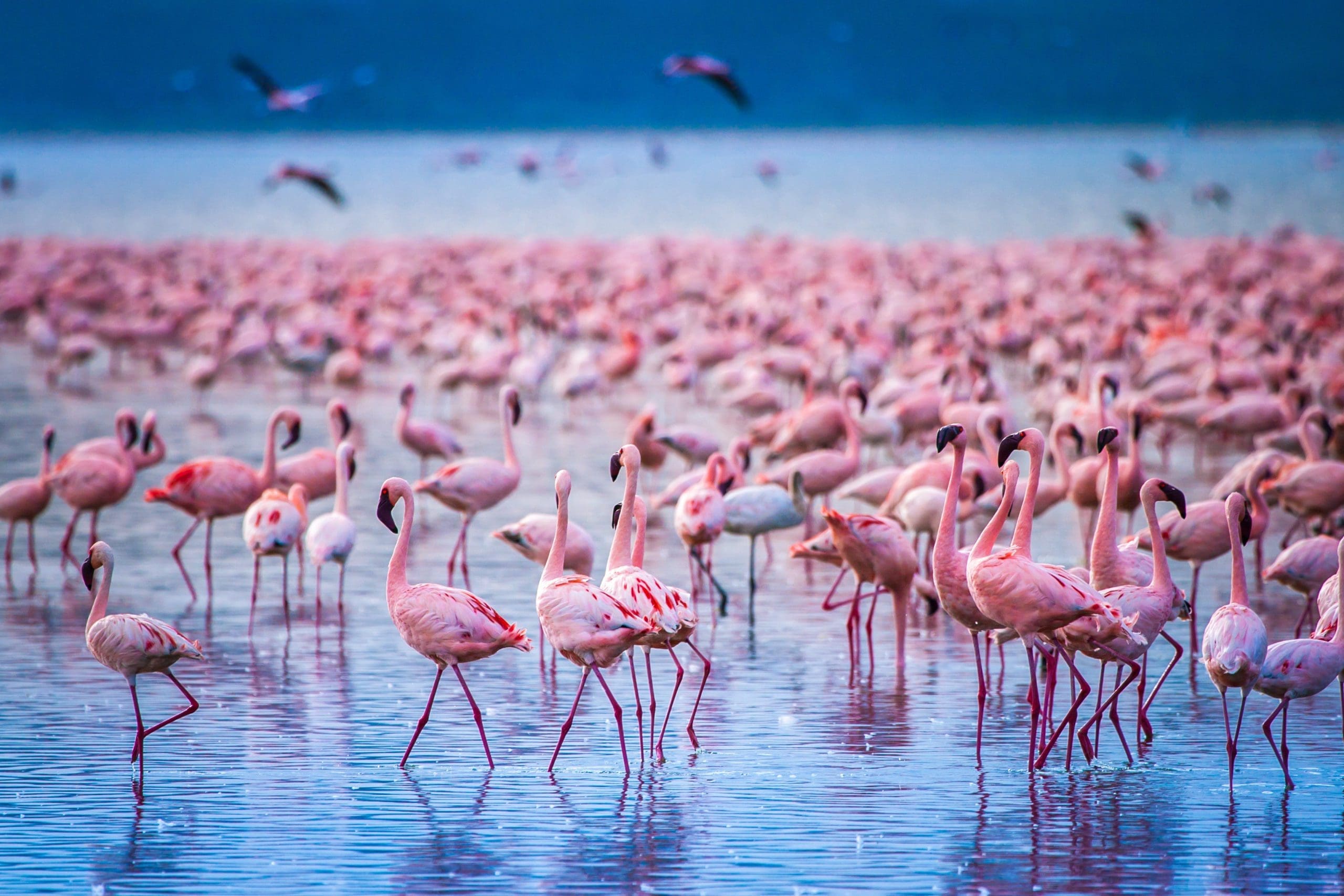
There are 2 different flamingo species native to Africa: the lesser and greater flamingo respectively.
Feeding on small crustaceans, plankton and shrimp, flamingos get their brilliant pink coloration from their diet.
Generally flamingo herds are found in and around salt lakes and some of the most notable places to find them are: Lake Nakuru in Kenya, Kamfers Dam in South Africa and Lake Natron in Tanzania.
12. African Fish Eagle
Eagles are one of the most dominant birds of prey on earth and Africa is home to a variety of these feathered predators.
They are large, strong birds with unparalleled eyesight – at least eight times greater than that of a human being – which allows them to spot small the smallest of prey from over a mile away.
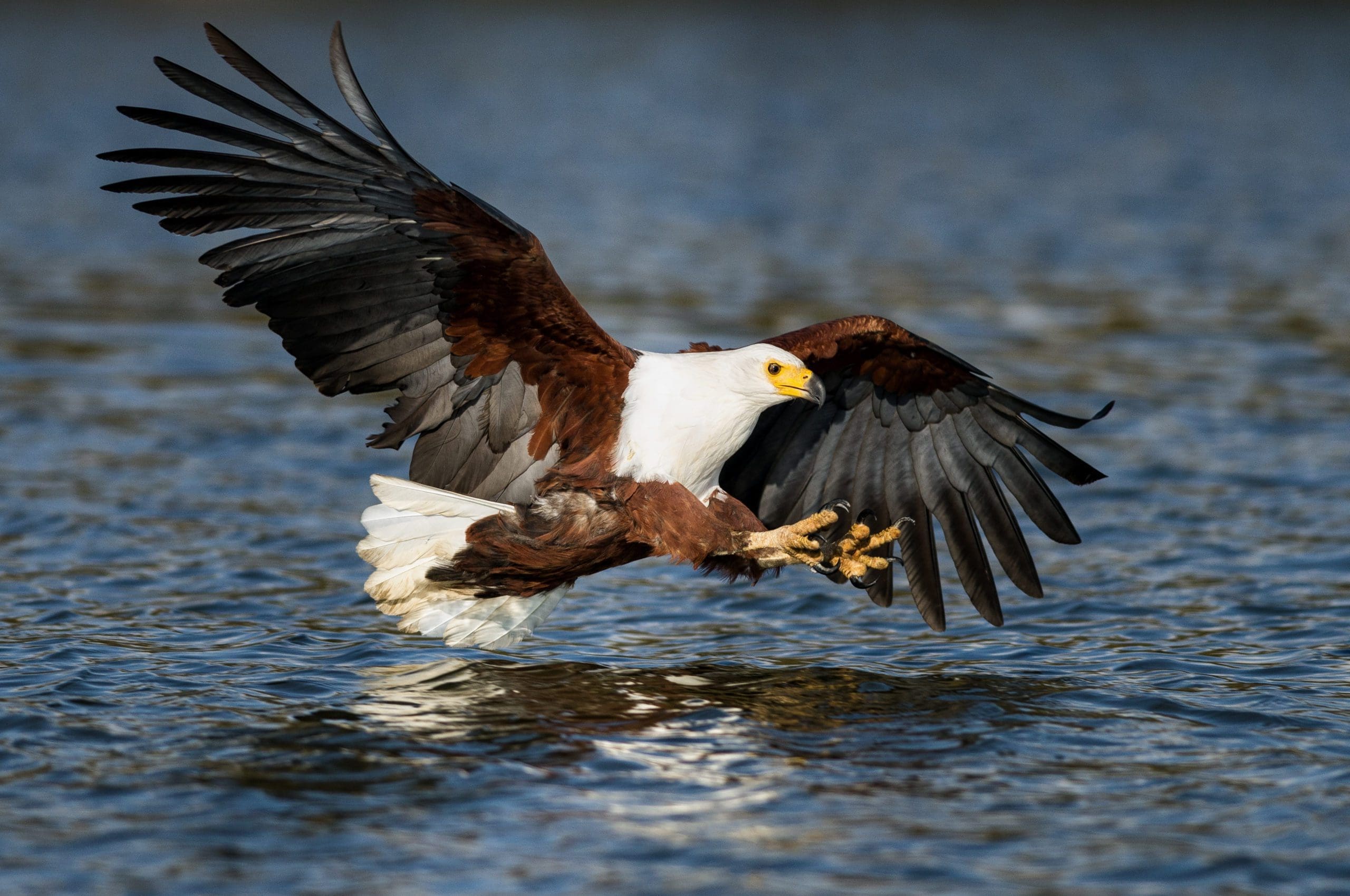
The African fish eagle is among the most iconic of all African predators , let alone the birds. As the name suggests, their diet primarily consists of fish, which they catch using strong talons that allow a vice-like grip on slippery food items. With a wingspan over up to 2.4 metres, they are lethal predators, often seen swooping down and grabbing fish straight out of dams and lakes.
Common all over sub-Saharan Africa , the Fish Eagle is the national bird of both Zambia and Namibia, and can readily be seen around perched high in a tree around a river, dam or lake.
STAY UPDATED
Join our community of keen travellers, wildlife enthusiasts and adventure seekers..
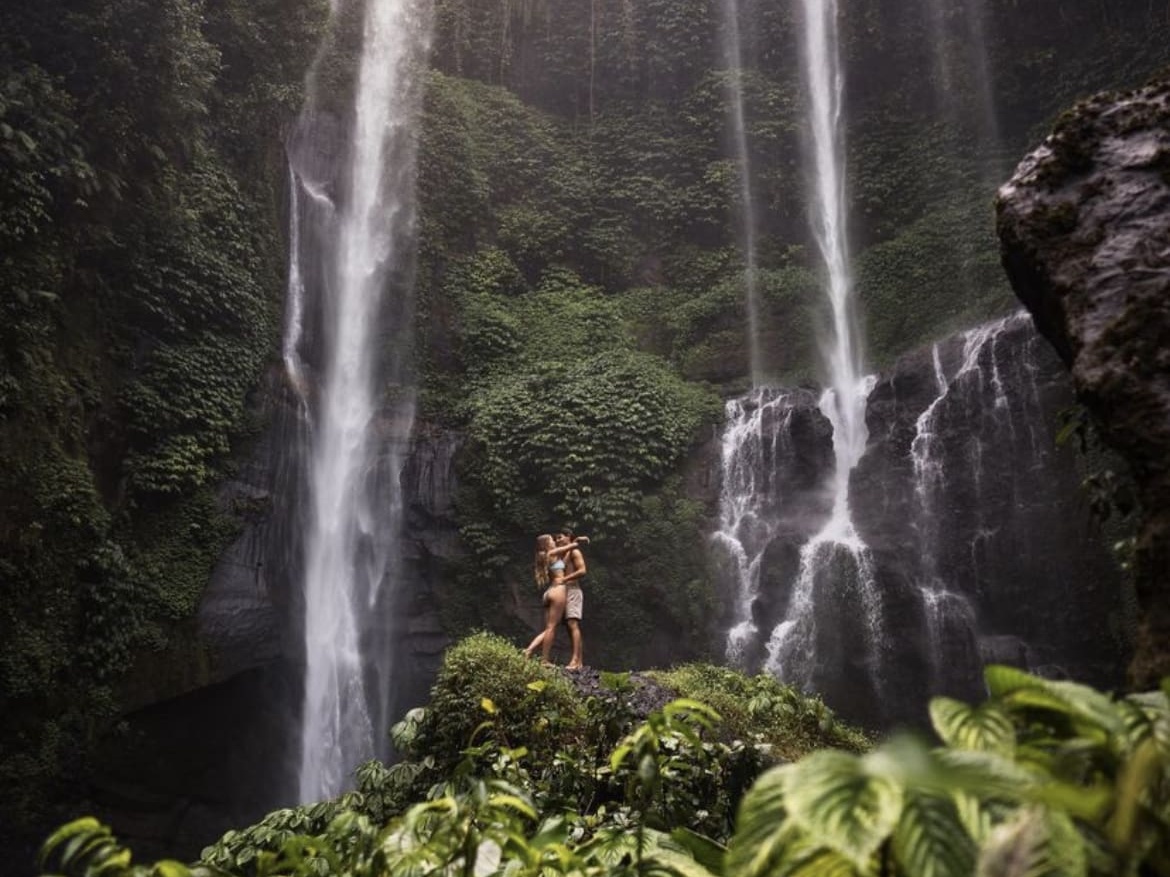
Hidden Waterfalls in Bali: How to Find Them and What to Expect

The Best Real Ale Pubs in Central London: Experience Authentic British Brews

The Ultimate Guide to Whiskey in Scotland: Regions, Distilleries, and Tastings

10 Secret Spots to Enjoy a Few Beers in London
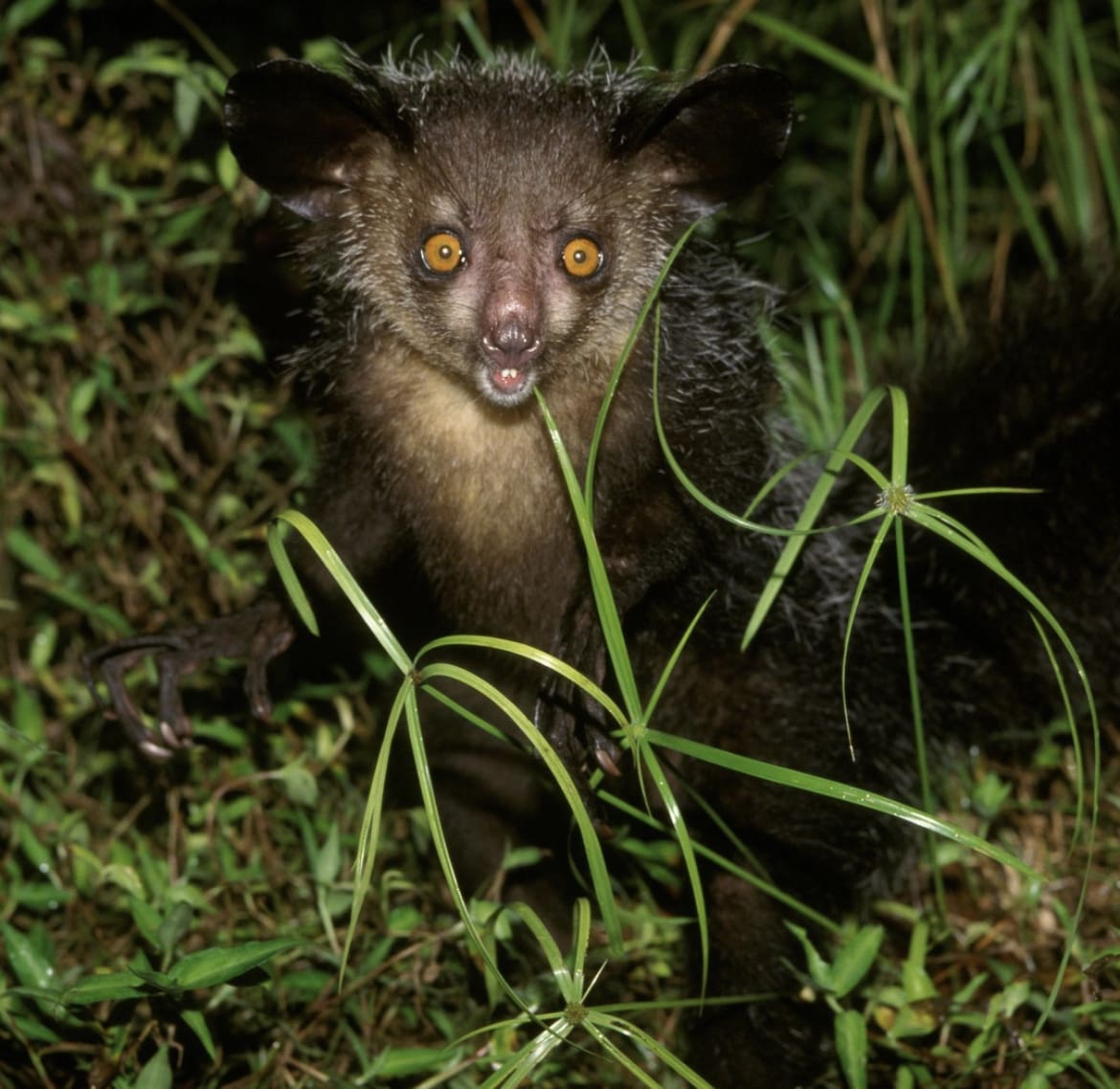
Get To Know The Aye-Aye
March 21, 2024
Alright, folks, let's dive into the world of one of the most bizarre creatures you've probably never heard of - the Aye Aye. This little critter is not your typical cute and cuddly pet material; it's more like the punk rocker of the animal kingdom, with its unconventional looks and nocturnal antics.
What is the Aye-Aye?
Native exclusively to Madagascar, the Aye Aye has the scientific community scratching their heads about where exactly it fits on the family tree. It's a lemur, but not just any lemur. It's like the black sheep of the lemur family, standing out with its unique features and behaviors.
Now, before you start thinking this is just another boring biology lesson, let me tell you, the Aye Aye is a creature that defies expectations. It's a symbol of Madagascar's incredible biodiversity and a testament to the island's evolutionary quirks. So, if you're into discovering the oddballs of the animal world, the Aye Aye is a goldmine.
What do Aye-Ayes look like?
Imagine a creature that looks like it's been assembled from parts of several different animals. Got it? Well, you're probably picturing something close to an Aye Aye. These guys have bushy tails that could rival any squirrel's, massive ears that look like they've been borrowed from a bat, and a face that's...well, let's just say it's got character.
But the real showstopper is the Aye Aye's hands, especially its middle finger. Thin, elongated, and downright eerie, this finger looks like it belongs in a horror movie. It's not just for show, though – more on that later. And their eyes? Big, bright, and reflective, these peepers are perfect for spotting dinner in the dead of night. So, while they might not win any beauty contests in the traditional sense, Aye Ayes are fascinatingly adapted to their unique lifestyle.
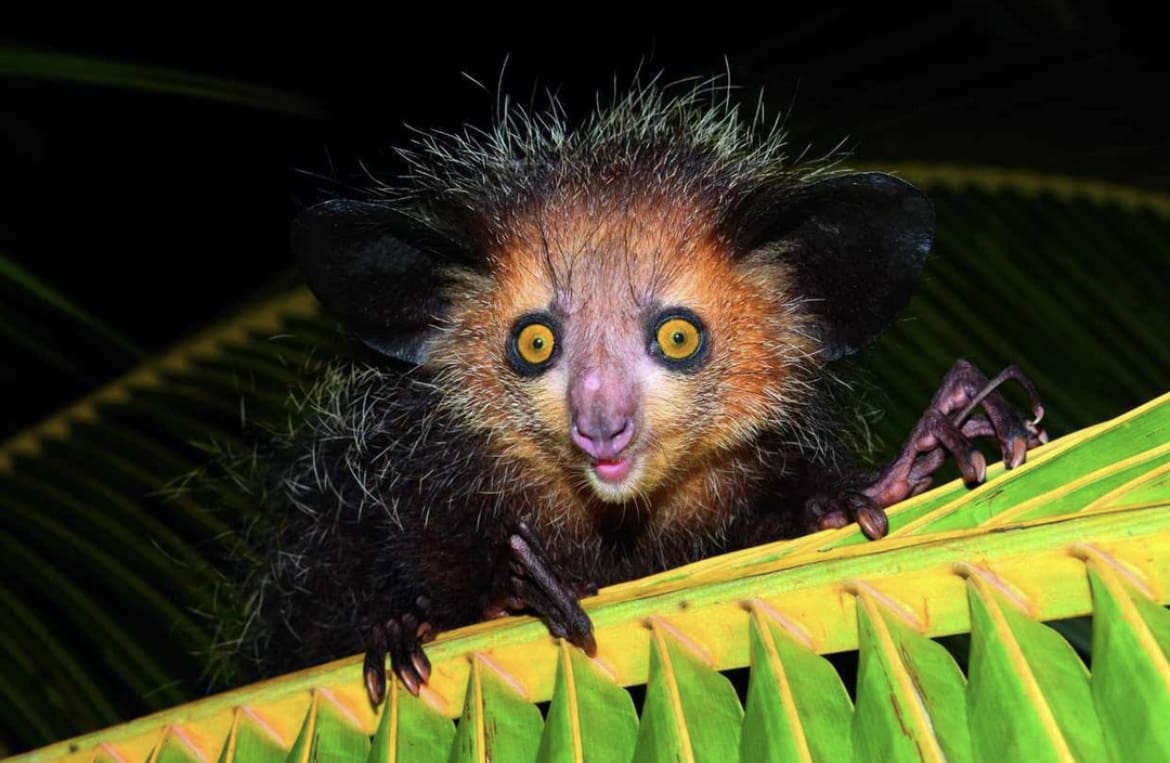
How big are Aye-Ayes?
When it comes to size, Aye Ayes are on the larger side for nocturnal primates but wouldn't exactly tip the scales. On average, they're about the length of a large house cat, but with much of that length coming from their bushy tails. Weighing in at around 2 to 2.5 kg (4 to 5.5 lbs), they're substantial enough to be impressive but still light enough to navigate the treetops with ease.
Aye-Aye Fur
Moving on from their size, let's talk about one of the Aye Aye's most noticeable features: its fur. If you're picturing something soft and cuddly, you might be a bit off the mark. The Aye Aye's coat is more on the coarse side, meant more for function than fashion. It ranges from dark brown to black, with a sprinkling of white or silver hairs that give it a slightly grizzled look. This isn't just about aesthetics, though; their fur is perfectly adapted to their nocturnal and arboreal life, providing camouflage among the trees and protection from the elements.
And here's a fun fact: the Aye Aye's bushy tail, which is longer than its body, isn't just for show. It acts as a kind of all-weather gear, wrapping around the body for warmth during those chilly Madagascar nights or fluffing out as a signal when the Aye Aye feels threatened or wants to assert its dominance. Talk about versatile fashion!
Aye Aye Teeth
But wait, there's more to the Aye Aye than just its funky fur and tail. Let's talk teeth. The Aye Aye's chompers are something else. Unlike other primates, its incisors grow continuously, much like those of a rodent. This might sound weird, but it's a key adaptation for its unique diet (hang tight; we'll get to that). These ever-growing front teeth allow the Aye Aye to gnaw through tough outer shells of nuts and insects' cocoons. So, while their dental situation might make an orthodontist wince, it's perfect for their lifestyle.
Aye Aye Finger
Now, onto the main attraction: the Aye Aye's infamous middle finger. If you thought the rest of the Aye Aye was odd, this slender, skeletal digit takes the cake. It's long, it's thin, and it's incredibly versatile. Primarily, this finger is a tool for foraging. The Aye Aye taps on wood with its other, more robust fingers and listens with its large ears for the echo that indicates hollow spaces where bugs might be lurking. Then, it uses that creepy-cool middle finger to fish out grubs and insects from the wood. Think of it as nature's own version of a Swiss Army knife.
But it's not just for feeding. This finger also has a role in grooming and perhaps even in social interactions among Aye Ayes. It's a prime example of how evolution can go down some pretty quirky paths when left to its own devices on an isolated island like Madagascar.
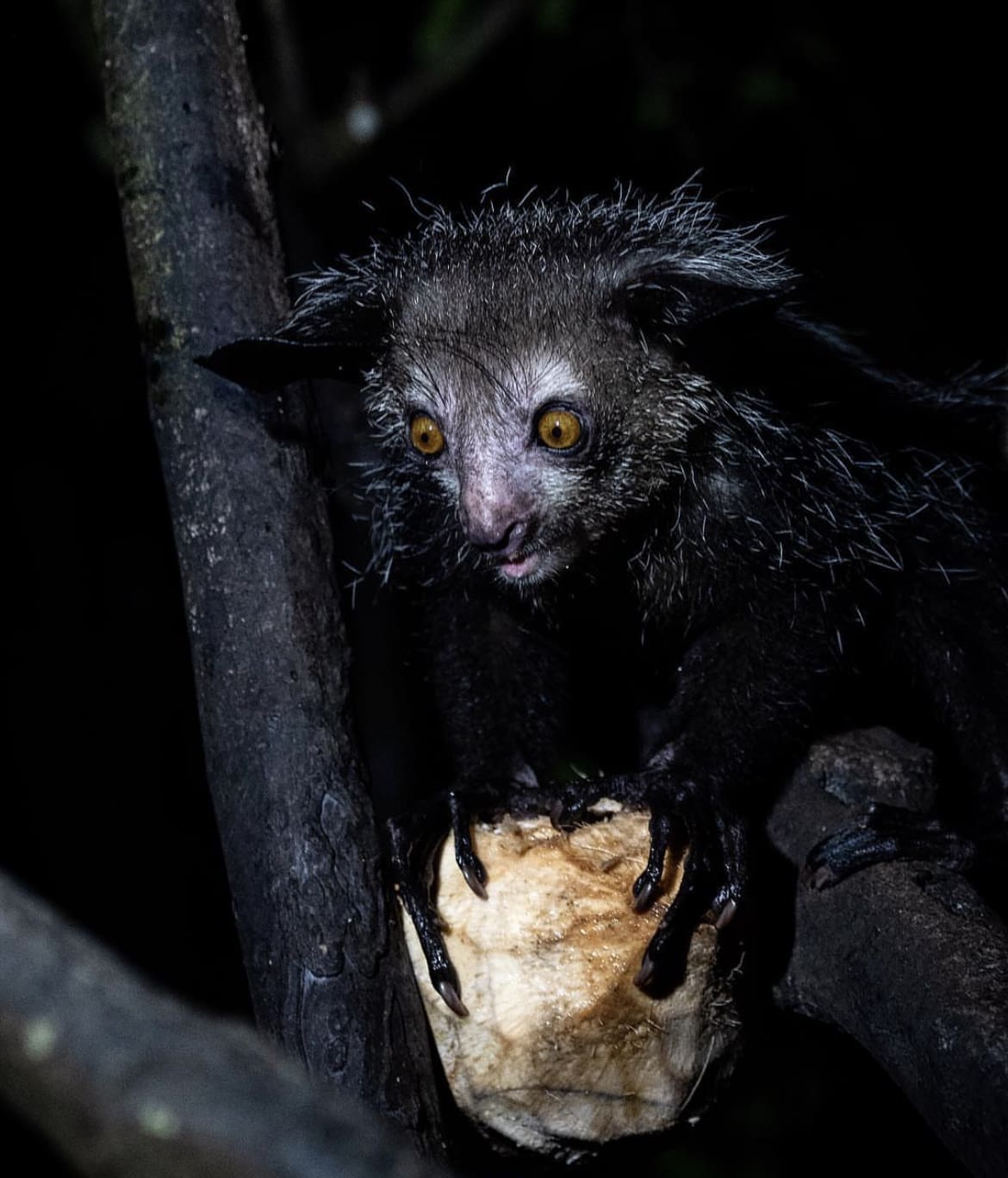
Aye-Aye Eyes
Delving deeper into the peculiar world of the Aye Aye brings us to their captivating eyes. Oversized and luminous, these orbs are the windows to the Aye Aye’s nocturnal soul, glowing eerily when caught in the light. Adapted to life under the cover of darkness, their eyes are large to capture as much moonlight as possible, allowing them to see in conditions that would leave us humans groping blindly. This exceptional night vision facilitates their unique foraging habits and keeps them alert to predators lurking in the shadows. It’s a mesmerizing feature that adds to the Aye Aye’s mysterious allure, proving that beauty truly is in the eye of the beholder.
Aye-Aye Colouration
The Aye Aye's coloration is as distinctive as its lifestyle. Its fur, a mix of black, brown, and occasionally with a hint of silver or white, isn't just about making a fashion statement in the animal kingdom. This mottled coat serves as excellent camouflage, blending seamlessly into the dark canopy of Madagascar's forests. It's a crucial adaptation for an animal that spends most of its life in the trees, allowing it to remain nearly invisible to predators and prey alike. The varying shades across its body and limbs also help break up its outline, making the Aye Aye a master of stealth. So, while its coloration may not win it any beauty contests, it's a vital part of the Aye Aye's survival kit, proving once again that in nature, function often trumps form.
What do Aye-Ayes eat?
Now, let's get to the juicy part - or should I say, the buggy part? The Aye Aye's diet is as unusual as the rest of its characteristics. These creatures are the animal kingdom's answer to a lock-picking kit, specializing in extracting hard-to-reach food sources with their unique set of tools. Primarily, Aye Ayes feast on insects and grubs, using their elongated middle finger to fish these critters out of tree bark or bamboo. But their diet isn't limited to just bug sushi; they also have a taste for fruit, nectar, and fungi.
This eclectic menu makes the Aye Aye a vital part of Madagascar's ecosystem, acting as both pest control and seed disperser. Their preference for certain types of nectar and fruit even helps with the pollination of some plant species. So, while their feeding habits might seem a bit odd to us, they play a crucial role in maintaining the health and diversity of their habitat. It’s a perfect example of how every creature, no matter how strange, has its place in the web of life.
Social Structure
Diving into the social world of the Aye Aye reveals a creature that values its personal space. Unlike the social butterflies of the animal kingdom, Aye Ayes are the introverts, preferring solitude over company. These nocturnal primates are mostly solitary creatures, coming together only for breeding purposes. Their social structure is loosely organized, with individuals having overlapping home ranges that they defend vigorously from others of the same sex.
Communication among Aye Ayes involves a mix of vocalizations, body postures, and even scent marking to convey messages across the treetops. These signals help maintain their solitary lifestyles, allowing them to come together when necessary but otherwise live independently. This preference for solitude is not just a quirky trait but a reflection of their specialized feeding habits, which require a large foraging area to support their diet. In the dense forests of Madagascar, the Aye Aye whispers its secrets, a solitary guardian of the night.
How do Aye-Ayes reproduce?
When it comes to matters of the heart, Aye Ayes are decidedly low-key. Their mating system is polygynous, meaning males may mate with multiple females when the opportunity arises. However, encounters between potential mates are rare, given their solitary nature and the vastness of their territories. When they do meet, courtship is a subtle affair, with much of the interaction focused on gentle pursuits and vocal communications.
Female Aye Ayes have a gestation period of about five months, after which they give birth to a single offspring. The young Aye Aye is weaned and begins to explore solid foods around two months but remains dependent on its mother for up to two years. This extended care period is crucial for the young Aye Aye to learn the complex skills needed for survival, from foraging techniques to navigating the treetops. The bond between mother and offspring is a testament to the Aye Aye's intricate life, hidden away in the heart of Madagascar's forests.
How long do Aye-Ayes live?
In the wild, the lifespan of an Aye Aye can be quite variable, but they are known to live for up to 20 years or more under the right conditions. In captivity, where threats are minimized, and nutrition is consistent, Aye Ayes have been known to reach ages of over 30 years. This longevity is remarkable for a creature of its size and is a testament to the Aye Aye's adaptability and resilience.
However, life in the wild is fraught with challenges, from finding enough food to avoiding predators and human threats. The Aye Aye's long lifespan allows it multiple breeding opportunities over the years, a crucial factor for the survival of this rare species. Each year in the life of an Aye Aye is a victory against the odds, a silent testament to the enduring spirit of Madagascar's most mysterious resident.
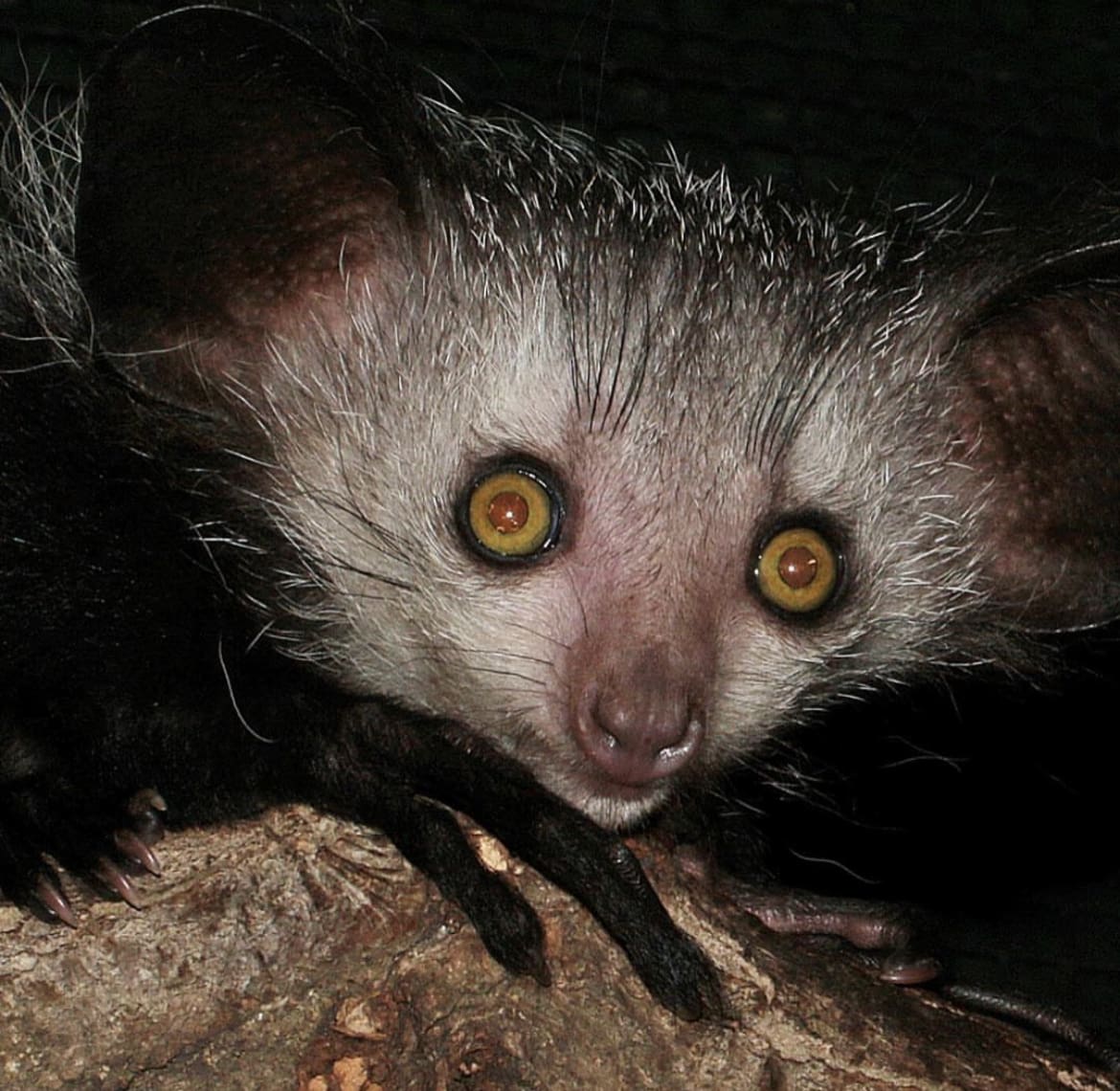
Is the Aye-Aye dangerous?
Let's debunk one of the biggest myths right off the bat: despite its somewhat ghoulish appearance and nocturnal habits, the Aye Aye is far from dangerous to humans. In fact, it's quite the opposite. These creatures are incredibly shy and will do their best to avoid human contact. The folklore surrounding them, however, paints a different picture, often depicting Aye Ayes as omens of bad luck or even harbingers of death. This unfortunate reputation has contributed to the persecution of Aye Ayes by locals in some areas of Madagascar, driven by fear and misunderstanding.
Scientifically speaking, Aye Ayes pose no threat. They're not aggressive unless cornered or captured, and their diet is primarily focused on insects and fruit. The biggest danger they pose is to the larvae of wood-boring insects. So, if you're not a grub hiding in a tree, you're probably safe. It's time we look past the superstitions and appreciate the Aye Aye for the unique and fascinating creature it is, not the mythical monster it's been made out to be.
Are Aye-Ayes territorial?
Indeed, Aye Ayes are quite territorial, especially when it comes to their feeding grounds. Given their specialized diet, they require large areas of forest to provide enough food, which means they're not too keen on sharing. Males have larger territories that may overlap with those of several females, and they spend a significant amount of time patrolling and marking their territory with scent. This territorial behavior ensures that they have exclusive access to the resources within their domain, critical for their survival.
Despite their solitary nature, Aye Ayes maintain a complex network of territories that intersect and overlap, allowing for the necessary interaction during mating seasons. These territories are not just random patches of forest but carefully chosen areas that offer the best opportunities for foraging and nesting. So, while they may not be social butterflies, Aye Ayes have a deep connection to their home turf, defending it with surprising vigor against intruders.
How fast are Aye-Ayes?
When it comes to speed, Aye Ayes are not the sprinters of the animal kingdom. Their movement is more deliberate, adapted to their nocturnal lifestyle and arboreal habitat. In the dense forests of Madagascar, agility and precision are more valuable than speed. Aye Ayes navigate the treetops with a slow, methodical grace, using their long fingers to probe for food and their large eyes to scan for danger.
However, don't let their slow pace fool you. When threatened, Aye Ayes can make a quick getaway, leaping from branch to branch with surprising agility. Their movement through the trees is a blend of creeping and climbing, carefully calculated to avoid drawing attention. So, while they might not win any races, Aye Ayes are perfectly tuned to the rhythms of the forest, moving at a pace that keeps them safe and well-fed.
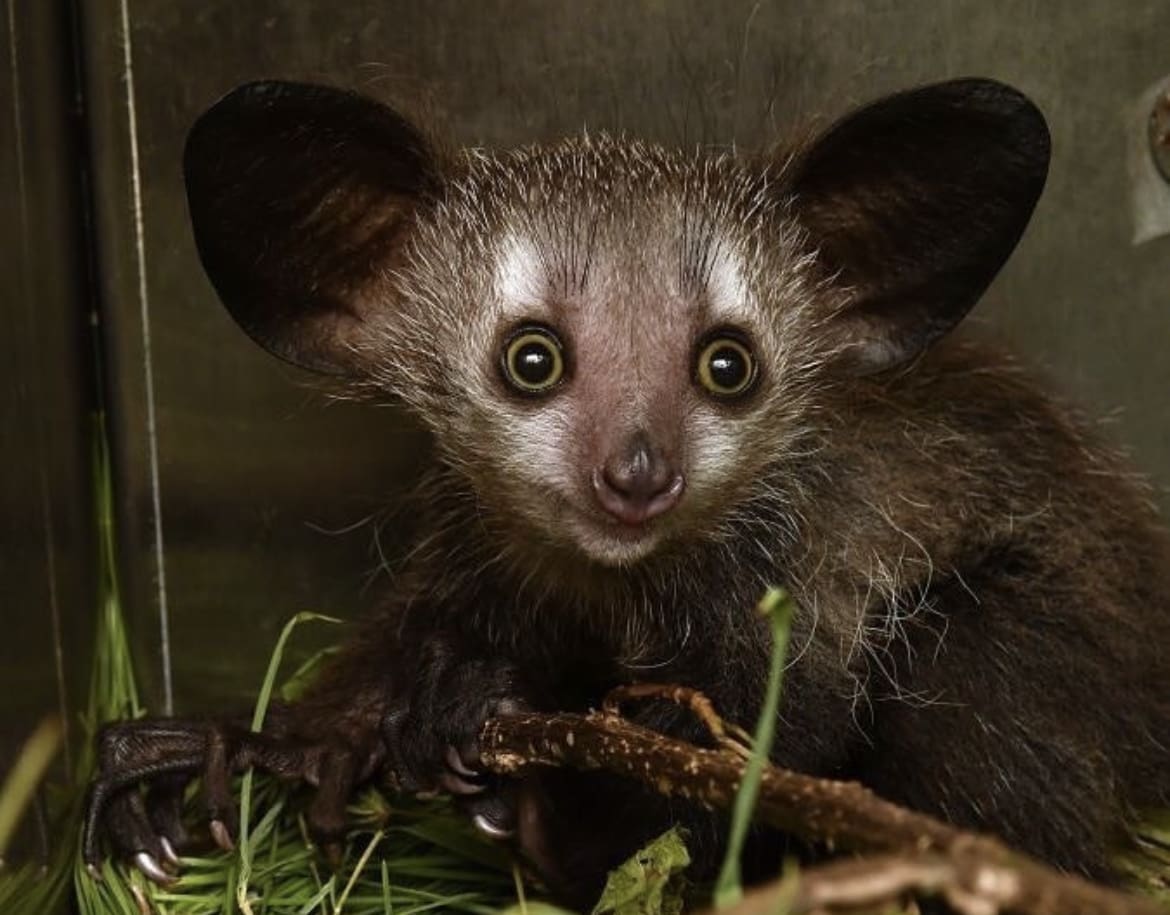
Where do Aye-Ayes live?
Aye Ayes call the lush and diverse forests of Madagascar their home, showcasing a remarkable adaptability to various habitats across the island. From the rain-drenched northern forests to the dry deciduous regions in the west and the bamboo groves of the east, Aye Ayes make themselves comfortable wherever there’s wood to be gnawed and insects to feast on. Their presence across such varied environments highlights not just the Aye Aye’s versatility but also the richness of Madagascar’s ecosystems.
These solitary creatures are masters of their realm, weaving through the treetops in the cover of night. The dense canopies of Madagascar offer more than just shelter and food; they provide a secluded haven far from human disturbances. However, the encroachment of civilization and the clearing of forests for agriculture are shrinking these habitats, pushing the Aye Aye into increasingly isolated patches of wilderness.
How many Aye-Ayes are there in the wild?
Quantifying the Aye Aye population is a challenging task, thanks to their elusive nature and the dense habitats they prefer. Estimates vary, but the consensus among conservationists is that their numbers are declining. The exact count of Aye Ayes in the wild remains a mystery, a reflection of the difficulties in studying these nocturnal creatures. Researchers rely on indirect methods, such as sightings, nest counts, and acoustic monitoring, to gauge their population density and distribution.
What is clear, however, is that the Aye Aye is under threat. Habitat destruction, hunting, and persecution due to local superstitions are the primary culprits behind their dwindling numbers. Conservation efforts are in place, aiming to protect the Aye Aye’s habitat and educate local populations about the vital role these animals play in the ecosystem. The survival of the Aye Aye is a crucial indicator of the health of Madagascar’s forests, making their protection a priority for conservationists worldwide.
Are Aye-Ayes endangered?
Yes, the Aye Aye is classified as Endangered on the IUCN Red List of Threatened Species . This status underscores the urgent need for conservation efforts to ensure their survival. Despite their adaptability to different forest environments, Aye Ayes cannot escape the widespread threats of deforestation, habitat fragmentation, and human superstition that lead to direct persecution.
The endangered status of the Aye Aye serves as a rallying cry for conservationists and wildlife enthusiasts. It emphasizes the importance of preserving Madagascar's unique biodiversity, not just for the Aye Aye but for all species that share its habitat. Protecting the Aye Aye involves a combination of habitat conservation, research, and community-based initiatives to mitigate human-wildlife conflict. The fight to save the Aye Aye is a fight for the heart of Madagascar itself, a battle against the clock to save one of the planet's most extraordinary creatures before it's too late.
Threats to Aye Ayes in the Wild
The Aye Aye faces a gauntlet of threats in its fight for survival, each one a piece of the puzzle that puts this unique species at risk. Habitat destruction is the heavyweight contender, with vast swathes of Madagascar's forests being cleared for agriculture, logging, and development. This not only reduces the Aye Aye’s living space but fragments it, isolating populations and making it harder for these solitary creatures to find mates and food.
But the challenges don't stop there. Hunting, fueled by local superstitions that cast Aye Ayes as harbingers of bad luck, adds another layer of danger. Though not targeted for bushmeat or the pet trade like other animals, Aye Ayes are often killed on sight out of fear. Additionally, climate change looms as a burgeoning threat, altering the delicate balance of their forest habitats and potentially disrupting the availability of their food sources.
Where to See Aye-Ayes In the Wild
For the intrepid wildlife enthusiast, Madagascar offers the unique opportunity to spot an Aye Aye in its natural habitat. However, patience and respect for these creatures’ nocturnal lifestyle are paramount. The Palmarium Reserve, also known as Ankanin'ny Nofy (Nest of Dreams), on the east coast of Madagascar, is one of the few places where Aye Ayes can be seen relatively easily, thanks to conservation efforts that protect a semi-wild population.
Eco-tourism, when conducted responsibly, can contribute to the conservation of the Aye Aye, offering a sustainable way for locals to value and protect their natural heritage. Visitors are encouraged to employ local guides, whose expertise and knowledge not only enhance the chance of an encounter but ensure minimal disturbance to the animals.
Tips for Spotting Aye Ayes
Seeing an Aye Aye in the wild is a rare privilege, requiring a bit of know-how:
- Go at night : Aye Ayes are nocturnal, so your best chance of spotting one is after dark.
- Stay quiet : Noise can scare them away, so move silently and keep chatter to a minimum.
- Use red light : If using a flashlight, cover it with red cellophane. Aye Ayes are less sensitive to red light, so it’s less likely to disturb them.
- Be patient : Wildlife watching is a waiting game. Stay in one spot and keep your eyes peeled.
Facts about The Aye Aye
- Aye Ayes are the world’s largest nocturnal primate.
- They have a unique method of finding food called percussive foraging, where they tap on wood to listen for insects moving inside.
- Aye Ayes have a special membrane over their third eyelid, known as a nictitating membrane, which helps protect their eyes while foraging.
- Unlike most primates, Aye Ayes have continuously growing incisors.
- They can rotate their third finger up to 360 degrees to extract food.
Myths about The Aye Aye
- Harbinger of death : In some Malagasy cultures, seeing an Aye Aye is considered an omen of death. This myth has contributed to their persecution.
- Human reincarnation : Some believe Aye Ayes are the reincarnated spirits of ancestors, adding to their mystique.
- Curses : There’s a myth that if an Aye Aye points its middle finger at you, you're cursed. Fortunately, this is just a tall tale.
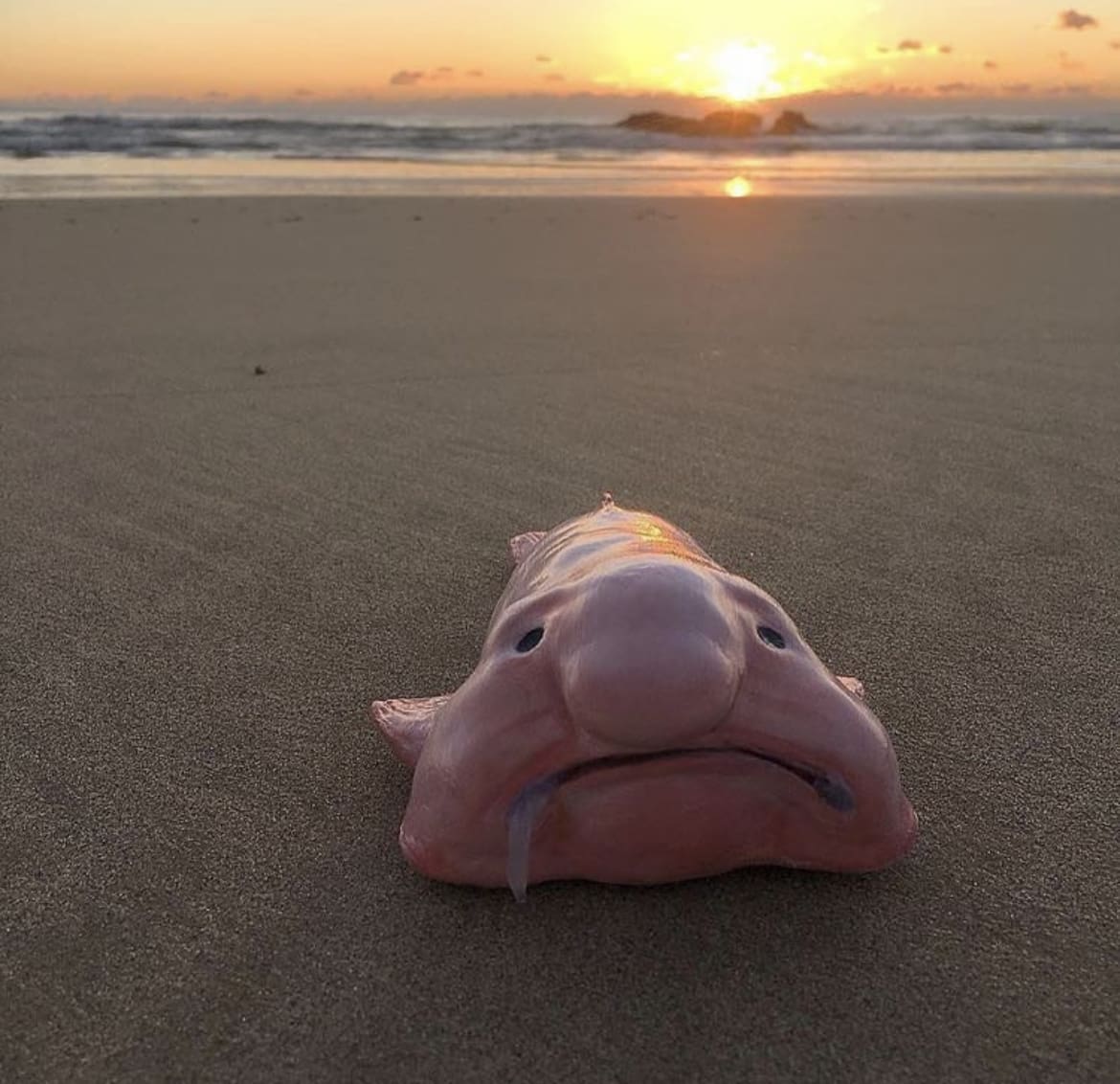
Get To Know The Blob Fish
So, you’ve probably seen this face only a mother could love plastered across memes and " ugliest animal " polls, right? Meet the blob fish, or Psychrolutes marcidus if you want to get all scientific about it. This gelatinous wonder isn't just a fixture of internet fame; it’s a bona fide inhabitant of the deep sea, living life at pressures that would squish the rest of us into a human pancake.
So What is the Blob Fish, Anyway?
Residing at depths of 600 to 1,200 meters where the pressure is an insane 60 to 120 times greater than at sea level, this fish has adapted to an environment that’s about as forgiving as a landlord on rent day.
Why the buzz, though? Well, the blob fish breaks the mold of your typical Nemo or Dory. It’s not about flashy colors or sleek swimming; it’s about survival in the deep blue’s equivalent of outer space. This creature is a testament to the weird, the adaptive, and the outright miraculous nature of evolution. So, buckle up as we dive deep (pun intended) into the world of the blob fish, a creature that challenges our perceptions of beauty and resilience in the animal kingdom.
What Do Blob Fish Look Like?
Imagine if a fish decided to go as a puddle for Halloween—that's your blob fish. Out of water, it’s got this droopy, sad sack appearance that's spawned a thousand memes. But don’t let its deflated balloon look fool you; in its natural habitat, the blob fish leads a far less comical existence.
With a body density slightly less than water, the blob fish is a master of the effortless float. No need for a swim bladder here; its gelatinous body allows it to hover just above the seafloor, waiting to ambush unsuspecting prey. This almost gravity-defying act is the blob fish's secret weapon, letting it conserve energy in an environment where every calorie counts.
Size-wise, they’re not about to win any heavyweight titles. Typically, blob fish are about as long as a ruler, with some variation here and there. Their appearance, often described as a mix between a grumpy old man and a glob of goo, belies a creature perfectly adapted to life under extreme pressure.
How Big Are Blob Fish?
So, how big does this gloopy ambassador of the deep get? On average, blob fish are around 30 centimeters (about 12 inches) long. But, like any good fish tale, sizes can vary. Think of them as the underwater equivalent of a medium-sized lapdog—only, you know, less cuddly and a bit more on the squishy side.
Their size is pretty much perfect for the life they lead. Big enough to gulp down whatever unfortunate sea critters happen to drift their way, but not so large as to make life under extreme pressure untenable. It’s all about that sweet spot, and the blob fish has found its niche in a place most other creatures would find inhospitable.
Blob Fish Skin: Not Your Average Fish Scale
When you’re living under the kind of pressure that would turn other fish into fish sticks, you’ve got to have skin that can handle it. The blob fish's skin is a marvel of deep-sea adaptation. It’s not about winning beauty contests; it's about survival. This fish’s skin is thick, gooey, and gelatinous, providing just the right amount of resistance against the crushing depths. No scales here—just a smooth, jelly-like texture that would probably make for the world’s worst facial.
This squishy exterior plays a critical role in the blob fish’s life. It’s density is just right, allowing the fish to float above the sea floor without wasting energy on swimming. Think of it as nature’s way of giving the blob fish a perpetual hover mode. Plus, it's incredibly efficient. No need for a fancy swim bladder; the blob fish’s own body composition keeps it buoyant. In a place where efficiency is key, the blob fish's skin is its ticket to an easy ride.
Blob Fish Teeth
Now, before you start imagining the blob fish with a shark-like grin, let’s set the record straight: if the blob fish had a dental plan, it’d be pretty minimal. Its mouth is more about gulping than chewing, equipped to swallow marine snow (organic material that falls from higher in the water column) and small critters whole.
The blob fish’s diet is a low-effort affair, fitting for a creature that looks like it can’t be bothered. It’s not out chasing down meals; instead, it waits for the buffet to come to it. The design of its mouth and the near-absence of teeth reflect this laid-back dining style. So, no, it’s not going to bite—unless you’re a tiny sea creature that happens to float by.
Blob Fish Eyes
Given its underwhelming dental situation, you might wonder if the blob fish has better luck in the vision department. Living in the deep, dark depths of the ocean, you’d think evolution would hook it up with some night-vision goggles or something. Well, the blob fish’s eyes are small and not particularly well-adapted for seeing in the dark, murky waters it calls home.
This might seem like a raw deal, but remember, the blob fish doesn’t need to dodge predators or chase down speedy prey. Its lifestyle is more about sitting tight and waiting for food to come to it. The blob fish's eyes are good enough for detecting the faint silhouettes of food floating by, and in the deep sea, that’s all you really need. It’s a world where energy conservation is key, and every adaptation, no matter how seemingly underwhelming, serves a purpose.
Blob Fish Coloration
When it comes to fashion, the blob fish isn’t winning any awards, but in the high-pressure world of the deep sea, its coloration is all about functionality. Sporting a nondescript, muted palette that ranges from a dusky pink to a drab grey, the blob fish’s coloration is the perfect camouflage for the deep blue. This isn’t the bright, coral reef part of the ocean; it’s the murky, no-light zone where blending in means staying alive.
This subtle coloration helps the blob fish avoid becoming an easy target for the few predators that roam its deep-sea neighborhood. Plus, without any natural light, flashy colors wouldn’t be seen anyway. The blob fish’s look is perfectly adapted to its environment, ensuring it stays under the radar, both literally and figuratively.
What Do Blob Fish Eat?
You might expect the diet of the blob fish to be as bizarre as its appearance, but it's surprisingly mundane. Primarily, blob fish are opportunistic feeders, dining on whatever edible bits drift down to their level. This can include small crustaceans, sea pens, and other slow-moving or stationary deep-sea snacks. The blob fish’s eating strategy is the ultimate in energy conservation. Why swim after your food when you can just open your mouth and wait for dinner to float in?
The blob fish’s diet reflects its overall strategy: minimal effort for maximum gain. It’s not picky; when you live where it does, you can’t afford to be. Every meal is about making the most of what the deep sea provides, utilizing a lifestyle that conserves as much energy as possible. In the blob fish's world, it’s not about the thrill of the hunt; it’s about the wait for the drift.
Blob Fish Social Structure
If you’re picturing a social network of blob fishes hanging out and sharing the latest sea gossip, you might be a bit disappointed. Blob fishes are largely solitary creatures, rarely interacting with others of their kind. Their social structure, if you can call it that, is more about solitary survival than forming bonds or communities.
This doesn’t mean blob fishes are complete loners by choice. Their sparse population and the vastness of their deep-sea environment make encounters with other blob fishes rare. When they do meet, it’s usually by chance, and there’s little to no interaction. They don’t form schools or pairs; each blob fish is an independent unit, drifting through the deep sea and living a life of quiet solitude.
The lack of social structure among blob fishes is yet another adaptation to their environment. In the deep sea, resources are scarce, and competition is minimal. There’s no need for complex social behaviors when you spend your days floating alone, waiting for food to come your way. For the blob fish, solitude is not just a way of life; it’s the key to survival in one of the most inhospitable places on Earth.
How Do Blob Fish Reproduce?
Diving into the love life of the blob fish, you might be surprised to find it’s not as gloomy as their expression suggests. When it comes to reproduction, blob fishes maintain their low-energy ethos, but they do get the job done. The details are a bit murky—after all, observing blob fish in the wild, especially during intimate moments, is a challenge. However, it’s believed that like many deep-sea creatures, blob fishes employ external fertilization, where females release eggs into the water to be fertilized by males.
This method fits perfectly with their laid-back lifestyle. There’s no need for elaborate mating dances or long courtships in the deep sea. Instead, it’s about maximizing the chance of success with minimal effort. The females lay eggs on the ocean floor, often under rocks or in other protected areas, and the males fertilize them as they pass by. Once the deed is done, blob fish parents go their separate ways, leaving the eggs to develop and hatch on their own.
How Long Do Blob Fish Live?
Estimating the lifespan of a creature as elusive as the blob fish is tricky, but they’re believed to have relatively long lives for fish, potentially living for several decades. This extended lifespan is likely a result of their slow-paced lifestyle and the stable, albeit harsh, conditions of the deep sea.
The blob fish’s longevity is another testament to its efficiency. In an environment where every movement and every calorie counts, growing slowly and living long is a strategy that makes sense. It allows them to reproduce over a longer period and increases their chances of survival in the deep sea’s vast and sparsely populated expanses.
Is the Blob Fish Dangerous?
Let’s face it, the blob fish looks like it couldn’t chase you down even if it wanted to. And you’d be right to think so. Blob fishes pose no danger to humans—mostly because they’re deep-sea dwellers and our paths rarely cross. But even in their own domain, blob fishes are harmless. They’re not predators in the traditional sense; they’re scavengers and opportunistic feeders, living off what the ocean currents bring their way.
The idea of the blob fish being dangerous is a bit of a humorous notion. With their slow movements, gelatinous bodies, and passive feeding habits, they’re about as threatening as a bowl of Jell-O. The only risk they pose is to the tiny invertebrates that drift into their path. For the rest of the ocean—and for us humans—the blob fish is simply a fascinating example of nature’s adaptability, not a creature to be feared.
Are Blob Fish Territorial?
Given their solitary and passive nature, you might wonder if blob fish have any territorial instincts. In the vast and empty expanses of the deep sea, the concept of territory is a bit different from what you'd find in more populated waters. Blob fish do not exhibit territorial behavior in the traditional sense; they don’t guard specific patches of ocean floor or chase away intruders. Their survival strategy does not rely on defending a particular area but rather on being able to exist wherever there’s enough deep-sea detritus and small creatures to consume.
This lack of territorial aggression further underscores the blob fish’s energy-conservation lifestyle. In an environment where encounters with others of their kind are rare, and the effort required to actively defend a territory would far outweigh the benefits, the blob fish opts for a more nomadic existence, drifting wherever the currents and food supply take them.
Can Blob Fish Swim?
The image of the blob fish lazily floating in the deep might lead some to question its swimming abilities. Indeed, blob fish are not strong swimmers. Their bodies are designed more for buoyancy and drifting than for active, agile movement. The blob fish relies on its gelatinous body, which is slightly less dense than the surrounding water, to maintain its position in the water column with minimal effort.
Instead of swimming through the water like many fish, blob fish are more likely to use subtle movements to navigate their deep-sea environment. These movements are so minimal they might not even be considered swimming in a traditional sense. This adaptation is perfect for the energy-scarce deep sea, where conserving calories is crucial for survival.
How Fast Are Blob Fish?
Given their lack of swimming prowess, it’s probably no surprise that speed is not in the blob fish’s repertoire. You won’t find blob fish participating in any underwater races; they’re among the slowest-moving creatures in the ocean. Their mode of transportation is more about gentle drifting than speed, perfectly suited to their low-energy lifestyle and the environment they inhabit.
The blob fish’s lack of speed is yet another adaptation to the high-pressure, low-energy world of the deep sea. In a place where fast movements and high speeds would require more energy than the environment can provide, the blob fish’s slow, drifting way of life ensures it conserves every possible bit of energy, optimizing its chances of survival in the deep.
Threats to Blob Fish in the Wild
The blob fish faces several threats, many of which stem from human activities. Despite its deep-sea habitat, it's not immune to the impacts of fishing, particularly bottom trawling, which disrupts the seabed environment. This form of fishing can destroy the delicate balance of the blob fish’s ecosystem, affecting its food sources and directly endangering its population. Additionally, climate change poses a less direct but equally concerning threat, potentially altering the deep-sea environment in ways that could affect the blob fish and its neighbors.
The challenge in protecting the blob fish lies in the complexity of its habitat. The deep sea is a difficult place to study and even harder to manage for conservation. Efforts to mitigate these threats require international cooperation and a commitment to sustainable fishing practices and ocean conservation.

Where to See Blob Fish
For those intrigued by the blob fish and wishing to catch a glimpse outside of the digital realm, options are, unfortunately, limited. Their deep-sea habitat makes direct observation virtually impossible for casual enthusiasts. However, some specimens have been brought to the surface and preserved in museums and aquariums. The Australian Museum in Sydney, for example, has a blob fish specimen on display.
These preserved specimens offer a rare opportunity to see the blob fish up close, but they also serve as a reminder of the creature's vulnerability. Public education and awareness can play a significant role in the conservation of the blob fish and its habitat, making these displays more than just curiosities; they're a call to action.
Tips for Spotting Blob Fish
For the aspiring blob fish spotters, the reality is that seeing one in its natural habitat is unlikely. However, there are ways to engage with the world of the blob fish and deepen your understanding of this unique creature:
- Visit museums and aquariums that feature deep-sea exhibits.
- Support and follow deep-sea research expeditions online; many share findings and images from their dives.
- Engage with conservation organizations that focus on ocean protection, helping to preserve the habitat of the blob fish and countless other deep-sea creatures.
Facts about The Blob Fish
- The blob fish lives at depths where the pressure is dozens of times higher than at sea level.
- It has a gelatinous body that allows it to float just above the seafloor, conserving energy.
- Despite its somewhat sad appearance out of water, the blob fish is perfectly adapted to its deep-sea environment.
- It is not considered dangerous to humans or other large marine animals.
- The blob fish’s diet consists mainly of small invertebrates that float into its mouth.
Myths about The Blob Fish
- It's the ugliest fish in the sea: Beauty is in the eye of the beholder, and the blob fish’s appearance is a result of its deep-sea adaptations.
- It can be found all over the world: The blob fish is primarily found in the waters around Australia, Tasmania, and New Zealand.
- It's always been a popular oddity: The blob fish rose to internet fame relatively recently; before that, it was a little-known creature of the deep.
The blob fish, with its peculiar appearance and deep-sea lifestyle, captivates the imagination and highlights the diversity of life on our planet. It serves as a reminder of the wonders that lie hidden in the depths of the ocean and the importance of preserving these fragile ecosystems. Through understanding and appreciating creatures like the blob fish, we can foster a greater connection to the natural world and a stronger commitment to its protection.
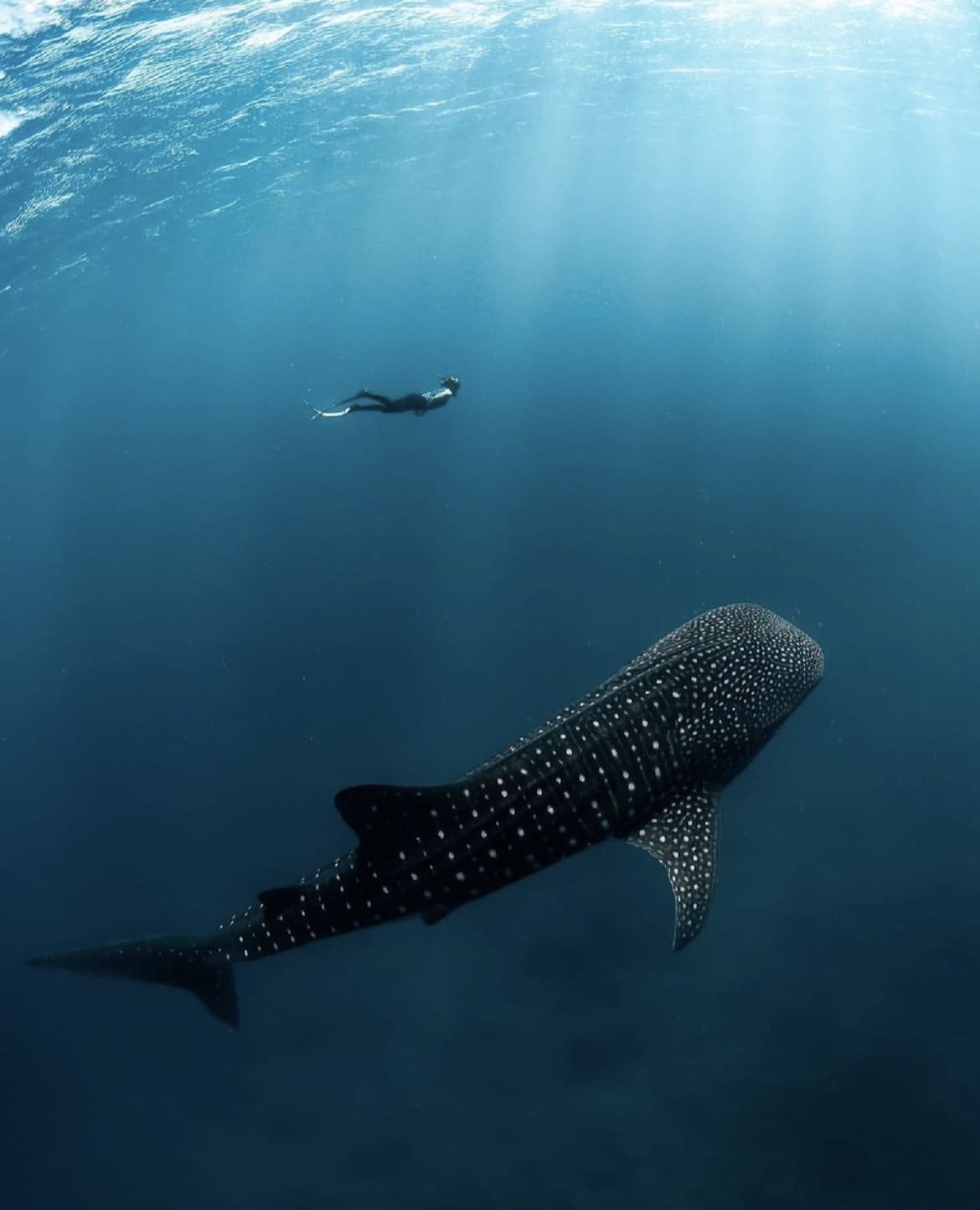
Get To Know The Whale Shark
The whale shark isn't your average fish. It's like the ocean decided to go big or go home, creating the largest fish that swims our seas today. They are the prime definition of the ocean's very own gentle giant.
Let's unravel the mysteries of these fascinating creatures together, shall we?
What is the Whale Shark?
Officially known as Rhincodon typus , the whale shark holds the title in the heavyweight category, yet it's as gentle as a giant can get. This majestic creature roams the tropical oceans of the world, filtering tons of water for plankton and small fish to eat.
Despite their mammoth size, there's nothing to fear from these peaceful beasts; they're the ocean's filter-feeders, calmly cruising through the water.
What do Whale Sharks Look Like?
Imagine a bus. Now, imagine it’s swimming in the ocean with spots. That's pretty much a whale shark for you. These guys can grow up to 40 feet long (some even say 60 feet!), making them the biggest fish in the sea. But it's not just their size that's impressive. Whale sharks have a broad, flat head, a wide mouth that can stretch up to 4 feet wide, and a body covered in a beautiful pattern of white spots and stripes. These spots are like fingerprints; no two whale sharks have the same pattern.
Their skin is as thick as rubber, and those unique patterns aren’t just for show; they help camouflage the whale shark in the sun-dappled water, breaking up their outline to any potential predators lurking below. And let’s not forget about their tail, which is massive and powerful, propelling them through the ocean with slow, languid movements. They're the epitome of "floating like a butterfly, stinging like a bee" – if, you know, they actually stung and weren't just big, docile fish.
So, are they Whales or Sharks?
So, the million-dollar question: Are they whales or sharks? Despite their name and size, whale sharks are sharks. But let's not hold the "shark" part against them; these creatures are about as far from the "Jaws" stereotype as you can get. Being part of the shark family means they've got cartilage instead of bones, which is pretty standard in the shark playbook. But unlike their often-feared cousins, whale sharks are filter feeders, meaning they're more interested in plankton than anything else.
So why the name "whale" shark? It's all about the size, folks. These creatures are as large as some species of whales, and just like whales, they filter feed. But make no mistake, they're 100% shark, just the kind you'd love to meet face to face.
How Big are Whale Sharks?
Okay, picture this: you're snorkeling in the clear blue, and a shadow engulfs you—a shadow as big as a school bus. No need to panic; it's just a friendly whale shark, casually passing by. These guys can stretch up to 40 feet on average, with some legends reaching a whopping 60 feet or more. That's longer than a professional basketball court. Imagine playing a game on the back of one of these creatures! Their enormous size doesn't make them fast swimmers, though. They prefer the chill life, moving through the water at a leisurely pace, which is fantastic news for awe-struck snorkelers and divers hoping to catch a glimpse.
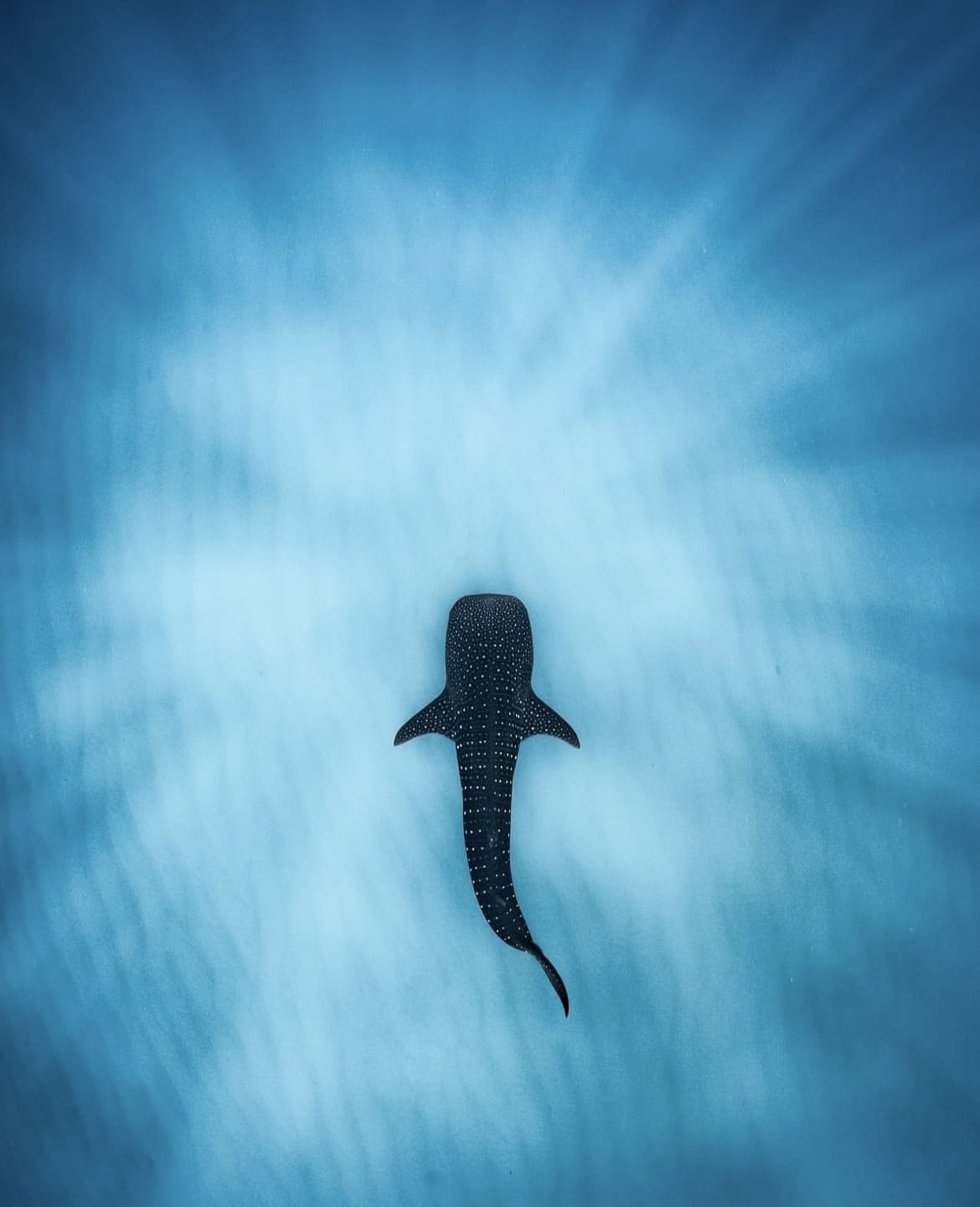
Whale Shark Skin
Let's talk about their skin for a sec. It's not just any skin; it's a thick, tough hide that can be up to 4 inches thick. That's like having a natural suit of armor. This tough exterior is speckled with those beautiful white spots and stripes we mentioned earlier, making each whale shark uniquely identifiable. But it's not just about looks. This skin is designed to protect them from the harsh realities of ocean life, including pesky parasites and would-be predators. Plus, their skin helps with hydrodynamics, allowing them to glide effortlessly through the water despite their massive size.
Whale Shark Teeth
Now, onto their teeth, because yes, they have them, and no, they're nothing to worry about. Whale sharks have thousands of tiny teeth (about 3,000!), but they're not for chewing. These teeth are so small they're almost like bristles. Remember, whale sharks are filter feeders. They open their gigantic mouths to scoop up tons of water, which they then filter out through their gills, trapping plankton, small fish, and other sea snacks. It's like they're living the dream, swimming with their mouths open, catching all the food they want without lifting a fin. So, despite having all those teeth, they're as harmless as a fish can be.
Do Whale Sharks make sounds?
When it comes to the ocean's giants, we often hear about the haunting songs of whales. But what about whale sharks? Do these massive fish serenade the ocean depths? Well, not quite. Whale sharks are the strong, silent type. They don't produce sounds that humans can hear, as they communicate and navigate their world in different ways, primarily through body movements and possibly through sensing vibrations in the water. This silence adds to their mystique, making encounters with them even more magical and serene. You won't hear them coming, but spotting the shadow of a whale shark approaching is a moment of awe and silence you'll never forget.
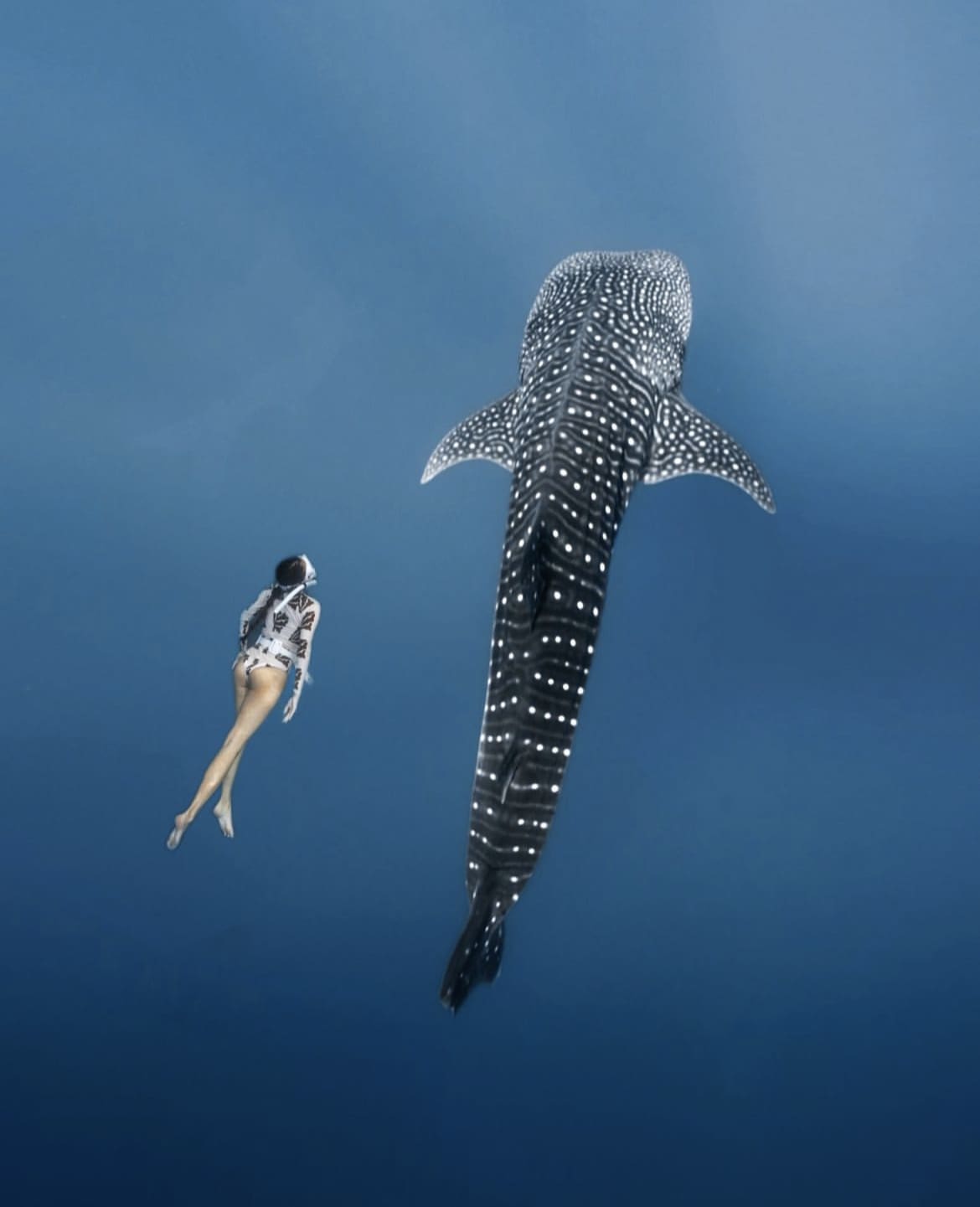
Whale Shark Colouration
Moving on to something a bit more visible: their stunning coloration. Whale sharks are truly works of art. Their backs are a mesmerizing shade of blue or blue-gray, adorned with a constellation of white spots and stripes. These aren't just for show; they play a crucial role in camouflaging these giants from predators lurking below, breaking up their silhouette in the dappled sunlight of the ocean's surface. This unique pattern is also a key way researchers identify and track individual whale sharks, as no two sharks have the exact same spot arrangement. It's their own natural barcode, making each one as unique as a fingerprint.
What do Whale Sharks Eat?
Now, onto a favorite topic: food. What does a creature this large feast on to maintain its size? You might be surprised to learn that whale sharks are the ocean's vacuum cleaners, filtering tiny plankton, krill, small fish, and squid from the water. They feed by swimming with their enormous mouths open, engulfing everything in their path, then filtering the water out through their gills, trapping their microscopic meals inside. This gentle giant, the largest fish in the sea, relies on some of the smallest organisms for nourishment. It's a fascinating contrast that highlights the diversity and balance of marine ecosystems. Whale sharks can also feed by vertically bobbing up and down in the water, sucking in volumes of water rich in food. So, despite their intimidating size, these sharks have a diet that's anything but fearsome.
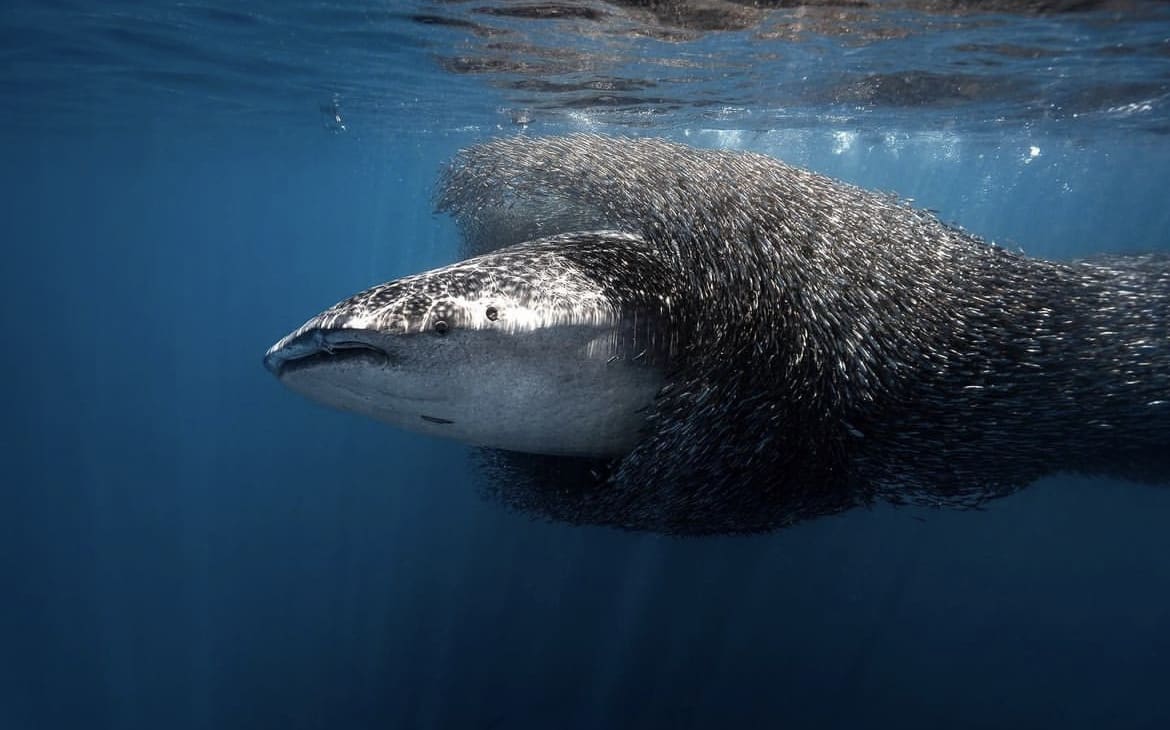
Whale Shark Social Structure
When you picture the vast, open ocean, it's easy to imagine whale sharks as solitary nomads, wandering the depths alone. And while it's true that they often travel solo, these giants are known to come together in groups for feeding. Spots where plankton blooms are abundant, like in the waters off Mexico's Yucatán Peninsula or the Ningaloo Reef in Australia, can become whale shark hotspots, drawing dozens of them to feast together. This social behavior suggests that while whale sharks enjoy their solitude, they're not averse to sharing a good meal with their kind. It's like the marine version of a pop-up gourmet food festival, where the main course is plankton!
How do Whale Sharks Reproduce?
Reproduction among whale sharks remains one of the ocean's best-kept secrets. What we do know comes from rare observations and even rarer captures. Whale sharks are ovoviviparous, meaning the females lay eggs, but these eggs hatch inside the mother, and she gives birth to live young. A single female can carry hundreds of embryos but will give birth to live pups at different stages of development. This fascinating reproductive strategy ensures the survival of at least some offspring in the vast and perilous ocean. The details of their mating rituals, pregnancy, and birthing locations are still largely shrouded in mystery, leaving scientists and marine biologists eager to learn more about these elusive aspects of their life cycle.
How Long do Whale Sharks Live?
Estimating the lifespan of whale sharks is tricky, but recent research suggests these gentle giants could live up to 100 to 150 years, maybe more. Determining age in whale sharks can be done by counting the growth rings in their vertebrae, much like counting the rings of a tree, but it's not an exact science. Their long lifespan is a testament to their resilience and adaptability in the ocean's ever-changing environment. However, it also means they grow and mature slowly, reaching sexual maturity at around 30 years of age. This slow journey to adulthood has significant implications for their population recovery and conservation efforts, highlighting the importance of protecting these magnificent creatures throughout their lengthy lives.
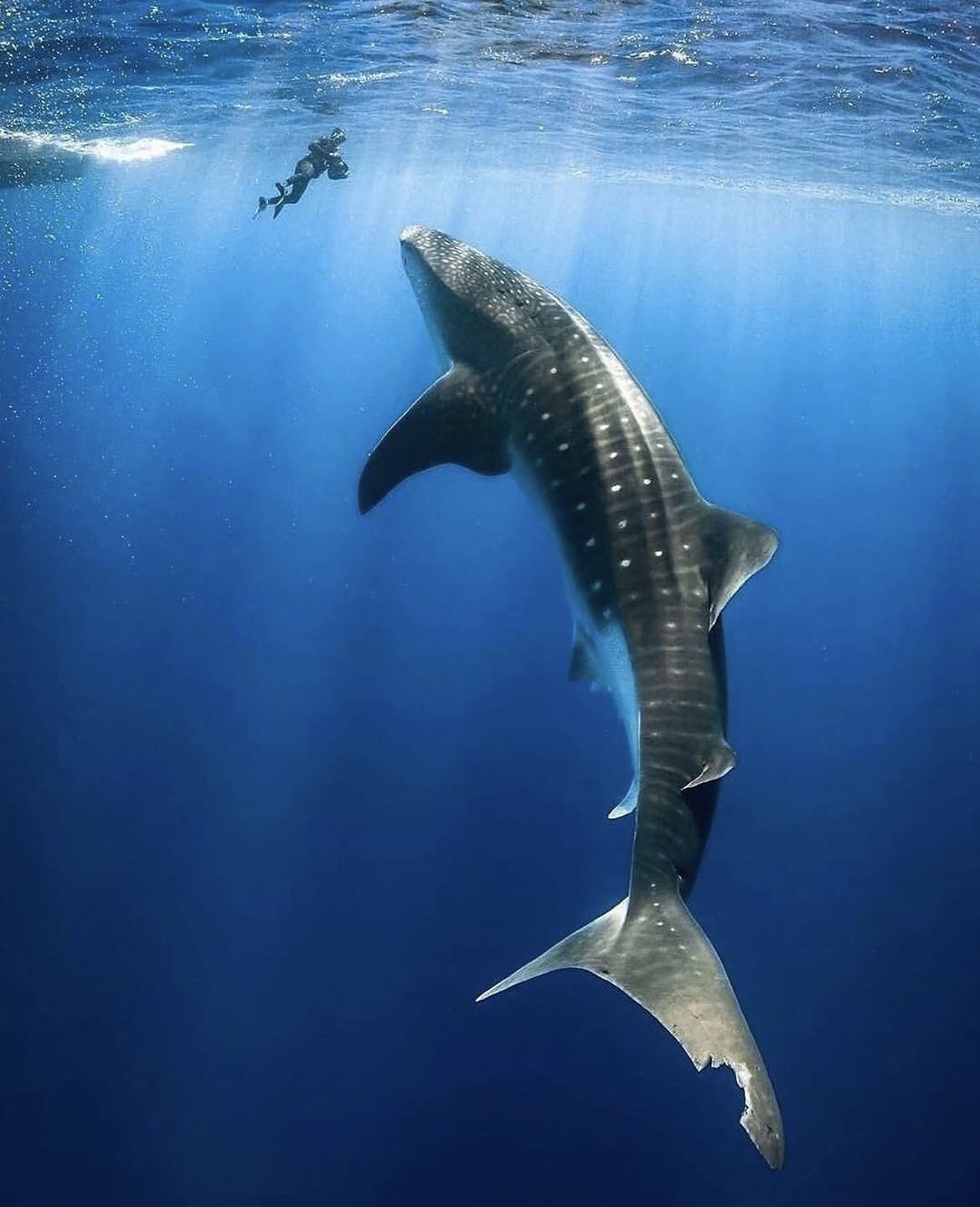
Are Whale Shark's Dangerous?
The term "shark" might send a shiver down your spine, but when it comes to whale sharks, there's no need for fear. Despite their impressive size, whale sharks are incredibly gentle and pose no real threat to humans. They're filter feeders, more interested in tiny plankton than anything else. Divers and snorkelers from around the globe seek encounters with these magnificent creatures, often describing the experience as peaceful and awe-inspiring. So, if you're lucky enough to swim with a whale shark, worry not; they're the gentle giants of the sea, more likely to swim away from you than to cause any harm.
Are Whale Sharks Territorial?
In the vast expanse of the ocean, whale sharks roam freely, following the bloom of plankton and the warmth of the waters. They are not known to be territorial creatures. Unlike many animals that fiercely defend their home range, whale sharks exhibit nomadic behavior, migrating thousands of miles in search of food. Their travels take them across oceans and hemispheres, from the tropical waters of the Caribbean to the warm seas of Southeast Asia and beyond. This lack of territoriality underscores their role as gentle wanderers of the sea, always on the move, yet at peace in the open water.
How Fast are Whale Sharks?
Don't let their massive size fool you; whale sharks are not setting any speed records. Their typical cruising speed is about 3 miles per hour, a leisurely pace that matches their tranquil demeanor. They glide through the water with a calm and steady grace, propelled by the undulating movements of their massive tail fin. This speed allows them to efficiently filter feed as they travel, sucking in water and plankton without the rush. While they can burst to higher speeds when needed, they prefer the slow lane, savoring the ocean's buffet at a pace that lets them take in everything around them.
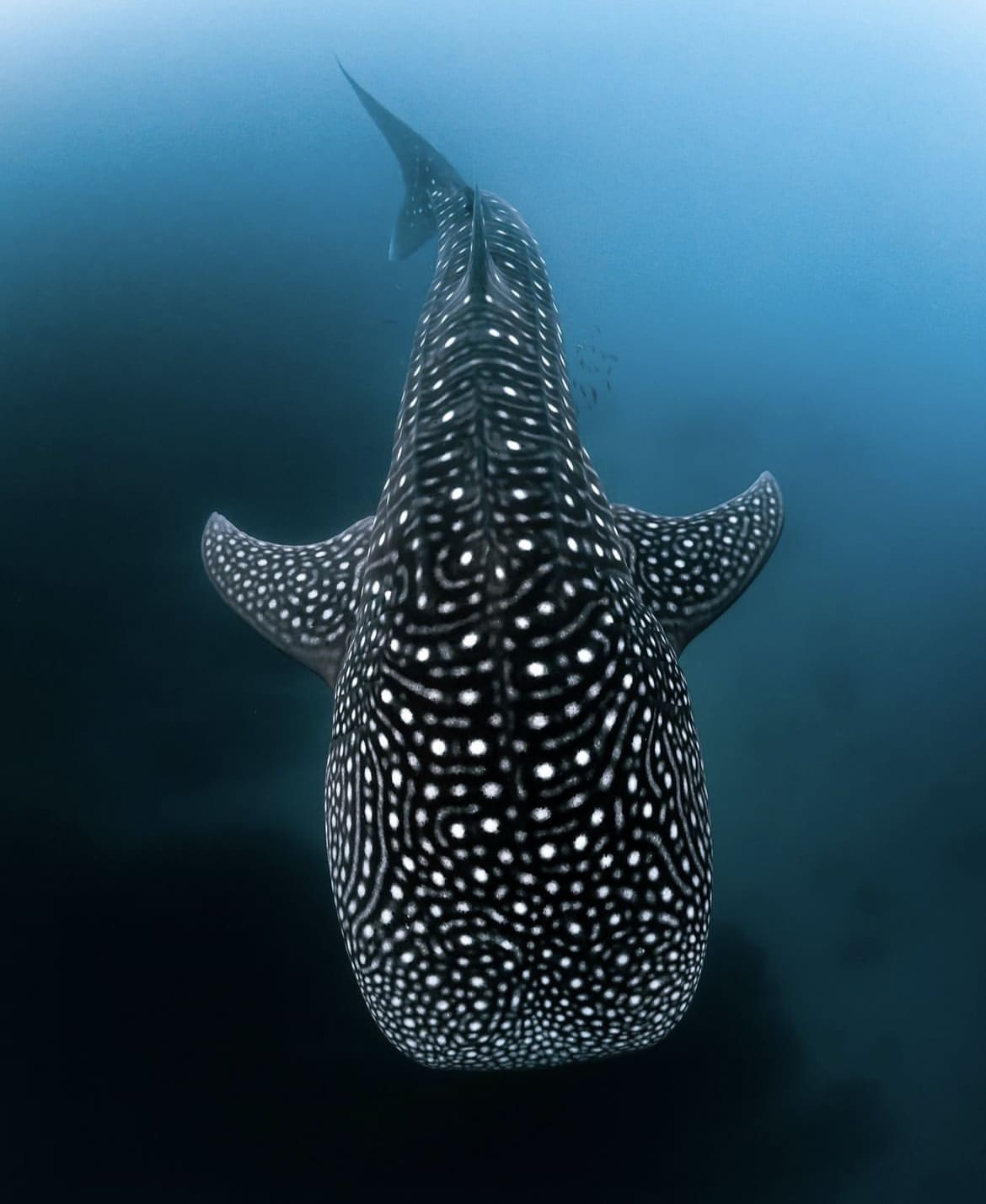
Where do Whale Sharks Live?
Whale sharks have a passport filled with stamps from all around the world. These globetrotters prefer warm waters and are found in all tropical and warm-temperate seas. From the coral-rich waters of the Philippines to the nutrient-packed Gulf of Mexico and the biodiverse hotspots like the Galápagos Islands, whale sharks cover a vast geographical range. They're known to migrate thousands of miles to find food and possibly to breed, though their breeding grounds remain one of the ocean's secrets. Whale sharks are most commonly found near the equator, where they can dive to depths of over 1,000 meters but often stay near the surface to feed on plankton and small fish.
How Many Whale Sharks are There in the Wild?
Quantifying the exact number of whale sharks in the world's oceans is a daunting task, fraught with challenges. However, conservationists and scientists use tagging and tracking technologies to estimate their populations. These gentle giants are considered endangered, with their numbers declining due to a range of human activities. Despite efforts to monitor their populations, exact numbers remain elusive, though the consensus is clear: their numbers are not what they once were, emphasizing the need for concerted global conservation efforts to ensure their survival.
Are Whale Sharks Endangered?
The IUCN (International Union for Conservation of Nature) classifies whale sharks as endangered . Their slow growth and late maturity, coupled with a low reproductive rate, make them particularly vulnerable to threats. Human impacts—such as accidental catches in fishing gear, targeted hunting for their fins and meat in some areas, and the degradation of their marine habitats—pose significant risks to their survival. The beauty and grace of whale sharks have made them popular in eco-tourism, which, while beneficial in raising awareness and funding for their conservation, also needs to be managed carefully to prevent stress and harm to these majestic creatures.
The plight of the whale shark is a poignant reminder of the interconnectedness of our ecosystems and the impact human activities can have on even the largest of ocean inhabitants. Protecting them is not just about preserving a single species but about maintaining the health and balance of the entire marine ecosystem. As we look ahead, the conservation of whale sharks becomes a beacon for broader oceanic conservation efforts, urging us to act thoughtfully and swiftly to protect our blue planet's gentle giants.

Threats to Whale Sharks in the Wild
The serene existence of whale sharks is increasingly disturbed by human activities. Beyond the direct threats of fishing and bycatch, whale sharks face the invisible menace of ocean pollution, including plastic waste, which can harm them when ingested. Climate change also poses a significant threat, altering ocean temperatures and impacting the distribution of plankton, which could affect whale shark migration patterns and feeding grounds. Efforts to protect these creatures are growing, with increased marine protected areas and stricter regulations on fishing practices, but the race against time and human impact continues.
Where to Dive with Whale Sharks?
For those yearning to witness the majesty of whale sharks up close, there are several hotspots around the globe renowned for regular sightings. The Ningaloo Reef in Western Australia offers intimate encounters with these giants in crystal clear waters.
Similarly, the Philippines' Donsol and Oslob have become famous for their whale shark tourism, offering snorkelers and divers a chance to swim alongside these peaceful behemoths.
The Caribbean waters off Isla Holbox and the Bay Islands of Honduras also provide spectacular opportunities to dive with whale sharks, especially during their migratory season.
Tips for Spotting Whale Sharks
Spotting a whale shark can be the experience of a lifetime, and while their sheer size might make them seem easy to find, knowing where and when to look can significantly increase your chances. First, timing is everything—aim for the peak season in known hotspots, usually around plankton blooms when whale sharks are most likely to be feeding at the surface. Additionally, keep an eye out for signs of their presence, such as flocks of seabirds feeding on fish disturbed by the shark's massive feeding process.
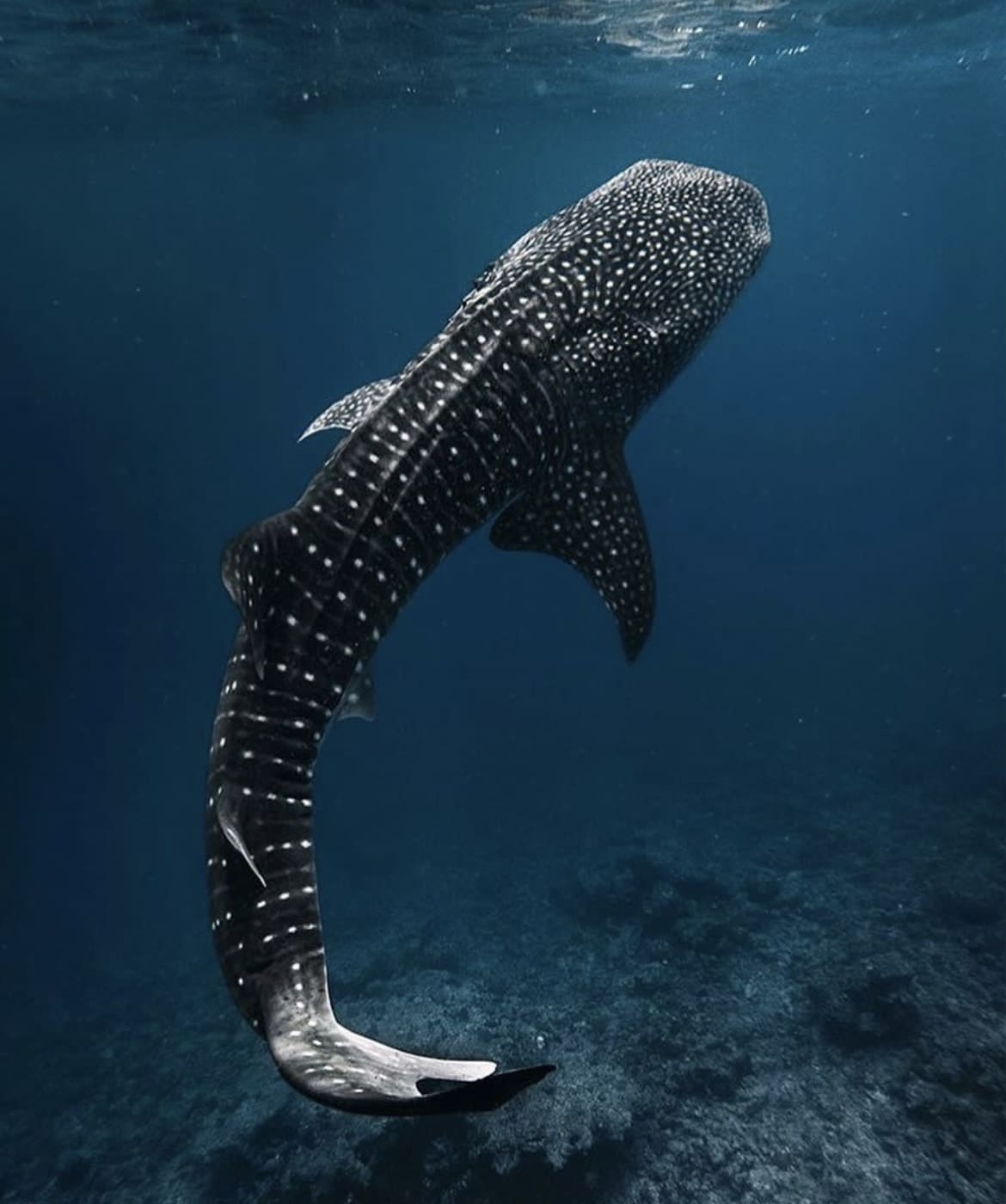
Facts about The Whale Shark
- Whale sharks can process over 6,000 liters of water an hour through their gills while feeding.
- Despite their size, whale sharks have relatively small brains, emphasizing their gentle nature.
- They can travel across entire oceans, with some tagged whale sharks recorded making journeys of over 12,000 miles.
Myths about The Whale Shark
- Whale sharks can swallow a person whole : Completely false. Their throats are too small to swallow anything larger than a small fish.
- Whale sharks are aggressive : On the contrary, they are some of the most docile creatures in the ocean.
- Whale sharks are whales : As we've clarified, they are sharks, distinguished by their cartilaginous structure and gill slits.
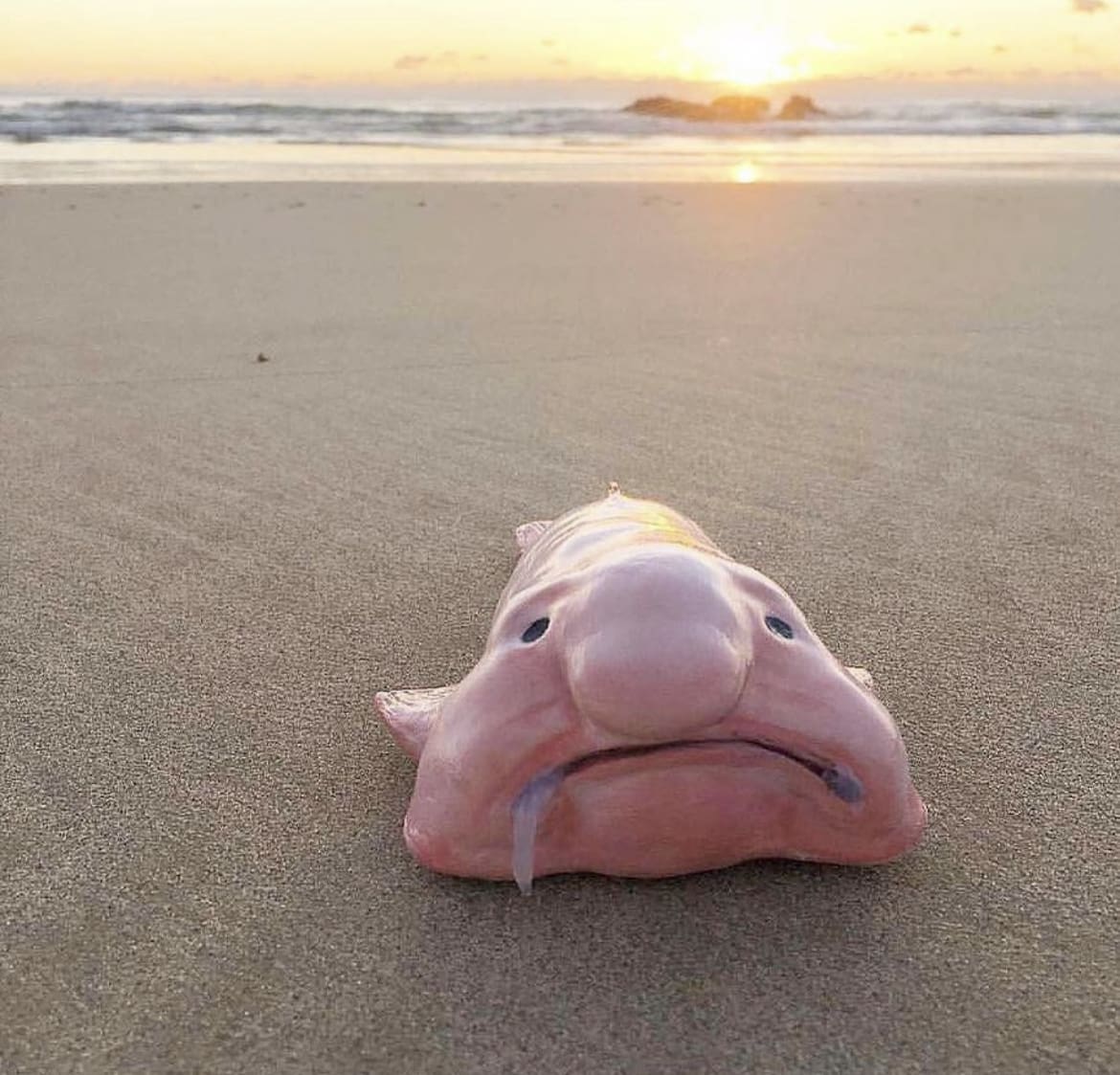
The 15 Weirdest Animals on Earth
March 19, 2024
In a world that never ceases to amaze, the boundary between reality and the otherworldly often blurs. Nature parades its collection of the most bewildering creatures you’ve ever laid eyes on. Forget the lions, the tigers, the bears - oh my! Dive with me into the less trodden path, where the weirdest animals hold court, commanding our fascination and sometimes our bewilderment.
From the deep blue seas to the heart of dense forests, our planet is home to creatures that defy logic, inspire tales, and sometimes, let’s be honest, give us the heebie-jeebies. So, join us as we explore the 15 weirdest animals on Earth, a journey for those who think they’ve seen it all. You’re in for a treat!
In the cloak of Madagascar’s night, the Aye-aye taps away, playing nature’s morse code to find its next meal. This creature could be the protagonist in a gothic novel, with its dark, bushy tail, eerie yellow eyes, and that one elongated finger.
It’s not exactly winning any beauty contests, but it's a marvel of evolution. The Aye-aye’s method of finding food, tapping on wood to listen for insects moving inside, then gnawing holes to fish them out with its skeletal finger, is a fascinating adaptation.
They might send a shiver down your spine, but these lemurs have a certain misunderstood charm.
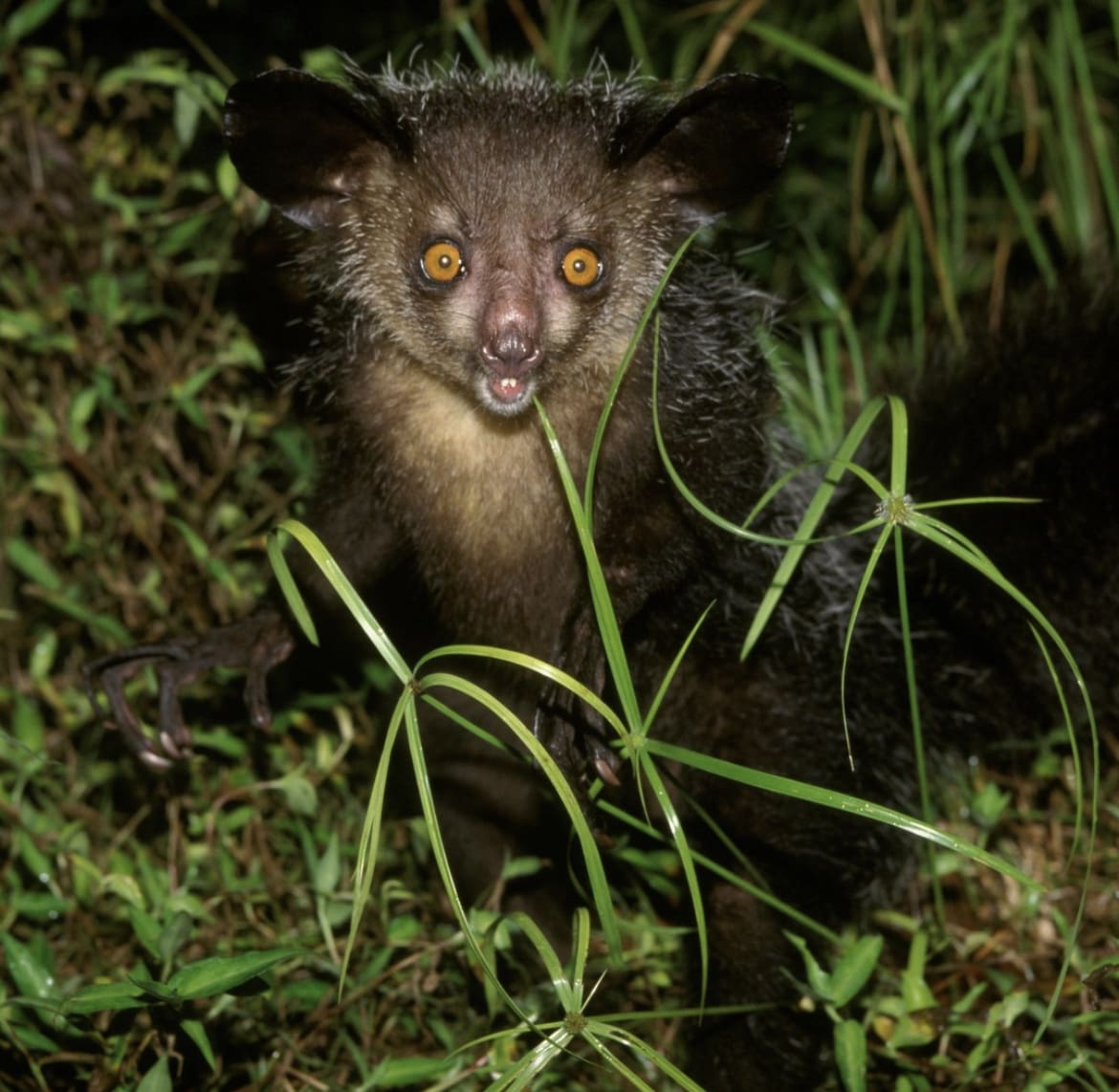
2. Naked Mole-Rat
Who needs a cape when you’ve got superpowers like the Naked Mole-Rat? This creature is a living testament to the saying, "looks can be deceiving." Residing in the subterranean realms of East Africa, it’s not winning any beauty pageants with its wrinkled pink skin and buck teeth.
Yet, it's a scientific marvel. Cancer resistance, a pain immunity, and a social structure that rivals that of bees and ants – talk about squad goals!
These bald wonders may not be your first choice for a pet, but they are undoubtedly one of Earth’s most fascinating and weirdest animals.
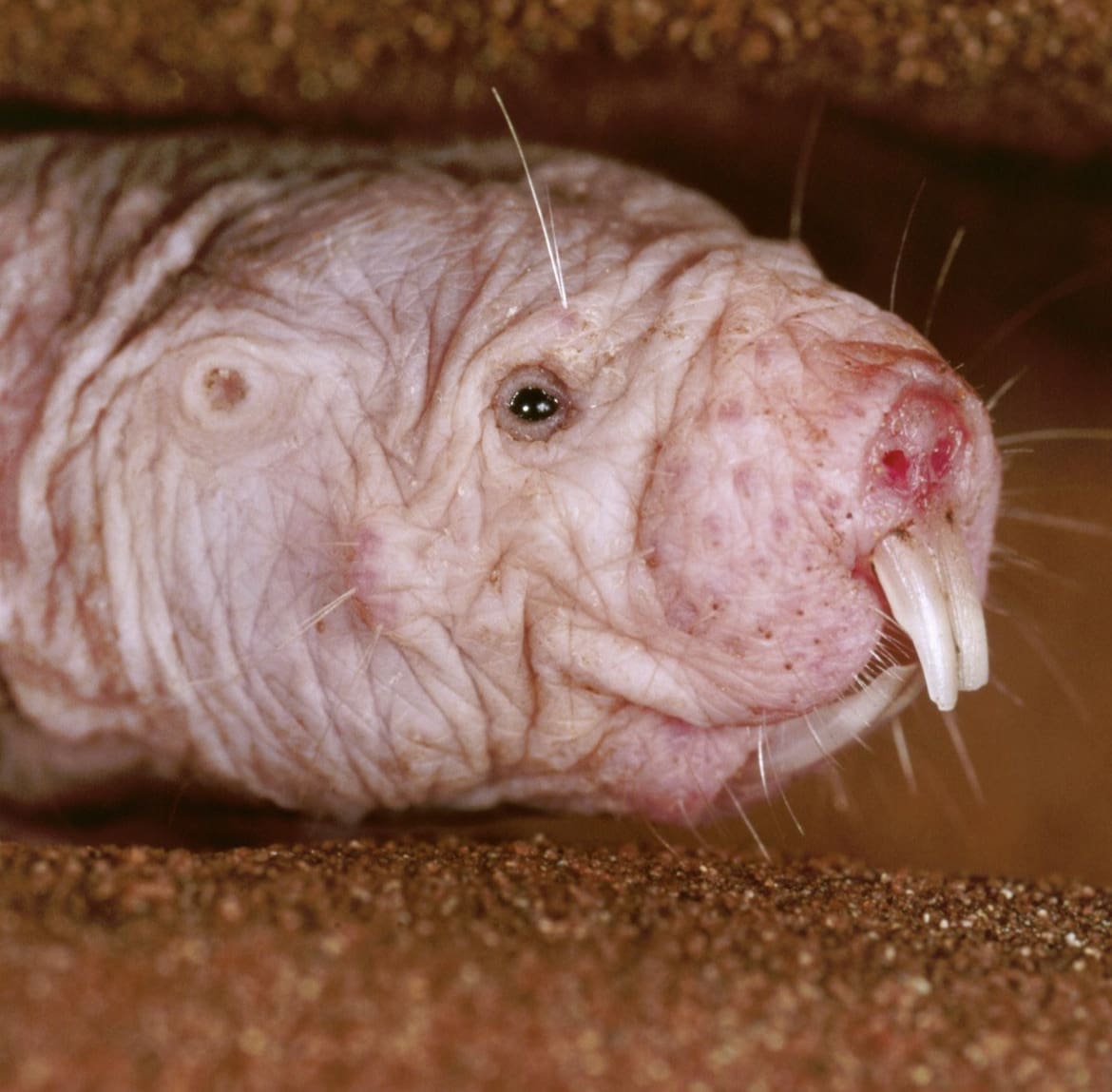
Swimming in the mystical waters of Mexico, the Axolotl looks like it wandered out of an enchanted storybook, decided life was pretty cool underwater, and threw away the idea of growing up.
With a forever-young attitude, external gills that look like feathered headdresses, and a face that’s always smiling, the Axolotl is a marvel of nature. Capable of regenerating nearly any part of its body, it's like Wolverine in cute, aquatic form.
Not only do they defy the aging process, but their ability to regenerate is also providing valuable insights for science, particularly in the fields of medicine and longevity.
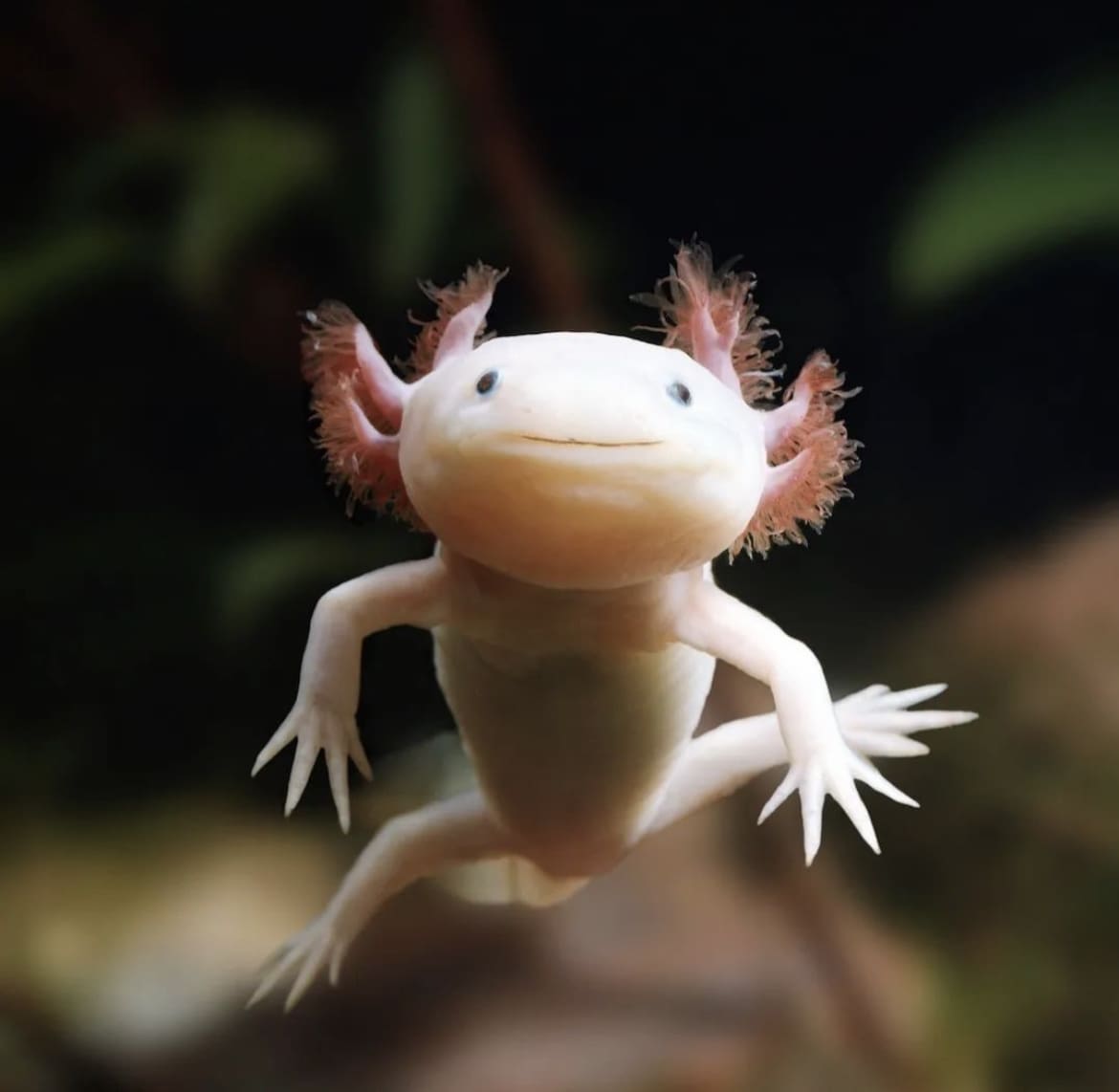
4. Blobfish
Picture this: a gelatinous mass with a droopy face that looks like it’s perpetually on the verge of tears. Welcome to the world of the Blobfish, a creature that wouldn’t look out of place in a cartoon if it wasn’t so bizarrely real.
Found in the deep waters off the coasts of Australia and New Zealand, the Blobfish leads a rather pressure-filled life, literally. Its jelly-like consistency, which is slightly less dense than water, allows it to float above the seafloor without expending energy on swimming.
This might sound like a lazy lifestyle, but at depths where pressures would crush other creatures, the Blobfish's adaptation is frankly genius.
Its melancholic appearance has earned it the title of the world's ugliest animal, but in the realm of the weirdest animals, the Blobfish is royalty.
5. Pacu Fish
Venture into the waters of the Amazon, and you might meet a fish with a dental arrangement strikingly similar to your own. The Pacu Fish, often referred to as the ‘nutcracker fish’, boasts a set of teeth eerily reminiscent of human molars.
While their cousin, the piranha, goes for a more razor-sharp approach to dental equipment, Pacus use their human-like teeth to crack open nuts and seeds that fall into the rivers and streams of the Amazon.
But don’t let their friendly smile fool you; these fish can grow quite large, making them one of the most unusual and weirdest animals lurking in freshwater. The sight of their dental arrangement might just have you reconsidering your next swim in the Amazon.
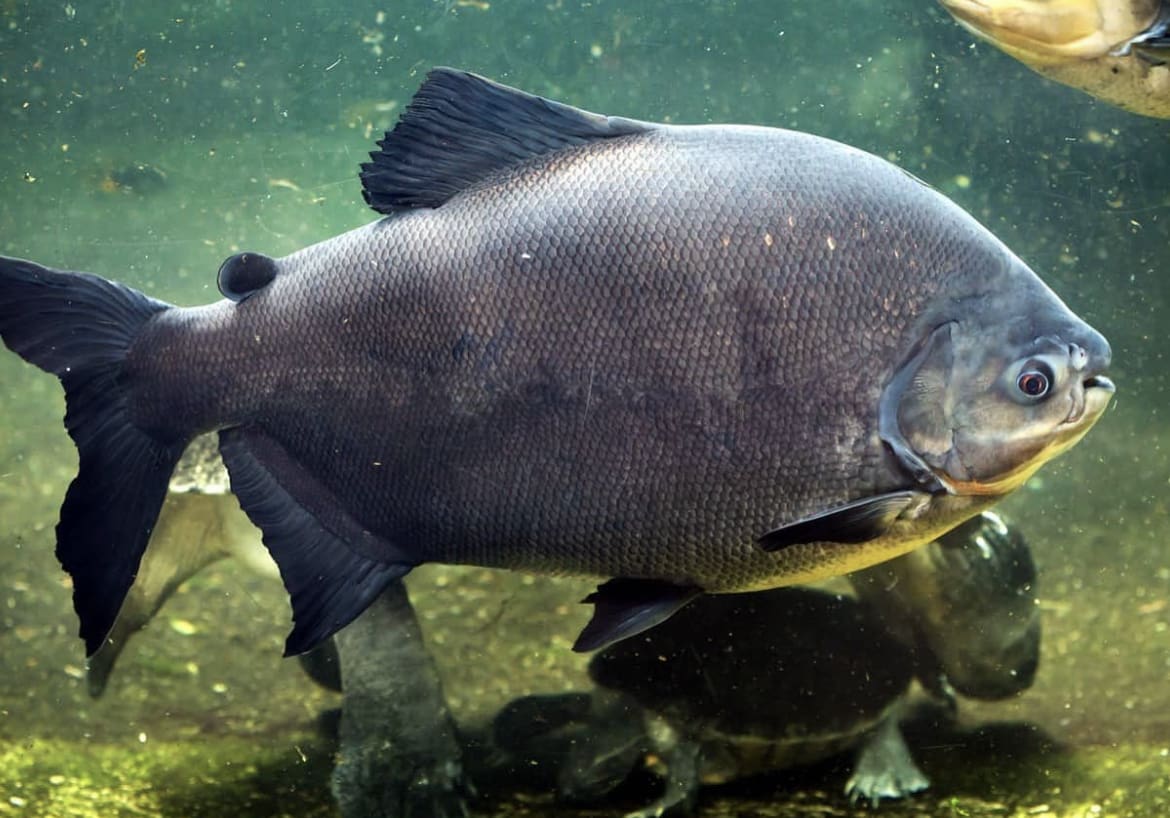
6. Saiga Antelope
The Saiga Antelope looks like it sprung out of an Ice Age animation, with its oversized, bulbous nose dominating its face. This odd nasal arrangement isn’t for show; it serves as a natural air conditioning system, filtering out dust in the summer and warming cold air in the winter.
Native to the Eurasian steppes, the Saiga has been around since the Pleistocene, dodging extinction with its bizarre but effective adaptations. However, despite their resilience and peculiar charm, Saigas are facing a real threat from poaching and habitat loss.
Their unique appearance and survival story make them a fascinating study in the resilience of life and a worthy addition to our list.
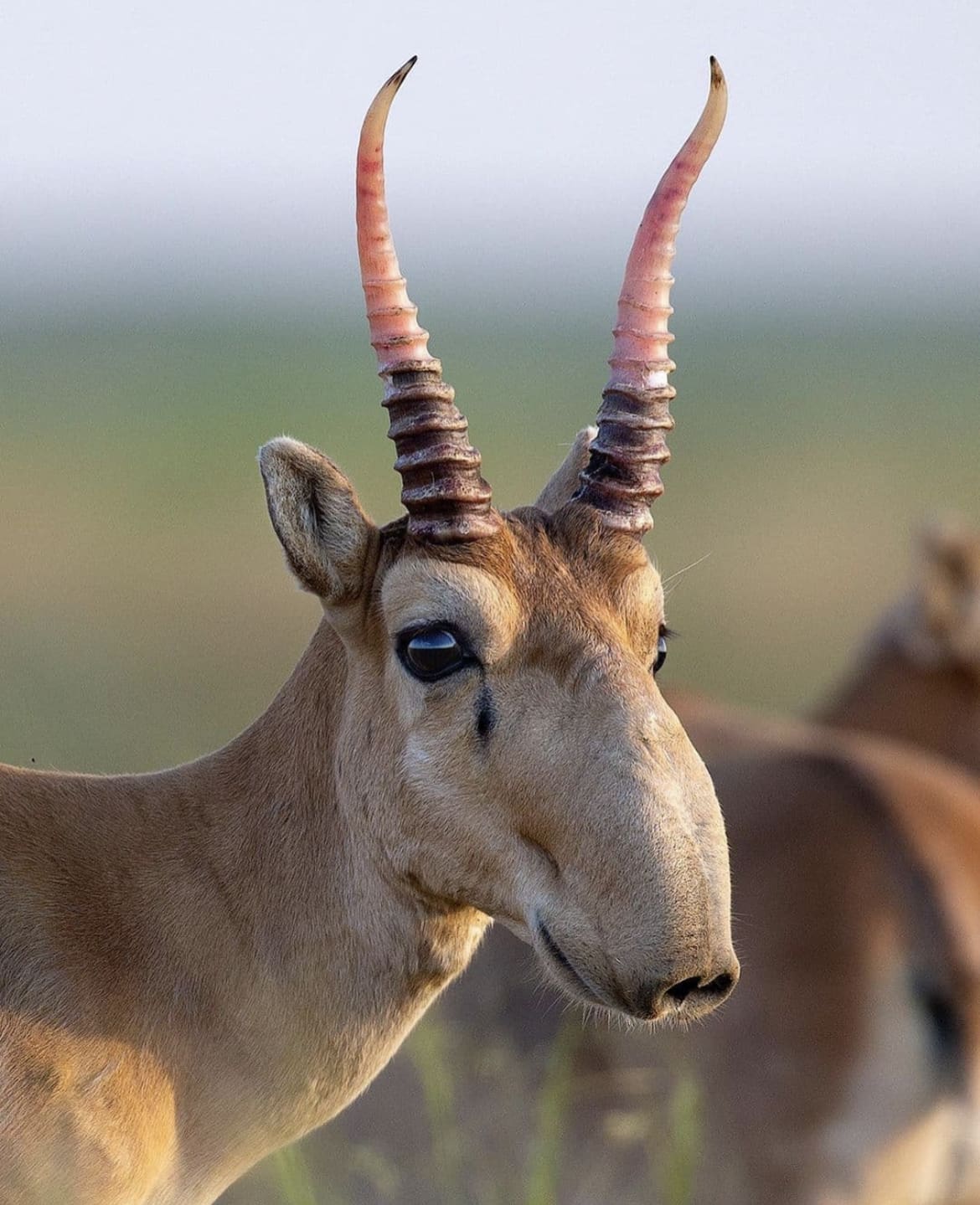
7. Goblin Shark
Diving into the depths of the ocean brings us face-to-jaw with the Goblin Shark , a creature that seems to have swum straight out of a prehistoric era. Known as a "living fossil," this shark's lineage dates back around 125 million years, making it a window into the deep past.
Its most striking feature, aside from its lovecraftian appearance, is its jaw mechanism.
When it's time to feed, the Goblin Shark projects its jaw forward with a speed and grace that contradicts its otherwise eerie demeanor, snatching up prey in an instant. Its pinkish skin, which appears otherworldly in the dim light of its deep-sea habitat, adds to its ghostly allure.
Among the weirdest animals, the Goblin Shark holds a special place for its blend of the ancient and the bizarre.
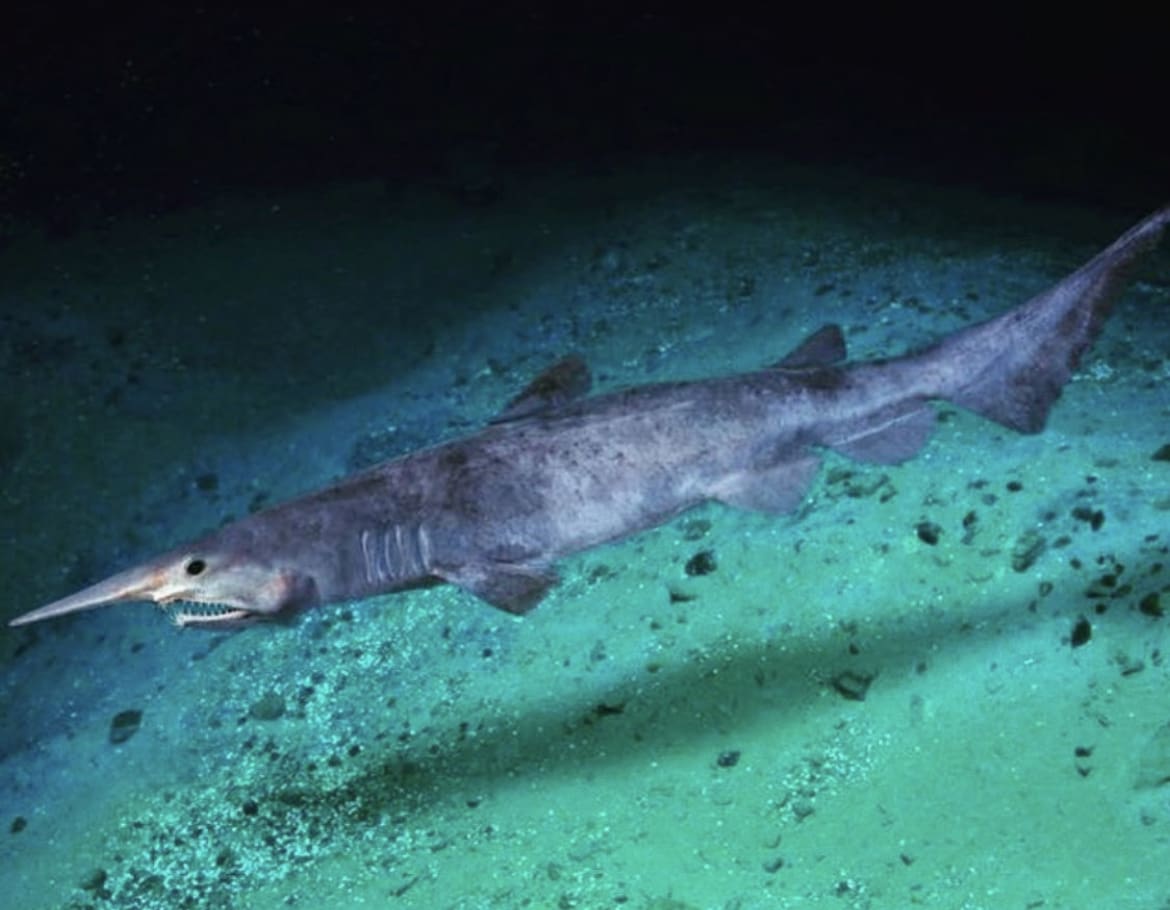
8. Tardigrades (Water Bears)
Tiny yet mighty, Tardigrades, affectionately known as Water Bears, are microscopic animals that could teach a masterclass in survival.
These minuscule marvels, visible only under a microscope, have been found in the most extreme environments on Earth—from the deepest oceans to the highest mountains and even the vacuum of space.
Their ability to enter a cryptobiotic state, effectively pausing their metabolism, allows them to withstand extreme temperatures, radiation, and even the absence of water for decades.
With their chubby, bear-like appearance and eight legs, Tardigrades are among the world's most resilient creatures, embodying the incredible adaptability of life.
Tardigrades (Water Bears): The Indestructible Microbeasts
9. Dumbo Octopus
Floating through the ocean's midnight zone, the Dumbo Octopus earns its name from its ear-like fins, reminiscent of Disney's famous flying elephant. These gelatinous creatures navigate the abyss with a grace that's as enchanting as their appearance.
Unlike their more famous octopus cousins, Dumbos are found at extreme depths, where the pressure would crush other sea life. Their diet consists of crustaceans and bivalves, which they snatch up with their tentacles in a gentle, ghost-like manner.
With their soft, umbrella-shaped bodies and ability to hover off the seafloor, Dumbo Octopuses capture the imagination. Their serene demeanor and deep-sea habitat remind us of the wonders that lie hidden in the darkest corners of our planet.

10. Pink Fairy Armadillo
The Pink Fairy Armadillo looks like it wandered out of a fantasy novel, complete with a shield-like carapace and a delicate pink hue that contrasts strikingly against the earth it burrows through.
The smallest of the armadillo clan, this nocturnal creature calls the dry grasslands and sandy plains of central Argentina its home. Its fairy-tale name belies a tough life spent digging endless tunnels in search of ants and larvae. The armadillo's shovel-shaped claws make it a master excavator, capable of vanishing underground within seconds when threatened.
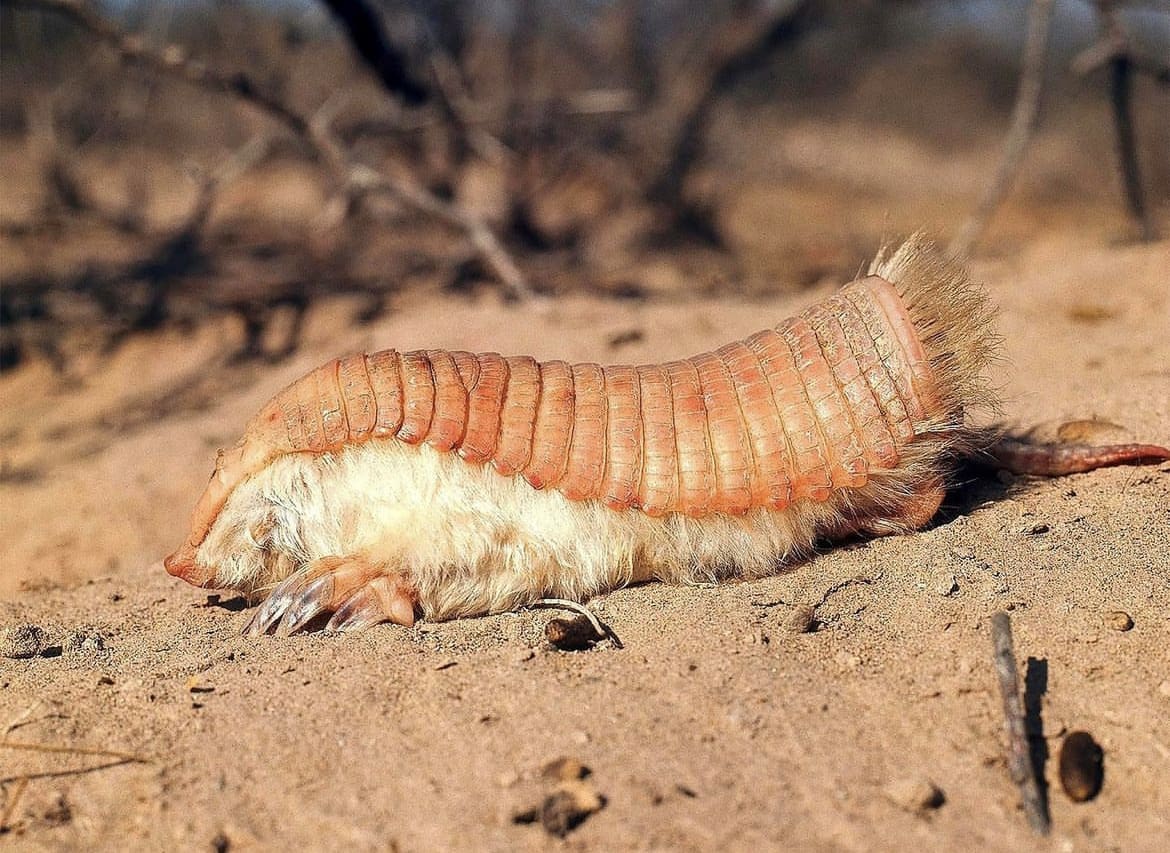
11. Sunda Colugo (Flying Lemur)
Not quite a lemur and certainly not capable of powered flight, the Sunda Colugo defies easy categorization.
This enigmatic creature, found in the dense forests of Southeast Asia, glides between trees using a large membrane that stretches from its neck to the tips of its fingers and toes, all the way to its tail. This adaptation allows it to soar for up to 70 meters (230 feet) - a remarkable feat for a mammal.
The Sunda Colugo spends most of its life in the trees, feeding on soft plant parts in the quiet of the night. Its cryptic lifestyle and peculiar mode of locomotion showcase the incredible diversity of evolutionary solutions to the challenges of survival.
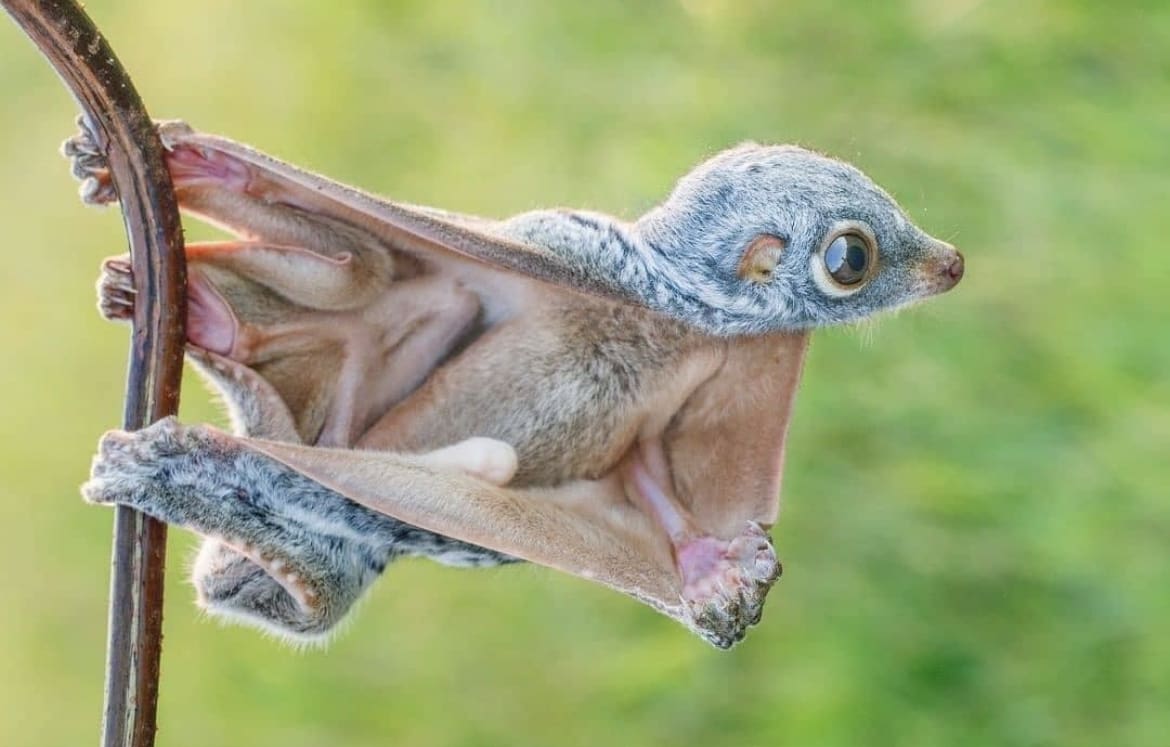
12. Thorny Devil
Australia’s outback harbors many strange creatures, but few are as bizarre or as aptly named as the Thorny Devil.
This small lizard is covered in an armor of spiky scales, presenting a formidable defense against predators. Its coloration, a mottled pattern of desert browns, reds, and tans, provides perfect camouflage against the arid landscape. The Thorny Devil's most remarkable feature might be its method of hydration: it can collect water from any part of its body through capillary action, channeling it to its mouth.
This adaptation is crucial for surviving in one of the harshest environments on Earth. The Thorny Devil is a testament to the weirdest animals' resilience and ingenuity, thriving in conditions that would spell doom for most.
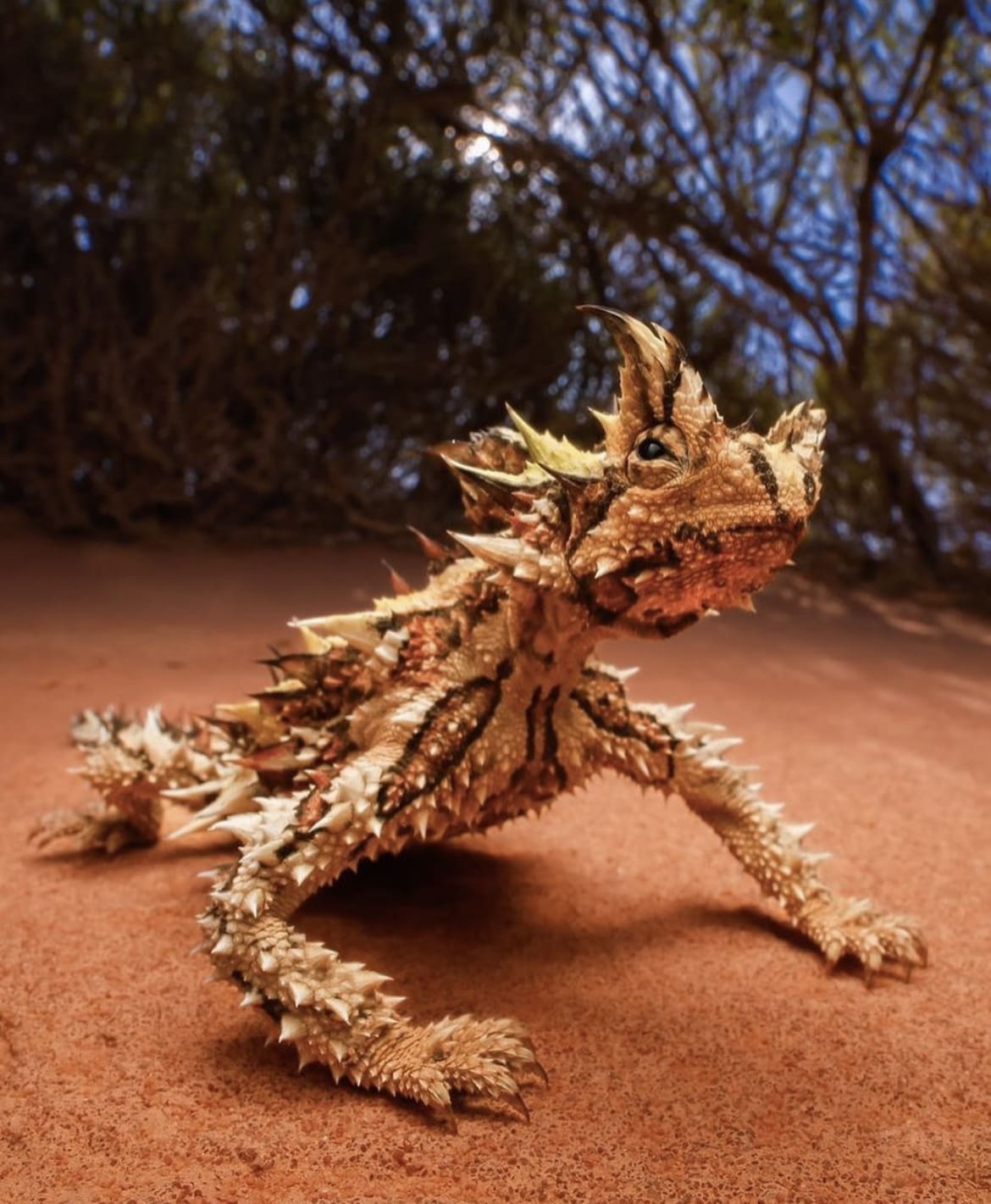
13. Proboscis Monkey
The Proboscis Monkey, with its distinctive long, droopy nose, looks like a character straight out of a quirky animated film. This odd feature, found prominently in males, serves as a status symbol among their kind and is believed to amplify their calls, attracting mates and asserting dominance.
Native to the mangrove forests and swamps of Borneo, these monkeys are also excellent swimmers, with webbed feet that aid in their aquatic lifestyle.
The Proboscis Monkey reminds us that in the animal kingdom, sometimes the strangest features serve the most important purposes.
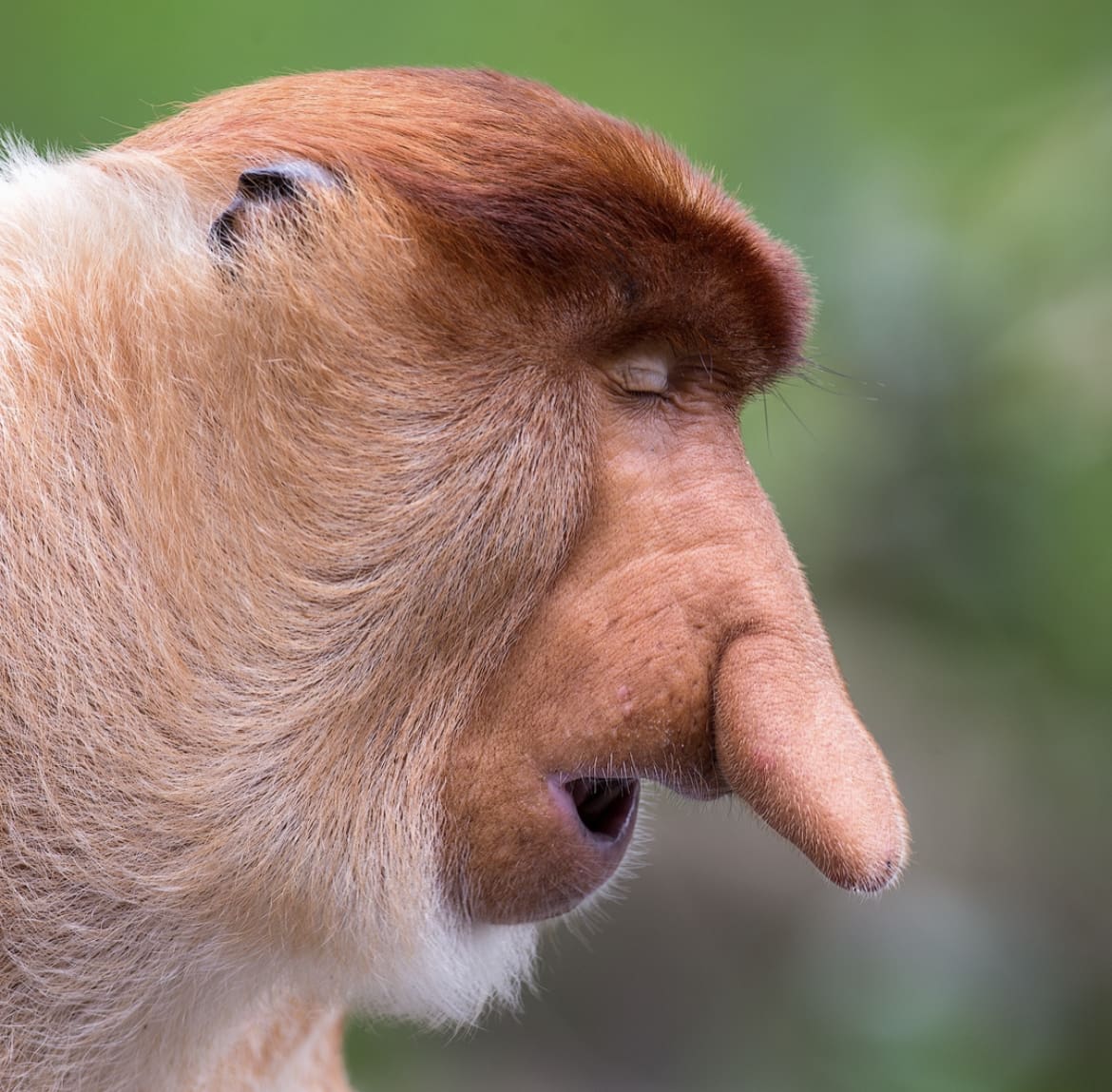
14. Komondor Dog
At first glance, the Komondor might not seem like one of the planet’s weirdest animals—after all, it’s a dog.
But give it a second look, and you’ll see why it earns its spot. This Hungarian breed sports a unique, corded coat that looks like a collection of mop heads, designed to protect it from harsh weather and attacks by predators while herding livestock.
The Komondor’s dreadlocks are not just for show; they are a natural and functional adaptation that has been cultivated through selective breeding.
This breed is a testament to the variety of domesticated animal life, showcasing how human needs and animal evolution can intertwine in fascinating ways.

15. Vampire Squid: The Gentle Goth
The Vampire Squid, with a name that conjures images of underwater horror, is surprisingly less menacing than its moniker suggests.
Dwelling in the oxygen-minimal depths of tropical oceans, this cephalopod is equipped with bioluminescent organs that can dazzle predators and prey alike. Unlike its more aggressive squid relatives, the Vampire Squid uses a cloak of webbing between its tentacles to envelop itself, creating an eerie appearance when threatened.
Its diet consists mainly of detritus, making it a scavenger rather than a predator. The Vampire Squid's unique adaptations to deep-sea life, combined with its gothic allure, reveal the diverse strategies life uses to thrive in the planet’s most inhospitable environments.
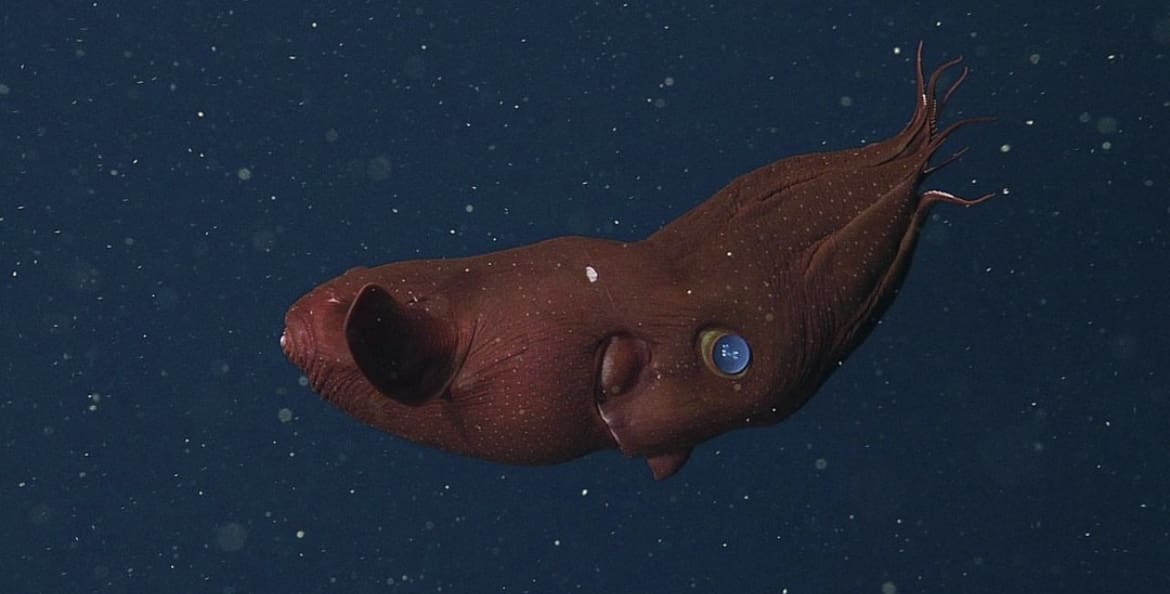
The 12 Weirdest Underwater Animals
Dive into the abyss of the ocean, and you'll find a world so alien, it might as well be another planet. Down here, the darkness is king, and the creatures that call it home? They're the royal court of weird. But what are the weirdest underwater animals?
If you're an urban millennial with a taste for the unusual and the spectacular, prepare for a journey into the deep blue's most bizarre nooks and crannies.
This isn't your standard aquarium tour; it's a VIP pass to the ultimate show of nature's oddities. So, get your snorkel, and let's explore the weirdest underwater animals that make the ocean's murky depths a whole lot more colorful.
1. Blobfish
First up on our tour of the ocean's oddball brigade is the blobfish, a creature that looks like it's perpetually on the verge of asking you why you woke it up.
Native to the deep waters off the coasts of Australia and Tasmania, the blobfish has been crowned the " world's ugliest animal, " but hey, beauty is in the eye of the beholder, right?
This gelatinous blob floats around the deep sea, its body density just a tad less than water, making it a master of the effortless drift. It's a face only a mother could love, sure, but in the high-pressure world of the deep sea, the blobfish's gooey physique is the perfect adaptation.

2. Goblin Shark
Next up, the goblin shark, a creature that takes the "living fossil" title a little too seriously.
Imagine a shark designed by a committee that couldn't agree on anything. The result? A pink, elongated body topped with a snout that looks like it was borrowed from a swordfish and teeth that could've been plucked from your nightmares.
The goblin shark's jaw is a marvel of evolutionary engineering, capable of launching forward to snag its prey in a move that's as horrifying as it is fascinating. It's the stuff of deep-sea legend, lurking in waters so deep that sunlight is just a rumor.
With a lineage dating back some 125 million years, this shark is a reminder of the ocean's mysterious past and our fleeting presence in its narrative.
3. Vampire Squid
The vampire squid is a creature that sounds like it was named by a marine biologist going through a goth phase.
With its dark, webbed cloak and red eyes, the vampire squid looks ready to headline an underwater emo concert. But don't let its macabre moniker fool you; this deep-sea dweller is more misunderstood softie than bloodthirsty predator. The vampire squid resides in the oxygen-minimal layers of the ocean, a zone known as the "midnight zone," where it feeds on detritus—essentially, the ocean's leftovers.
It's a peaceful creature, flitting through the dark waters with an elegance that belies its eerie appearance. Despite its name suggesting a penchant for the dramatic, the vampire squid is a testament to the ocean's ability to surprise and enchant, even in the deepest, darkest corners.
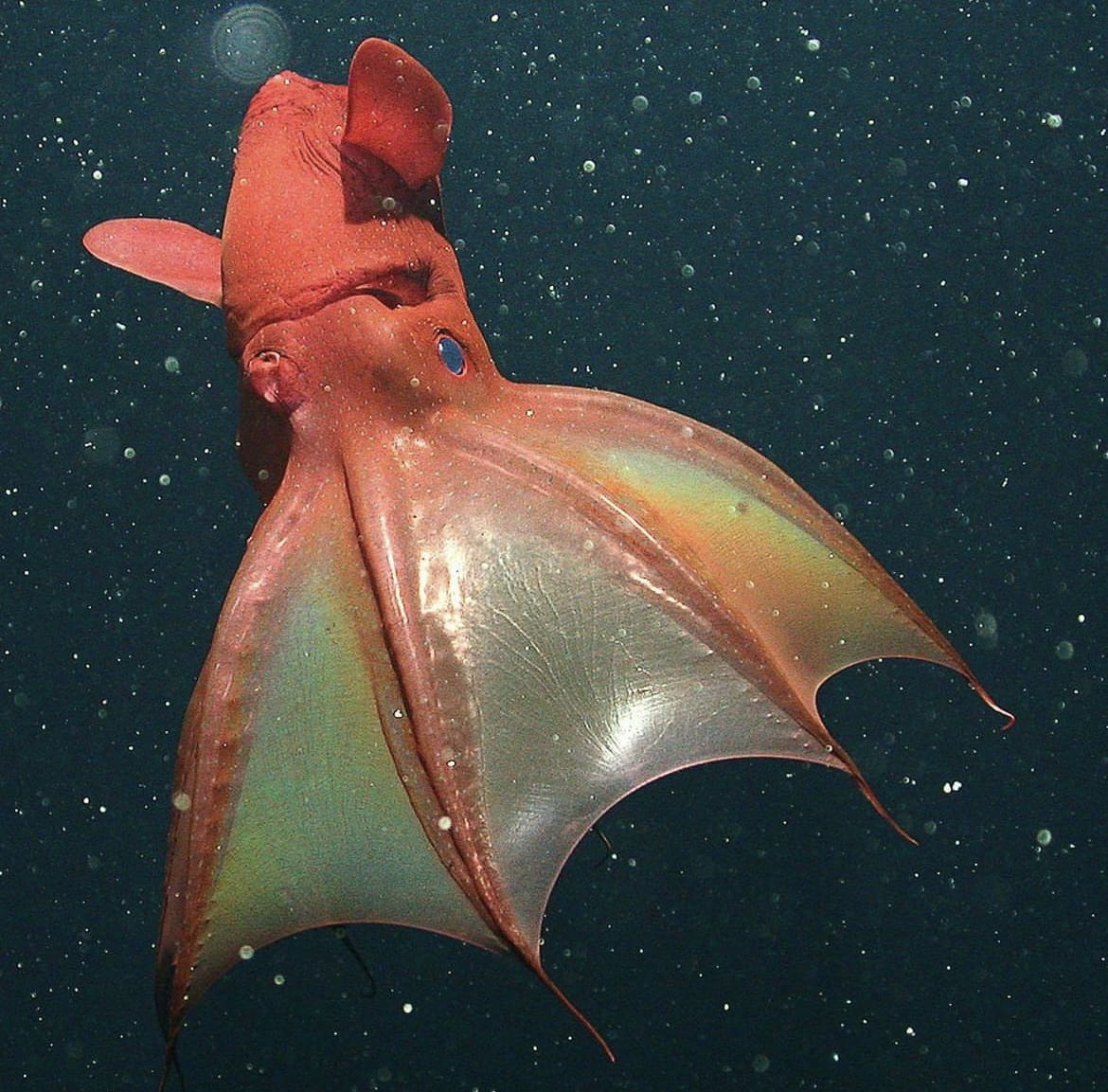
4. Leafy Seadragon
Amidst the weirdest underwater animals, the leafy seadragon holds its own with a grace that rivals the finest ballet dancers.
Drifting through the waters off the southern coast of Australia is the leafy seadragon, a master of disguise in the undersea realm. This enchanting creature, with appendages resembling seaweed, blends seamlessly into its kelp-filled habitat, eluding predators with unparalleled grace.
But don't let its delicate appearance fool you; this seadragon is as hardy as they come, thriving in the cool, rough waters of the Australian coast. Its unique form and flowing movements make it one of the ocean's most unusual aquatic animals, a true natural marvel that captivates divers and marine biologists alike.
Watching a leafy seadragon dance with the currents, you're reminded of the sheer creativity of evolution, painting life with a palette of endless imagination.
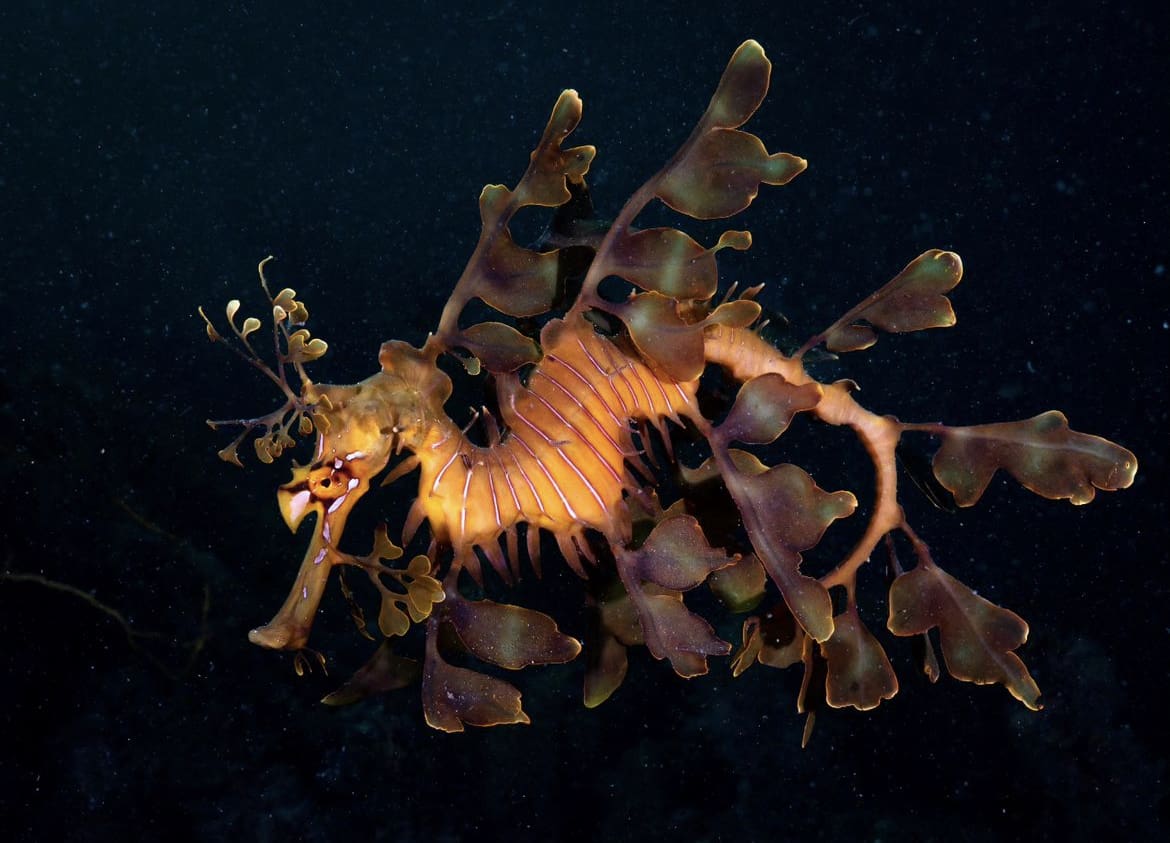
5. Mantis Shrimp
Enter the world of the mantis shrimp, an underwater heavyweight that packs a punch as colorful as its vibrant exterior.
This small but mighty crustacean is equipped with one of the most sophisticated visual systems in the animal kingdom, able to see a spectrum of colors beyond human comprehension. But it's the mantis shrimp's hunting method that truly sets it apart: it strikes with its dactyl clubs at the speed of a bullet, shattering its prey's defenses (and occasionally aquarium glass).
The mantis shrimp stands out among the weirdest underwater animals not only for its striking appearance but for its extraordinary biological adaptations. In the shadowy depths, where survival is a game of hide and seek, the mantis shrimp is a reminder that nature always has a few tricks up its sleeve.
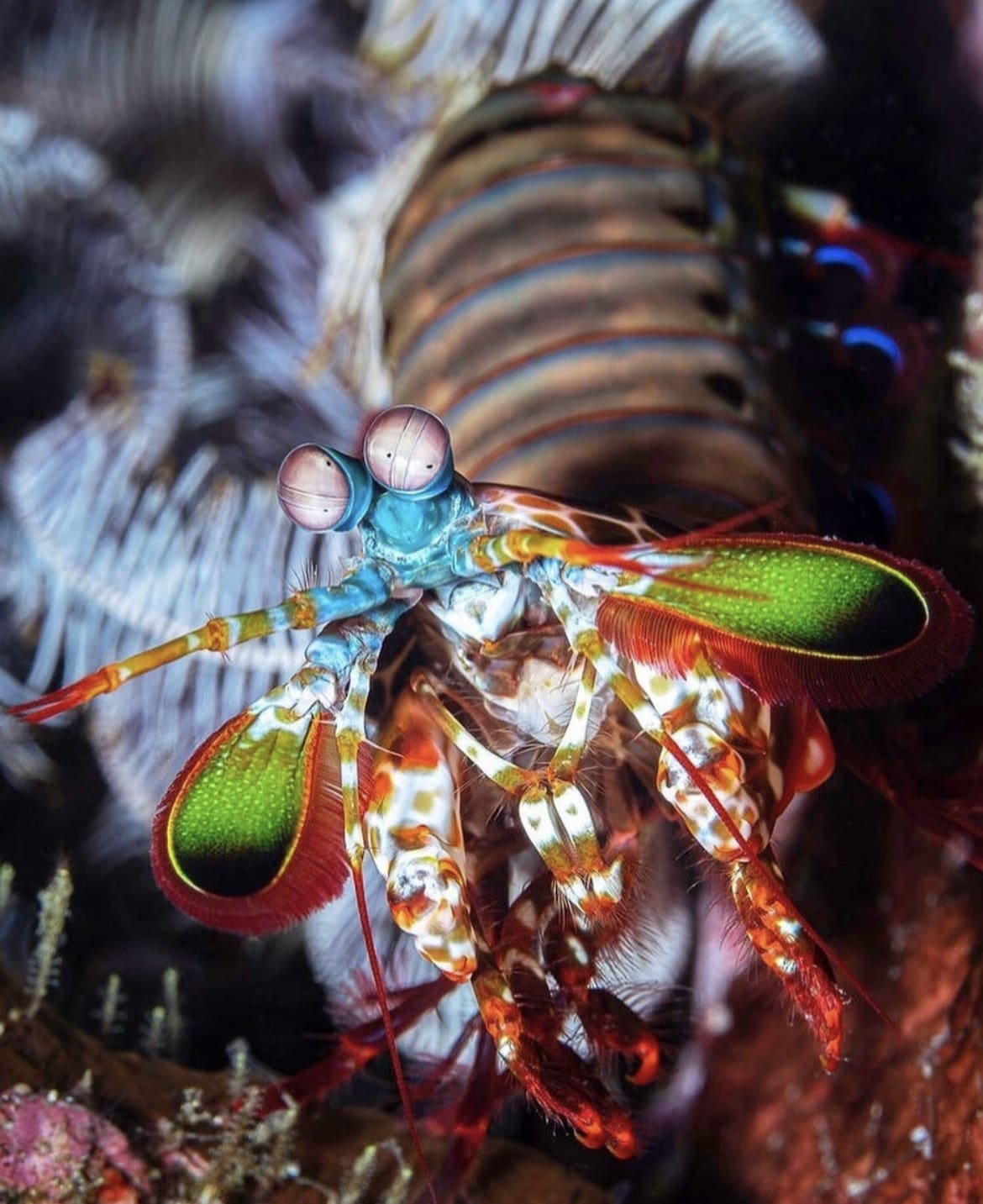
Venture into the freshwater caves of Mexico, and you might encounter the axolotl, a salamander that refuses to grow up. Known for its perpetual larval stage, the axolotl can regenerate almost any part of its body, making it a subject of extensive scientific research.
With a smile that's equal parts endearing and eerie, this "Mexican walking fish" (though not a fish) is a favorite among exotic pet enthusiasts and biologists alike. The axolotl is a shining example of the strange animals of the deep, or in this case, the depths of freshwater caves.
Its ability to regenerate is not just a biological marvel; it's a symbol of resilience and adaptability, qualities that define the myriad forms of life sharing our planet.
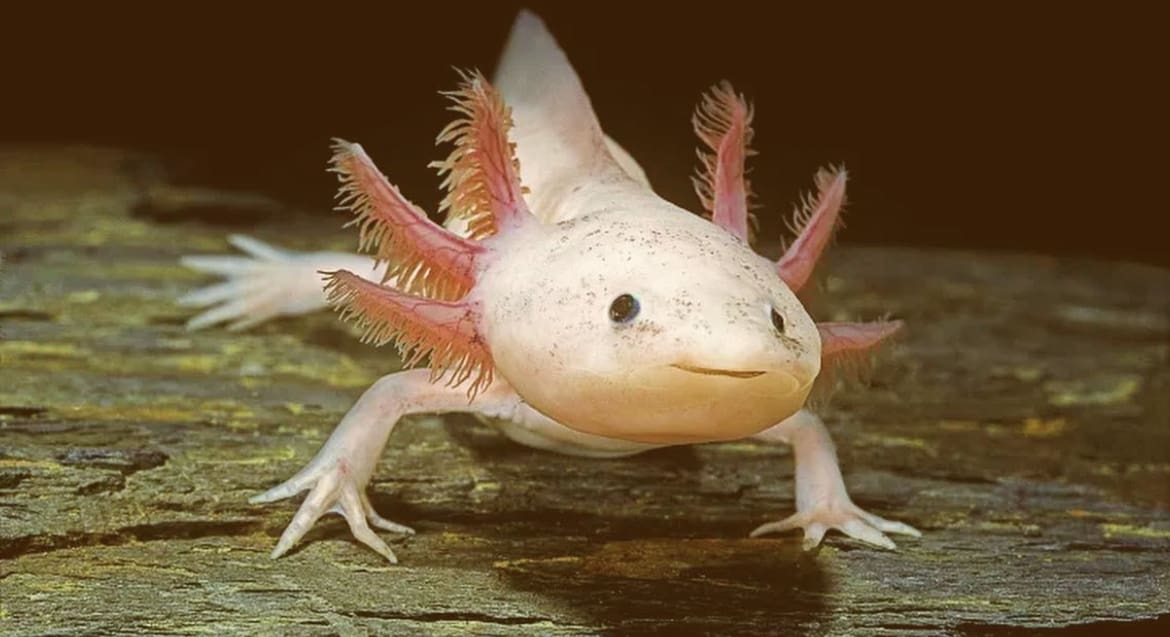
7. Dumbo Octopus
Diving further into the realm of the weirdest underwater animals, we encounter the Dumbo octopus, named affectionately after the iconic Disney character due to its ear-like fins.
This deep-sea dweller flutters through the darkness of the ocean's abyss, where light is a scarce commodity, using its unique appendages to propel itself in a way that's as close to flying as it gets underwater. The Dumbo octopus’s habitat, ranging from the shallows to the extreme depths of up to 7,000 meters, makes it one of the most adaptable cephalopods.
Its ability to thrive in such extreme conditions and its unconventional appearance earn it a spot among the ocean's most fascinating and unusual creatures. With a face that could melt the coldest hearts, the Dumbo octopus adds a touch of whimsy to the diverse cast of the ocean’s weirdest underwater animals.
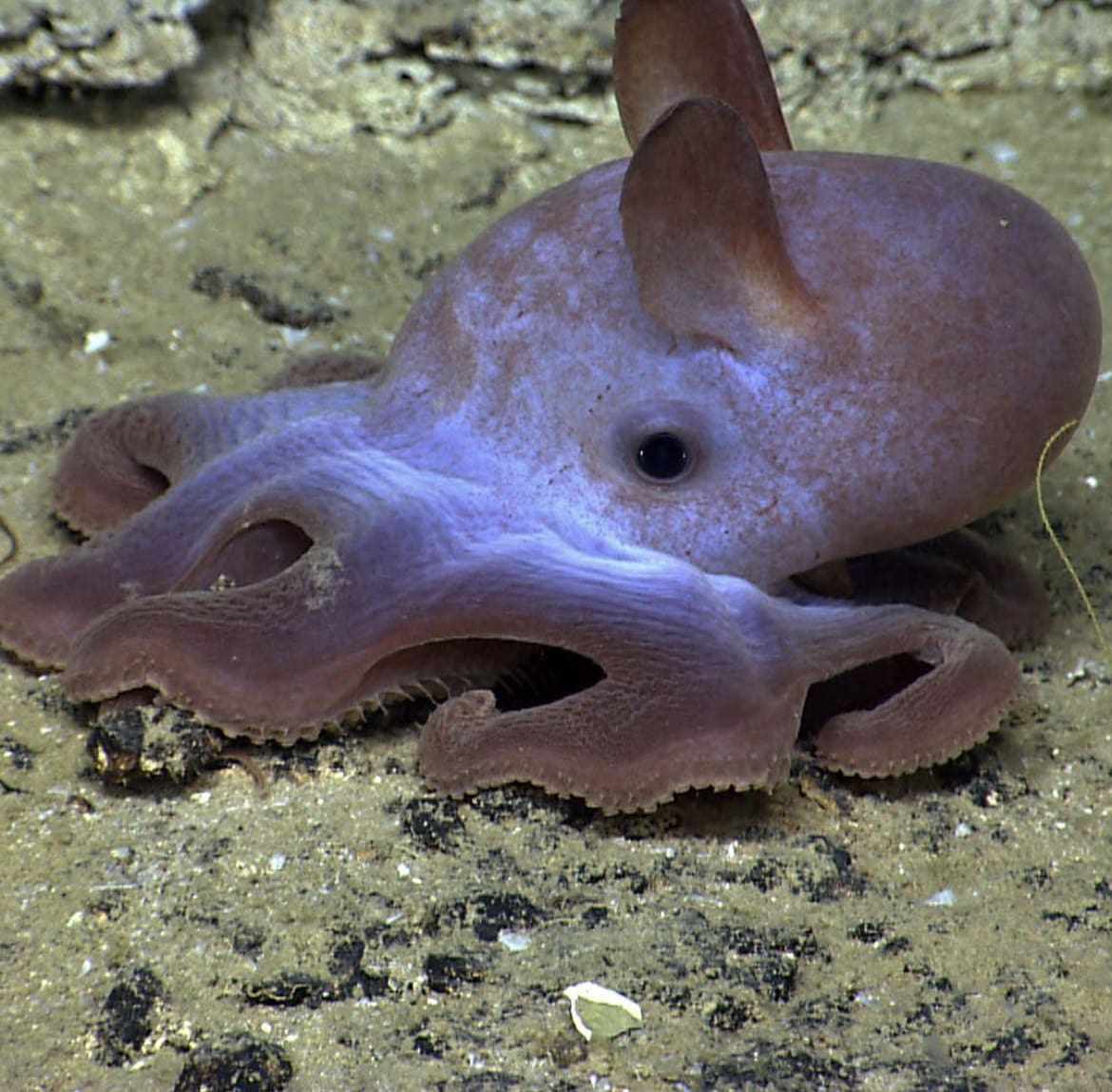
@schmidtocean
8. Barreleye Fish
Within the vast expanse of the sea, the barreleye fish stands out for its extraordinary head, which is completely transparent.
This peculiar adaptation allows it to collect more light in the dark depths it calls home, providing a literal window into the workings of its unique visual system. The eyes of the barreleye, encased in its clear dome, can rotate to scout for prey overhead, making it a formidable predator despite its fragile appearance.
Living in the twilight zone of the ocean, this fish's unusual features exemplify the incredible adaptations required to survive in one of the planet's most extreme environments.
The barreleye fish is a testament to the oddities that evolution can produce, making it a noteworthy member of the collection of the weirdest underwater animals.
@mbari_news
The narwhal, with its singular, spiraling tusk, ventures into the icy waters of the Arctic, joining the ranks of the weirdest underwater animals. This “unicorn of the sea” has fascinated humans for centuries, inspiring legends and tales with its otherworldly appearance.
The tusk, an elongated tooth, can grow up to 10 feet long in males and serves various roles, from sensory organ to a tool in social interactions. Narwhals are a marvel of the marine world, embodying the mystery and majesty of the ocean's depths.
Their presence in the frigid waters of the Arctic is a reminder of the adaptability and diversity of life, even in the most inhospitable corners of the planet.

10. Psychedelic Frogfish
Among the pantheon of the weirdest underwater animals, the psychedelic frogfish occupies a special place with its outlandish appearance and striking colors.
Discovered off the coast of Indonesia, this rare fish boasts a vibrant pattern that rivals the most vivid psychedelic art, blending seamlessly with coral reefs to ambush unsuspecting prey. Its ability to "walk" along the ocean floor using its pectoral fins adds to its quirky charm, making it a fascinating subject of study for marine biologists and a captivating sight for underwater explorers.
The psychedelic frogfish embodies the essence of the ocean's ability to surprise and mesmerize, further enriching the tapestry of life beneath the waves with its unique blend of beauty and oddity.
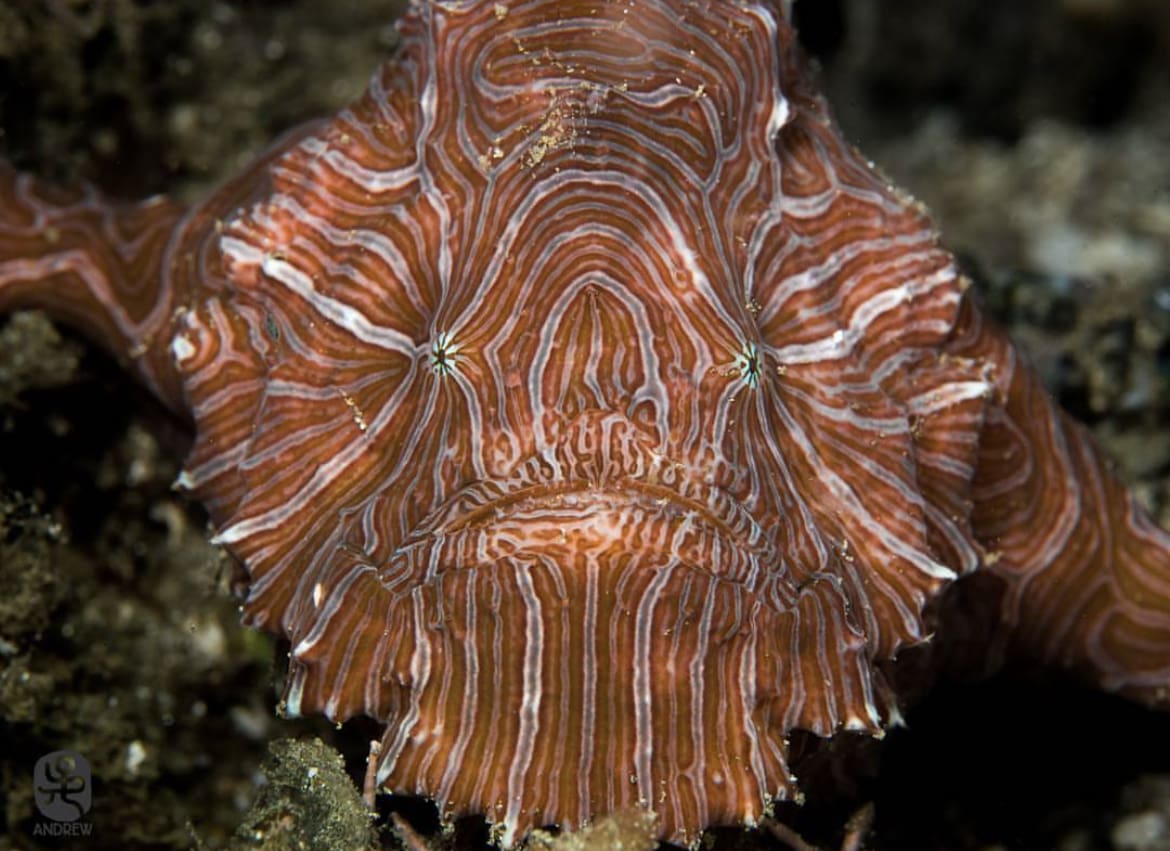
11. Giant Isopod
The giant isopod is a creature that looks like it crawled out of a science fiction novel. These oversized relatives of the common woodlouse can grow up to 2.5 feet in length, roaming the ocean floor in search of food.
With their hard, segmented exoskeletons and deep-sea dwelling habits, giant isopods are the epitome of survival in the ocean's abyssal plains. Often considered the scavengers of the deep, they play a crucial role in the marine ecosystem, recycling dead and decaying matter.
Their alien-like appearance and fascinating behavioral traits make giant isopods a standout example of the incredible diversity and adaptability of marine life, securing their spot among the ocean's most unusual and intriguing inhabitants.
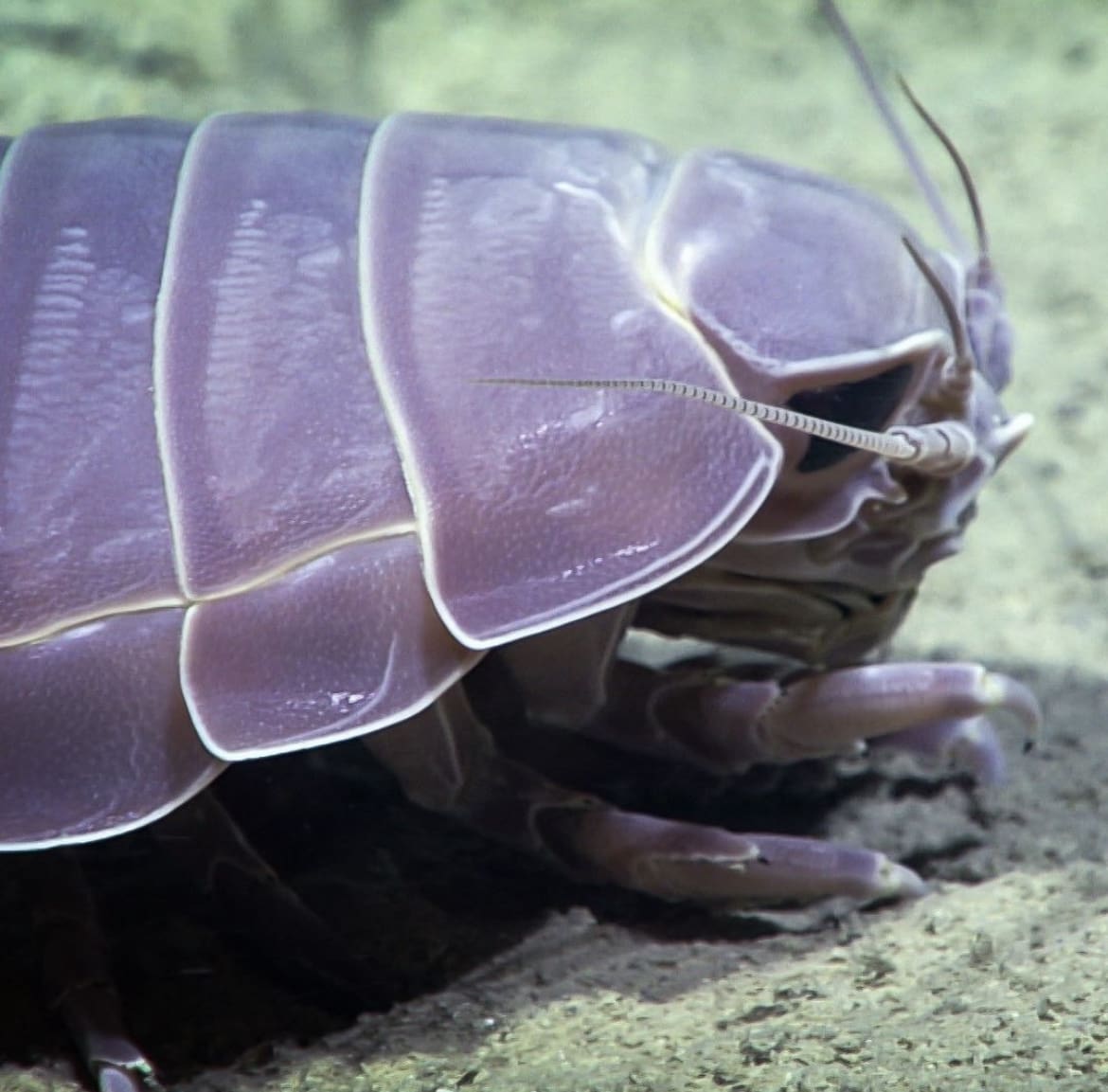
12. Lancetfish
Completing our journey through the gallery of the weirdest underwater animals, the lancetfish demands attention with its prehistoric appearance and ghostly silhouette.
With large, fang-like teeth and a dorsal fin that runs the length of its body, lancetfish look like something straight out of the Mesozoic era. These deep-sea predators are capable of making significant vertical migrations, coming closer to the surface at night to feed.
Their gelatinous flesh and peculiar, elongated bodies make them an odd sight by any standard, contributing to the endless fascination with the deep sea's mysterious inhabitants.
The lancetfish, with its ancient lineage and elusive nature, encapsulates the enduring allure and mystery of the ocean's depths, reminding us of how much remains to be discovered in the vast blue frontier.
The ocean is a vast, unexplored space, brimming with life forms that defy our expectations and challenge our understanding of biology. From the adorable Dumbo octopus to the peculiar barreleye fish, the mythical narwhal, and the vibrant psychedelic frogfish, the marine world is a testament to the creativity of evolution.
The giant isopod and lancetfish round out our exploration of the weirdest underwater animals, each contributing to the rich mosaic of life that thrives in the planet's most remote and inhospitable environments. These creatures not only fascinate and inspire but also highlight the importance of preserving our oceans.
As we delve deeper, let us remember the responsibility we share to protect these remarkable beings and their habitats, ensuring that the ocean's mysteries continue to unfold for generations to come.
Privacy Preference Center
Privacy preferences.
Wildlife, Nature, Conservation, Safari

34 African Birds – List | Prey | Names | Ecology | Habitat | Traits
African birds are of varied traits, outlooks, nature, and habitats. With more than 2500 species of birds, Africa is a birdwatcher’s paradise. From tiny, brightly colored sunbirds and feisty little bee-eaters, to sinister marabou storks, prehistoric shoebills, and even penguins, African birds are available in a virtually infinite variety of sizes, shapes, and hues.
List of African birds
While wildlife lovers are likely to focus first and foremost on Africa’s safari animals, its fantastic birds ought to positively not to be neglected. If you’re heading off on an African safari, otherwise you simply wish to discover a number of the wonderful birds of Africa, this listing is a great place to get to know them.
1. Pied kingfisher
There are over 100 species of kingfisher dwelling on each continent besides Antarctica, however, in Africa, the most typical is the pied kingfisher (Ceryle rudis), one of the African birds. These hanging black and white birds stay close to lakes and rivers, the place they are often seen hanging out in pairs on the riverbank or hovering over the water before diving all the way down to catch small fish or massive aquatic bugs. Pied kingfishers can swallow their meals in flight, which means they will fly further out over a body of water than different kingfishers.
Where to see pied kingfishers in Africa
The greatest solution to see pied kingfishers is to take a ship journey alongside a river and look out for them on the water’s edge. They make their nests in holes within the riverbank, so in the event, you see a piece of mud wall filled with holes, this could be a kingfisher colony. The one above was photographed in Murchison Falls National Park, Uganda.
2. Marabou stork
The marabou stork (Leptoptilos crumeniferus) is usually known as the ‘undertaker bird’ due to its cloak-like wings, hunched posture, and sinister-looking expression. They are scavengers, and might ceaselessly be seen feeding around Africa’s landfill websites and garbage dumps. They’re completely huge and had been as soon regarded as the biggest dwelling bird, with a wingspan properly over three meters (however are actually recognized to be overwhelmed by the wandering albatross which has a wingspan of as much as 3.7 meters). The marabou may be very straightforward to identify because of its monumental size, highly effective bill, and bare head. Like vultures, the shortage of feathers on its face helps this bird preserve clear when scavenging amongst rotting waste, one of the African birds.
Where to see marabou storks in Africa
Marabou storks aren’t afraid of people, and might even be fairly intimidating. These birds nest in colonies in treetops, and in addition to seeing them on safari in East African nations like Tanzania, Uganda, Kenya, and Ethiopia, you’re very more likely to spot them in and across the cities.
3. Cattle egret
The cattle egret (Bubulcus ibis) is a medium-sized white bird associated with the heron. They collect in flocks around wetlands, farmlands, and grasslands, and with their dazzling white plumage, they’re very conspicuous. Unlike many African bird species which have suffered because of human exercise and lack of habitat, cattle egrets have tailored to dwelling alongside people and are sometimes discovered close to herds of cattle, the place they forage for small creatures disturbed by the mammals, one of the African birds.
Where to see cattle egrets in Africa
Cattle egrets are quite common birds throughout the entire of Africa, and you’re virtually assured to see a number of in your safari or journey. Look out for them around lakes and marshy areas, and alongside herds of buffalo or zebras, one of the African birds.
4. Black-headed weaver bird
Weaver birds (Ploceidae) are well-known for their extraordinary nest-building skills. To entice a mate, the male weaver bird builds an elaborate nest from grass, leaves, and twigs, in the hope {that a} feminine will approve it. Only one of the best nest-builders wins the women. There are around 60 species of weaver birds, most of which stay in sub-Saharan Africa, with just a few species in tropical Asia and Australia. They range in color from speckled brown and black to brilliant yellow and red, however, all of them have quick, conical beaks excellent for weaving nests and consuming their favorite meals: seeds.
Where to see weaver birds in Africa
Weaver birds have a tendency to construct their nests close to the water the place they are going to be more durable for predators to achieve, so look out for them alongside riverbanks and on the shores of lakes, one of the African birds.

Sunbirds are Africa’s reply to hummingbirds: small, vibrantly-colored birds that feed totally on nectar. However, not like hummingbirds, most sunbirds can’t hover, so they should perch on the flower as a way to drink. Only the males are so fantastically vibrant; feminine sunbirds are normally a lot drabber. Hummingbirds stay solely within the Americas, whereas sunbirds are solely Asian and African birds. This is a captivating instance of one thing known as ‘convergent evolution’ – the place two separate species have independently developed to be related because of their related habitats and existence. Sunbirds (Nectariniidae) have a long, curved bill that they use to probe the nectar from the flower. However, if they can’t reach it, they’ll use its sharp tip to chop the flower open on the base to achieve the sugary deal.
Where to See Sunbirds in Africa
There are over 80 species of sunbird in Africa: two of probably the most commonly spotted are the Southern Double-collared Sunbird and the collared Sunbird (which has a green head and yellow abdomen).
Sunbirds are discovered principally in tropical areas of sub-Saharan Africa and Madagascar, the place they’re most simply noticed in gardens and plantations the place flowers could be discovered, one of the African birds.
6. African wood owl
Like most owls, the African wooden owl (Strix woodfordii) is nocturnal. It’s a medium-sized owl (about 30 cm tall) that lives in forest or woodland areas. It eats principally bugs equivalent to grasshoppers, moths, and beetles, in addition to occasional small reptiles, mammals, or birds. Africa is house more than 30 species of owl. In some African cultures, owls are seen as bringers of dangerous luck or sick health, which poses a problem to their conservation, one of the African birds.
Where to see African wooden owls in Africa
Countries you may even see an African wooden owl embody DR Congo, Tanzania, South Africa, Zambia, Gambia, Uganda, Ethiopia, and Kenya. I noticed this one perched within the rafters of our safari lodge in Kibale, Uganda.
7. Superb starling
Starlings could be discovered right throughout Europe, Asia, and Africa, however, the African ones are notably enticing due to their spectacular iridescent plumage, which is why they’re additionally generally often known as ‘glossy starlings’.
The species you’re almost certain to see in your African safari is the excellent starling, which has a metallic blue and greenback and a copper-colored abdomen with a slim white stripe. Superb starlings (Lamprotornis superbus) typically stay in savanna, open woodland, gardens, and fields. You will repeatedly see flocks of them hopping alongside the ground, on the lookout for beetles, termites, and worms. They are typically fairly tame and unafraid of people.
Where to see excellent starlings in Africa
Superb starlings are widespread in East Africa, particularly Ethiopia, Uganda, Kenya, Sudan, and Tanzania, however, they can be discovered all through sub-Saharan Africa. I met this gorgeous chap in Tanzania, however, I additionally produce other images of comparable starlings from South Africa.
8. Lovebirds
Lovebirds (Agapornis) are small, brightly colored parrots, most no more than 15 cm long. There are 9 species, of which eight are native to the African continent and one to Madagascar. Fossils of ancestors to at present’s modern lovebird species have been present in South Africa, with relationship back 1.9 million years. Lovebirds get their name from the truth that they’re social and affectionate. Pairs of those cute African birds mate for all times, spend long durations sitting collectively, and even feed one another.
If one partner dies, the opposite will typically pine and present erratic behavior that has been likened to melancholy. Because of their small size, enticing coloring, and customarily sociable disposition, lovebirds are sometimes saved as pets.
Where to see lovebirds in Africa
Most lovebirds are present in equatorial and southern Africa. Look out for them, particularly in Tanzania, Malawi, Zambia, Angola, Botswana, Namibia, South Africa, and Ethiopia.
9. African penguin
While not a bird you’re more likely to see on a typical safari, no article about African birds could be full without mentioning African penguins. Because sure, though penguins are more usually related to Antarctica, you may see penguins in Africa if you realize the place to look. African penguins are fairly small – about 60-70 cm tall, and like all penguins, they can’t fly. They’re very charismatic birds and have a loud, donkey-like bray, which has given them the nickname ‘jackass penguins’.
African penguins mate for all times and spend about 10 months of the year looking for fish out at sea, returning to the same colonies each year to breed. Unfortunately, their numbers have dramatically declined lately, and they’re now listed as endangered by IUCN.
Where to see penguins in Africa
African penguins can solely be discovered within the very south of the continent, primarily in South Africa and Namibia. There’s a very in-style penguin colony at Boulders Beach and Foxy Beach close to Cape Town. The greatest time to see them right here is throughout the nesting season, from March to May.
10. Yellow-billed stork
Yellow-billed storks (Mycteria ibis) are medium-sized wading storks that stay around rivers and wetlands, preying primarily on small freshwater fish, in addition to crustaceans, frogs, bugs, and worms, one of the African birds. These birds are intelligent and fast to adapt. When searching, they use one foot to stir the riverbed, disturbing any potential prey from its hiding place. Once the animal is shifting, the stork, with its quick reflexes, is ready to rapidly seize it from the water.
Where to see yellow-billed storks in Africa
Yellow-billed storks are primarily discovered around freshwater wetlands and lakes in Eastern and Southern Africa, from Senegal all the way down to South Africa, in addition to some elements of Madagascar.
11. Augur buzzard
The augur buzzard (Buteo augur) is one other massive African bird of prey. Like eagles, buzzards are highly effective predators with spectacular eyesight, however, they are typically smaller than eagles and their tails are more fan-shaped. The augur buzzard is especially distinctive due to its brilliant white stomach and speckled wing ideas. Augur buzzards feed on small vertebrates, reptiles, small mammals, and birds, in addition to bugs and carrion. They normally hunt from a perch, on the lookout for prey by sitting on a tree or rock, however, you may additionally see them hovering and hovering overhead, one of the African birds.
Where to see Augur buzzards in Africa
The augur buzzard is just present in eastern and southwestern Africa, the place it’s fairly widespread. Look out for it in elevated savanna grasslands and the lower slopes of mountainous areas in nations together with Sudan, Ethiopia, DR Congo, Uganda, Kenya, Tanzania, Malawi, Mozambique, and Zimbabwe.
12. African sacred ibis
With its brilliant white body, blackhead and tail, and long, elegantly curved bill, the sacred ibis (Threskiornis aethiopicus) is among the most distinctive African birds. It’s native to Africa and the Middle East, and options closely in Egyptian mythology, related to Thoth, the god of knowledge and writing, who’s depicted with the top of an ibis. The sacred ibis is a medium-sized wading bird. They stand about 60 cm tall and have a wingspan of about 120 cm. They hand around in flocks and primarily eat bugs, worms, fish, frogs, and crustaceans.
Where to see African sacred ibis in Africa
In Roman instances, these birds had been widespread all through North Africa, the place they had been even bred in farms to offer inventory for religious sacrifices. Today they’ve unfolded south and might now be discovered throughout sub-Saharan Africa. I noticed these 5 in Tanzania, the place they’re notably widespread.
13. Swamp flycatcher
The swamp flycatcher is a small sparrow-like bird that, as its name suggests, eats primarily flies and different flying bugs, which it catches in mid-air. It prefers to stay in moist shrubland and swampy areas and is more durable to identify than a number of the bigger or more vibrant birds on this listing.
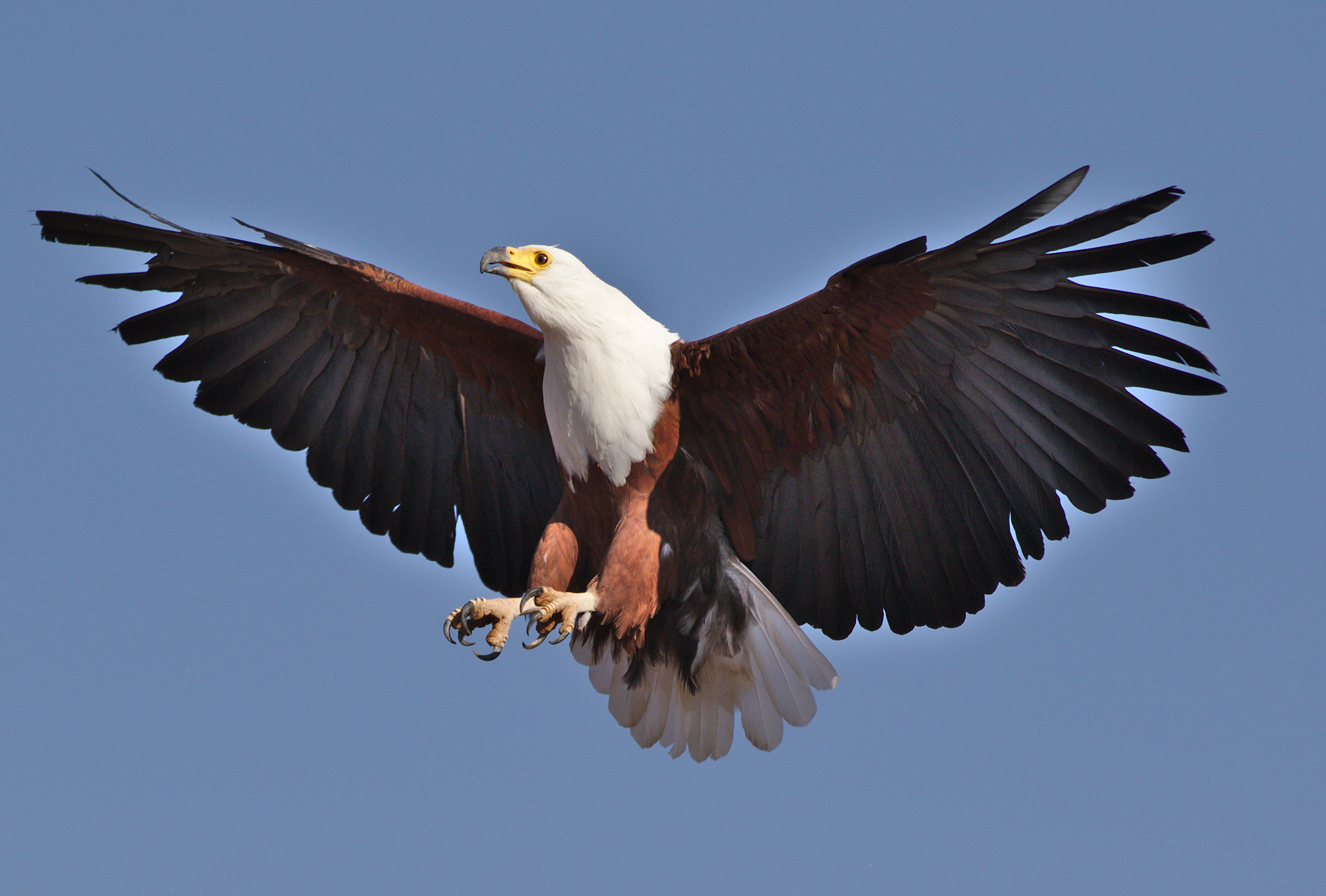
Where to see swamp flycatchers in Africa
Swamp flycatchers (Muscicapa aquatica) could be discovered all through tropical sub-Saharan Africa, together with within Benin, Ghana, Chad, Ivory Coast, Kenya, Nigeria, Rwanda, Tanzania, Uganda, and Zambia, of the African birds.
14. Helmeted guinea fowl
The helmeted guinea fowl (Numida meleagris) is a ground-dwelling African bird, in regards to the size of a hen, with a featherless head and a round body lined with spotty black and white feathers.
They’re sociable birds and hand around in massive flocks, typically following herds of bigger mammals like zebras, antelopes, and monkeys on the lookout for meals like bugs and seeds. They additionally play a significant position in maintaining ticks, locusts, and flies beneath control. As far back as historical Roman instances guinea fowl had been prized for his or her meat, eggs, and feathers. Today they’re hunted for consumption and likewise saved as home animals.
Where to see guinea fowl in Africa
There are 6 species of guinea fowl native to Africa; all of them could be discovered throughout sub-Saharan Africa primarily in open habitats like grasslands and savanna the place they’re simply noticed. In teams, they are often very noisy and fairly humorous to look at as they madly scurry about.
15. Yellow-billed kite
The yellow-billed kite (Milvus aegyptius) is a medium-sized bird of prey you can recognize from its brilliant yellow beak and feet and V-shaped tail. These birds measure about 55 cm tall and have a wingspan of as much as 1.5 meters. Kites are quick and fast fliers, able to sudden bursts of pace, and might catch and eat bugs in flight. They are additionally scavengers and are daring around people, even generally stealing meals from picnic tables or different birds.
Where to see yellow-billed kites in Africa
Yellow-billed kites aren’t thought-about threatened and could be seen all throughout sub-Saharan Africa in virtually all varieties of habitats and even city areas. I photographed this one flying low over the shore of Lake Victoria at Entebbe, Uganda.
16. Oxpecker
The oxpecker is one other characterful African bird that you’re virtually assured to see in the event you do a recreation drive or safari in Africa.
There are two varieties of oxpecker: red-billed (Buphagus erythrorhynchus) and yellow-billed (Buphagus africanus), and each stays fortunately alongside massive mammals like buffalo, giraffes, and zebras, consuming the flies and ticks that feast on the blood of those animals. However, whereas this would possibly seem to be an ideal relationship – the oxpecker will get a superb meal whereas the animal will get aid from parasites – the story has a darker aspect. Oxpeckers’ favorite meals are definitely blood, and whereas they do eat ticks, additionally they open up wounds and eat the flesh and blood of their hosts.
Where to see oxpeckers in Africa
Oxpeckers are widespread in the savannas of sub-Saharan Africa, and you’ll simply spot them in Ethiopia, Somalia, Kenya, Tanzania, Uganda, Zambia, Zimbabwe, Botswana, Namibia, and more. Look out for them wherever you see massive mammals; there’s sure to be an oxpecker perched on somebody’s head or back, one of the African birds.
17. Tawny eagle
The tawny eagle (Aquila rapax) is a medium-sized eagle recognizable by its lighter brown head, darkish brown body, and feather-covered legs (not all eagles have this; people who do are known as ‘booted eagles’).
This bird prefers semi-dry habitats like desert areas and open savanna plains and primarily hunts small mammals, although they can even scavenge for carrion and even steal meals from different birds.
Where to see tawny eagles in Africa
The tawny eagle is among the commonest varieties of eagles in Africa. There is a declining inhabitant in North Africa in nations like Morocco, Mali, and Chad; however, your greatest probability of seeing one is both in East Africa (together with Kenya, Tanzania, and DR Congo), the place they’re probably the most regularly-sighted brown eagle, or in southern Africa, the place they’re ceaselessly noticed in Zimbabwe, Botswana, and a few elements of Namibia and South Africa.
18. Common Ostrich
The ostrich (Struthio camelus) is the biggest dwelling bird. It’s far too heavy to fly, however, it’s the quickest bird or animal on two legs and might dash at over 70 km/hr, protecting as much as 5 meters in a single stride. Their long legs can be highly effective weapons, capable of killing a human, or a would-be predator like a lion, with a single kick. They lay monumental eggs that are the biggest of any dwelling bird and are roughly equal to two dozen hens’ eggs. Ostriches spend the winter months in pairs or alone, however, throughout breeding season these African birds congregate in ‘herds’, with one male presiding over a harem of as many as seven females, one of the African birds.
Where to see ostriches in Africa
Ostriches are widespread throughout the entire of Africa, all the best way from North Africa (together with Tunisia, Egypt, and Morocco) to East and Southern Africa.
They favor grasslands and savanna areas just like the Serengeti and Maasai Mara, the place they’re pretty straightforward to identify due to their size. In South Africa, you may also go to ostrich farms if you wish to stand up shut.
19. African-wattled lapwing
The African wattled lapwing (Vanellus senegallus), also called the wattled plover, is a medium-sized brown-wading bird with long, brilliant yellow legs, a white brow, and brilliant red and yellow wattles on its face.
It’s fairly a loud bird and makes a loud peep-peep-peep call, which you will properly hear before you see it. Wattled lapwings principally feed on bugs together with locusts, beetles, and termites.
Where to see wattled lapwings in Africa
These African birds are non-threatened and are widespread throughout sub-Saharan Africa, and might normally be noticed in moist lowland areas, like damp grasslands and marshlands. I photographed this one in Queen Elizabeth National Park, Uganda.
20. Secretary bird
The secretary bird (Sagittarius serpentarius) is among the most impressive-looking birds of Africa. Standing more than 4 feet tall, this principally ground-based bird of prey is immediately recognizable from its long pink legs, naked red face, and sharp, curved yellow beak.
It’s thought the name comes from the concept that with its knee-length black ‘pantaloons’, black ‘coat’, and quill-like head feathers, this bird appears a bit like a 19th-century clerk or secretary. Secretary birds are considered one of solely two birds of prey that hunt on the ground as an alternative to the air (the opposite is the South American caracara). They eat small rodents, amphibians, and reptiles, and famously use their sharp claws and highly effective feet to stomp their prey to die.
Where to see secretary birds in Africa
The secretary bird is normally discovered within the open grasslands and savanna of the sub-Saharan area, from Senegal to Somalia and all the way down to South Africa.

21. Hamerkop
Hamerkops could seem like geese, however, they’re most intently associated with pelicans and shoebills. They’re wading African birds with partially webbed feet, about the identical size as a duck.
Their name, which suggests ‘hammerhead’ in Afrikaans, is claimed to come back from the brown crest on the back of the top, which along with the broad bill, makes them seem like a hammer. Hamerkops (Scopus umbretta) is well-known for the large, cumbersome nests they construct in timber. Nests can attain as a lot as 5 feet throughout and are sturdy sufficient to help the burden of an individual. Each breeding pair could make three to 5 nests per year, although lots of them go unused.
Where to see hamerkops in Africa
Hamerkops could be discovered throughout the entire of sub-Saharan Africa near shallow water, equivalent to rivers, reservoirs, marshes, and estuaries, one of the African birds.
Their enormous nests are straightforward to identify, and in the event, you see one there’s a superb probability the owner will not be too distant. I photographed the one above in Entebbe Botanical Gardens, Uganda.
22. Grey-topped crane
Grey Crowned Cranes (Balearica regulorum), or Crested Cranes, attain about 1 meter tall, with a wingspan of two meters. They’re one of many best African birds to recognize due to their brilliant red throat pouch, white face, blue eyes, and attention-grabbing crown of brilliant gold feathers. They are considered one of solely two varieties of cranes that may roost in timber. Like many birds, Grey Crowned Cranes have an elaborate mating dance involving bowing, leaping, spreading their wings, and hopping. But they don’t simply do that throughout the mating season – you may even see this display at any time of year, so have your digicam prepared! Grey Crowned Cranes are endangered, due to habitat destruction and persecution by some farmers, who see them as pests.

Where to see gray-topped cranes in Africa
Grey Crowned Cranes could be discovered throughout Eastern and Southern Africa, together with Tanzania, Kenya, and South Africa. It’s additionally the national bird of Uganda and seems within the center of the nation’s flag.
23. Lilac-breasted curler
The lilac-breasted curler is arguably one of many prettiest and most vibrant of all African birds. It’s part of the curler family, which gets its name from the wonderful aerial acrobatics they carry out. Lilac-breasted rollers (Coracias caudatus) are extremely territorial and can violently defend their nests, even taking up a lot greater birds. During the breeding season, the males fly high before diving and swooping down while making loud calls to draw females, one of the African birds.
Where to see lilac-breasted rollers in Africa
These birds are discovered all through eastern and southern Africa. They stay in open woodland and bushy savannah the place they will typically be seen perched alone or in pairs on a tree, looking for bugs and beetles, their unmistakeable brilliant plumage glowing within the daylight.
24. African fish eagle
There are 60 species of eagles, most of which stay in Europe and Africa. They are massive, highly effective birds of prey with extraordinary eyesight – eight instances stronger than that of a human – which permits them to identify even a tiny meal like a rabbit from more than a mile away. The African fish eagle (Haliaeetus vocifer) is among the most iconic of all African birds of prey and one of the many largest African eagles, with a wingspan reaching up to an enormous 2.Four meters. Its distinctive screeching call is claimed to be one of many ‘sounds of Africa’. As its name suggests, it principally eats fish and has sharp barbs on its toes to assist its grip on its slippery prey.
Where to see African fish eagles in Africa
The African fish eagle is the national bird of Namibia and Zambia however with its enormous range it may be discovered right throughout sub-Saharan Africa. Since its major meal is fish, it may possibly normally be noticed perched prominently close to lakes and rivers. A very good place to see them is close to Lake Victoria in Uganda, Kenya, and Tanzania.
25. Red-throated bee-eater
There are 27 various kinds of bee-eater, and the red-throated bee-eater (Merops bulocki) is among the commonest in Africa. Like the sunbirds, they’re simply noticed due to their vibrant plumage and long, pointed beak. As their name suggests, they principally eat bees and wasps, which they catch on the wing. To keep away from being stung, the bee-eater repeatedly bashes or rubs the insect on a tough floor, which forces it to launch much of the venom contained in its stinger.
Where to see bee-eaters in Africa
Bee-eaters are listed by IUCN as being of ‘least concern’ and have big inhabitants, so shouldn’t be too laborious to identify. You can discover red-throated bee-eaters right throughout the tropical areas of Africa, together with Burkina Faso, Cameroon, Ethiopia, Gambia, Ghana, Guinea, Nigeria, Senegal, Togo, and Uganda.
26. Kori Bustard
Although it is among the largest and heaviest flying birds in Africa, the Kori bustard (Ardeotis kori) spends most of its time on the ground, taking to the air solely to flee from predators and landing once more as quickly as possible.
They can attain three feet tall and males can weigh as much as 40 kilos, which is sort of a distinction from the agile flamingo! Male kori bustards are regarded as the heaviest flying birds on the planet. Sometimes you may even see them taking a ‘dust bath’ – it is because not like different African birds, they don’t have a preening gland that produces oil to maintain their feathers clear from parasites. In some elements of Africa, kori bustards are hunted for their meat.
Where to see kori bustards in Africa
These birds could be discovered throughout eastern and southern Africa, particularly in Botswana, Namibia, and Tanzania. They primarily stay in open grassy areas and savannas, and infrequently observe herds of zebras or antelopes on the lookout for creatures that were disturbed by their hooves.
27. Pelican
There are eight species of pelican, of which two, the great white (Pelecanus onocrotalus) and Pink-backed (Pelecanus rufescens) stay in Africa. Pelicans are simply recognized by their long bill and enormous throat pouch, which they use to scoop up fish and drain away from the water before swallowing. It’s mentioned {that a} pelican can match 3 times as a lot of fish into its throat pouch as it may possibly in its abdomen. They’re closely related to shoebills, and fossil data present that the pelican family dates back as a lot as 30 million years!
Where to see pelicans in Africa
Pelicans are water birds, so you may see them around lakes, coasts, and rivers. You can see each Pink-backed and great white pelican right throughout sub-Saharan and southern Africa, the place their conservation standing is assessed as being of least concern.
28. Saddle-billed stork
Another interesting-looking stork that you could properly see on your African safari is the saddle-billed stork (Ephippiorhynchus senegalensis). At virtually 5 feet tall, that is the tallest stork on the planet, taller than the big marabou, however not as heavy. It will get its name from its eye-catching vibrant beak, with the vivid red bands and brilliant yellow frontal defense – the ‘saddle’. You’ll additionally discover it has an uncommon yellow and red patch on its chest: that is the ‘brood patch’, a space of naked pores and skin richly provided with blood capillaries that are used throughout breeding season to ensure body warmth can simply be transferred between the parent and the egg.

Where to see saddle-billed storks in Africa
Unlike marabou storks which type colonies, these birds stay alone or in pairs. They are widespread all through sub-Saharan Africa together within Kenya, Tanzania, and Uganda in East Africa and the Gambia, Senegal, and Chad in West Africa. You can also see them in South Africa, a place they’re thought-about endangered.
29. Shoebill
This scarily prehistoric-looking African bird captures the creativity as a result of it actually does seem like the dinosaurs from which birds are descended, one of the African birds. The shoebill (Balaeniceps rex) is big – measuring as much as 1.5 meters tall and with a wingspan of as much as 2.5 meters. It’s named after its monumental bill which some say appears like a shoe and which may develop as much as 24cm long and 20cm huge.
Although they’re principally silent, they use this enormous bill to make loud, scary clattering sounds to speak with different birds. The shoebill (also called the shoebill stork) is a solitary bird, dwelling alone in marshy swap areas the place it may possibly sit nonetheless, ready for fish, frogs, and water snakes, for long durations without shifting.
Where to see shoebills in Africa
There are solely about 5,000 to eight,000 of those wonderful birds left in Africa, dwelling in freshwater swamps in central and east Africa, together with Uganda, Rwanda, South Sudan, western Tanzania, and northern Zambia.
30. Vulture
Vultures are nature’s garbage collectors – they scavenge on the flesh and bones of lifeless and dying animals. While they like recent meat, they will eat the flesh that’s so decayed it’s toxic to different animals, and a flock of vultures can decide a carcass clear in only a few hours. These birds have few feathers on their heads and necks in order that once they bury their faces inside rotting carcasses, microorganisms, and different parasites can’t infect them so simply. A vulture’s senses of sight and odor are among the many better of any bird and they can discover a lifeless animal from a mile or more away. Because of this, vultures have enormous territories and spend some time flying around on the lookout for their next meal.
Where to see vultures in Africa
There are 23 vulture species, of which 11 stay in Africa. However, sadly they’re now threatened because of lack of habitat and battle with people, who see them as pests.
However, you may nonetheless see vultures within the savanna areas of many sub-Saharan nations together with Tanzania, Kenya, Uganda, Namibia, Botswana, and South Africa. Look out for them perched in timber or, in the event you’re fortunate, feeding on an animal carcass.
31. African barbet
There are 43 species of African barbet, which are small, chunky, and brightly-colored African birds. They’re associated with toucans however they’re much smaller, solely about 20-25 cm long, with massive heads and a brief, thick bill.
Barbets are primarily solitary birds and feed on bugs and fruit, which they swallow completely after which later regurgitate the indigestible elements just like the seeds. The bird within the photograph is a crested barbet (Trachyphonus vaillantii), generally nicknamed ‘fruit salad’ due to its combined red and yellow plumage. They’re one of many more simply noticed barbets, due to their distinctive colors and the truth that they’re widespread. Many barbets have bristles around their payments, which is how they get their name: from the French phrase ‘barbe’, which means ‘beard’.
Where to see African barbets in Africa
Barbets favor open woodland areas or scrub savanna with scattered timber and bushes. They’re principally present in southern Africa, in nations like Zambia, Angola, Botswana, Mozambique, and South Africa.
32. Hornbill
Hornbills (Bucerotidae) are native to Africa and Asia and are simply recognized by their long, curved bill. To help their weight, hornbills are the birds that have their first and second neck vertebrae fused collectively. They even have very sturdy neck muscle tissues, one of the African birds. There are 55 species of hornbill, of which 24 are present in Africa. These birds are available in a large range of sizes, from the tiny black dwarf hornbill which is in regards to the size of a pigeon and lives within the African tropical rainforest, to the southern ground hornbill which lives within the savannas of southern Africa and an almost 2-meter wingspan. Hornbills are well-known for their breeding behavior: the feminine lays her eggs in a gap in a tree or crevice, after which utterly seals herself inside with mud and droppings, leaving solely a tiny opening. The male then brings her meals whereas she incubates the eggs.
Where to see hornbills in Africa
Of the 24 varieties of hornbill dwelling in Africa, 13 could be present in open woodlands and savanna, and the remaining are present in dense forests. Red and yellow-billed hornbills are pretty widespread throughout the entire of eastern and southern Africa, so you shouldn’t have any downside recognizing one in your African safari.

33. Flamingo
There are six species of flamingo, of which two stay in Africa: the better and lesser flamingos. These within the photograph are lesser flamingos (Phoeniconaias minor), the smallest species, which I photographed at Lake Natron in Tanzania. Adult flamingos could be 4 to 5 feet tall, however, weigh solely 4 to eight kilos. That’s wonderful when you think about {that a} wholesome five-foot-tall human weighs around 100 lb – which most likely explains why these African birds can fly however we are able to. Flamingos feed by scooping up mud from the lakebed and utilizing their specially-adapted payments to filter out small crustaceans and plankton. They’re pink due to the color of the tiny shellfish that they eat.
Where to see flamingos in Africa
Flamingos primarily congregate at particular breeding grounds around salty lakes, so you’ll need to make a particular journey if you wish to see these wonderful African birds. However, if you may get to consider one of these locations, you’ll be rewarded with the spectacular sight of hundreds of flamingos all collectively. Breeding grounds embody Lake Natron in Tanzania, Lake Nakuru, Lake Bogoria, and Lake Elmenteita in Kenya, and Kamfers Dam in South Africa.
34. Cormorant
Cormorants are one other kind of African waterbird generally discovered around rivers, lakes, and estuaries. In Africa, the one you’ll most simply see is the great cormorant (Phalacrocorax carbo), which is available in two varieties: black and white-breasted, like those in the photograph above. To catch fish, cormorants dive underwater and use their wings like fins to swim. But surprisingly for a waterbird, their feathers aren’t waterproof. That’s why you typically see these birds standing with their wings outspread, drying them in the sun, one of the African birds.
Y ou’ll additionally discover all of the birds are going through the identical approach with their beaks open. It’s believed they face the solar after feeding as the heat aids their digestion of the chilly fish.
Where to see cormorants in Africa
Africa is house to a number of species of cormorants, together with great cormorants, topped, long-tailed, and Cape cormorants. In sub-Saharan Africa, the most typical is the white-breasted, which is a freshwater-only bird and could be simply noticed around lakes and rivers throughout the complete area from west to east and all the way down to South Africa.
You will be able to photograph these guys on a ship journey on the Kazinga Channel, Uganda. Learn more about the best-safari-destinations-in-the-world .
Other Recommended Reading
- Flatdogs Camp South Luangwa National Park Zambia
- Lion Sands River Lodge Zambia – Reviews | Prices | Rooms
- Sabi Sand Game Reserve South Africa – Reviews | Features
- Umkumbe Safari Lodge SA – Rate | Reviews | Contact
- Elephant Plains Game Lodge – Reviews | Rates | Amenities
- Masai Mara Migration – Great Wildebeest Migration
- Sossusvlei Desert Lodge – Review | Features | Location
- South Luangwa Camps – Description | Reviews | Facilities
- Tafika Camp South Luangwa – Reviews | Amenities
- Nkonzi Camp Zambia – Reviews | Amenities | Bush Camps
- Bilimungwe Bushcamp Zambia – Reviews | Amenities
- Kapamba Bushcamp Zambia – Reviews | Amenities
- Mchenja Bush Camp Zambia – Reviews | Amenities
- Sossus Dune Lodge Namibia Reviews | Rates | Contacts
- Andbeyond Sossusvlei Desert Lodge – Rates | Contacts | Reviews
- Hoanib Valley Camp Namibia – Reviews | Location | Features
- Shipwreck Lodge – Reviews | Rates | Contact | Location
- Hoanib Skeleton Coast Camp Contact | Reviews | Activities
- A Zambezi River Lodge Zimbabwe – Reviews | Contact
- Kulala Desert Lodge Namibia Activities | Rates | Reviews
Share this:
Leave a reply cancel reply.
Your email address will not be published. Required fields are marked *
Save my name, email, and website in this browser for the next time I comment.

Safari Birds of South Africa
A visit to South Africa would be incomplete without a trip to the bush. And there is a lot more than the Big Five to look out for. Birdlife in South Africa is reflective of the sheer diversity that can be found here. And birding tours are becoming increasingly popular in the region.
Some of the best Safari-birding hotspots in the country include the Kruger National Park , the southern Drakensberg , mKhuze Game Reserve , and the Isimangaliso Wetlands Park World Heritage Site .
Common birds you can expect to see on a South African safari include the yellow-billed hornbill, helmeted guineafowl, and Burchell’s sandgrouse. Other familiar species, such as the red-eyed dove and Natal spurfowl, are often heard before they are seen.
It’s worth spending some time in bird hides, where you can watch cormorants, herons, and other waterbirds. South Africa also has four species of kingfishers—at least one of which you are likely to encounter while on safari. You may also notice some interesting nests, such as the large communal nest of the sociable weaver.
Several bird species in the region are known for their interactions with other animals, usually in mutually beneficial relationships. Species known for this behavior include oxpeckers and cattle egrets. The honeyguide is another fascinating bird known to guide people and other animals to wild bee colonies, where they feed on the wax, larvae, and leftover fragments.
And of course, no safari would be complete without a sighting of Africa’s most beautiful bird , the lilac-breasted roller. In this article, we take a look at some of the most coveted bird sightings for an unforgettable safari in South Africa.
1. African Fish Eagle
Naturally, the fish eagle is at the top of the list. The stately raptor is a favorite among birders and wildlife enthusiasts alike. It is a large, distinctive bird, bearing a resemblance to the American bald eagle with its white hood that reaches down its breast and dusky body plumage.
The African fish eagle has dark eyes and a curved black bill with a prominent yellow cere. Its large yellow feet are rough-soled, and it has long, sharp talons for gripping prey.

Fish eagles are typically found near large freshwater bodies in the savannah, grasslands, and wetlands across the country. Its sharp, wailing cry is iconic, perfectly capturing the spirit of the African bush.
2. Bateleur
The French word, Bateleur, means “street eagle.” Bateleurs are among the most majestic creatures in the African sky. They are named for their acrobatic aerial displays. This stunningly beautiful raptor looks like something that emerged from the fantasy genre with its ruffly, cowled hood and dramatic plumage coloration.
The bateleur has dark, piercing eyes and a relatively small, hooked bill. It has a conspicuous red cere, red facial skin, and scaly red feet with thick toes and sharp talons. Its bow-shaped wings are exceptionally long, and it has a very short tail.

Juvenile bateleurs are distinctively different from the adults, with brown plumage and long tails. They can take up to eight years to mature and fully develop their adult plumage. This species is found in savannah-woodland habitats, as well as thornveld and shrublands, often seen gliding over the bushveld.
3. Martial eagle
Another spectacular raptor worth looking out for on an African safari is the martial eagle. At three feet long with a seven-foot wingspan, it is the largest African eagle and one of the world’s most powerful raptors.
This magnificent bird has a commanding demeanor, piercing yellow eyes, a distinctive crest, and long, powerful talons. Its plumage is mainly brown, with spotted, white underparts.
Martial eagles are ferocious hunters that can prey on mammals far larger than themselves. They are also known to take on dangerous prey, such as jackals and monitor lizards.

Despite their hunting prowess, martial eagles are shy, elusive birds of the savannah-woodlands. Sadly, they are endangered due to indiscriminate persecution and habitat loss.
4. Hammerkop
The hammerkop is a peculiar African bird, named for the shape of its head, which together with its long, pointed bill and backward-facing crest, creates a hammer-shaped profile. Its common name, hammerkop, is the Afrikaans word for “hammerhead.”
This medium-sized waterbird has uniform brown plumage, with a purplish iridescence. It has large, rounded wings and a short, faintly barred tail. Its thin, wading legs and partially webbed feet help it navigate aquatic environments.

Hammerkops are found in wetland habitats, where they forage the shallow waters for fish, amphibians, and insects. They are often seen perched on rocks. This is an unimposingly elegant bird with an understated beauty.
5. Secretarybird
A large distinctive raptor with an eagle-like face, crane-like legs, and a dramatic erectile crest, the secretarybird looks like a blend of several different species. It is a tall, slender bird with a conspicuous crest of long, black quills—a characteristic for which it may have been named. Its plumage is mostly gray and white, with inky-black thighs and flight feathers.
The secretarybird has a feminine face with bare, orange-red skin, large brown eyes, and long lustrous lashes. In flight, a pair of long, spatulate tail plumes trail at the end of its tail.

Secretarybirds inhabit grasslands and savannahs, where they prey on small vertebrates, such as frogs, lizards, rodents, and even birds. Unlike most raptors, they primarily hunt on the ground, stalking their prey on foot. They are known for their penchant for snakes and their ability to take on highly venomous species. The secretarybird is an endangered species threatened by habitat destruction, human disturbance, hunting, and illegal capture.
6. Blue Crane
Also known as the paradise crane, this demure species is the national bird of South Africa. It is an elegant bird with a long neck, long legs, and pale, blue-gray plumage for which it is named. Long, wispy plumes hang loosely over the breast, and it has long, black flight feathers that trail at the end of its tail.
Blue cranes are near-endemic to South Africa, where they inhabit open grasslands. They are also found in pastures, croplands, and semi-desert areas. Like other crane species, blue cranes mate for life, forming lifelong pair bonds. Pairs are often seen engaging in elaborate courtship displays and calling in unison.

Blue crane populations have been in decline since the 80s and the species has largely disappeared from parts of its range. Their main threats are habitat loss and destruction, inadvertent poisoning, and persecution by farmers.
7. Southern ground hornbill
The southern ground hornbill is the largest species of the hornbill order. It is an unmistakable bird with dark plumage, prominent red throat wattles, and red facial skin. It has a long, black bill with signature casque, pale irises, and exceptionally long eyelashes.
This large hornbill has a deep, booming call that can be heard from miles away. Ground hornbills live in the savannah, where they hunt and forage in the grasses. While they can fly, they prefer to spend most of their time on the ground. Long white primary feathers are visible in flight.

The southern ground hornbill is a territorial species found in groups of up to ten birds. They require vast expanses for their large territories. Populations are in decline, mainly due to habitat loss.
8. Common ostrich
We would be remiss to exclude the largest living bird. The common ostrich is an African icon that cannot be mistaken for any other species on the continent. This flightless bird can reach up to 9 feet in height. It has a large body, long powerful legs, and a long, sparsely-feathered neck. Ostriches have small, near-featherless heads and large eyes.
Their loose, soft body plumage gives them a shaggy appearance. Male ostriches are mostly black, while females are dirty, brownish-grey. Unlike other large ratites, which are three-toed, ostriches are didactyl, meaning they have two toes on each foot.

Ostriches inhabit the open savannah and drier desert and semi-desert habitats. They are mainly herbivorous but also eat insects, lizards, and rodents. Owing to their tough intestines, they can ingest foods that other animals cannot.
The common ostrich is the fastest bird on land and the fastest-running land animal on two legs, reaching speeds of up to 44 miles per hour.
9. Marabou Stork
This large, wading bird bears an uncanny resemblance to an old man. The marabou stork is always a fun sighting. This massive bird can reach heights of up to 5 feet, with a 12-foot wingspan, and weigh up to 20 pounds. It has a bare head and neck for staying clean when feeding, a huge bill, and a dangly, pink gular sac. Its plumage is black above with black wings and it has white underparts and a cream-white neck ruff.

The marabou stork is often called “The Undertaker Bird” due to its cloak-like wings and back, thin white legs, and slow, sinister gait.
Marabou storks are social birds. Flocks can be encountered in the savannah, grasslands, wetlands, and riverbanks.
10. Cape vulture
Also known as the Cape griffon, this large vulture is always a welcome safari sighting. Circling vultures often lead to a nearby kill, where other carnivores and scavengers can be seen. The Cape vulture has dirty-white plumage with a brown tail and flight feathers. Its head and neck are near-featherless-allowing it to stay clean while feeding—and it has a large, powerful gray-black bill. Its hooded, yellow eyes give it a rather serious facial expression.

Cape vultures inhabit savannah, grasslands, and shrublands. Despite their menacing appearance and pop culture portrayal as the bad guy, vultures are highly valuable species, that play an important role in the ecosystem. These scavengers are specially adapted for feeding on carrion, effectively removing pathogens from the environment. With their powerful bills, they tear open carcasses and break bones, which also allows smaller scavengers to feed on the kill.
Unfortunately, the Cape Vulture is often a victim of persecution. Populations are in sharp decline due to inadvertent poisoning, collision with powerlines, habitat loss, and unsustainable harvesting.
Final Thoughts
Birding is an intrinsic component of any safari, adding a touch of resplendence to the adventure. Learning about the birds you encounter and their interactions with other animals and the environment creates a memorable and enriching experience and one that will no doubt draw you back to this southern gem of Africa.
Join the discussion Cancel reply
Save my name, email, and website in this browser for the next time I comment.
Further reading

The Somali Ostrich (Struthio molybdophanes)

The Comprehensive Guide to Storing Birdseed: 11 Handy Tips (With Pictures)

Types of Sea Ducks (Mergini) (With Pictures)
TOP DESTINATIONS
- Kruger Park
- Okavango Delta
- Serengeti National Park
- Victoria Falls
TOP COUNTRIES
- South Africa
TRAVEL DEALS
View All Travel Deals
SOUTHERN AFRICA
East africa, indian ocean islands, top experiences.
- Beach Holidays
- Family Safaris
- Honeymoon Safaris
- Desert Safaris
- Luxury Rail Safaris
- Multi-Generational Safaris
- Positive Impact Safaris
- Photographic Safaris
- Walking Safaris
WILDLIFE SAFARI
- Big Five Safaris
- Birding Safaris
- Gorilla Trekking Safaris
- Migration Safaris
- Mobile Camping Safaris
- Horseback Safaris
FEATURED EXPERIENCES
Comfort levels, property types.
- Tented Camps
- Boutique Hotels
Featured Safari Collections
- Newmark Hotels
- Saruni Basecamp
- Green Safaris
- The Safari Collection
GET TO KNOW US
- Meet The Team
- Pricing Explained
- Traveller Reviews
- Traveller Stories
- Why Book With Us?
- HerdTracker
- Safari Cost Calculator
- South Africa In 360
- Trusted Safari Partners
What are you looking for?
- Safaris & Tours
- Destinations
- Experiences
- Accommodations
- Why book with us?
Hello traveller!
It's in Cape Town now.
We're sorry. Our safari planners aren't available now. Our office hours are 08:00 - 19:00 (GMT+2).
Call us to speak to an experienced safari planner.
Alternatively, we recommend...
Schedule a phone or Zoom call with one of our safari planners
Complete our travel enquiry form to connect with a safari planner
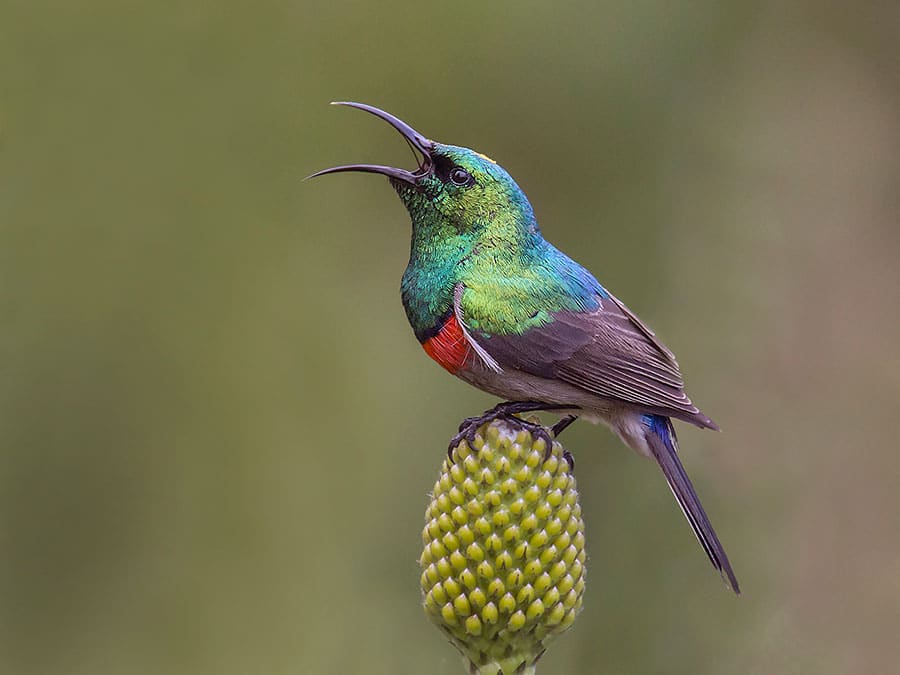
Winged Wonders: Top 10 Must-See Birds on Your Next South African Safari

Author: Devryn Panaino - 6 March 2024
Last Update: 7 March 2024
Part of the African Safari South Africa & African Safari Collection
South Africa is a birding safari paradise with its diverse ecosystems, spread across nine biomes , hosting an extraordinary 800 recorded bird species.
Avid bird watchers and all-round nature lovers can take in the flight of the African Fish Eagle or the cute waddle of the endangered African Penguin across the country’s top bird-watching destinations, Kruger National Park , the West Coast National Park, and the iSimangaliso Wetland Park.
Join us on an exciting journey through the skies of South Africa, featuring ten outstanding birds that you shouldn’t miss on your next South African safari :
1. African Penguin (Spheniscus demersus)
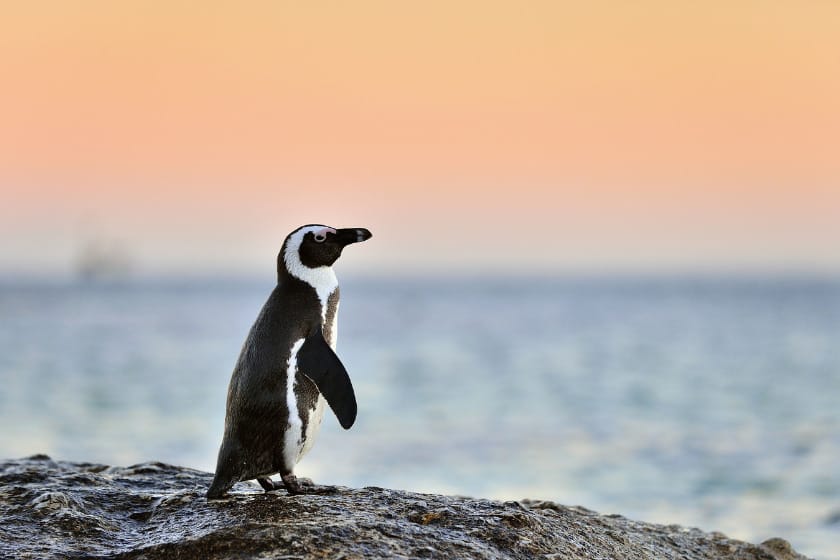
South Africa is one of the few places on the African continent where you can spot this little fellow with its smart black-and-white ‘tuxedo-like’ coat. Previously known as the jackass penguin because of its donkey-like bray, the African penguin reaches a height of between 60 – 70 cm (24 – 28 inches).
Superbly adapted to aquatic life, their thick layers of overlapping feathers waterproof them effectively. The spot patterns on their white torsos are unique and used to identify individual birds. Their diet includes pilchards, herring, squid, crustaceans, anchovies, and horse mackerel.
African penguins are found primarily on island colonies along the Southern African coast, from Hollams Bird Island in Namibia to Algoa Bay in the Eastern Cape. There are two mainland colonies at Boulders Beach and Betty’s Bay near Cape Town, now popular tourist attractions in the Western Cape.
Interesting Fact:
Though clumsy on land, African penguins are superb and agile swimmers, using their flippers and torpedo-like bodies to ‘fly’ through the water at up to 20 km/h (12 mph). They can dive to an astonishing 130 metres or well over 400 feet.
2. Cape Sugarbird (Promerops cafer)
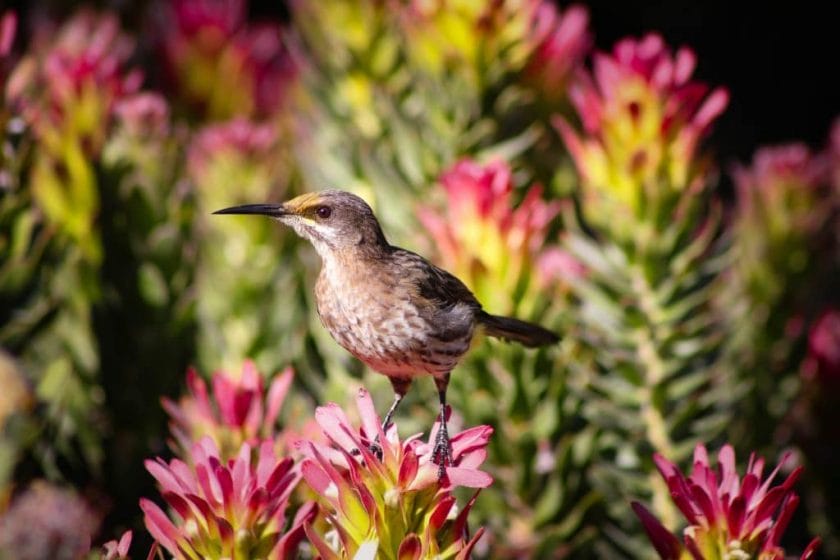
The Cape sugarbird is known for its extraordinarily long tail feathers. It also has a long, decurved beak designed for nectar feeding, particularly off proteas (or sugarbushes) endemic to the Cape fynbos biome.
A dullish brown colour above, sugarbirds have an attractively mottled torso and a bright yellow undertail. They’re known for their characteristic loud grating call.
Though specialised nectar feeders, they will also eat spiders and other insects. They have developed strong claws to hold on in the notorious Cape winds.
Cape sugarbirds are endemic to the unique fynbos habitat of Cape Point and other Western Cape reserves, home to many nectar-producing plants like proteas and ericas.
The Cape sugarbird plays a crucial role in the pollination of the fynbos. As it feeds on the nectar-rich flowers, it effectively transfers pollen from one plant to another.
3. Lilac-breasted Roller (Coracias caudatus)
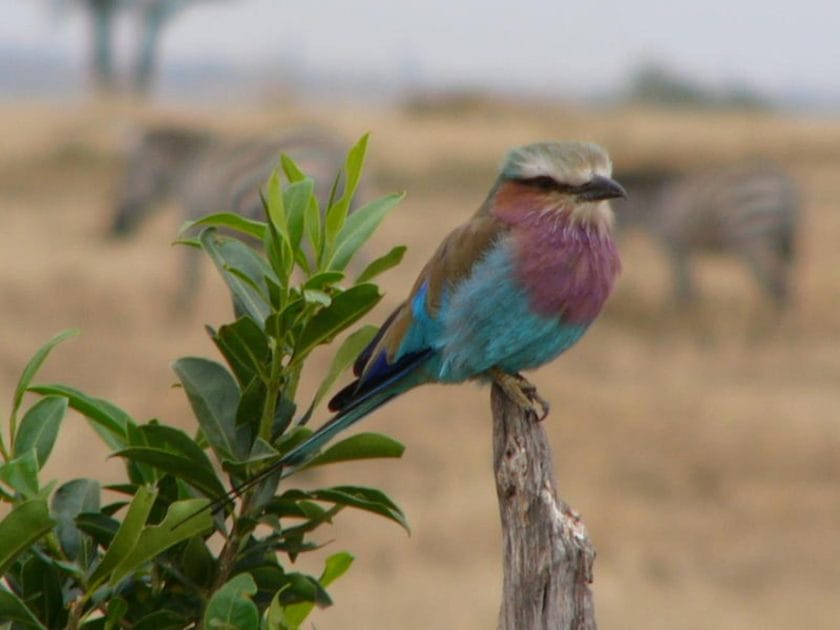
The medium-sized Lilac-breasted Roller is described as a spectacular living little rainbow with eight different colours in its plumage, including its standout lilac breast and vivid turquoise underparts.
Rollers are often seen perched in a good elevated lookout spot. They are monogamous and highly territorial. They usually live in pairs, and nest in holes in trees or termite mounds. Their diet includes grasshoppers, crabs, beetles, small lizards, amphibians, rodents, and birds. They swoop and catch them on the ground with their strong, hook-tipped beaks.
Open bushveld savannahs and riverside habitats throughout southern and eastern Africa.
Rollers are named after their breathtaking aerial acrobatics during courtship, which includes a series of swift dives and rolls.
4. Malachite Kingfisher (Corythornis Cristatus)
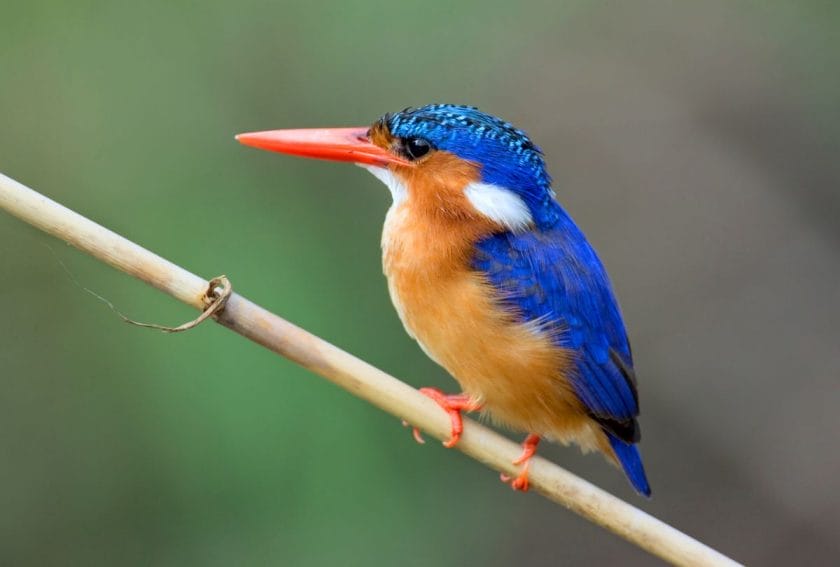
This small wetland kingfisher, with its iridescent blue and vibrant orange colours, is a little jewel of the South African bush.
Found in almost all water-rich areas, its hunting behaviour is to sit motionless before rapidly darting down and snatching its prey from the water.
Their diet includes fish, frogs, crabs, tadpoles, and aquatic insects. Their call is a loud ‘tshik’ sound often uttered during flight. Mating pairs usually nest in burrows that they excavate in riverbanks.
They are found throughout South Africa around freshwater bodies like rivers, lakes, wetlands, and coastal estuaries. They even occur in drier areas like the Kalahari basin and the western Karoo.
After catching its prey, usually a small fish, the bird returns to its perch, beats it against the branch to kill it and softens it before swallowing it head-first.
5. Southern Yellow-billed Hornbill (Tockus Leucomelas)
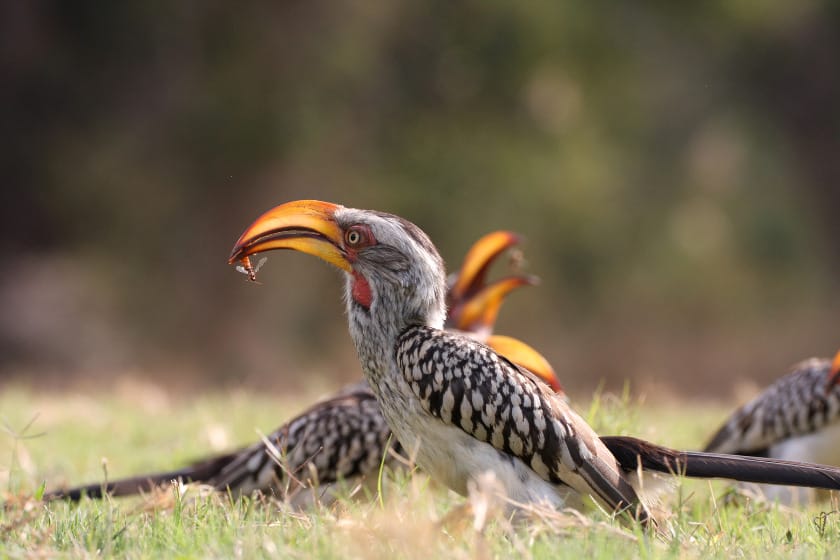
This intelligent and often amusing bird was rather bizarrely introduced to the world as Zazu in The Lion King! It’s a medium-sized, omnivorous bird characterised by its large yellow beak and striking black, white, and grey plumage.
It feeds on anything from seeds, fruit, bird chicks, termites, ants, frogs and chameleons.
Yellow-billed hornbills are monogamous, and the male will ‘woo’ the female by bringing her food before mating! After mating, the female will close herself into a hole in a tree, and the male will continue feeding her until the eggs hatch.
Hornbills are found in dry, open savannahs, acacia, and broadleaved woodlands, where they can be seen foraging on the ground.
Known for its intelligence, this bird has a mutualistic relationship with dwarf mongooses. They often forage together companionably to their mutual benefit.
6. Bateleur Eagle (Terathopius Ecaudatus)
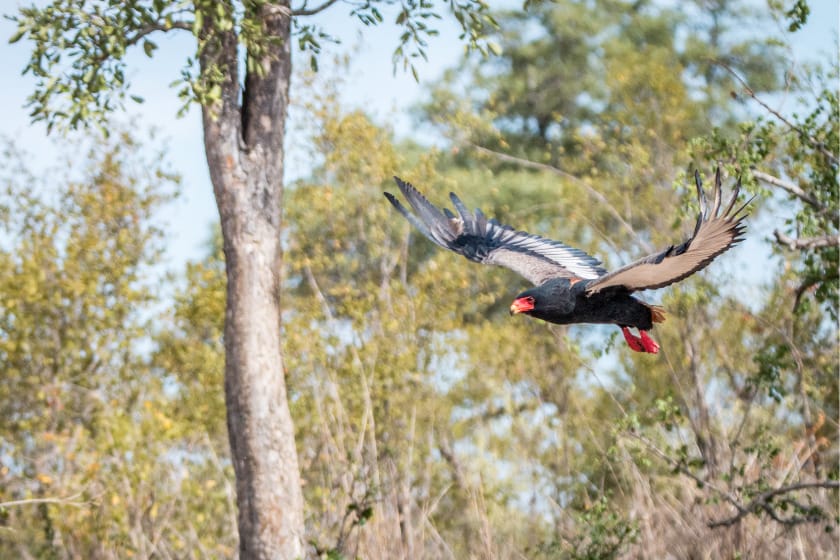
The largest of the snake eagles, the bateleur is a powerful raptor with a distinctive red face and legs, and a short tail that gives it a unique silhouette in flight.
The females are bigger than the males, and the couples engage in spectacular aerial acrobatics during their mating flights.
Bateleur eagles pair for life and use the same nest, usually in a large tree, for years. A single egg is laid and hatches after about 55 days, incubated mainly by the female.
Bateleurs’ diet includes mice, snakes, birds, carrion (especially road kills) and lizards.
Bateleur eagles are found in grassland and acacia savannahs over most of sub-Saharan Africa, though their numbers are reportedly declining.
Bateleurs love the sun! They’ll bathe, stand in a classic upright ‘phoenix pose’ with their wings held out, and even turn to follow the sun.
7. Knysna Turaco (Tauraco Corythaix)
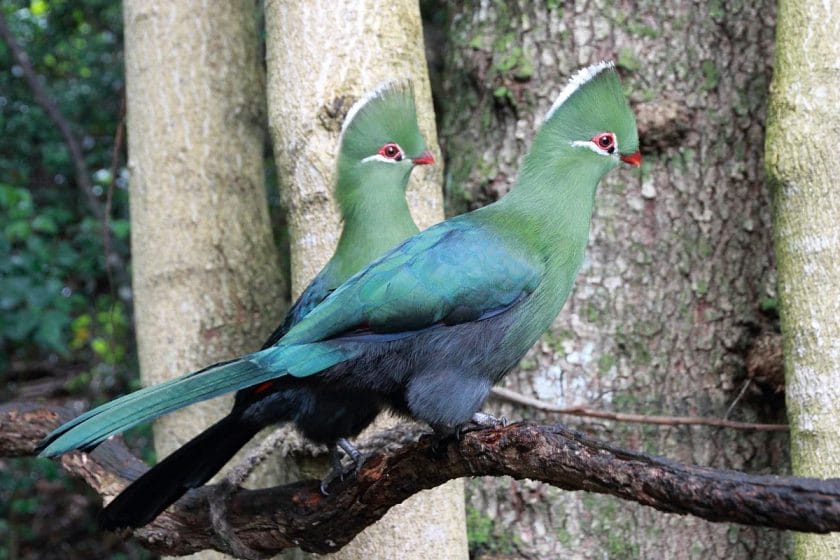
Previously known as the Knysna loerie, this medium-sized bird is a delightful soft forest green, with iridescent blue wing and tail feathers and dramatic red wing patches.
It has a prominent white-tipped crest, eye-catching red and white eye ‘makeup,’ and a red bill.
It’s endemic to Southern Africa and is primarily found in the Eastern and Southern Cape. Its prime habitats are the dense, evergreen indigenous forests and woodlands in these areas, most notably the Knysna and Tsitsikamma forests and the Amatole and Hogsback mountains.
The Knysna Turaco is known for its characteristic loud and melodious call.
8. Martial Eagle (Polemaetus Bellicosus)
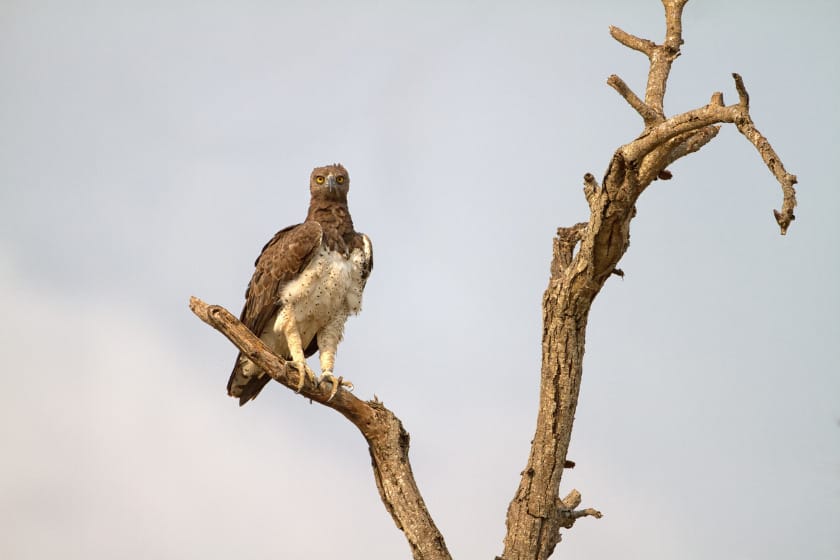
The Martial Eagle is one of the world’s largest eagles, with a wing span of almost two metres. The females are even larger.
This majestic raptor commands immediate attention with its piercing eyes, dark brown head and upper parts, and beautiful speckled plumage.
Its powerful talons are strong enough to break a human arm. Birds form an important part of the martial eagle’s diet, including bustards, guineafowl, and francolins. It’ll also take dassies (rock hyrax), small antelopes, and monkeys.
A mating pair usually has two huge nests that they use in alternating years. The Lower Sabie area in the Kruger is known for its martial eagle and other bird sightings.
Martials prefer open and semi-open habitats, savannahs, and semi-desert regions, where they’re often seen soaring high on the thermals.
Martial eagles are apex predators with exceptional eyesight, estimated to be around three to four times more acute than humans. This allows them to spot their prey from several kilometres away.
9. Blue Crane (Anthropoides Paradiseus)
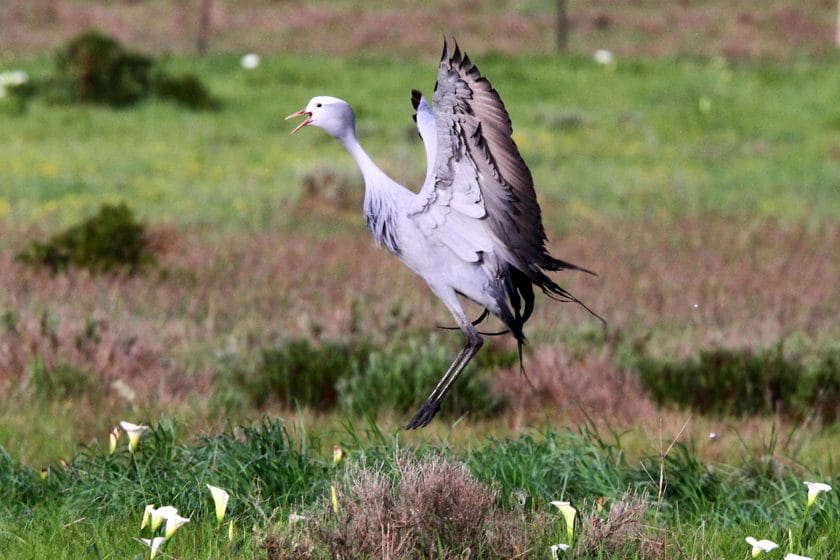
This elegant endemic bird is the national bird of South Africa. It has beautiful blue-grey plumage, a striking crown of feathers, and trailing tertial plumes.
They stand about 110 – 120 cm tall, well over 3 feet tall.
Blue cranes commonly forage on the ground and are omnivorous with a diet of bulbs, seeds, leaves, roots, grasshoppers, small mammals, reptiles, frogs, fish, and crustaceans. They make loud, guttural, bugle-like calls, are monogamous, and breeding pairs are strongly territorial.
Blue cranes are found in the Mpumalanga Highveld, the Free State, KwaZulu-Natal, and the Eastern and Western Cape, with about 60 birds in and around Etosha pan. They prefer open grasslands but are also found in cultivated pastures and croplands. In drier areas like the Karoo and Namibia, they frequent dwarf shrubland and dry grasslands.
Blue Cranes engage in a complex and graceful courtship dance, which includes intricate steps, wing flapping, bowing, jumping, and tossing grass into the air.
10. African Fish Eagle (Haliaeetus Vocifer)
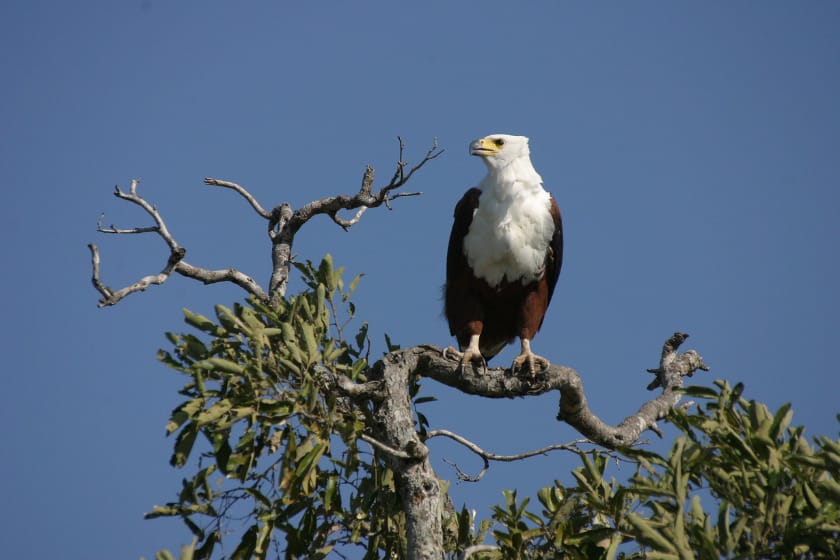
This large and handsome raptor is instantly recognisable by the striking contrast of its white head, chest, and tail against the rich brown of its body. It strongly resembles the American bald eagle with the same bold colouration.
It feeds mainly on catfish and lungfish but has been known to take flamingoes and other aquatic birds. It also steals prey from other birds. It’s frequently seen sitting high in a tall tree from which it will swoop down and skilfully snatch its prey from the water with its talons.
Widespread throughout Southern Africa, it’s commonly found near large water bodies like lakes, rivers, and reservoirs.
It’s renowned for its clear and characteristic call, dubbed ‘the voice of Africa.’ It’s said that once you’ve heard its distinctive cry, you’ll remember it forever.
At Discover Africa, we’re passionate about showcasing the incredible wildlife of Africa, and South Africa’s remarkable birdlife certainly enhances the wildlife experiences you can choose from.
Wherever your dream destination is, at Discover Africa, we’ll tailor the perfect, unforgettable South African birding safari tour for you.
5 of the Most Interesting Plants in Botswana
5 Kenya Highlights Worthy of Your Next Photo Safari
Related Safari Tours
These popular itineraries can be customised to match your budget and how many people you're planning to travel with..

Best of South Africa and Botswana Safari
Southern Africa South Africa Cape Town Kruger National Park Johannesburg Botswana
From $ 7450 /USD

Bespoke Luxury Safari in South Africa
South Africa Cape Town Johannesburg Kruger National Park
From $ 13100 /USD
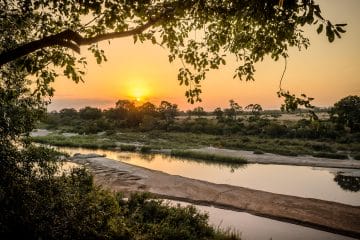
A grandiose journey through Cape Town, the Wine...
South Africa Cape Town Franschhoek Sabi Sands
From $ 14000 /USD
Keep discovering...
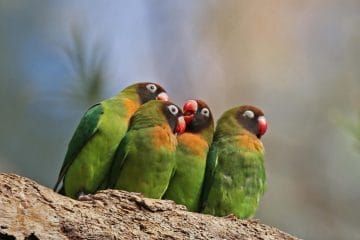
Namibia Namibia
10 birds to spot on safari in namibia.
Namibia’s varied landscapes of deserts, savannas, wetlands, and coastal regions provide the...
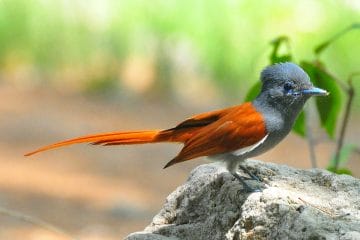
10 of the Weirdest Mating Rituals of African Birds
With a wide variety of both endemic and migratory species, Africa is...
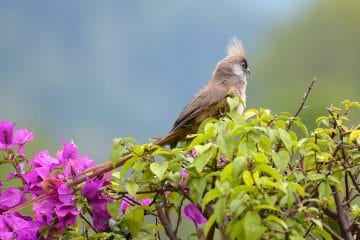
10 Birds to Spot on a Safari in Rwanda
With varied habitats that include tropical rainforests, montane forests, savannahs, wetlands, and...
Why travel with us?
Recent reviews from travellers who planned and booked their africa trips with discover africa safaris, well organised itinerary.
South African Safari Review
John B, United Kingdom 30 Sep 2023
Discover africa, especially susan, designed a perfect dream vacation that was 100%....
11 Day South Africa Safari Review
Jennifer, United States 19 Jul 2023
Megan and steve are professional well informed and went out of their....
A Safari holiday in Namibia Review
Jenny, South Africa 01 Nov 2021
Awesome experience in sabi sabi.
Safari Review in Sabi Sands Nature Reserve
Christopher Russell, United States 27 Nov 2019
It was very smooth and organized..
African Experience Review
Jane N, United States 04 Feb 2019
Kilimanjaro private climb was fantastic.
Zanzibar and Kilimanjaro Adventure
Mark Tomlinson, South Africa 10 Jun 2015
Registered Members of these Organizations
USEFUL LINKS
- African Safaris
- African Safari Tours
- African Safari Lodges
- Why Book with us?
- Content Collaborations
- Safari Cost Estimator Tool
- Wildebeest Migration
- Privacy Policy
- Website Terms of Use
POPULAR COUNTRIES
- View All Countries
- South Africa Safaris
- Botswana Safaris
- Kenya Safaris
- Tanzania Safaris
- Namibia Safaris
- Rwanda Safaris
- Uganda Safaris
- Zambia Safaris
- Zimbabwe Safaris
POPULAR DESTINATIONS
- View All Destinations
- Cape Town Holidays
- Kruger Safaris
- Victoria Falls Safaris
- Masai Mara Safaris
- Serengeti Safaris
- Etosha Safaris
- Chobe Safaris
- Okavango Delta Safaris
TRAVEL BLOGS
- Virgin Atlantic and Kenya Airways improve connectivity to Kenya
- South Africa’s Mega Landscapes Plan: Conservation Boost or Nature Risk?
- Rwanda vs Uganda: Which is Better for Mountain Gorilla Trekking?
- Kruger’s New Gate to Grow Tourism + SA’s Top Parks to Visit in 2024
- East Africa’s Safari Experiences: A Photographer’s Paradise
DISCOVER AFRICA SAFARIS
- 2nd floor, Tygervalley Chambers One, 27 Willie van Schoor Avenue, Bellville, Cape Town , 7530
30 African Safari Animals You Need To See (With Pictures)

Africa’s natural beauty is unmatched, luring you to gaze at the passive stride of a lioness that you forget to breathe and marvel at a giraffe’s tripod bent to water.
The continent’s jungles, savannahs, forests, and other natural habitats contain mysteries that even a wise man cannot understand.
Therefore, seeing one-tenth of these African animals would bring about an incredible safari escapade.
It would be impossible to find all of Africa’s wildlife species, prompting us to compile a list of thirty African safari animals you need to see, including lions, elephants, zebras, and antelopes, among others.
Each animal we will consider has its scientific name, geographical range, conservation status, and photo highlighted, with a description that features the best places to find them.
So come along with us as we explore the beautiful world of these animals you can see on an African safari.
African Safari Animals You Should See
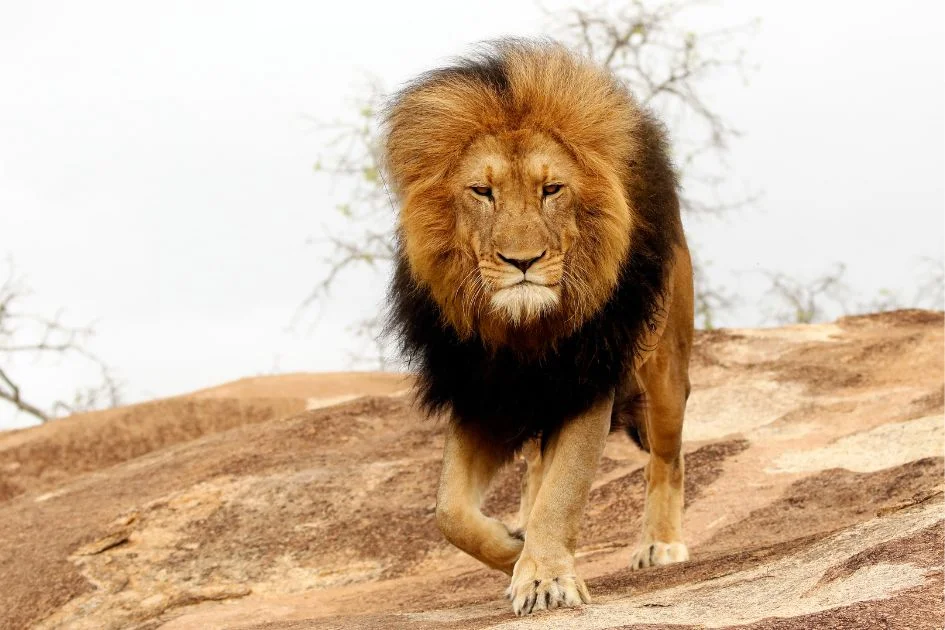
- Scientists Name: Panthera Leo
- Conservation Status: Vulnerable
Lions are endemic to Africa, occluding in savannahs, scrublands, grasslands, grassy plains, open woodlands with bushes, and bordering rivers.
Between 300 and 1,500 mm of annual rainfall, Savannahs constitute most African lion habitats.
Some populations reside in West African tropical moist forests and montane forests.
Sadly, Africa’s lion population has declined substantially by fifty percent in only twenty years. 1
However, one can still find lions in the Kgalagadi Transfrontier Park, South Africa, and Serengeti National Park, Tanzania.

- Scientific Name: Panthera pardus
- Conservation Status: Not Extinct
The leopard resides across sub-Saharan Africa and is aboriginal to many African nations.
These spotted cats inhabit the Cape Provinces of South Africa, Somalia, Ethiopia, and West Africa, occurring in mountainous forests, grasslands, and savannahs.
Leopards are among Africa’s “Big Five” safari, attracting many tourists; Zambia’s South Luangwa National Park and South Africa’s Sabi Sands Game Reserve are some of the most prominent leopard centers in the continent.
The Virunga National Park in the Democratic Republic of the Congo has recorded leopard sightings as the animals drink the park’s thermal waters.
3. Elephant
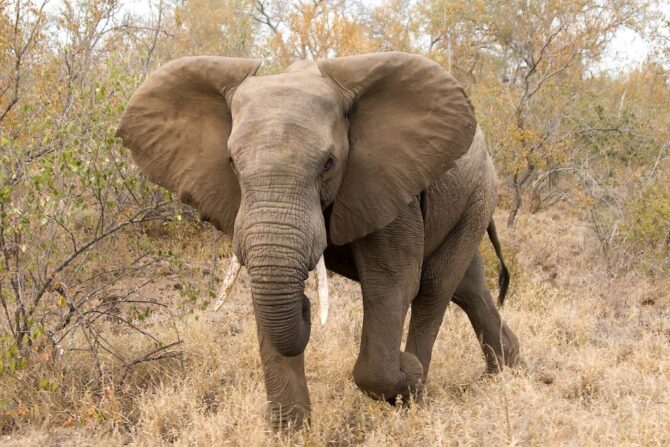
- Scientific Name: Loxodonta africana
- Conservation Status: Endangered
African elephants are considered endangered by the IUCN; still, they are indigenous to the continent, inhabiting the Sub-Saharan arid regions and Sahelian scrub.
They also reside in the continent’s jungles in tropical rainforests, mopane, and miombo woodlands.
African elephants primarily have populations in Central Africa.
Still, they exist in the Chobe National Park in Botswana, the Amboseli National Park in Kenya, East Africa, and the Hwange National Park in Zimbabwe, Southern Africa.
Also See: List of Animals with Big Heads (with Pictures)
4. Rhinoceros
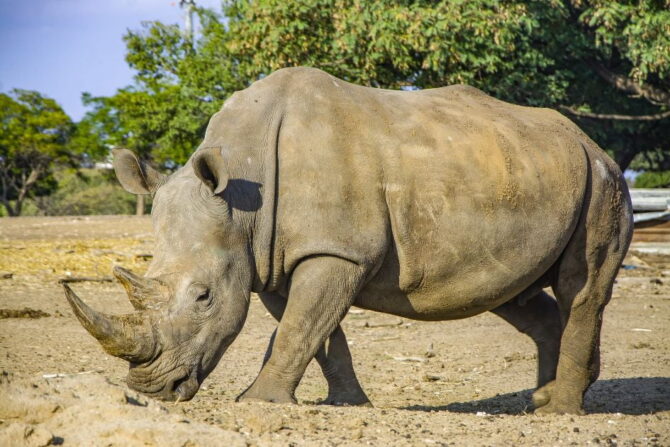
- Scientific Name: Rhinoceros
- Conservation Status: Critically Endangered
The black rhino species is endemic to Africa, living in its eastern and southern regions.
Rhino populations inhabited eleven countries, but most wild rhinos today, from the estimated six thousand, occupy only four countries — Zimbabwe, South Africa, Namibia, and Kenya.
They roam the open savannahs and grasslands and naturally exist in Etosha National Park, Namibia, Ziwa Rhino Sanctuary in Uganda, Nairobi National Park, Kenya, and Kruger South Africa.
Black rhinos have a size worthy of making them major African wildlife, growing up to 5.2 feet, and weighing 1,760 to 3,080 pounds.

- Scientific Name: Syncerus caffer
- Conservation Status: Near Threatened
Various species of the African buffalo occupy every part of the continent. The Cape buffalo inhabits Southern and East Africa, while the forest buffalo occurs in Central and West Africa.
These species are enormous, measuring up to 5.6 feet in shoulder height and weighing up to 1,900 lb.
They live in savannahs, swamps, mopane grasslands, and densely covered habitats.
Some wildlife parks include Masai Mara National Park in Kenya, Chobe National Park in Botswana, and Serengeti National Park in Tanzania.
6. Hartebeest
- Scientific Name: Alcelaphus buselaphus
- Conservation Status: Least Concern
The hartebeest is an antelope species native to the black continent.
It is a large-sized species with a prominent hump, a large chest, and a long face that distinguishes it from other antelope species.
Hartebeests are primarily grazers, with grasses making their menu, but they mostly occupy wooded grasslands, dry savannas, and open plains in Central, West, southern, and southeast Africa.
The hartebeest roams in their natural habitats in the Kruger and Bontebok National Parks in South Africa, Etosha National Park in Namibia, and Camp Linyanti in Botswana.

- Scientific name: Tragelaphus eurycerus
The bongo is another antelope species native to African jungles, with white-yellow stripes and black-and-white markings on its reddish-brown coat.
Bongos exist in tropical forest mosaics with dense undergrowth around West and Central Africa.
The Aberdare National park in Kenya is one major spot to find the bongo.
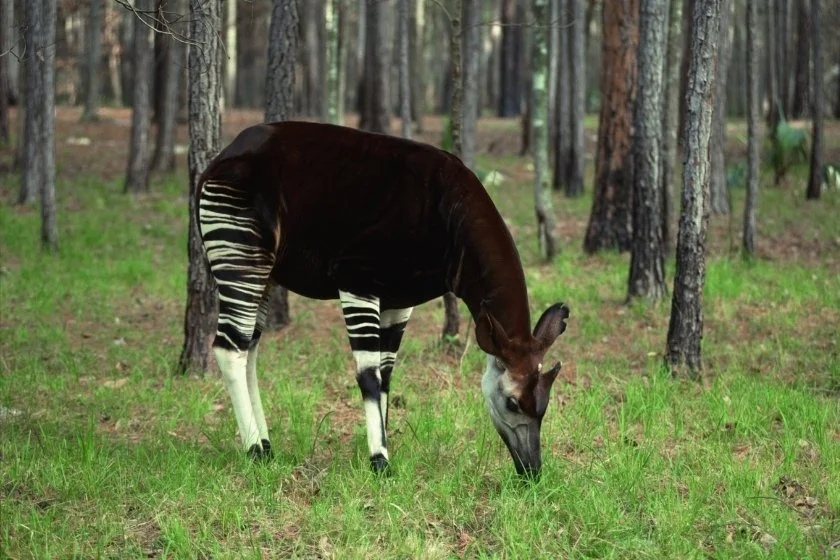
- Scientific name: Okapia johnstoni
- Conservation Status: Endangered
The okapi, a zebra look-alike, is the only extant member of the Giraffidae family along with the giraffe.
However, the okapi is not as tall as a giraffe, measuring only four feet and eleven inches.
It occupies canopy forests but is essentially solitary, with wildlife populations in the Okapi Wildlife Reserve, Ituri Rainforest, and Virunga National Park in the Democratic Republic of Congo.
9. African Wild Dog
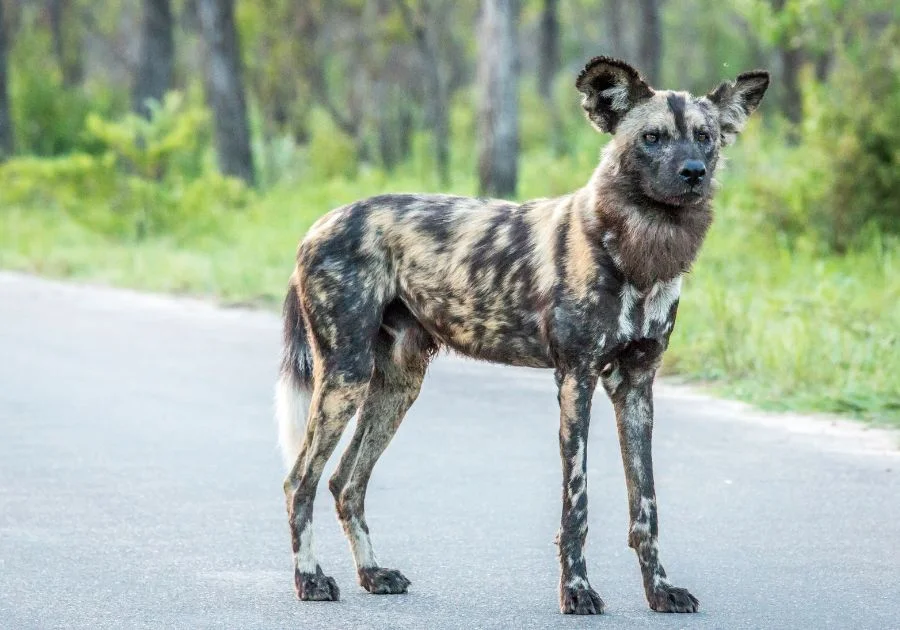
- Scientific Name: Lycaon pictus
The African wild dog is a threatened species now mostly located in the southeast of Africa, with only over 6,000 individuals left. 2
These wild dogs primarily inhabit Africa’s savannas and dry regions, preying mainly on antelopes.
African wild dogs have a strong sense of socialization to form packs of about thirty dogs.
The best places to find the African wild dog include woodlands, scrublands, and mountains, and they are open to the public in their natural habitats in:
- Madikwe Game Reserve in South Africa
- Mana Pools National Park in Zimbabwe
- Moremi Game Reserve in Botswana
- Selous Game Reserve in Tanzania
- South Luangwa National Park in Zambia
Also See: Different Types Of Wild Dogs (Species List With Pictures)
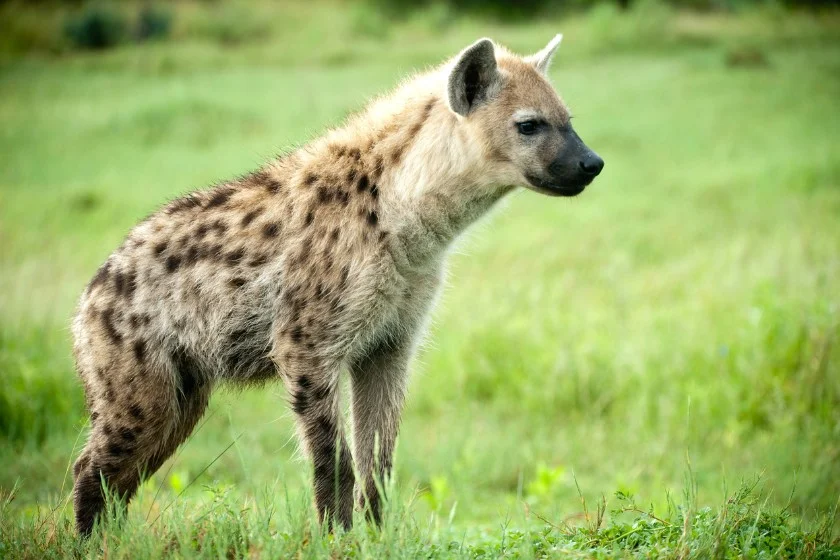
- Scientific Name: Hyaenidae
Hyenas occupy Africa’s savannas, sub-desserts, grasslands, forest edges, and woodlands and hold an apex position on the food chain.
Hyenas control prey populations and prevent the spread of diseases, primarily by consuming animal remains that could rot and cause diseases.
They have unparalleled bone-crushing abilities, helping them fight off potential competitors. 3
Hyenas may not be among the most beautiful animals, but they attract visitors around Kruger National Park and Pilanesberg National Park in South Africa.
11. Wildebeest
- Scientific Name: Connochaetes taurinus
The antelope’s imposing appearance is why the Afrikaans named it the wildebeest.
However, it is never too fearsome to the African wild cats, wild dogs, and hyenas that constantly prey on it.
Wildebeests are among the jungle animals in southern Africa that also occupy grassy plains and open woodlands that support their grazing routine in Angola, Botswana, South Africa, Mozambique, and Tanzania.
The Serengeti National Park in Tanzania and Masai Mara National Reserve in Kenya are some of the best places to watch the wildebeest.
12. Warthog
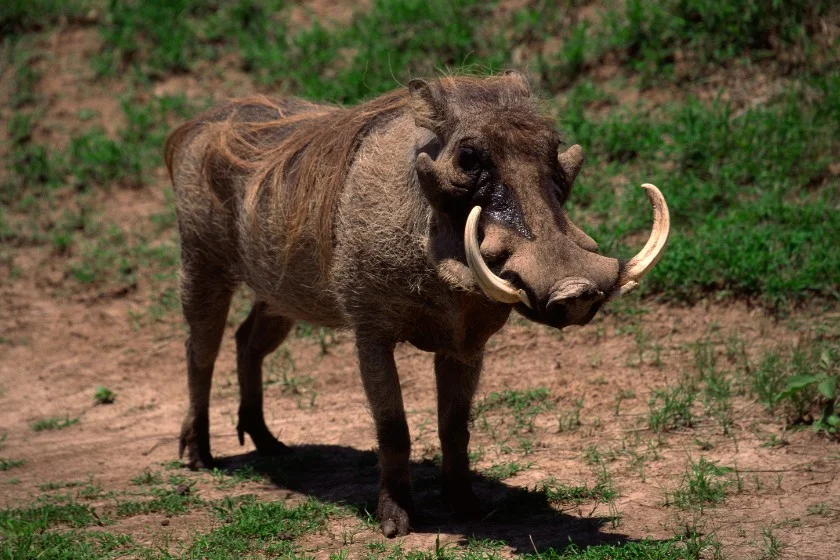
- Scientific Name: Phacochoerus africanus
The common warthog is a plump, hooved wild pig with little fur, a mane through the spine to the middle of its back, and upper tusks that protrude upwards from the mouth.
Warthogs, commonly called Pumba by many safari guides, are among Africa’s highly-watched safari animals.
They reside in grasslands, savannas, and woodlands in sub-Saharan Africa, across western, eastern, central, and southern Africa.
The Kruger National Park, South Africa, and Meru National Park, central Kenya, are famed for housing the warthog.
13. Vulture
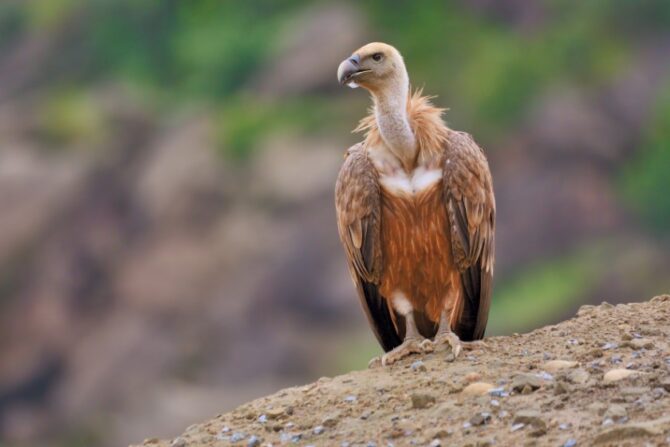
- Scientific Name: Accipitridae (Old World vultures); Cathartidae (New World vultures)
About eleven vulture species from the Accipitridae and Cathartidae families reside in Africa, popular among many as a scavenger and keystone species in most of the continent’s ecosystem.
Sadly, about seven of eleven African vulture species are critically endangered, with West Africa losing about ninety percent of the native White-backed vulture. 4
However, vultures spread across the black continent in west, north, east, central, and southern African cliffs and tall trees.
The Kruger National Park in South Africa and Comoé National Park have vultures, and one might be fortunate to find one while visiting.
Also See: African Birds: 30 Amazing Safari Bird Species, With Pictures
14. Marabou Stork
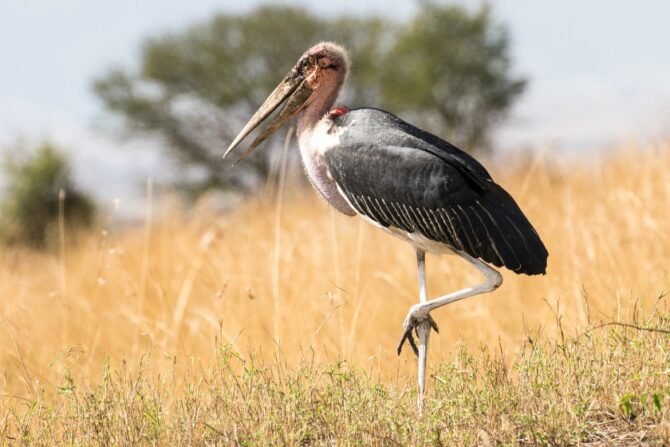
- Scientific Name: Leptoptilos crumenifer
While most storks are beautiful, the marabou stork has a reputation for horror due to its black cloak, large, fleshy pouch, and featherless features.
However, even the world’s most unattractive creatures attract large fanbases, explaining why the marabou stork ranks among Africa’s safari animals you should see.
Marabou storks are also large birds, reaching four feet, eleven inches in height, and 6.5 feet in wingspan length.
The IUCN ranks these birds as ‘Least Concern,’ with a stable population to support their evaluation.
Therefore, one can find the marabou stork in the west, east, central, and southern Africa.
One can find the marabou stork in Ben Lavin Nature Reserve and the African Bird of Prey Sanctuary in South Africa.
- Scientific name: Beatragus hunteri
The hirola is the world’s rarest antelope, native to Kenya and southwest Somalia.
White spectacles around its eyes, a white tail through to the hocks, and lyre-shaped horns are distinctive features that distinguish the hirola from other antelope species.
The hirola occupies parched environments with relatively low annual rainfall.
However, it is a primary grazer, enjoying grasses with more leaves than stems. Hirola populations exist in Tsavo East National Park, Kenya.
16. Giraffe
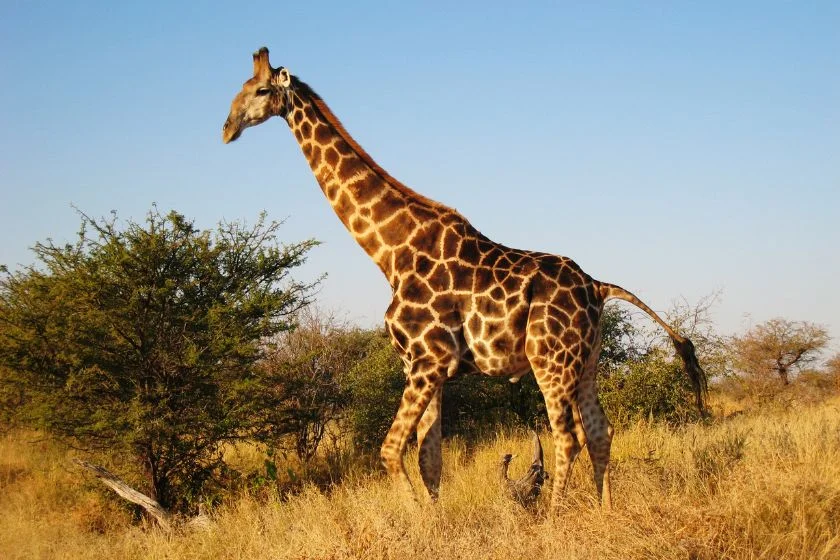
- Scientific Name: Giraffa camelopardalis
- Conservation Status: Vulnerable
Everyone wants to watch the world’s tallest living terrestrial and largest ruminant creature.
Giraffes occupy semi-arid savannah and savannah woodlands and are highly distinguished by their extremely long necks and legs.
Some best places to find the Giraffe in its natural habitat include:
- Africa’s Murchison Falls National Park in Uganda
- Etosha National Park in Namibia
- Serengeti National Park in Tanzania
- Maasai Mara National Reserve in Kenya
- Kruger National Park in South Africa
- Kouré in Niger
Also See: Amazing Long Neck Animals (List With Pictures)

- Scientific Name: Equus
Three zebra species reside in Africa, but the common zebra is the most popular. They all share black-and-white striped coats, but patterns are unique to each species.
The common zebra ( Equus quagga ) occupies much of southern and eastern Africa, the mountain zebra ( Equus zebra ) in southern Africa, and the Grévy’s zebra ( Equus grevyi ) in east Africa.
Zebras are herbivores and inhabit grasslands, savannahs, shrublands, woodlands, and mountainous areas.
The best places to find Zebras in their natural habitats include:
- Makgadikgadi Pans in Botswana
- Lewa Conservancy in Kenya
- Klein Karoo in South Africa
18. Hippopotamus

- Scientific name: Hippopotamus amphibius
Hippos are famed for their round and cute appearance and a fearsome reputation for being the world’s deadliest land mammal, killing an estimated 500 people annually in Africa.
They weigh up to 2,750kg, with large tusks and speeds reaching 30 km/h. Hippos are everywhere in the black continent, occurring in Central, Eastern, and Southern Africa.
The hippo’s history with man implies that encountering it in the wrong place might not end well.
However, the South Luangwa and Lower Zambezi National Parks in Zambia, Okavango Delta in Botswana, and Selous in Tanzania are among the best places to view the hippopotamus.
19. Common Ostrich

- Scientific Name: Struthio camelus
The common ostrich is the world’s largest and heaviest extant bird . However, such feats make the bird incapable of flight due to its immense weight.
However, the common ostrich makes up for its lack of light with speed, running up to forty-three kilometers per hour.
They are also impressive with using their long, powerful legs as defensive weapons.
A mature ostrich can grow to a height of nine feet and weigh up to 160 kilograms, a size worthy of ranking among African Safari animals one should see.
Many zoos feature ostriches in captivity, but the Kidepo Valley National Park in Uganda and the Kruger National Park in South Africa are nice places to find the common ostrich in their natural settings.
20. Shoebill
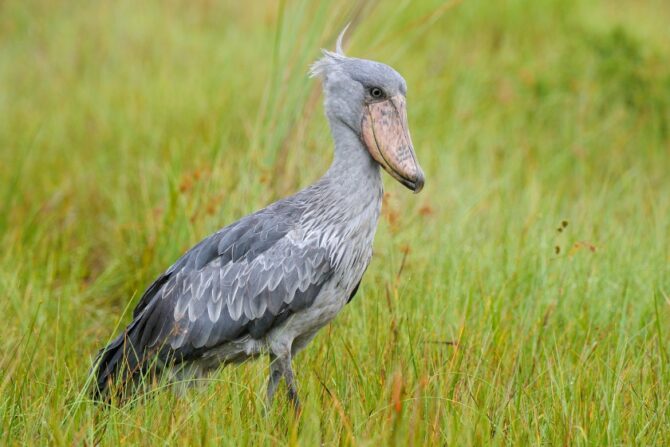
- Scientific Name: Balaeniceps rex
The bird’s large, striking shoe-shaped beak earns it the distinguished name. However, its enormous bill is just one of its features.
The shoebill is one of the world’s largest birds, growing up to four feet, eleven inches, thus becoming one of the five most captivating birds in Africa, according to birdwatchers.
The shoebill can be found in the Murchison Falls National Park in Uganda, Kasanka National Park in Zambia, and a few wildlife centers in the continent present views of shoebill storks.
21. Leopard Tortoise
- Scientific Name: Stigmochelys pardalis
The leopard tortoise is one of the smallest wildlife Africa’s safari offers. However, the leopard markings on its shell account for the most prominent feature.
The leopard tortoise has populations scattered across Africa’s semi-arid shrubland of the Sahara, from Sudan to the cape of South Africa.
The tortoise’s leopard markings are not its only distinctive feature, but its ability to swim is unique as it is the only Testudinidae with such an ability.
The Serengeti National Park in Tanzania and Mountain Zebra National Park in South Africa are wonderful destinations to find the leopard tortoise.
22. Meerkat
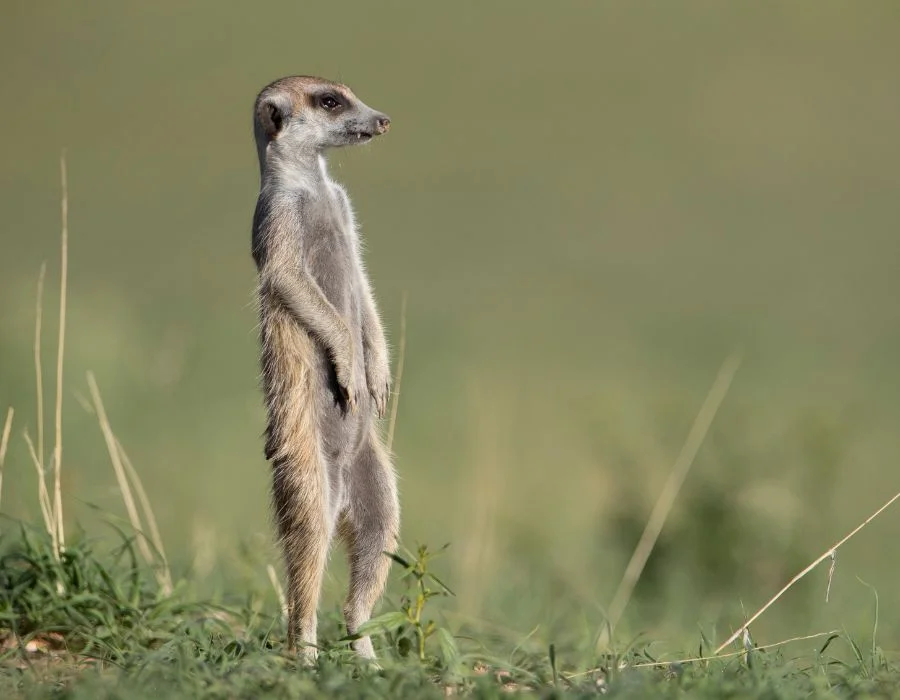
- Scientific Name: Suricata suricatta
Mongooses are popular for killing snakes, and here is the meerkat, an animal belonging to the same family — Herpestidae.
The meerkat is a small mongoose native to Southern Africa, inhabiting arid, open habitats containing little woody vegetation in Namibia, Botswana, and South Africa.
Mongooses have a distinctive banded pattern, big eye circles, thin tails, and sharp, curved foreclaws that support digging.
They dig burrows in the Kgalagadi Transfrontier Park and Tswalu Kalahari Reserve in South Africa.
- Scientific Name: Tragelaphus
- Conservation Status: Least Concern
The kudus are two large-sized antelope species found in East and Southern Africa.
The most distinctive feature differentiating both species is size, with the greater kudu measuring over five feet and the lesser kudu within the four-foot range.
They inhabit savanna near Acacia and Commiphora shrubs, relying on thickets for protection.
Therefore, these antelopes are found in the Addo Elephant National Park and Hluhluwe-Imfolozi Game Reserve in South Africa, Chobe National Park in Botswana, and Etosha National Park in Namibia.
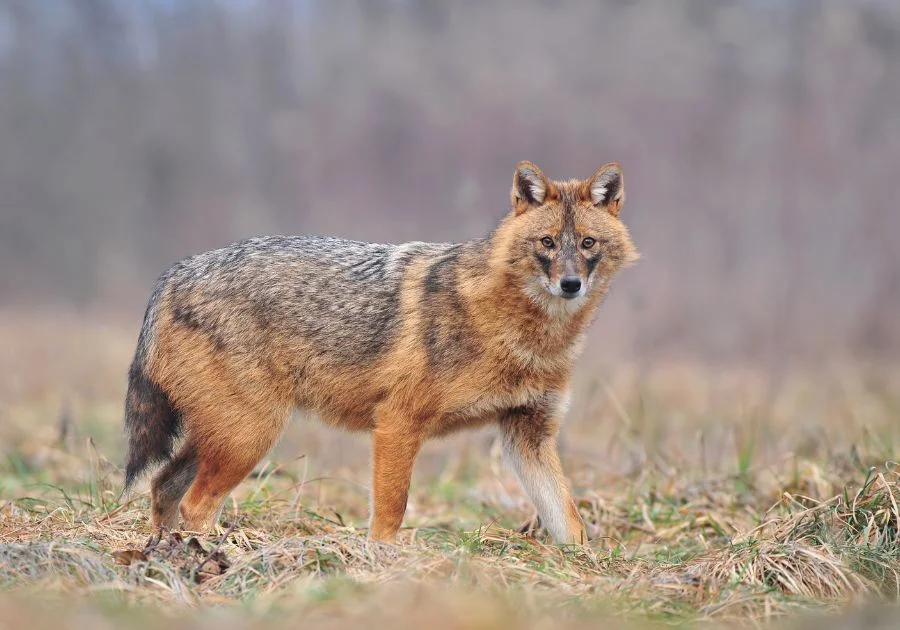
- Scientific Name: Canis aureus
Jackals are dog relatives of the genus Canis. Three jackal species exist — black-backed, golden, and side-striped, all occurring in different parts of Africa, especially the eastern and southern countries.
The black-backed jackal inhabits savannas and wooded areas; the golden jackal occupies dry environments, including deserts, open savannas, and arid grasslands.
The side-striped jackal lives in damp savannas, marshes, bushlands, and mountains.
Visiting the Kruger National Park, Shongweni Resources Reserve, and the wildlife parks offers the intriguing sights of jackals in South Africa.
The Tsavo West National Park in Kenya, Chobe National Park in Botswana, and Etosha National Park in Namibia are other nice places to find a jackal.
25. Cheetah
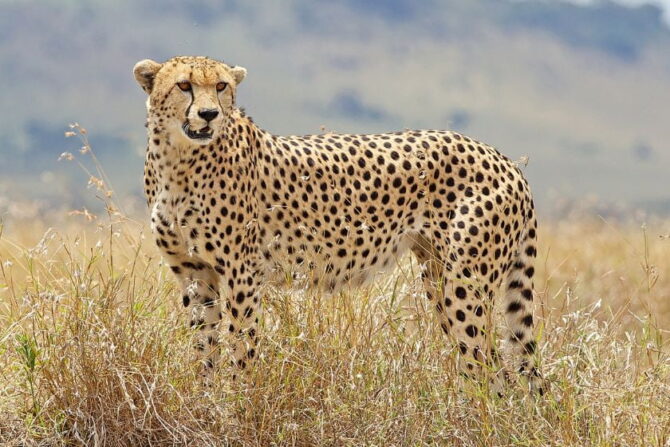
- Scientific Name: Acinonyx jubatus
Watching the world’s fastest land animal stalk its prey and initiate its signature high-speed chase is a dream sight to anyone willing to enjoy the untamed beauty of the African safari.
Therefore, some of the best places to watch a cheetah in your next safari escapade include:
- Okavango Delta in Botswana
- Phinda Private Game Reserve in South Africa
- Phinda Private Game Reserve in Tanzania
- Kidepo Valley National Park in Uganda
- Kafue National Park in Zambia
- Scientific Name: Aepyceros melampus
The Impala is one of the most elegant antelope species, featuring a graceful stride, plush, glossy, reddish brown coat, and slender, curved horns.
While you might love to admire them, it will be more thrilling to watch them jump clear of obstacles, leaping up to ten meters long and three meters high.
Such a sight lies in the Lake Mburo National Park and Katonga Wildlife Reserve in Uganda, Kruger National Park, Hluleka Nature Reserve in South Africa, and Masai Mara National Reserve in Kenya.
27. Waterbuck
- Scientific Name: Kobus ellipsiprymnus
It would help if You never get tired of seeing antelopes if you visit Africa for its safari.
The waterbuck is among the many antelope species you may find, especially if you cruise through Chobe National Park in Botswana, Serengeti National Park in Tanzania, Kruger National Park in South Africa, or Lake Nakuru National Park in Kenya.
Waterbucks are large, robust antelopes with reddish-brown to shaggy gray coats that become darker with age.
As the name suggests, the waterbuck depends on water, thus inhabiting areas close to water sources.
28. Kori Bustard
- Scientific Name: Ardeotis kori
- Conservation status: Near Threatened
Kori bustards are very large birds — the heaviest flying bird native to Africa. Male kori bustards weigh between seven and eighteen kilograms.
The male kori bustard’s wingspan ranges from seven feet seven inches to nine feet.
Even though they have large wings, they do not frequently fly unless necessary.
Therefore, there is much to admire in this feathered giant, bringing you to the Etosha National Park in Namibia and the Serengeti National Park in Tanzania, where it occupies sparsely wooded savannas and open grasslands.
29. Nile crocodile

- Scientific Name: Crocodylus niloticus
- Conservation status: Least Concern
Some insects and amphibians might be insignificant during a safari escapade, but not large reptiles and apex predators like the Nile crocodile.
The crocodile occupies various habitats, including rivers, lakes, and marshes, and earns a fearsome reputation for its size, fearlessness, and extremely powerful bite.
One can find the Nile crocodile in Serengeti National Park in Tanzania, Maasai Mara National Reserve in Kenya, the Okavango Delta in Botswana, and Murchison Falls National Park in Uganda, among others.
30. Grey-crowned Crane
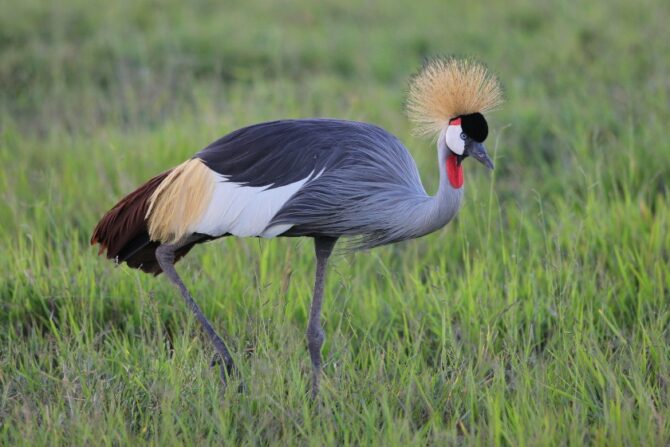
- Scientific Name: Balearica regulorum
- Conservation status: Endangered
The large, attractive bird, growing over three feet in height, with plush blueish-gray plumes and a golden crest, would be one of the most majestic creatures to see on one’s African safari.
The grey-crowned crane primarily inhabits dry savannas in Sub-Saharan Africa but could occur in cultivated areas and grassy flatlands in Kenya, Uganda, and South Africa.
The Amboseli and Lake Nakuru National Parks in Kenya and the Serengeti in Tanzania.
Also See: Beautiful Birds With Mohawks (With Pictures)
Frequently Asked Questions
What animals feature on africa’s top safari.
Africa’s safari features several animals, but lions, rhinos, leopards, elephants, and buffalos are the continent’s top-five safari animals.
Some of the world’s most popular animals, including zebras, cheetahs, giraffes, and antelopes, also feature on an African safari.
Would you see a tiger on an African safari?
While Africa is home to some of the world’s largest wild cats, including lions and cheetahs, it is very unlikely to find a tiger that is not in captivity in Africa.
However, one can find the tiger in a zoo or special reserve; the Laohu Valley Reserve, Tiger Canyon, Jugomaro Predator Park, and Pilanesberg National Park in South Africa are some places to find the world’s largest wild cat.
What is the most common animal on the safari?
The lion tops most people’s wishlists of animals to find on a safari. Without a doubt, it is one animal almost everyone coming on a safari would want to see, thanks to the beast’s title as the king of the jungle and the continent’s top carnivore.
What is the largest safari animal?
Lions, giraffes, hippos, and buffalos are in contention for Africa’s largest safari animals, but they do little to match the African bush elephant ( Loxodonta africana ).
The mammal can grow up to 13 feet and weigh almost 23,000 pounds, more than any other safari animal.
What African habitats support wildlife?
Most African habitats support wildlife, including savannas, rainforests, semi-deserts, wooded grasslands, deserts, and plains, because they have the perfect climate and terrains to support specific animals.
One might never get enough of Africa’s scenic terrains and the breathtaking explorations of its safari.
However, various challenges, including habitat degradation, human activities, and climate change, pose considerable threats to the survival of several African safari animals, driving some of these species to extinction.
Therefore, it will be more helpful for all to support conservation efforts to ensure the continuity of the continent’s beauty of undomesticated animals.
References & Notes
- Bauer H., Chapron G., et al. 2015. Lion (Panthera leo) populations are declining rapidly across Africa, except in intensively managed areas . PNAS.
- Alexis Valdes. 2018. Painted Ferocity: The Social Behaviors of African Wild Dogs, Threats to Survival, and Resulting Conservation Initiatives [pdf] . Liberty University.
- Binder W., Valkenburgh V. B. 2000. Development of bite strength and feeding behavior in juvenile spotted hyenas (Crocuta crocuta) . Journal of Zoology.
- White-backed Vulture Gyps africanus . BirdLife International.
Related Posts:
- African Birds: 30 Amazing Safari Bird Species, With Pictures
- 310+ Unique Monkey Names (Famous, Cute, Funny, Creative)
- Black And White Birds (30 Species, With Pictures)
- Types Of White Birds (30 Beautiful Species, With Pictures)
- 20 Most Beautiful Birds In The World & Where To Find Them
- Types Of Yellow Birds (31 Stunning Species, With Pictures)
About The Author
Jake Wilson
Related posts.
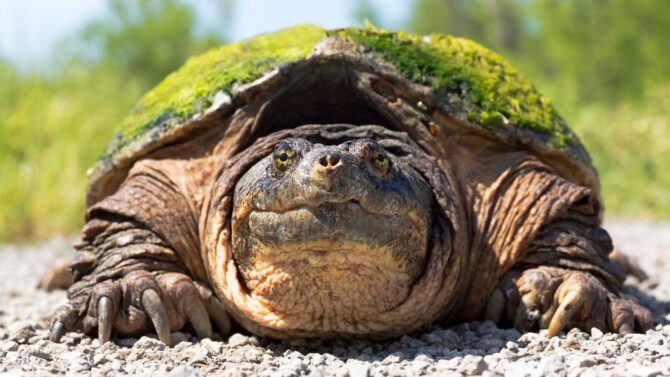
10 Common Dangerous Animals In Ohio

What Does A Black Wolf Symbolize?
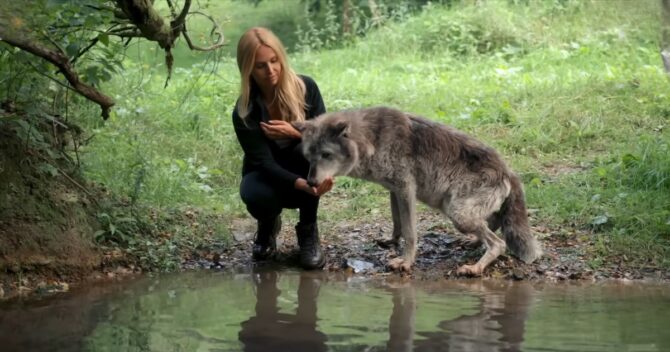
What Is A Female Wolf Called? – Unveiling Wolf Terminology and Behavior

A Guide To Animals That Are Not Mammals
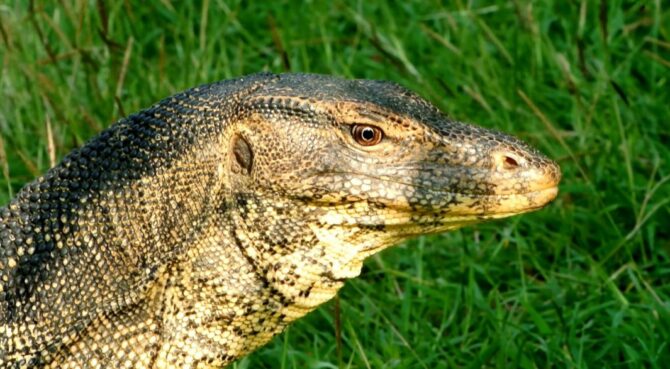
10 Common Dangerous Animals In Thailand You Need to Avoid
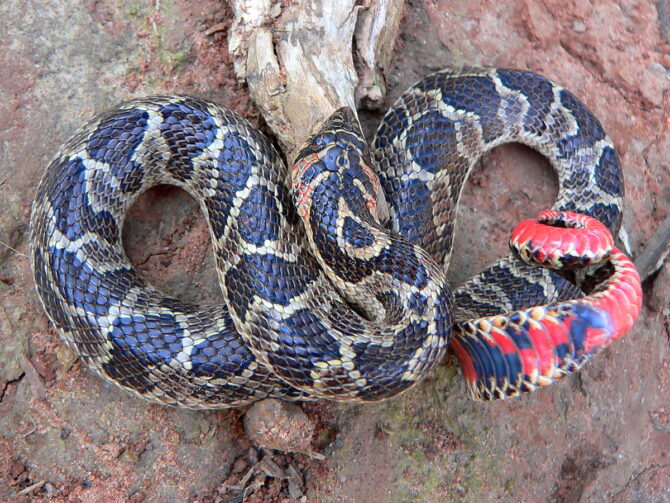
63 Animals That Start With X – Fun Facts

Animals Around the Globe
10 Best African Countries for Safari
Posted: December 19, 2023 | Last updated: December 19, 2023
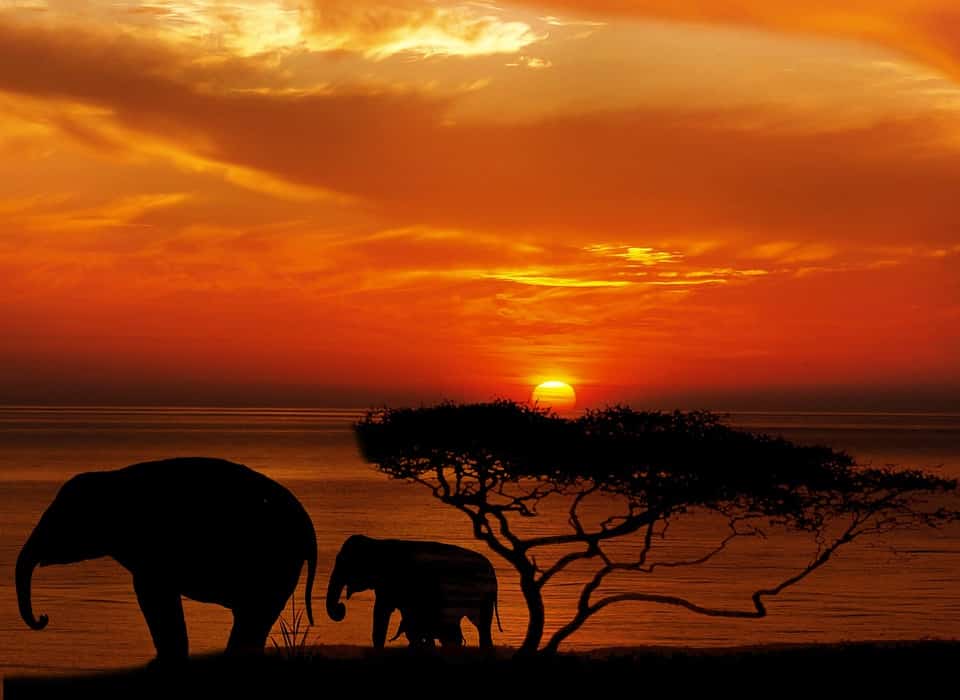
#1 Botswana
Recommended Tours:
Thus, poachers are seen as enemies of the people. As a result, Botswana has come into view as Africa's most sought-after ecotourism destination. Starting from the Chobe National Park to the Moremi Nature Reserve, you'll be able to witness numerous gems all around the country.
Back in 2014, Botswana widely banned the hunting of wild animals and implemented strict laws which are still in practice. The country resumes its zero-tolerance for poaching and their very own environmental minister, Tshekedi Khama, has even launched a shoot-to-kill policy for poachers.
Botswana, with its wildlife conservation and natural parks, is a haven for nature lovers. It is currently in the top 5, as its approach to the protection and conservation of wildlife is worth the praise. As a country, it is very forward-thinking, some may even call it aggressively forward-thinking when it comes to its preservation and anti-poaching laws.

Its fertile land provides a safe and comforting home to around 200 mammal species. This includes elephants, hippos, monkeys and so much more. Along with 650 bird species and 5,500 plants. Even though the country is still underdeveloped and most of the population live in rural households, its national parks, and sight-seeing destinations are on the top 10 of our lists.
Even though many would face some difficulties in locating Malawi on a map, given how tiny it is, the country is home to the world-renowned Lake Malawi National Park. This is practically one-third of the country and is the most biodiverse lake in the world.
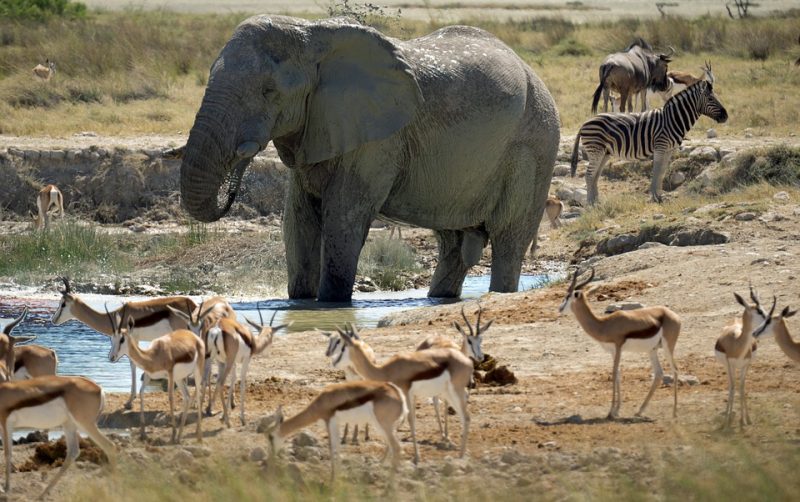
Most of the land in Namibia is occupied by the Kalahari and Namib Deserts. Along with that, the country also has 12 national parks and many other areas which are protected. So, if you go there for a safari, you'll have many rich areas to see and explore.
When it comes to countries with the least amount of population, Namibia is one of them. Which proves to be a good thing for nature. This is because most of the land in Namibia is still unspoiled by human filth or any sort of development, giving nature a chance to breathe.

In the country's Volcanoes National Park, you'll find 10 habituated gorilla families. Groups of 8 trekkers can visit them for one hour per day. But that's enough to get the best African safari experience. And as a nature lover, you'll enjoy the experience to the max.
If you've been around for some time, you'll be familiar with Rwanda's mountain gorillas. They were famously broadcasted and their fight for survival was shown on National Geographic . This was all thanks to the late Dian Fossey back in the 1970s who advocated for the rights of these mountain gorillas throughout her life.
Considering the tragic history surrounding the mass genocide of the people of Rwanda back in 1994, it's truly a blessing what the country has achieved in the past 25 years. There have been countless investments in infrastructure. This has resulted in the country being a very fast-growing destination for ecotourism.
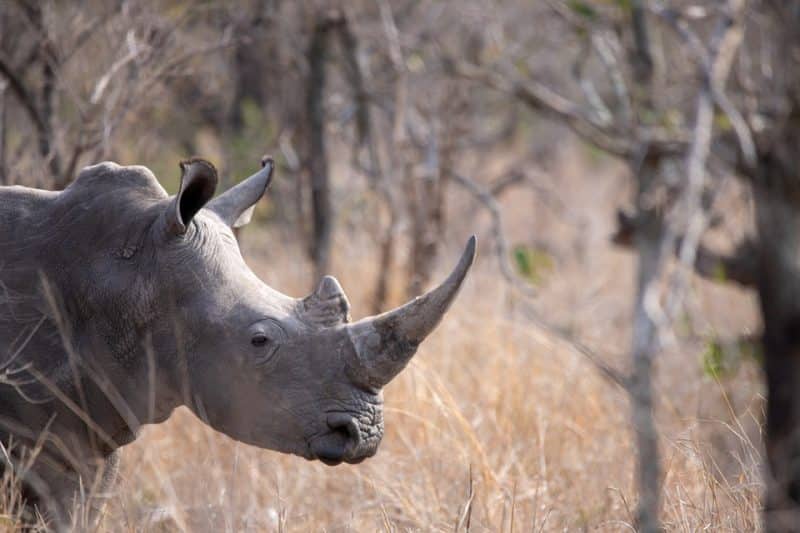
#6 South Africa
But given all the advantages, it's safe to conclude that South Africa also suffers from over-tourism. I mean, if you have so many great attractions, people will flock towards it. Chances are that you'll find yourself in the middle of dozens of unruly visitors who are not too keen on obeying the rules. This occurs mostly during the peak seasons.
Annually, the country has one million visitors. Its biggest attraction is the Kruger National Park with its enrichment in biodiversity. Visitors there also have the liberty to self-drive, thus, getting a first-person private but superb experience.
For some time now, South Africa has been climbing the charts to become one of the most popular destinations for African safaris. Given its location, South Africa is a very convenient and cheap destination for people from the United States. Besides that, the country also boasts a well-developed infrastructure which makes it perfect for luxury travelers as well.
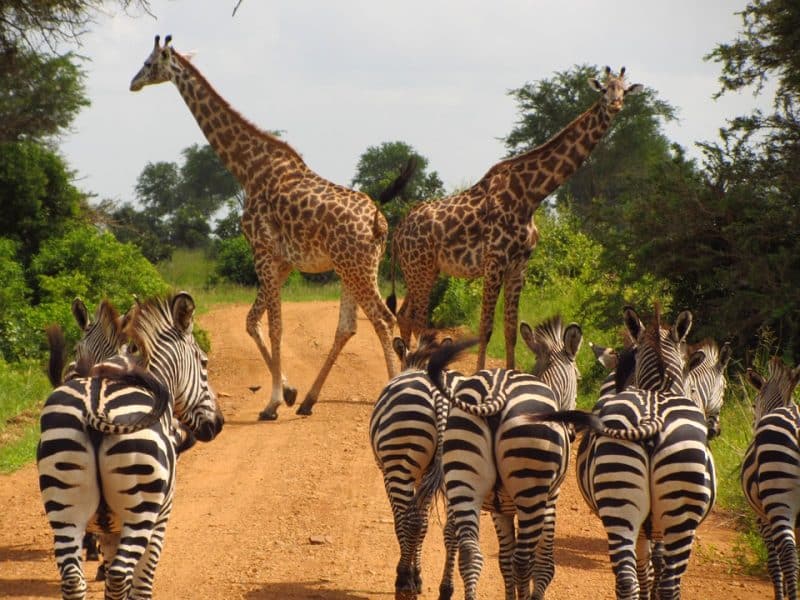
#7 Tanzania
One of the most popular locations would be the Ngorongoro Conservation Area. The country is also a haven for 1100 different bird species. It's no wonder that Tanzania gets this much rep. Especially when the country boasts so many wonders.
We talked about Kenya being the top destination for Safari. Now Tanzania here takes second place in being the continent's most popular safari destination. And why shouldn't it? The country has 16 national parks and an extraordinary amount of wealth and wildlife wonders for the people to witness.
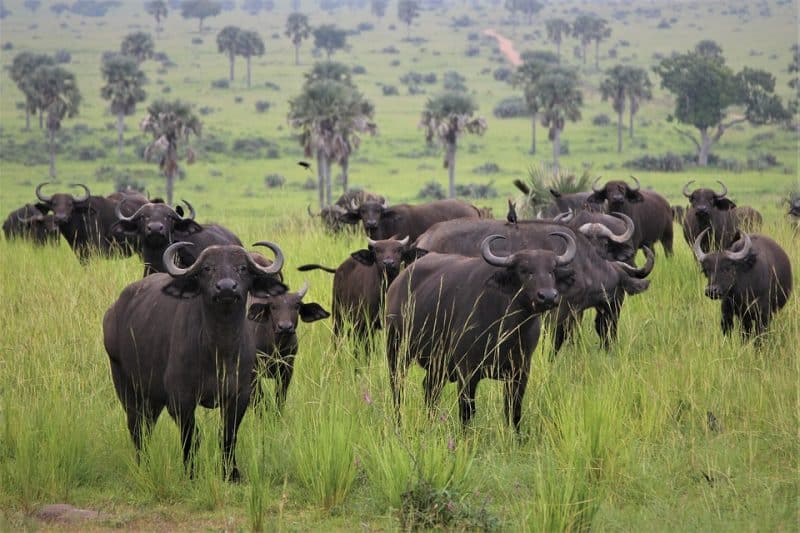
Some of its natural attractions include housing the highest mountain range in Africa. It also has the world's largest free-standing volcano and the second-largest freshwater lake. With its 30 national parks and other wildlife reserves, Uganda boasts many more sanctuaries which are worth the visit. Especially if you're a lover of nature and wildlife.
Often called "The Pearl of Africa", Uganda is certainly a great pick for an African safari. Its reputation as being one of the best ecotourism destinations comes from the country's natural attractions and wildlife.

Out of its 20 national parks, the Mosi-oa-Tunya National Park is home to many wildlife animals such as African elephants, Angolan giraffes, Cape buffalo, etc. Other than that, there are many private ownerships of National parks, notably the Kasanka National Park which is near the basin of Lake Bangweulu. It's a safe place where visitors can see 400 different avian species.
Zambia may be a bit far down the list of popular destinations for your African safari, but many consider it to be a destination for diversified and immersive safari experiences, and making a notable feature on our 10 Best African Countries for Safari guide. The country is steadily focusing on conservation as their president has shown a keen interest and is working on building the nation's economy as well as the infrastructure.
More for You
Kamala Harris roasted after she claps along to protest song – before realising they’re protesting against her
Satellite Images Show Aftermath of Russian Black Sea Fleet Strikes
7 things you should never put in a slow cooker
Boeing shares leap as it unveils CEO exit, major leadership changes
18 Things You Should Never Say to a Grieving Person
I Was Diagnosed With Colon Cancer at 32. Here Are the First Symptoms I Had.
'Shark Tank' host Kevin O'Leary says Trump losing his assets would deal 'collateral damage to the American brand'
Fictional Characters You Might Not Know Are Based on Real People
NCAA ref pulled from women's tournament game at halftime over 'background conflict'
Tammy Murphy drops out of New Jersey Senate race
The best beach town to live in on the East Coast is not in Florida, according to data. See the top 25.
'Man in the Iron Lung's' family release statement following his death aged 78
McDonald's menu brings back a new take on an iconic item
Shamima Begum loses latest bid to fight citizenship removal
Winter Storm Warning Issued For Nine States as Intense Blizzards Forecast
How to keep bananas from turning brown: Store it properly to maintain freshness
The son of Stewart Rhodes, founder of the extremist Oath Keepers, has decided to enter politics as a Democrat
Scientists discover best way to cut down alcohol intake
Mike Tomlin Announces Decision On Starting Quarterback Position
16 Compliments You Didn’t Realize Are Actually Pretty Insulting
I visited 5 of the best safari parks in Africa. The trip was filled with surprises, and there are a few things I wish I'd known before leaving.
- I visited five of Kenya's best safari parks to see some of Africa's most famous animals in the wild.
- There were many aspects of the safari that surprised me despite the research I did before my trip.
- I was surprised by many things, including how long I spent sitting in safari cars.

Seeing some of Africa's most famous animals in the wild has been on my bucket list for years. With adventure travel on the rise, I decided to take the plunge and make the 20+ hour flight to Africa to visit some of Kenya's best safari parks.
Masai Mara is arguably the most famous for big-cat sightings, but Amboseli National Park , Crescent Island Game Sanctuary, Nairobi National Park, and Hell's Gate National Park are also must-see reserves teeming with wildlife.
I did lots of research beforehand but found I was unprepared for many things I experienced while on safari — and there are things I'll definitely do differently the next time I go.
From what I should have worn to what seeing the animals was really like, here's what surprised me most about going on safari in Kenya.
I sat in the safari vehicle for about 8 hours every day
Between a morning and afternoon game drive, I spent about eight hours in the car daily. It was shocking to see the low number of daily steps on my Oura ring.
I started doing yoga at the end of the night to loosen up my hips. My airplane pillow also helped me stay comfortable, especially during the seven-hour drives to other parks.
My shoes were off for most of the drives
In hindsight, I should have worn sandals on my drives. Most safari vehicles have small windows and a top that lifts up, and you're frequently standing on the chairs to get a better view.
We took off our shoes when we got into the car so we were ready to hop up on the chairs at a moment's notice.
I had lots of early mornings and bedtimes.
The best times for safaris are in the mornings and at dusk, and sometimes, we had 4 a.m. start times. The lack of sleep , paired with the heat, made me eager to get to bed early.
Related stories
I'm not a morning person, but I preferred the early drives for the animal activity (and incredible sunrises) we saw. We used the less-ideal safari hours during the day to nap, do other activities in the area, or drive to other parks.
Many animals can be difficult to spot due to distance or camouflage
We had our fair share of close-up sightings, but many of the animals we wanted to see were far away and sometimes not immediately obvious to the naked eye.
We ditched our iPhones and used binoculars and someone's camera viewfinder to get a closer look.
A pair of binoculars and a camera with a zoom lens are essential for getting the best view (and pictures) possible.
There were long periods of time with minimal animal sightings
Safari drives can be frustrating because you can't control what animals you'll see, how far away they are, and how long the sighting will last. But being patient can be rewarding.
During one dusk drive, we spent three hours searching for a pride of lions without any luck. Finally, as the sun set in the last half hour, we stumbled upon three female lions napping, a leopard, and giraffes.
Many of the animals are sleeping during the day
I expected to see animals moving around or hunting, but many were resting during the day. It was only when dusk approached that they started to slowly stake out a spot by the grazing herds.
If I go on safari again, I'll book a night drive so I can see how the lions and other animals act during their peak hours of activity.
My view was largely out of my control
Whenever a less common animal like a lion or cheetah is spotted, a traffic jam of safari vehicles speed over and line up, vying for the best view.
What you see — and sometimes, if you see anything at all — can depend on your driver and what vantage point they can get.
Your view can also depend on your position in the car. I spent a lot of time scrambling around to catch a sighting (and a photo, if I was lucky).
Prey is plentiful, but seeing any action is unlikely
Gazelles and impalas were everywhere, so it was surprising to learn that the lions might not eat for days.
Our driver told us the best thing he's seen on safari was a cheetah hunting a gazelle, and then a pride of lions swooping in to steal his meal. However, these kinds of sightings are rare.
Predators need to consider everything from the direction the wind is blowing to the length of the grass when trying to sneak up on their prey. Many hunts are unsuccessful, so seeing one in person is unlikely.
Watch: Crocodile wrangler rates 12 crocodile and alligator attacks in movies and TV
- Main content
African safari sounds – Animal noises of the bush and savanna

Most people go on safari thinking about the sights. Lions, baboons, elephants, hippos! What an adventure!
But visit wild Africa, and you will explore with all your senses . I have as many memories of sounds and smells as I do of the sights.
Out in the bush, you hear strange noises, especially in the stillness of the night. So it’s good to know the African animal sounds before you go, especially if you will be camping in the African savanna .
I personally don’t think any animal sounds beat that of a trumpeting elephant . If a whole herd is blowing their trunks, then it quickly becomes an orchestra.
In this article, you can listen to all the top sounds of the wild while learning how to identify different mammals and birds.
The post includes most of the top safari sounds , those that you are likely to come across on any safari.
I love the nighttime bush sounds – when it’s so quiet, it’s easy to pick up on any noise.
Most Popular African Animal Sounds
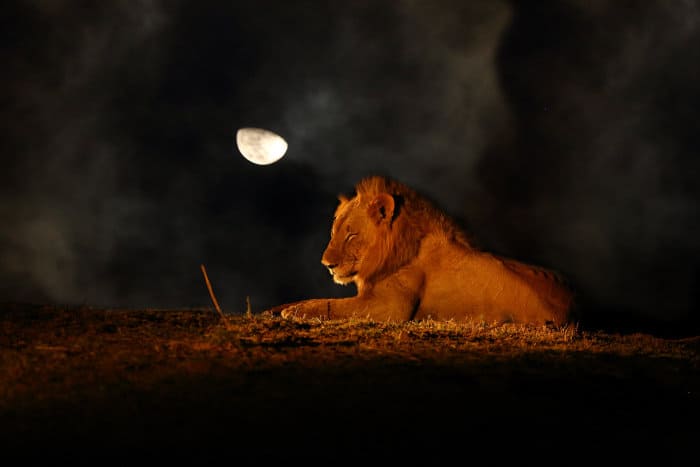
Baboon sound names cannot be summed up with a single word. These primates have a diverse vocal repertoire comprising various calls , barks , and grunts . They also make distressed calls or yaks .
Female baboons also make loud copulation calls , while males are often heard using long-distance screams. Want to hear the various baboon calls yourself? Check out the video below.
2. Elephant
Wondering what sounds elephants make ? Let’s start with the one that many people know— trumpeting .
This is the sound elephants make when pushing air out through their trunk. It is usually made when the elephant is excited or distressed.
Another sound in this beautiful animal’s vocabulary is growls or rumbles . This is a lower-frequency sound that is generally used for short-distance communication.
Other sounds that African elephants make include squeaks , roars , grunts , barks , and snorts .
Hippos make many unique sounds, including grunts , roars , groans , and growls . They’re also known to make loud wheezing and chuffing noises.
Hippos can also communicate underwater. These hippo sounds resonate in the jawbone and neck and include squeaks , croaks , and whines .
Do hyenas really “laugh” ? The short answer is yes . This is one of the most renowned African savanna sounds.
The laughter of a hyena is generally used to communicate and convey excitement, fear, or frustration.
Hyenas also make a variety of softer sounds, including growls , grunts , and squeaks .
Impalas are loud animals, especially when compared to other antelope species . You’ll be able to hear their high-volume roars from up to 2 km away.
Jackals are very vocal animals. They communicate with one another using high-pitched howls , growls , and yaps . Some are also known to hoot .
While leopards are usually quiet, they have also made a name for themselves with their long sawing roar . This unique sound is usually repeated for a minute at a time and can travel up to 12 km.
– Video 1 : Leopard Call Close-Up
In addition to their roar, other vocalizations of these large cats include grunts , growls , hisses , and meows .
– Video 2 : Leopard Call at Night
Listen carefully to the baboon alarm calls … next you’ll hear a leopard call .
More about the sounds a leopard makes .
There’s more to the king of the savanna ’s vocal repertoire than just a loud roar . While the roar is certainly the lion’s most iconic sound, it also purrs , hums , moans , grunts , and growls .
Learn more about the sounds lions make .
Another one of the more common safari animal sounds is that of a zebra. As you make your way through the African plains , you’re sure to hear these striped animals bray , bark , and snort .
Even more zebra noises .
Bird Safari Noises
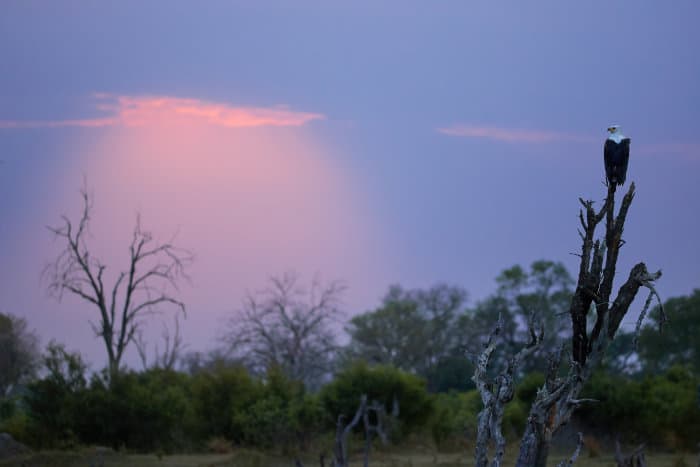
1. African fish eagle
The African fish eagle’s vocabulary comprises two distinct calls . The one is a penetrating sound used in flight and is often referred to as “ the voice of Africa .”
The second is a “ quock ” sound, which the eagle uses when near the nest.
Learn more facts about fish eagles .
2. Crested francolin
The crested francolin makes a variety of sounds, including a repeated series of cheery “ cheer kirk-kik ” calls. This is often heard as a synchronized duet.
3. Guineafowl
An iconic African animal noise is the “ buckwheat ” sound made by a confusion of guineafowls . The vocal birds also use a “chee chee” sound.
Typical African Bush Sounds
Interested in hearing more African wildlife sounds? Listen to the unique sounds of the bush below.
African Animal Sounds at Night
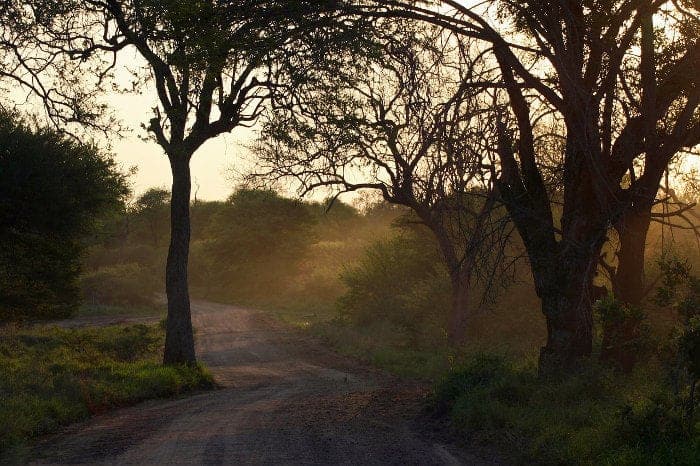
1. Riverine area
Common safari noises heard within Africa’s riverine areas include the buzzing of cicadas and the croaking of frogs.
2. Creepy hyena calls
One of the most iconic wildlife sounds at night is the creepy call of the hyena. Hear it for yourself below.
Listen to Real African Animal Sounds
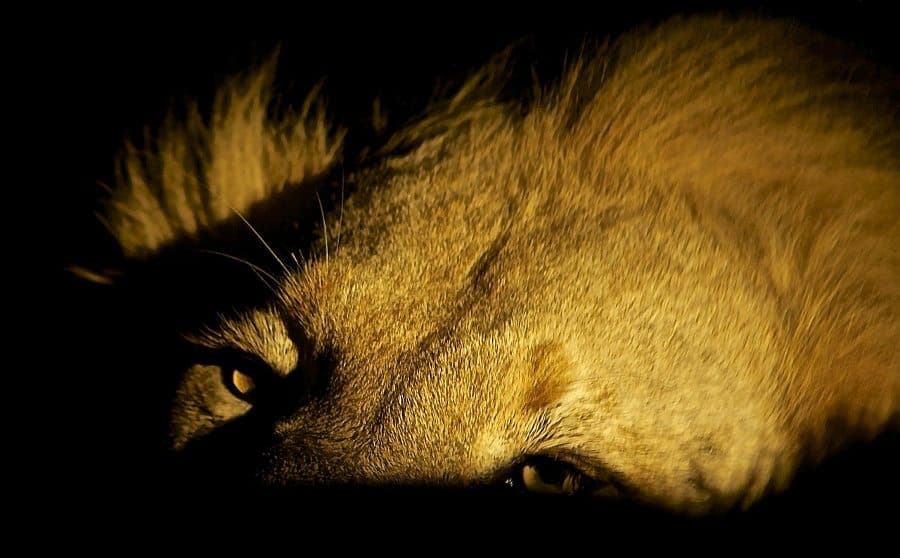
Listening through headphones or on a mobile isn’t the same as being out in the wild. You don’t hear these wildlife sounds in isolation. All the sounds mingle together, and you never know what will come next .
At the best safari camps, you drift off to nature’s lullaby. Sometimes you even wake in the night to a strange sound, like baboons nearby or hippos fighting at a distant river.
Then the next morning, you inspect the camp to see what kind of visitors left their evidence in the grass.
Going on safari is the only way you can truly listen to the sounds of the savannah. And don’t forget the smells as well!
If you want to see a lion, you can look at a photo. But if you want to experience a lion, you need to go on safari and come face to face with the apex predator .
You might be able to spot a hippo in a zoo, but only on a safari can you understand how these giant animals live in the wild.
A safari provides a connection with nature . You’re completely immersed, surrounded on all sides by the sights, sounds, and smells of the wild.
And that is a very special feeling that I hope everyone gets to experience at least once in their lifetime.
Listen to some of the most popular African animal noises there are. These are the sounds you are likely to hear on an African safari: lion , hippo , baboon , and more.
About The Author
Michael Theys
Related posts.
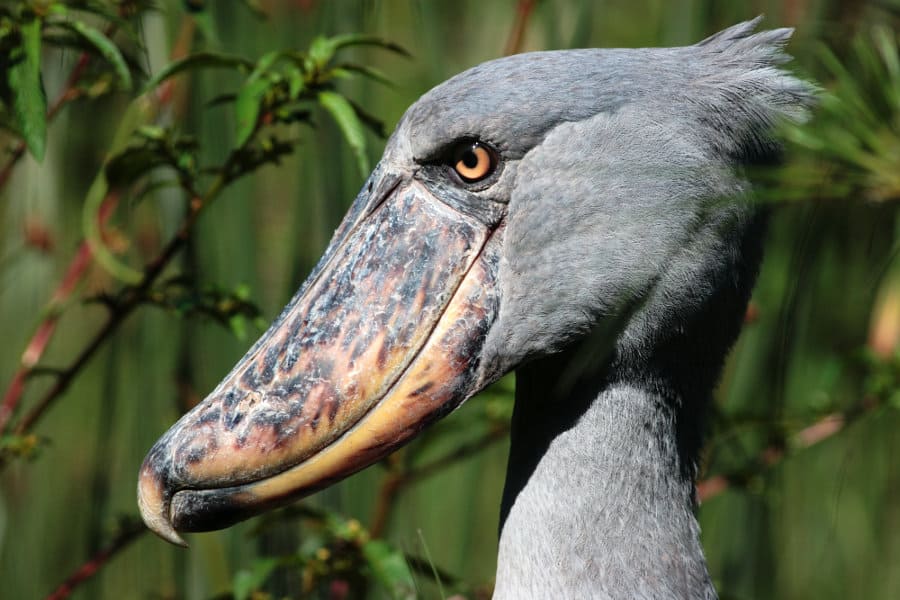
17 amazing facts about the shoebill stork: sound, size, diet & more

What does a hippo sound like? Hippo sounds explained

What does a shoebill stork sound like? Hint: it’s quite freaky
3 thoughts on “african safari sounds – animal noises of the bush and savanna”.
Hello, I have been on safari three times and do camping in small tents. Even though I am usually there when it is cold at night we keep all our tent flaps open so that we can hear the nighttime sounds. I love hearing hyenas doing their whopping call and the call of a lion in the distance and the jackals. I truly wish someone would make an audio of the night sounds, I miss it so much when I am home and would love to be able to play something at night to help me go to sleep and to dream that I am there.
Here’s one way to almost feel “as if” you were in the middle of the African bush (nature sounds from Mana Pools):
https://youtu.be/ut2KhcNtnm8
This is really wonderful and interesting. Africa’s nature knowledge, I love it. Thanks.
Leave a Comment Cancel Reply
Your email address will not be published. Required fields are marked *
Videos show terrifying moment bull elephant lifts safari truck
The safari guide who warded off the elephant was praised by wildlife experts.
Frightened tourists can be seen ducking between seats during a tense standoff between a bull elephant and a safari truck in Pilanesberg National Park, South Africa.
Videos of Monday’s incident show a bull elephant lifting the 22-seat truck up several times with his trunk before letting it drop. The driver can be heard calling for the elephant to "go away" and slapping his hand against the side of the truck to scare away the animal.
Hendry Blom, a bystander who caught the incident on camera, told ABC News: "We were definitely scared, especially for the people in the truck because we thought they might die."
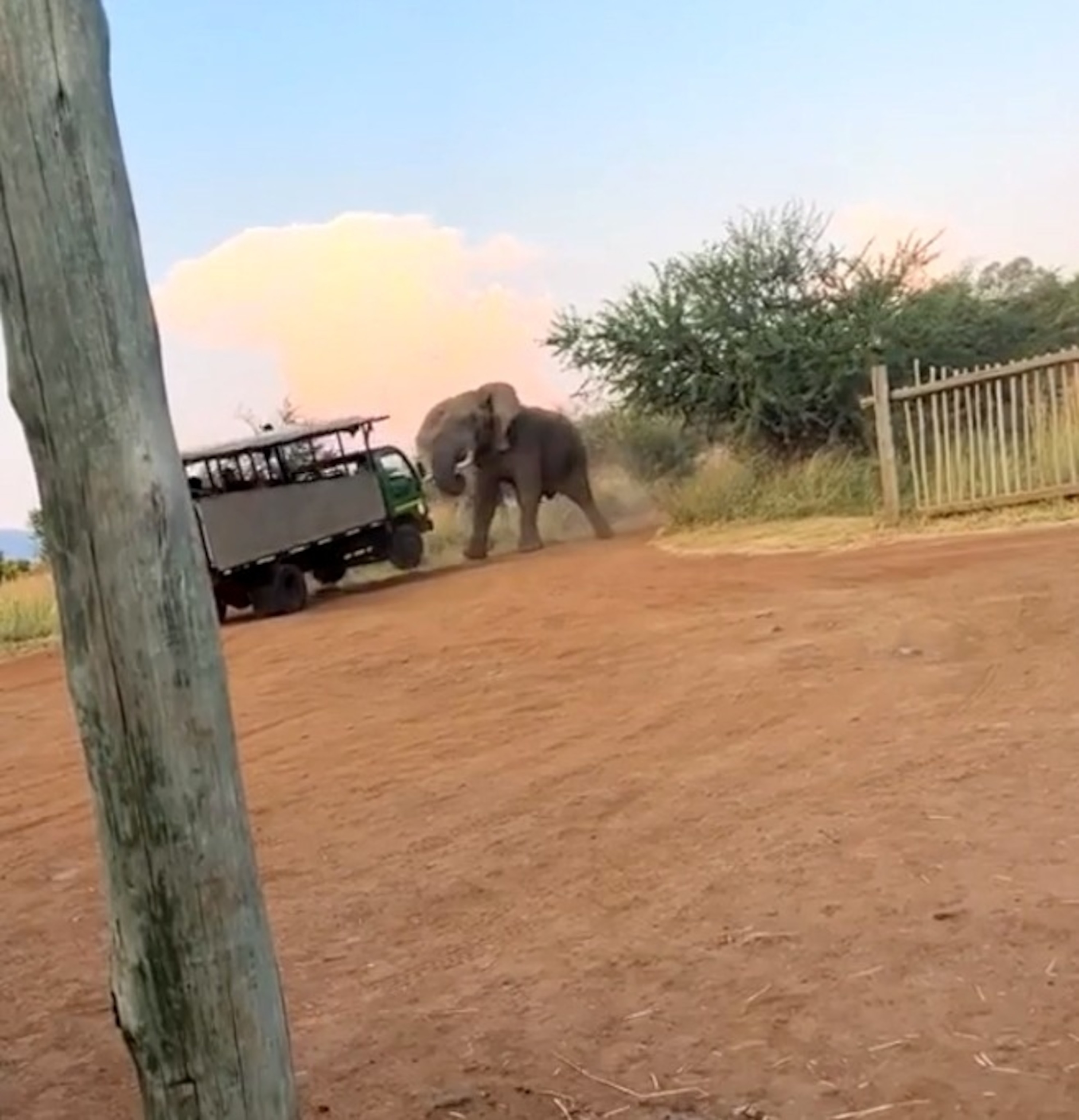
Another video from inside the truck shows frightened tourists cowering on the floor of the vehicle. One woman can be heard praying as the elephant approaches.
MORE: Global warming could increase risk of human-elephant conflict, researchers say
Poncho Mogodiri, field operations manager of Mankwe Game Trackers, the tour company involved in the incident, told ABC News the guide and guests were in animal hide when the bull elephant approached. "Hides provide you with the rare opportunity to unobtrusively view the wildlife and birds at close quarters," according to Pilanesberg National Park.
Mogodiri said some of the tourists "came too close to the elephant to take pictures and he started getting aggressive."
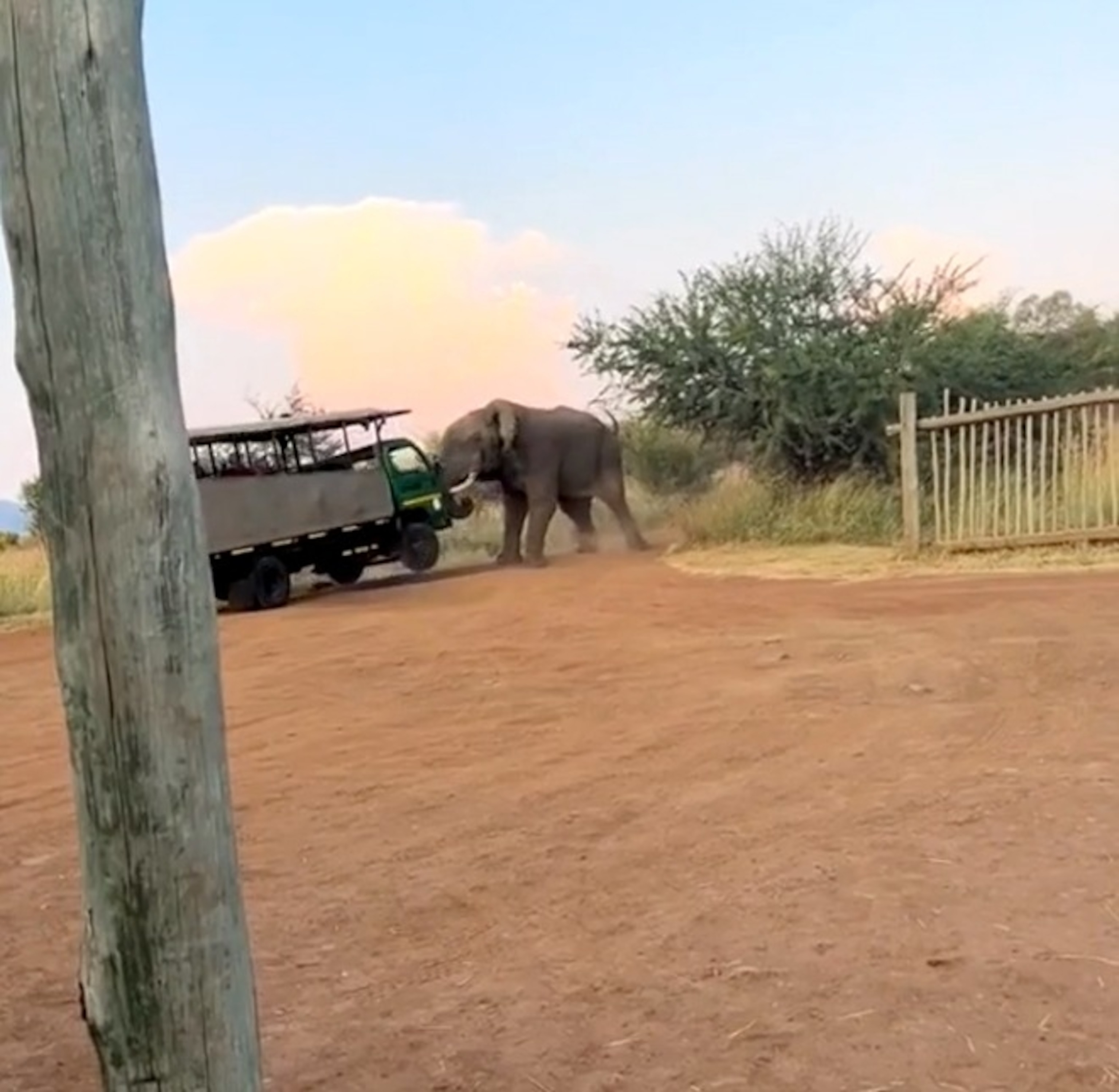
The guide's actions -- revving the engine, slamming car doors and shouting to ward the elephant away -- have been widely praised by wildlife experts. Mogodiri said the guide reacted "by the book."
"Anyone that’s worked with elephants will tell you when a bull like that charges, you don’t turn and run, you need to make as much noise and stand your ground," said Ron Magill, communications director at Zoo Miami.
MORE: 80-year-old man pleads guilty to genetically engineering giant hybrid sheep in 'audacious scheme,' DOJ announces
Mogodiri confirmed the bull was in musth, or when an elephant "experiences an increase in reproductive hormones and becomes highly aggressive," according to the Pilanesberg National Park website.
No one was injured in the incident, though Mankwe Game Trackers told ABC News one family had been offered counseling after being left "extremely rattled." The Pilanesberg National Park said it will be conducting an internal investigation of the incident.
Related Topics
Top stories.

US braces for major storm, 16 states under winter weather alerts
- Mar 24, 3:37 PM

Trump hush money case updates: Trump indicates he'll testify at upcoming trial
- 20 minutes ago

In win for Trump, appeals court lowers his bond to $175M in civil fraud case
- 2 hours ago

Boeing CEO Dave Calhoun to step down
- Mar 25, 8:08 AM
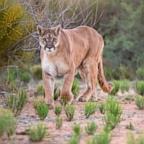
Rare mountain lion attack leaves 1 brother dead, authorities say
- Mar 24, 10:58 PM
ABC News Live
24/7 coverage of breaking news and live events

IMAGES
VIDEO
COMMENTS
Birds of Africa are amongst the most varied, numerous, and colourful of anywhere in the world. The continent is home to over 2,300 documented bird species, of which 67% are endemic to Africa.. Whilst the large mammals often steal the show on a safari, the huge variety of birds of Africa can be overlooked.
2/ Shoebill. Shoebill, Uganda. This scarily prehistoric-looking African bird captures the imagination because it really does look like the dinosaurs from which birds are descended. The shoebill ( Balaeniceps rex) is huge - measuring up to 1.5 metres tall and with a wingspan of up to 2.5 metres.
Final Thoughts: Safari Birds are a Sight to Behold. Africa is a continent filled with a variety of animals and the necessary habitat for them. So, while you go after amazing African safari animals on your next adventure, look out for the birds too! There are over 2500 bird species, making Africa a haven for birdwatchers.
1. African fish eagle. Undoubtedly Africa's most striking symbol, and Zambia 's national emblem, this is the ultimate bird to see on safari. If you haven't already guessed it by the name, their diet mainly includes fish. So you'll likely find these large African birds near open water bodies.
It's a large bird, measuring up to 4.9 feet (1.5 meters) in height and has long legs with an eagle-like body. These birds are usually white with black markings including black plumage around the head and an orange mask around the eyes. One of the most interesting things about the secretary bird is its feeding habits.
People travel to Africa to see extraordinary animals - lions, leopards, and elephants. What can be overlooked are the spectacular birds that are seen on safari. Watching the flight of the colorful lilac-breasted roller can be as enjoyable for bird lovers as watching elephants at a watering hole. In this article, we'll explore some of the ...
Don't forget the safari birds!While it's easy to be preoccupied with giant mammals there's an entire world occupying the sky, with Africa famous for its mass birdlife congregations.. South Africa is home to 10% of the world's total bird species.1.5 billion red-billed quelea fly around Botswana's swamps.More than 2500 different birds are found across the continent.
Birds of Africa are amongst the most varied, numerous, and colourful of anywhere in the world. The continent is home to over 2,300 documented bird species, 67% of which are endemic to the continent. ... Then here's the perfect list to brush up your knowledge of collective nouns of birds you might see on safari. Whilst some collective nouns for ...
6. Secretary Bird (Sagittarius serpentarius) The secretary bird is a powerful bird of prey primarily found in the open grasslands and savannahs of sub-Saharan Africa. It stands 1.2 m/3.9 ft tall and has a wingspan of more than 2 metres, which is well over 6 ft. The Secretary bird is a fearsome snake wrangler.
Birding Safaris. Africa offers expansive and diverse climates and regions, with everything from deserts to coastal land and savannah plains. Some 2,477 bird species live in Africa, with many of them rare or unique to this beautiful continent.. Birding safaris present an opportunity to experience rare and amazing African birds with your own eyes, creating memories that are sure to last a lifetime.
12. Oxpeckers. Out on safari, some of the most common birds to spot are the small birds, seen hitching a ride on rhinos, zebras, buffalos, elephants, or giraffes. It's also not uncommon to see them balancing on hippo's backs as they bob in the water. These little birds are oxpeckers, small parasite-eating birds, endemic to Sub-Saharan Africa.
15 birds in South Africa that you may spot while on Safari: Lilac-breasted roller. The lilac-breasted roller is a colorful bird that is native to sub-Saharan Africa. It gets its name from the Lilac hue on its breast, contrasted by its blue and green plumage. This bird is relatively small, measuring around 28cm.
The Secretary bird is a fearsome snake wrangler. Secretary birds are among the tallest birds of prey, with a height of about 4.3 to 4.9 feet. They're easily recognizable by their gray body feathers, long black feathers on their legs, and a distinctive crest on their heads.
Here some of the iconic avian heavyweights you might encounter on a safari in Africa. Ostrich. The world's largest bird, standing up to 9ft tall and weighing up to 320lb, the ostrich is an unmistakable resident of open savanna and grassland. The male has a bold black and white plumage, but the female is somewhat dowdier.
African birds are available in a virtually unlimited variety of sizes, forms, and colors, ranging from tiny, vividly colored sunbirds and tenacious little bee-eaters to ominous marabou storks. While those who like nature frequently concentrate on Africa's safari animals first and foremost, its magnificent birds should not be disregarded.
Africa is home to over 2,700 bird species that come in an almost infinite number of sizes, shapes, and colors. From the soaring eagles and vultures that domi...
7. Lilac-Breasted Roller. One of the most commonly spotted birds while on safari in Southern Africa, the Lilac-Breasted Roller is easily spotted thanks to its vibrant colours and propensity for perching on tree branches.. With its bright lilac breast, the roller is named so due its habit of rolling mid-flight while defending territory or courting a mate, and despite its stunning appearance ...
While wildlife lovers are likely to focus first and foremost on Africa's safari animals, its fantastic birds ought to positively not to be neglected. If you're heading off on an African safari, otherwise you simply wish to discover a number of the wonderful birds of Africa, this listing is a great place to get to know them. 1. Pied kingfisher
Some of the best Safari-birding hotspots in the country include the Kruger National Park, the southern Drakensberg, mKhuze Game Reserve, and the Isimangaliso Wetlands Park World Heritage Site . Common birds you can expect to see on a South African safari include the yellow-billed hornbill, helmeted guineafowl, and Burchell's sandgrouse.
The Knysna turaco's call is more of a croaky "khaaar-khaaar-khaar .". Knysna turacos are found in evergreen forests of South Africa and Eswatini. Knysna itself is a town in southern South Africa, and locals know these birds as 'louries.'. Whatever you call them, turacos are certainly some of the most unique and beautiful birds in Africa.
South Africa is a birding safari paradise with its diverse ecosystems, spread across nine biomes, hosting an extraordinary 800 recorded bird species.. Avid bird watchers and all-round nature lovers can take in the flight of the African Fish Eagle or the cute waddle of the endangered African Penguin across the country's top bird-watching destinations, Kruger National Park, the West Coast ...
The large, attractive bird, growing over three feet in height, with plush blueish-gray plumes and a golden crest, would be one of the most majestic creatures to see on one's African safari. The grey-crowned crane primarily inhabits dry savannas in Sub-Saharan Africa but could occur in cultivated areas and grassy flatlands in Kenya, Uganda ...
The post 10 Best African Countries for Safari appeared first on Animals Around The Globe. Animals Around the Globe. 10 Best African Countries for Safari ... Along with 650 bird species and 5,500 ...
Seeing some of Africa's most famous animals in the wild has been on my bucket list for years. With adventure travel on the rise, I decided to take the plunge and make the 20+ hour flight to Africa ...
8. Lion. There's more to the king of the savanna 's vocal repertoire than just a loud roar. While the roar is certainly the lion's most iconic sound, it also purrs, hums, moans, grunts, and growls. Learn more about the sounds lions make. 9. Zebra. Another one of the more common safari animal sounds is that of a zebra.
A large bull elephant appears to attack a safari truck at Pilanesberg National Park, March 18, 2024, in South Africa. "The Field Guides Association of SA points out the video offers little context ...